The acquisition policy of the Palace of Versailles has not ceased to evolve since the inauguration in 1837 of the Museum of History desired by Louis-Philippe. Objects, painted, drawn, photographed or written documents join the collections every year. Discover the acquisitions of the Palace of Versailles year after year.

Museum acquisitions
Since the creation of the historic galleries, inaugurated in Versailles in 1837, the acquisitions policy at the Palace of Versailles has evolved to focus on several categories of items. First, the Palace acquires objects (furniture, bronzes, porcelain, paintings, drawings, sculptures or manuscripts) that at one time were here and which now bring the place back to life as we see what it must have looked like at the time when it was a royal residence and we have a glimpse of life at Court. Alongside these acquisitions, paintings, drawings, photographs or written documents are added on a regular basis to complement our knowledge of the Palace, the Estate and their development through the ages. Lastly, the collection of iconographic material built up since the time of Louis-Philippe is enriched by new works to represent the characters or illustrate the periods of French history that are represented in the Palace galleries.
See below a selection of the works with descriptions.
2025
Oval snuffbox in soft Sèvres porcelain with chiselled and engraved gold mount
Produced by the Royal Manufactory of Sèvres
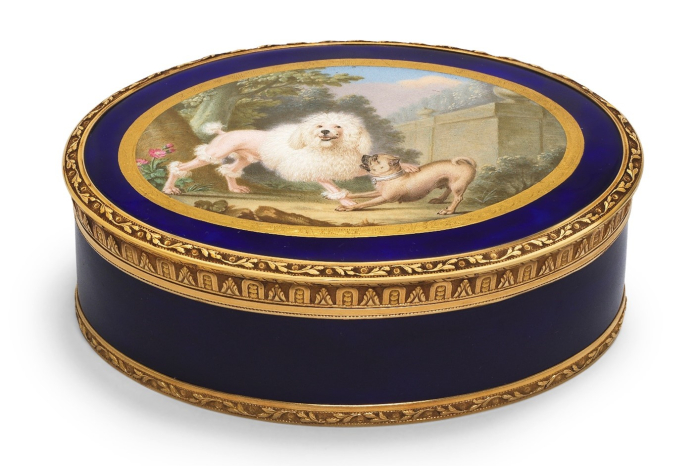
At an auction in the United Kingdom on 2 December 2025, the Palace of Versailles acquired, thanks to the patronage of the Society of Friends of Versailles, a rare soft porcelain snuffbox from Sèvres commissioned by Madame Adélaïde, daughter of Louis XV and aunt of Louis XVI.
The oval snuffbox is distinguished by its ‘beautiful blue’ background, an emblematic colour of the Sèvres factory, and by its miniature cartels depicting the princess's dogs, including the famous Vizir. Decorated by Nicolas-Pierre Pithou the Younger and mounted in gold by Parisian goldsmiths Charles Ouizille and Pierre-François Drais, the piece is fully documented in the factory's archives. It enriches the Versailles collections related to the daughters of Louis XV and bears witness to the art of living at court in the 18th century. Rarely preserved in their entirety, royal snuffboxes of this quality make this acquisition an exceptional opportunity for the national collections.
Self-portrait of Adélaïde Labille-Guiard
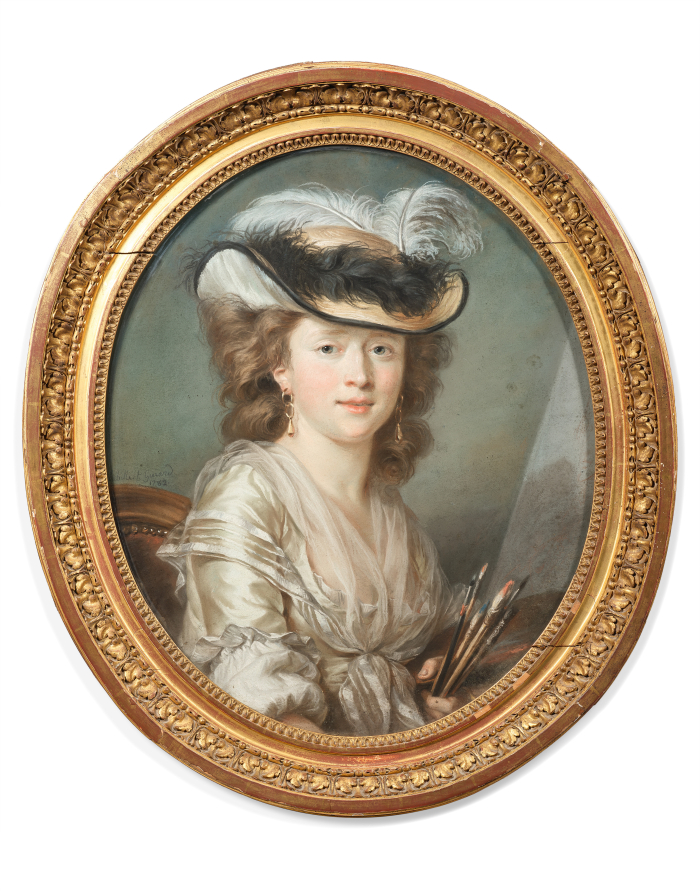
During a public auction on 17 December 2025 at Tajan in Paris, the Palace of Versailles exercised its right of pre-emption to acquire a pastel self-portrait by Adélaïde Labille-Guiard.
This sublime self-portrait is essential to Adélaïde Labille-Guiard's career. She presents herself as an accomplished and recognised artist, on a par with her colleague Élisabeth Vigée Le Brun, but above all on a par with her male peers. She depicts herself, not outdoors like Vigée Le Brun, but in her studio, with a canvas beside her, brushes and palette in hand, according to the established model of the painters of the Academy, ready to begin the portrait of a new model, dressed in an elegant satin gown.
Les Jeux d’enfants à la toilette
By Charles Antoine Coypel
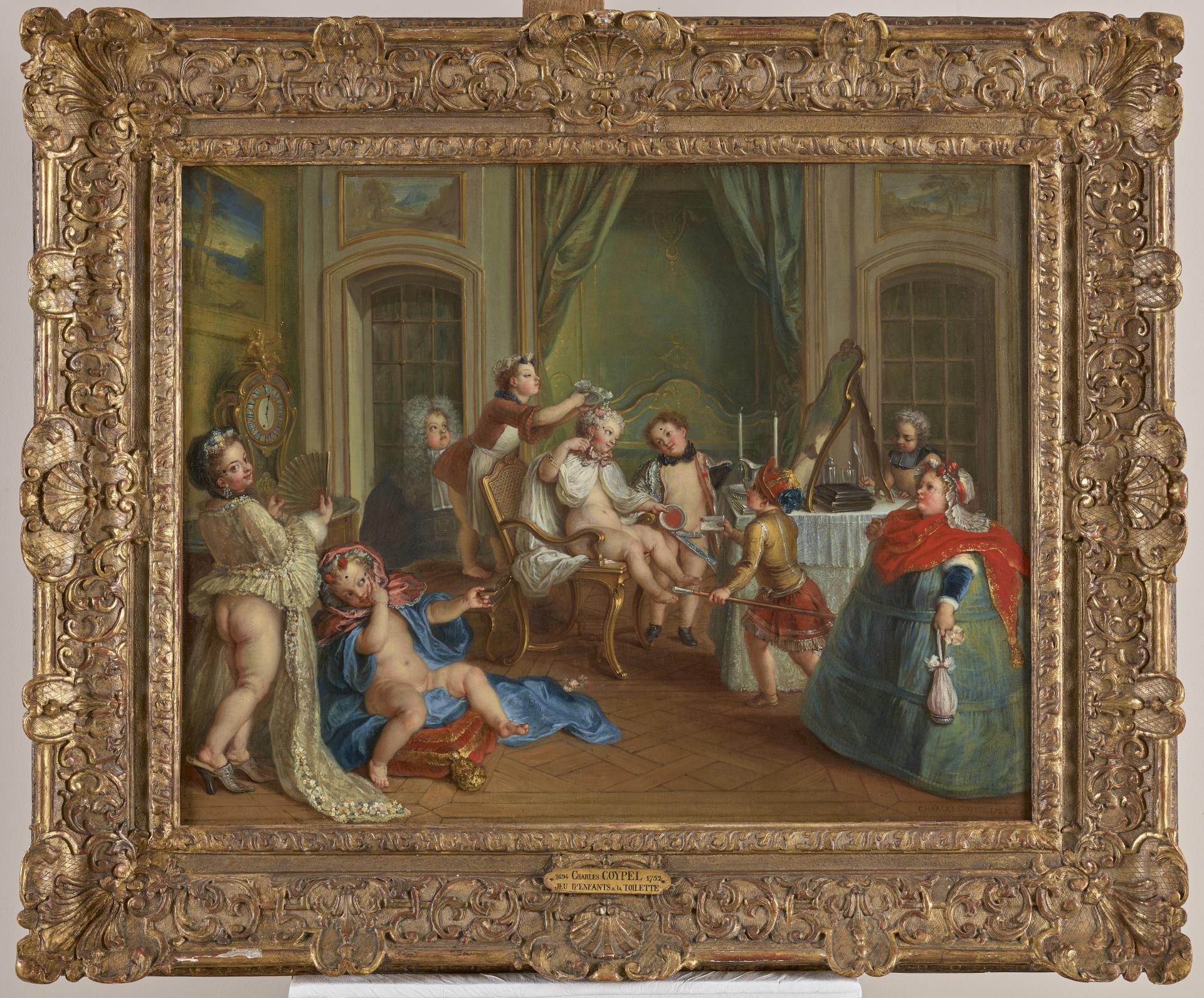
Children Playing at the Toilet, Charles Antoine Coypel, 1728.
© Château de Versailles, Dist. RMN © Christophe Fouin
The Palace of Versailles recently enriched its collections with the acquisition of Les Jeux d'enfants à la toilette (Children Playing at the Toilet) by Charles Antoine Coypel, a painting that belonged to Madame de Pompadour and was confirmed to be in Versailles at the time of her death. Created in 1728, this work, long kept in private collections, has thus returned to the place where it was once displayed.
Under the guise of a childish scene, Coypel deploys a refined satire of 18th-century aristocratic mores, mocking vanity and toilet rituals. The first work from the Marquise's collection to join Versailles, it will soon be exhibited in her apartment in the Palace.
Pastel portrait of Louis Stanislas Xavier de France, Count of Provence (1755 - 1824)
By Élisabeth Vigée Le Brun
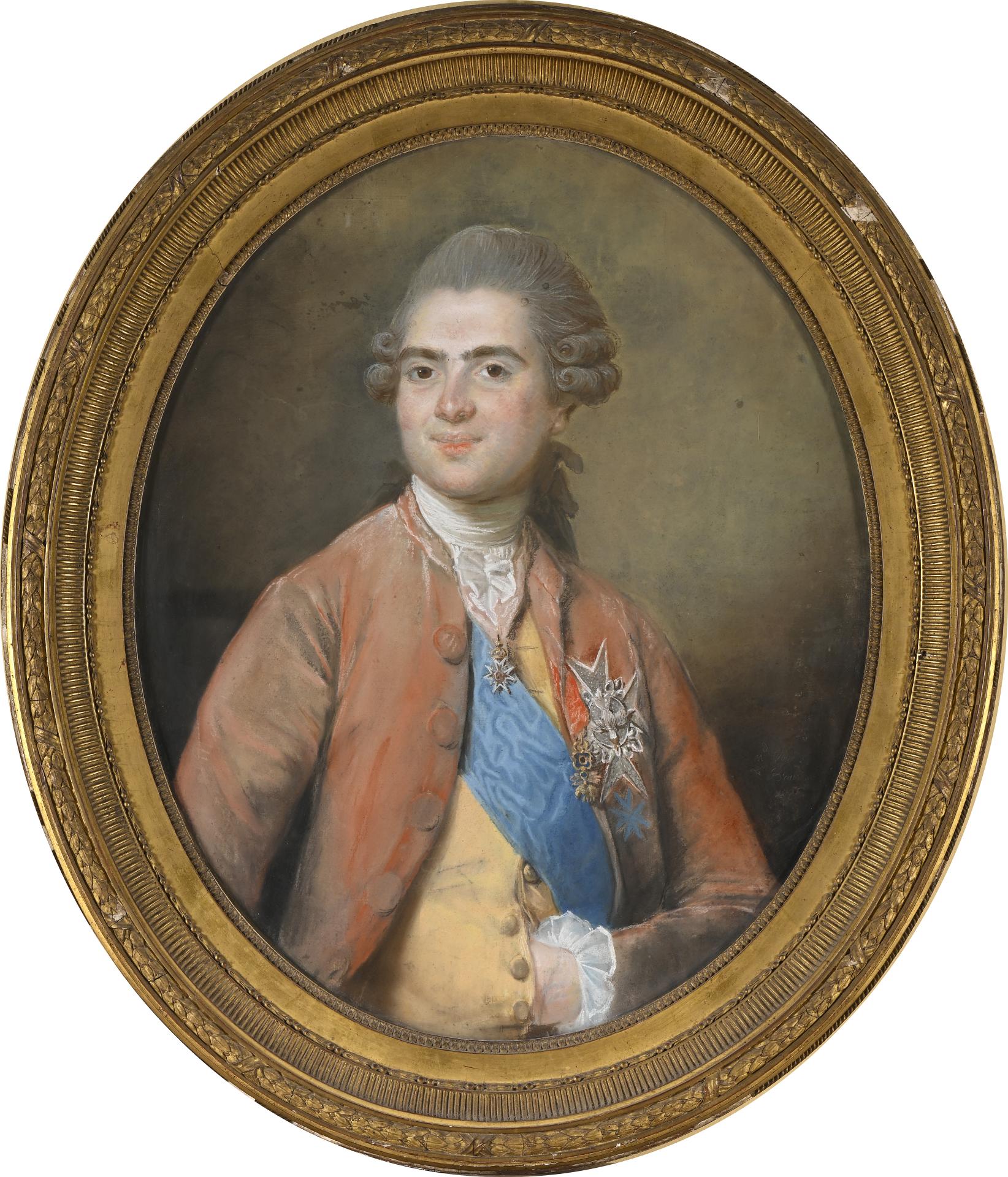
Élisabeth Vigée Le Brun, Louis Stanislas Xavier de France, Count of Provence (1755 - 1824), 1776
© De Baecque & Associés
On June 16, 2025, the Palace de Versailles acquired by pre-emption a pastel portrait of the Count of Provence, brother of Louis XVI and future Louis XVIII, painted by Élisabeth Vigée Le Brun and commissioned by Cromot du Bourg, Superintendent of the Houses and Estates of the Count of Provence. This first royal portrait by the artist, dating from 1776, marks a turning point in her career and illustrates her remarkable mastery of pastel, notably through a lively, dynamic style of colored cross-hatching inspired by Jean-Baptiste Perronneau. This official commission, paid for at 2320 livres, opened the doors of the court for Vigée Le Brun.
Vigée Le Brun deployed a sophisticated technique combining tinted papers, shading and superimposed colors, creating luminous, almost impressionistic effects. The portrait stands out for its bright colors, lively treatment of the face and attention to costume details, such as the blue cordon and cross of the Order of the Holy Spirit. This work heralded the artist's career with the royal family, which she continued to paint until the 1780s.
Large oval dish from the Louis XV celestial blue service
By the Vincennes porcelain manufactory
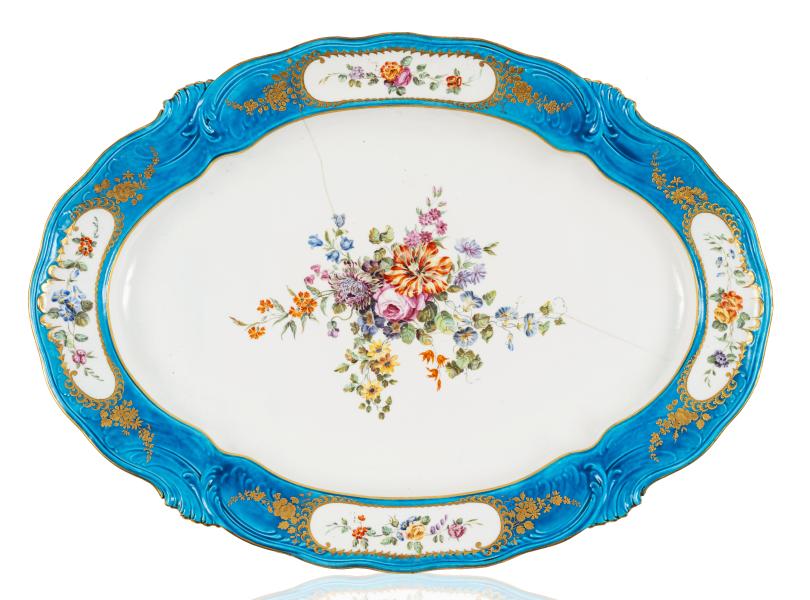
Vincennes porcelain manufactory, Large oval dish, 1755
© Auctie's
Thanks to the generosity of its members and the bequest of Michel Lefèvre, the Société des Amis de Versailles has acquired a large oval dish in soft porcelain from the prestigious ‘bleu céleste’ service commissioned by Louis XV from the Vincennes porcelain manufactory. Pre-acquired on 18 April 2025 at a public sale at Hôtel Drouot, this dish is one of four large oval dishes from the service delivered to the King on 31 December 1755.
This piece stands out for its exceptional dimensions (60.5 cm long by 44.5 cm wide) and the quality of its decoration. In the centre, a bouquet of polychrome flowers on a white background is framed by a wing decorated with crosses and palmettes in relief, as well as four painted flower reserves. Each reserve is bordered by a finely chased gilded frieze, characteristic of the ‘celestial blue’ service.
It was the first large royal dinner service produced by the Vincennes porcelain manufactory and marks the beginnings of excellence in French soft porcelain. Commissioned in 1751, production began in 1753 after the chemist Jean Hellot perfected the celestial blue ground, a rare shade inspired by the Chinese porcelain that was so popular in the 18th century. Comprising 1,749 pieces, including 1,266 in biscuit for table decoration, this service is a milestone in the history of French porcelain, used by the royal family until the end of the Ancien Régime.
At the time, the price of the dish was 840 livres, reflecting the complexity of its manufacture. It required a high level of technical expertise, in terms of shaping, firing, colouring and handling such a fragile and imposing piece. This unprecedented acquisition joins a collection of thirteen pieces assembled since 1995 by the Palace of Versailles, and highlights the artistic excellence of the celestial blue service, a symbol of refinement at the table of Louis XV.
Portrait of Anne of Austria, Regent of France (1601 - 1666) and her son Louis XIV (1638 - 1715)
by Charles and Henri Beaubrun

Charles et Henri Beaubrun, Portrait of Anne of Austria, Regent of France (1601 - 1666) and her son Louis XIV (1638 - 1715), around 1644 - 1645
© Osenat
Exercising its right of pre-emption, the Palace of Versailles recently acquired this portrait of Louis XIV as a child with his mother, the regent Anne of Austria, at a public sale on 18 May 2025. Painted around 1644-1645 by the cousins Charles and Henri Beaubrun, court painters of the 17th century who were much appreciated by the Queen Mother, this painting illustrates a pivotal moment in the history of France, both intimate and political, between the death of Louis XIII and the beginnings of the Fronde.
Painted two years after the accession of Louis XIV, the painting features a rich iconography, with Queen Anne of Austria wearing white mourning, a rare medieval heritage in the 17th century. The young king, still dressed as a child, places his hand on his mother's in a gesture of trust that underlines their emotional and political bond. The approach of Louis XIV's seventh birthday marked his passage into the age of reason. This moment of transition separates him from the nannies who have brought him up since birth, and places him in the hands of men, governors, tutors and valets, symbolically leaving his childhood dress behind. This portrait bears witness to a key moment when the young Louis XIV, at the dawn of the Fronde, took his first steps in the exercise of power, leading him to Versailles.
The quality and format of this oil on canvas indicate that it was commissioned by a high-ranking figure, probably a diplomat. It joins a group of works by the Beaubrun family already in Versailles, and echoes the great dynastic portraits in other European collections, such as those in the Prado Museum and the Nationalmuseum in Stockholm. The portrait of Louis XIV as a child with his mother has therefore joined the Palace of Versailles collection, where it can be admired in the Louis XIV rooms.
2024
Portrait of Louis XV as a child
By Rosalba Carriera
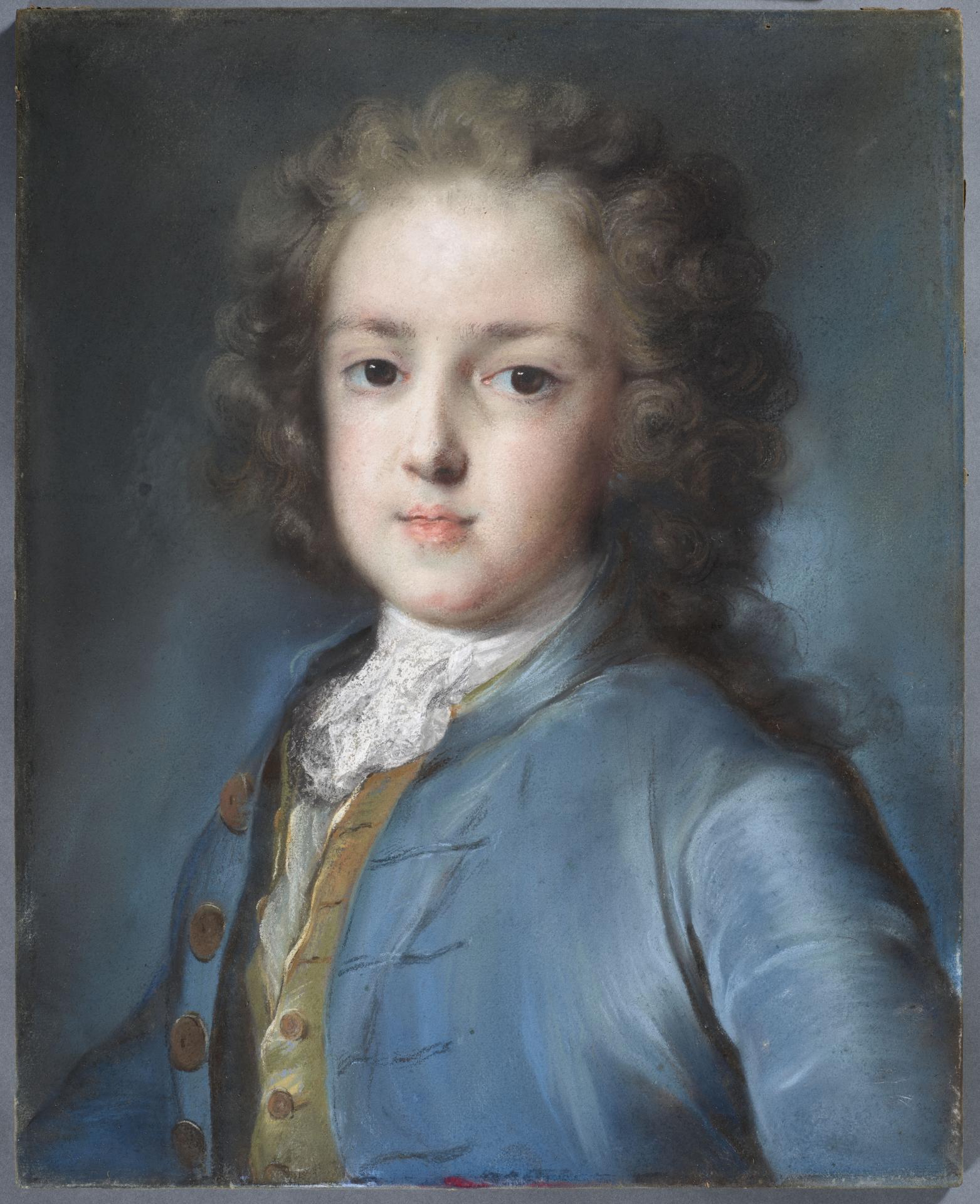
Rosalba Carriera, Portrait of Louis XV as a child, 1720
© Château de Versailles, Dist. RMN © Christophe Fouin
In July 2024, the portrait of Louis XV as a child by Rosalba Carriera was acquired thanks to the patronage of Hubert and Mireille Goldschmidt, through the American Friends of Versailles.
The famous Venetian portraitist Rosalba Carriera (1675-1757), commissioned by royal and aristocratic families across Europe, was invited to Paris by the financier, art lover, and patron Pierre Crozat. She stayed in his mansion between April 1720 and March 1721, forging several bonds with French artists, notably Antoine Coypel and Antoine Watteau. Her reputation and her talent drew a wide clientele, enchanted by her portraits that melded a faithful version of the model with an idealized one, realism with illusion. Her time in Paris, the details of which are recorded in her near-daily diary entries, culminated in the creation of a portrait of the young Louis XV.
Starting on 14 June 1720, the King agreed to sit for several sessions for the artist, prompting his tutor, the Marschall of Villeroi, to remark: “You must be pleased the king has such patience.” On 29 December, Rosalba Carriera recounts that she was “brought into the King’s private chamber to see where we could hang (his) pastel portrait, which just that day had been taken to the Palace in a grand frame and was first displayed in the room where the King played.” Presented to the Royal Academy of Painting and Sculpture on 26 October 1720, this pastel painting earned the Venetian artist her reception in this institution the very same day.
Rosalba Carriera created other versions, in various sizes and with different media. Preserved in Dresden, the best-known version uses a more richly nuanced and perhaps more subtle palette. Softened contours and a slimmer face lend a less childlike aspect to the young man, while the rich orange reflections playing on the embroidery, the fleur-de-lys pattern on his coat, the presence of the blue riband and the cross of the Order of the Holy Spirit accentuate his royalty.
In this more intimate portrait acquired by Versailles, the sketch is still visible along the contour of the face. Rosalba Carriera displays her virtuoso pastel technique in the velvety texture of the skin, the brilliance and softness of the gaze, and the movement and lightness of the curls. Kept in a private collection for more than two centuries, it comes with a legend: during the Revolution, the royal symbols were erased, and the canvas hidden in a well!
This exceptional pastel completes the already rich series of effigies of the young Louis XV preserved in Versailles, in particular the portrait sculpted by Antoine Coysevox, which depicts him at the same age.
2023
Royal Mass at the Tuileries
By Hubert Robert
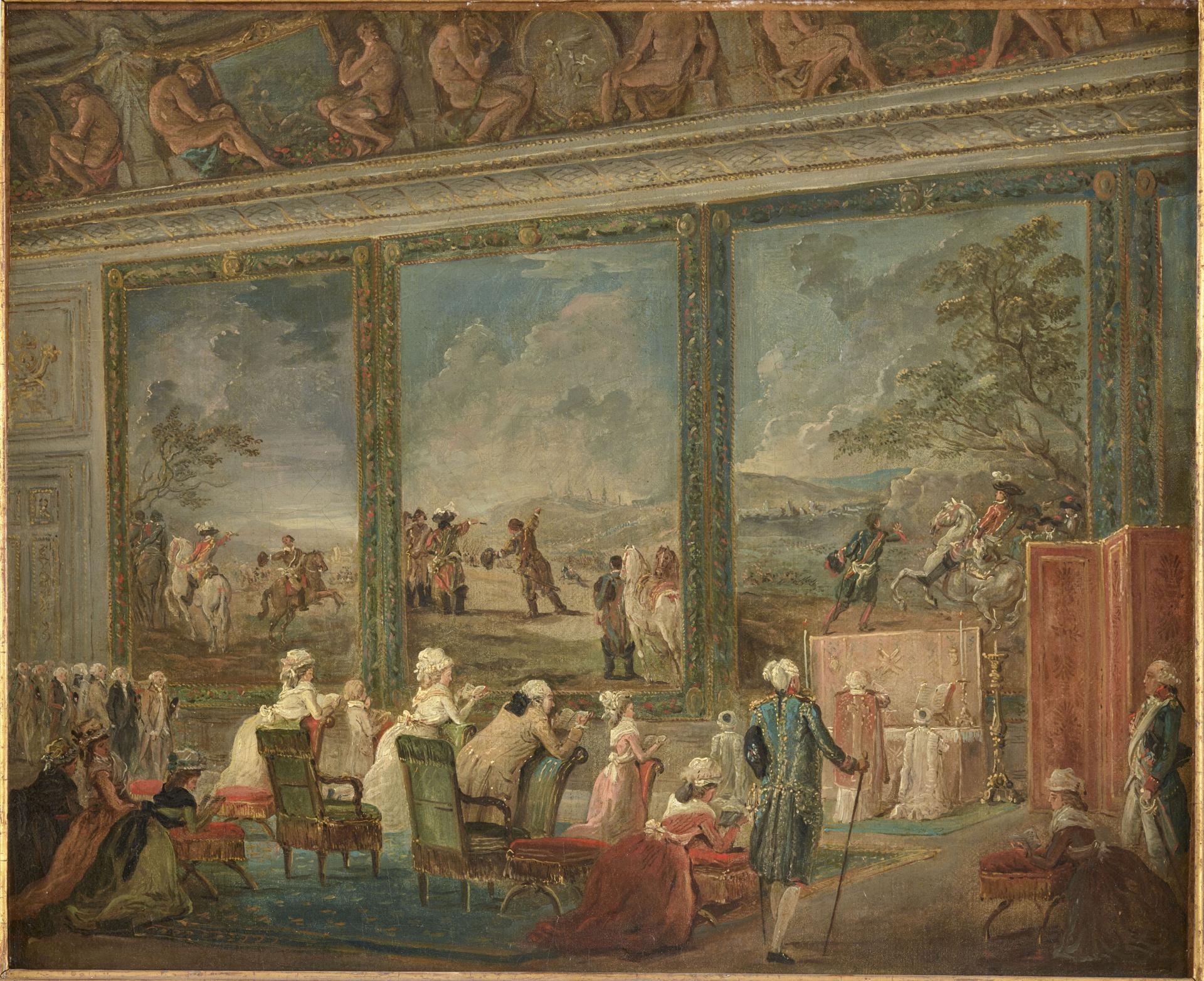
Royal Mass at the Tuileries by Hubert Robert
© Château de Versailles, Dist. RMN © Christophe Fouin
Classed as a “work of great historic interest and artistic significance”, Royal Mass at the Tuileries is a valuable, perhaps unique, evocation of the life of the royal family during the Revolution, at the time of their imprisonment in the Tuileries Palace (1789-1792). After two days of protests and violence on 5 and 6 October 1789, Louis XVI left Versailles under pressure from the people. Monarchical power was brought back to the capital and established at the Tuileries, along with the National Constituent Assembly.
The king and his family are shown attending mass beneath the vault of the Ambassadors’ Gallery. Kneeling on their prie-Dieu chairs, Louis XVI and Marie-Antoinette are surrounded by their children, the Dauphin and Madame Royale, and accompanied by Madame Élisabeth, the king’s sister. The other figures are harder to identify; we can undoubtedly see some of the queen’s closest companions (Madame de Tourzel, Madame de Mackau, the Princesse de Lamballe, the Marquise d’Ossun and the Duchess of Maillé) and the Marquis de Dreux Brezé, the last to remain loyal to the crown. The presence of an officer of the National Guard, on the edge of the scene, is a reminder of the main figures’ state of imprisonment. At the other end of the gallery, a group of deputies, who have just left the National Assembly, are entering the scene and add tension: a symbol of the advancing Revolution, they are about to pass in front of the royal family, the refractory clergy members and the former glory of Louis XIV’s conquests, celebrated in the tapestries. Here, the new order and the Ancien Régime appear to be in cold confrontation, at a time of political instability and forced cohabitation. The artist, Hubert Robert, may have been present at the scene. After being appointed guard of the paintings of the Muséum – the future Musée du Louvre - in 1784, he could simply step through a door from the Grande Galerie into the Tuileries Palace. While it is not known who the work was originally painted for, it belonged to Madame Du Barry, Louis XV’s last mistress in 1793. It remained in the possession of the royal family and suffered the same unfortunate fate.
Purchased as a work of importance for heritage on 30 December 2022; thanks to the patronage of LOV Group.
Pair of footstools
Jacob-Desmalter & Cie

Pair of footstools by Jacob-Desmalter & Cie
© Château de Versailles, Dist. RMN © Christophe Fouin
This pair of footstools is one of the few remaining elements from the furniture delivered to Marie Louise for the Lord’s House, as the Queen’s House was named during the Empire. Situated at heart of the Hamlet and built for Marie Antoinette, the Queen’s House was designed by Richard Mique starting in 1783. Luxuriously furnished and decorated, its furniture was dispersed during the revolutionary sales of 1793-95. Under the Empire, the Petit Trianon and the Hamlet were restored and refurnished in order to welcome Empress Marie-Louise during her stays. The Drawing Room in the Queen’s House – later called the Lord’s House – was hung with yellow silk painted by Vauchelet, while the furniture was commissioned from upholsterer Darrac, who undoubtedly subcontracted the woodwork to cabinetmaker Jacob-Desmalter. The chairs were made of wood and painted white with gold highlights. They were covered with yellow silk velvet with a border of gold vine leaves. According to Darrac’s records, the two footstools were sent in 1812, as confirmed by the indication on the label on the undersides. The furniture remained in place until 1850, when it was sent to the Furniture Store-House. Like other items from Trianon, it was probably sold during the latter half of the 19th century. During restoration work in 2018, it was the furniture donated in 1965 by the Duchess of Massa that was restored and upholstered with yellow silk velvet. These two original footstools complement the set.
Bust of Etienne-Vincent de Margnolas, State Councillor, Prefect (1781-1809)
By Giacomo Spalla
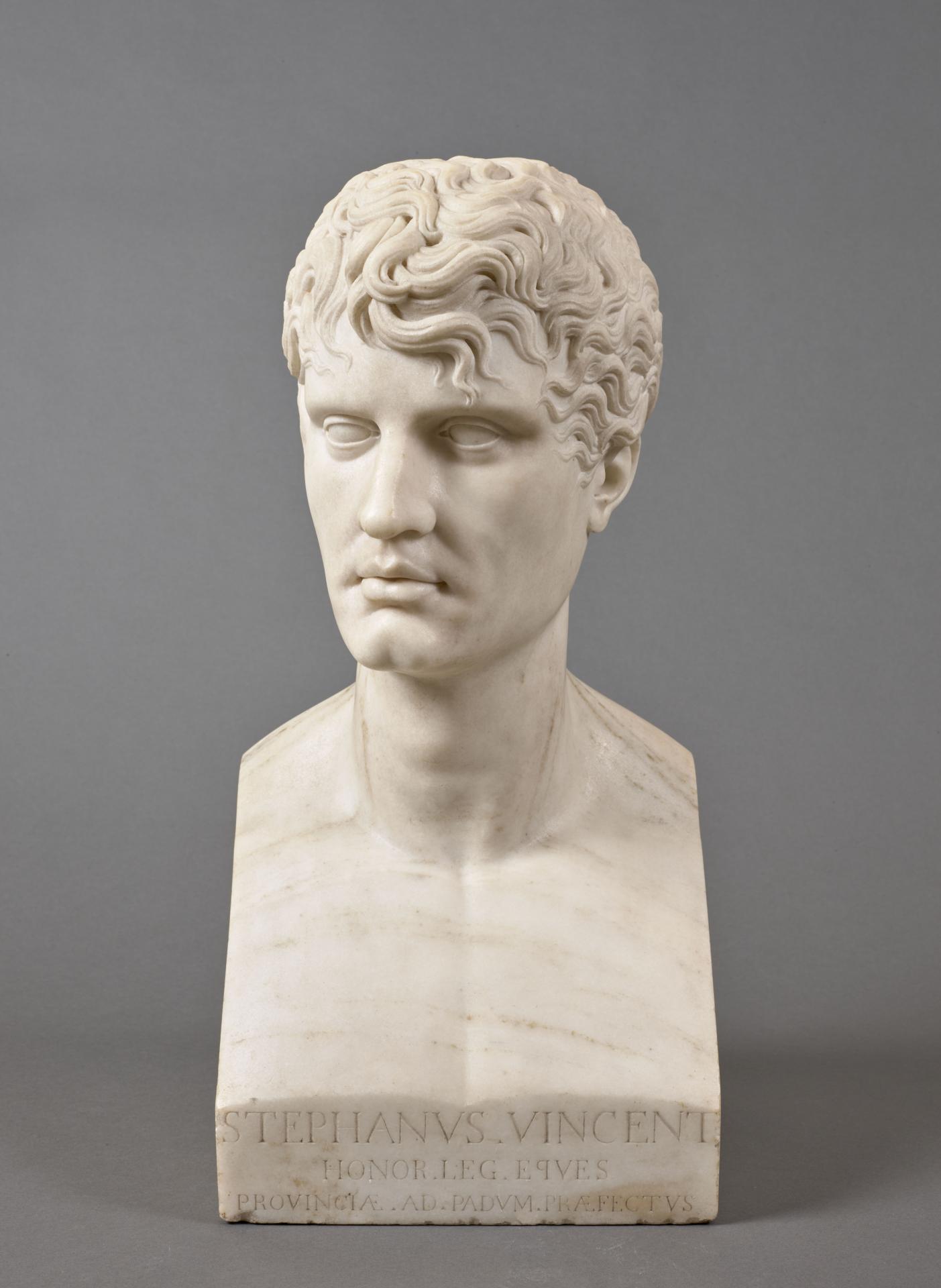
Bust of Etienne-Vincent de Margnolas, State Councillor, Prefect (1781-1809) by Giacomo Spalla
© Château de Versailles, Dist. RMN © Christophe Fouin
Born into a family from Lyon, Étienne Vincent de Margnolas left France during the Revolution. He settled in Italy, from where he maintained numerous connections, which explains his brilliant career across the border during the First French Empire. After working as administrator of the hospices of Lyon, auditor then officer in the Ministry of Finance from 1806 to 1807 and Emperor's commissioner to the Warsaw government commission, Margnolas was appointed Prefect of Pô in March 1808. Appreciated by Napoleon, he was also appointed state councillor on extraordinary duty in 1806, and was in charge of the correspondence of the third arrondissement of the general police for transalpine departments. In 1806, Margnolas married Caroline Béatrix Perrone di San Martino, whose mother was lady-in-waiting to Empresses Joséphine then Marie-Louise. Margnolas’ sudden death on 13 October 1809 cut short a promising career. Signed and dated 1808, this bust was made by Giacomo Spalla, perhaps to commemorate Margnolas’ appointment as Knight of the Empire and member of the Legion of Honour on 11 July 1807. It may also have been commissioned by the model at the time of his appointment as Prefect of Pô. Either way, the bust bears witness to Margnolas’ interest in the Turin art scene, of which Spalla was one of the most eminent representatives. Aged 27, Margnolas is represented in the ancient style, in timeless and heroic nudity. In addition to the Hermes shape, the treatment of the empty eyes gives the bust an ancient look that was prized among the elite at the time. Spalla attached great importance to the choice of marble. This bust was probably made in an ancient large-grained marble and its highly polished finish highlights the beauty of the material. The extreme delicacy of the carving of the curls testifies to Spalla’s stay in Canova’s studio. The face has a certain purity to it while staying true to the features of the model, whose chin was cleft with a small dimple.
Hunting scene in front of the Orangery, the Hundred Steps and the Palace of Versailles
By Pierre-Denis Martin and Adam-Frans Van der Meulen

Hunting scene in front of the Orangery, the Hundred Steps and the Palace of Versailles by Pierre-Denis Martin and Adam-Frans Van der Meulen
© Château de Versailles, Dist. RMN © Christophe Fouin
This view of Versailles, painted between 1695 and 1705, shows the appearance of the Palace after the construction of the envelope by architect Louis Le Vau, but before the creation of the tall golden roof of the chapel: only two small lanterns, built in 1682 on the roofs of the current Dufour and Gabriel pavilions, crown the palace. In the foreground, we can make out the Lake of the Swiss Guard, dug between 1679 and 1682, on which a fleet of boats is sailing, whose masts are topped with white flags. We can also see the first and second Hundred Steps and, of course, the Orangery with its gates and pilasters topped by sculptures by Le Conte and Legros. The painting also shows the ambitious works carried out on the city side, with the Large and Small Stables, the Grand Commun, the Récollets convent, the church of Notre-Dame, the Clagny palace and what is most likely the kennels. Painted with the tip of a brush, in contrast to the buildings sketched with a metal point, the hunting scene in the foreground successfully enlivens the landscape, showing the Court, no doubt led by the king, with his horsemen, packs of dogs and attendants in blue or red livery.
Study for the full-length portrait of the Dauphin Louis
By Charles-Joseph Natoire
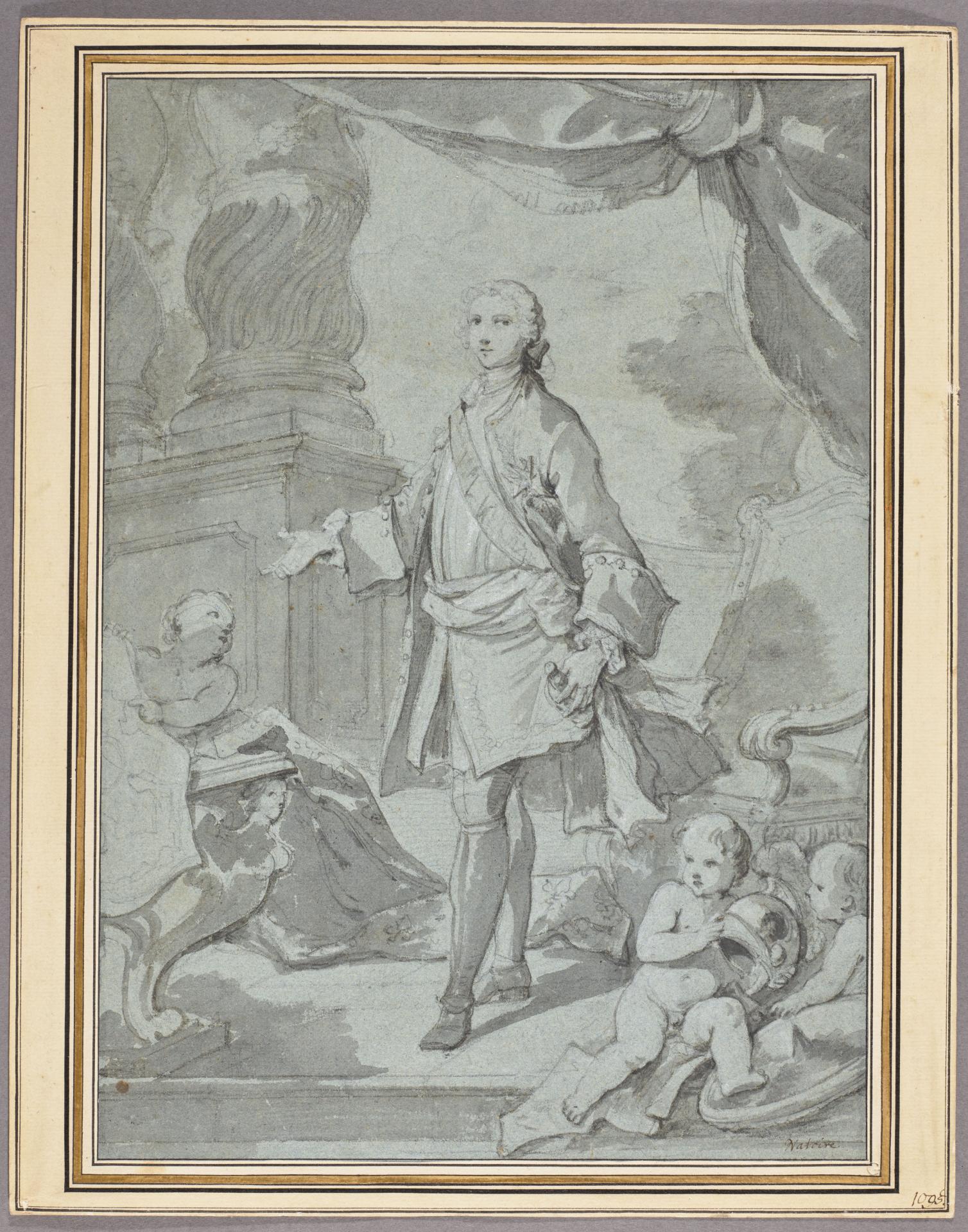
Study for the full-length portrait of the Dauphin Louis by Charles-Joseph Natoire
© Château de Versailles, Dist. RMN © Christophe Fouin
The creation of the portrait of the Dauphin Louis, son of Louis XV (1729-1765), preserved at Versailles (MV 3791), was the result of several preparatory drawings currently kept in different institutions. These show the evolution of Natoire’s composition and the Dauphin’s silhouette. However, for this painting, Natoire probably used a 1746 pastel work by Maurice-Quentin de La Tour, currently kept in the Antoine-Lécuyer Museum in Saint-Quentin, as a model, but with the figure turned to the left. The painter did many preparatory drawings for most of his compositions, using different styles and techniques for the same subject. Although he had a predilection for charcoal, he also used red chalk and pen to detail a composition over an initial charcoal outline. He used wash, trois crayons and finally watercolour to create more spectacular representations. The use of yellow or blue paper, which interacts with the wash, brought nuance to the contrasts and was an integral part of the process. This drawing, acquired at public auction, testifies to the liveliness of Natoire's technique, the firmness of his line and the methodical composition of the painting. A particularly fine example, it complements the only two other drawings by the artist conserved at the Palace de Versailles: an early sketch for Youth and Virtue presenting two princesses to France (V.2014.15) and the large watercolour of the Allegory for the birth of the Duke of Burgundy (INV.DESS 1264).
Socialism and Cholera
By Horace Vernet
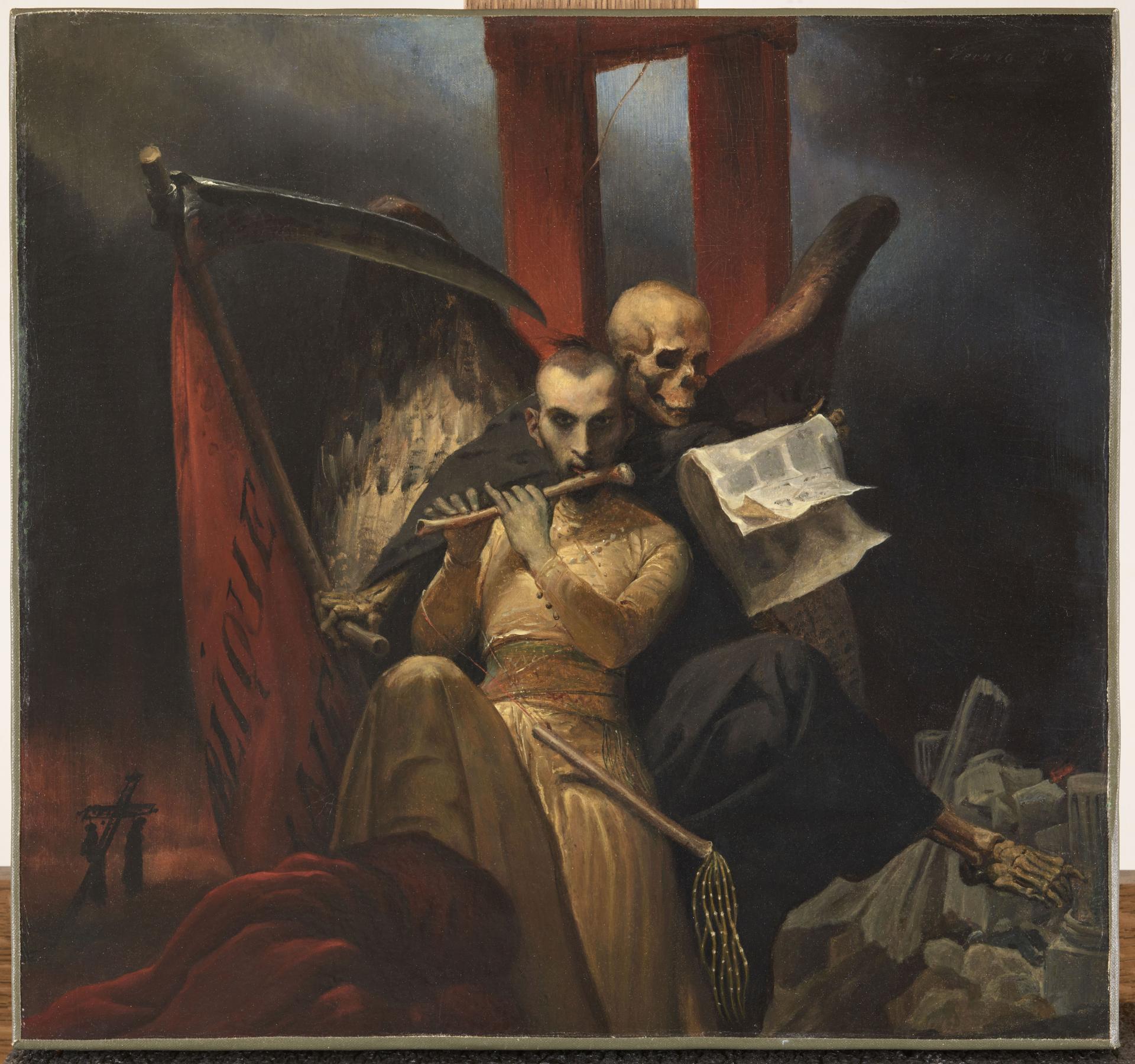
Socialism and Cholera by Horace Vernet
© Château de Versailles, Dist. RMN © Christophe Fouin
In an apocalyptic decor, at the foot of a guillotine, a mysterious looking young man in Asian dress with a whip with thongs and balls, Cholera, is playing a flute made of a tibia while leaning against the skeletal figure of Death with his wings spread out. Draped in black and armed with his scythe, the latter is holding the red standard of the Social Republic and is reading the paper Le Peuple. He also symbolises socialism. In the background are two monks hanging from a cross. In the larger, engraved version by Jazet, the foreground is filled with corpses and symbols of France slaughtered, fully justifying its title: Plagues of the 19th century, Socialism and Cholera, the death of the Republic. Very different to the large paintings commissioned from Vernet during the Restoration and the July Monarchy, this small, allegorical satire of the plagues of the 1848 revolution illustrates, for the first time in the collections of Versailles, the many private orders received by the artist, in a much freer and sometimes very grating vein. The first known owner of this work, which is exceptional in every respect, was Anatole Demidoff, the husband of Princess Mathilde, cousin of Prince-President Louis-Napoleon Bonaparte.
Marie-Antoinette’s service “with pearls and cornflowers”
The Sèvres Manufacture

Service “with pearls and cornflowers” commissioned in 1791 by Marie-Antoinette from the Sèvres Manufacture
© Château de Versailles, Dist. RMN © Christophe Fouin
Commissioned by Marie-Antoinette in July 1781 for the Petit Trianon, the service “with pearls and cornflowers” and its 295 pieces was the largest ever requested by the queen.
This service is a true masterpiece by the Manufacture de Sèvres, which required some 20 painters and several gilders to make it. It stands out for its refined decoration with perfectly harmonious colours dominated by blue, green and white highlighted by gold painted lines. The 295 pieces are each decorated with a design of sprigs and bouquets of cornflowers highlighted by two rows of pearls painted on a green background.
Figure of Apollo
By Noël Coypel
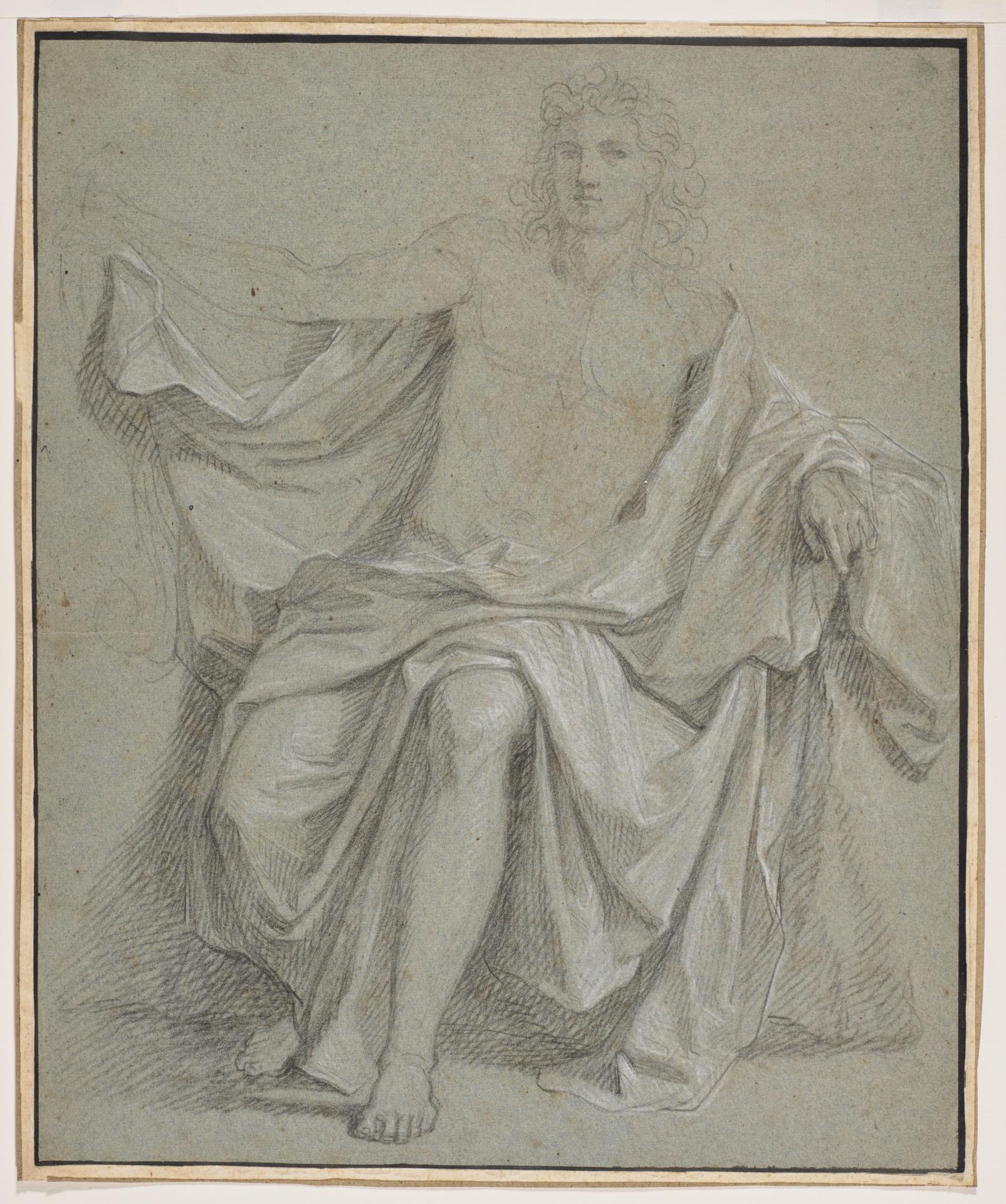
Figure of Apollo by Noël Coypel
© Château de Versailles, Dist. RMN © Christophe Fouin
In a neutral space, Noël Coypel sketched the young god’s face framed by curls and drafted the chest and arm holding a barely-hinted-at lyre. With just a few lines, he endowed his subject with a majestic presence and pose thanks to the sparce hatching that brings out the chest. In addition to the treatment of the drapery, we can see other features characteristic of Coypel’s work here: angular fingers, thick and muscular hands and arms and a certain imbalance in the posture. In the original painting, commissioned by Louis XIV in 1700 and now displayed in the Emperor’s Private Apartment in the Grand Trianon, Coypel used the same position for the god, with just a slight difference in the hanging and spread of his cloak (MV 6112). The elegance of the face is transformed into a serene, delicate and somewhat idealised image, in line with the spirit of the place for which it was made: the Marble Trianon. With its features characteristic of Noël Coypel’s style, this preparatory drawing for one of the paintings on the iconic theme of the Trianon decor under Louis XIV has found its rightful place in the graphic arts department of Versailles. It gives us a better understanding of the different stages leading to the overall composition of Apollo and the snake Python, in complement to a different idea that was rejected by the king in 1688 (INV.DESS 1206), and exemplifies a type of drawing by Coypel not previously included in the Versailles collections: the lone figure.
The Countess of Artois’ service “with pearls and cornflowers”
The Sèvres Manufacture

The service “with pearls and cornflowers” purchased by the Countess of Artois in 1788, made by the Sèvres Manufacture
© Château de Versailles, Dist. RMN © Christophe Fouin
The decoration is composed of a bouquet in a medallion and sprigs of little cornflowers on a white background, each framed by two rows of purple pearls. The composition of this service seems to complement the one bought by the Countess’ sister, the Countess of Provence, in 1781, which may testify to the lives of Marie-Antoinette’s sisters-in-law, who frequently organised meals together. The services can be distinguished by sight variations in the design, mainly in the size of the bouquet in the medallion, as well as their date of manufacture.
Watercolour of Louis XIV and his court ascending the Hundred Steps at Versailles
By Eugène Lami
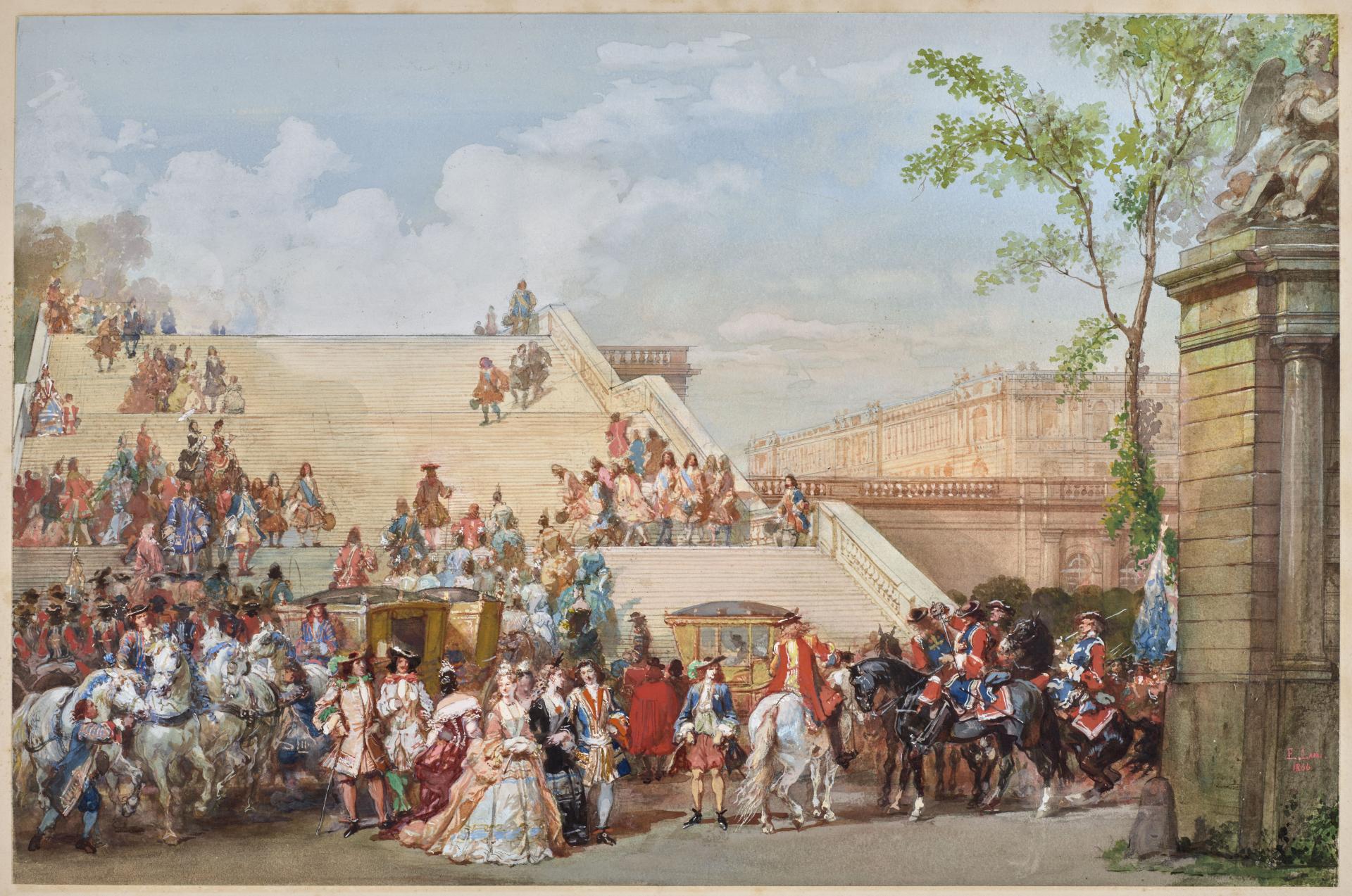
Watercolour of Louis XIV and his Court ascending the Hundred Steps at Versailles by Eugène Lami
© Château de Versailles, Dist. RMN © Christophe Fouin
This watercolour showing Louis XIV and his Court ascending the Hundred Steps fits in with the historicist and gallant vein that characterised the second part of Eugène Lami’s career. As explained by Valérie Bajou: “between 1874 and 1876, Lami produced several watercolours dedicated to the reception of the Prince of Condé by Louis XIV. On the steps in the park of Versailles, the king, surrounded by his Court, receives the Grand Condé who is presenting the flags taken from the English and the Dutch at the Battle of Seneffe. The work was executed quickly, with no contours and with highlights that give it all its energy; the brushwork, using scumbling of greys, yellows and pinks, strengthens the impression of depth. The light is distributed in a dramatic way, with a surprising slant of shadow on the facade of the War Room, while the figures are lit in full”. Until now, the Palace of Versailles had no picture of this kind in its collections. Lami’s oeuvre was well represented by his battle paintings, but the Palace had only one of the large watercolours of contemporary scenes for which he was famous: Dinner given by Emperor Napoleon III for Queen Victoria in the Opera House of Versailles, on 25 August 1855 (INV.DESS 768). The purchase of this large-scale watercolour at public auction makes it possible to evoke the Versailles vein of this artist’s work.
2022
Portrait of Henrietta of England
By Jean Nocret

Historicised portrait of Henrietta of England, Duchess of Orléans
© Château de Versailles, Dist. RMN © Christophe Fouin
This painting complements a fine collection of works by Jean Nocret, official painter to the Sun King’s brother. Made in particularly bright colours, the painting represents Henrietta of England, the first wife of Philippe of Orléans, Louis XIV’s brother, floating in the sky and throwing flowers to mortals. The iconography may be that of Flora or, more likely, Aurora, the goddess who heralded dawn and announced the break of day, in which case the flowers would be a reference to the morning dew.
The portrait was hung in the Louis XIV rooms in the Palace on 27 June.
This purchase was made possible thanks to the patronage of Ms Campbell-Pretty.
“Flying dragon” sled
After Jean Bérain
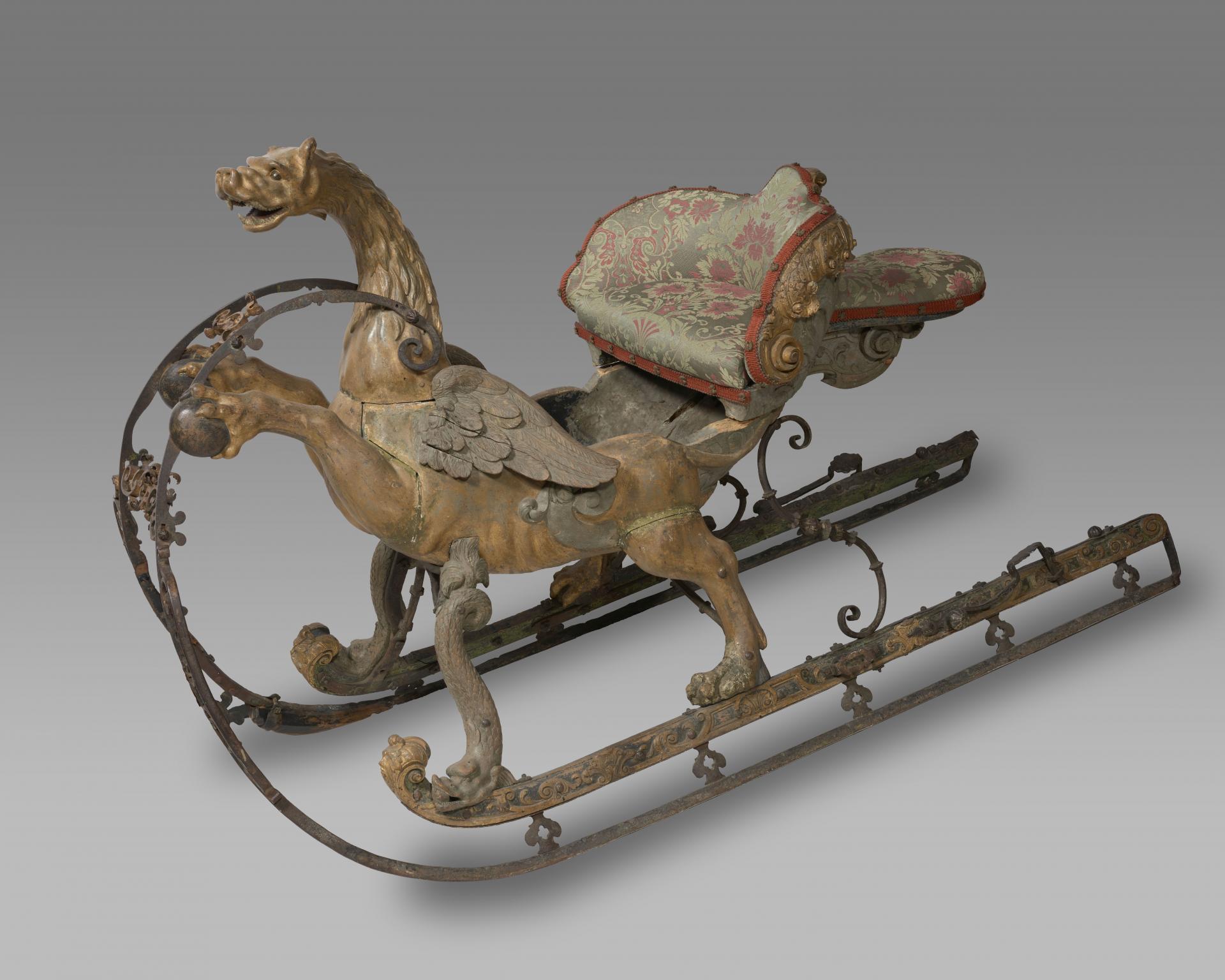
“Flying dragon” sled
© Château de Versailles, Dist. RMN © Christophe Fouin
Donated by the Dalva Brothers Gallery in New York, this sled joins the exceptional collection of six sleds commissioned during the reign of Louis XV, kept in the Gallery of Coaches at the Palace of Versailles. This type of sled, used for outings on the snowy paths during harsh winters, would have been drawn by a horse with studded shoes and dressed in an elegant caparison decorated with gold and silver bells, driven by a manservant who was half-sitting half-standing on the back seat, while a lady sat inside.
The sled owes its name to the large, superbly carved chimera that forms the body, which has the head of a menacing dragon, the wings of an eagle and the body of a griffin. Standing firmly on its hind legs and clasping two spheres in its dewclaws, the dragon is supported in its momentum by two large carved dolphins. The presence of two large dolphins on the base and the fleur-de-lis and intertwined Ls on the carved decor has led to the suggestion that this sled was made for Monseigneur. Although this is likely the case, the current state of research is unable to confirm with certitude that the sled was designed for the Grand Dauphin.
Plate from the French iconographic service: Guillaume de La Mothe-Piquet
The Sèvres Manufacture

French iconographic service: Guillaume de La Mothe-Piquet
© Château de Versailles, Dist. RMN © Christophe Fouin
Commissioned under Louis XVIII, the “French iconographic service” was delivered to the king’s brother and successor Charles X for the Grand Trianon palace in 1824. It originally included 90 plates, 2 sugar bowls, 24 footed plates and 16 fruit dishes in four different forms. The plates were all based on the same design. The border is painted with gold-marbled lapis lazuli framed by “grecques” and a frieze of leaves. The centres of the plates display portraits of great men from the 17th and 18th centuries, including military men, ministers, scientists and artists. The name and dates of the figures displayed are written on the backs of the plates, which makes it easy to identify them.
This plate purchased in 2022 shows Toussaint-Guillaume Picquet de la Motte, known as La Motte-Piquet, a Lieutenant-General of the Navy who took part in many naval battles.
Portrait of Jean-Benjamin de la Borde, First Valet de Chambre to the King
Louis-Carrogis, known as Carmontelle
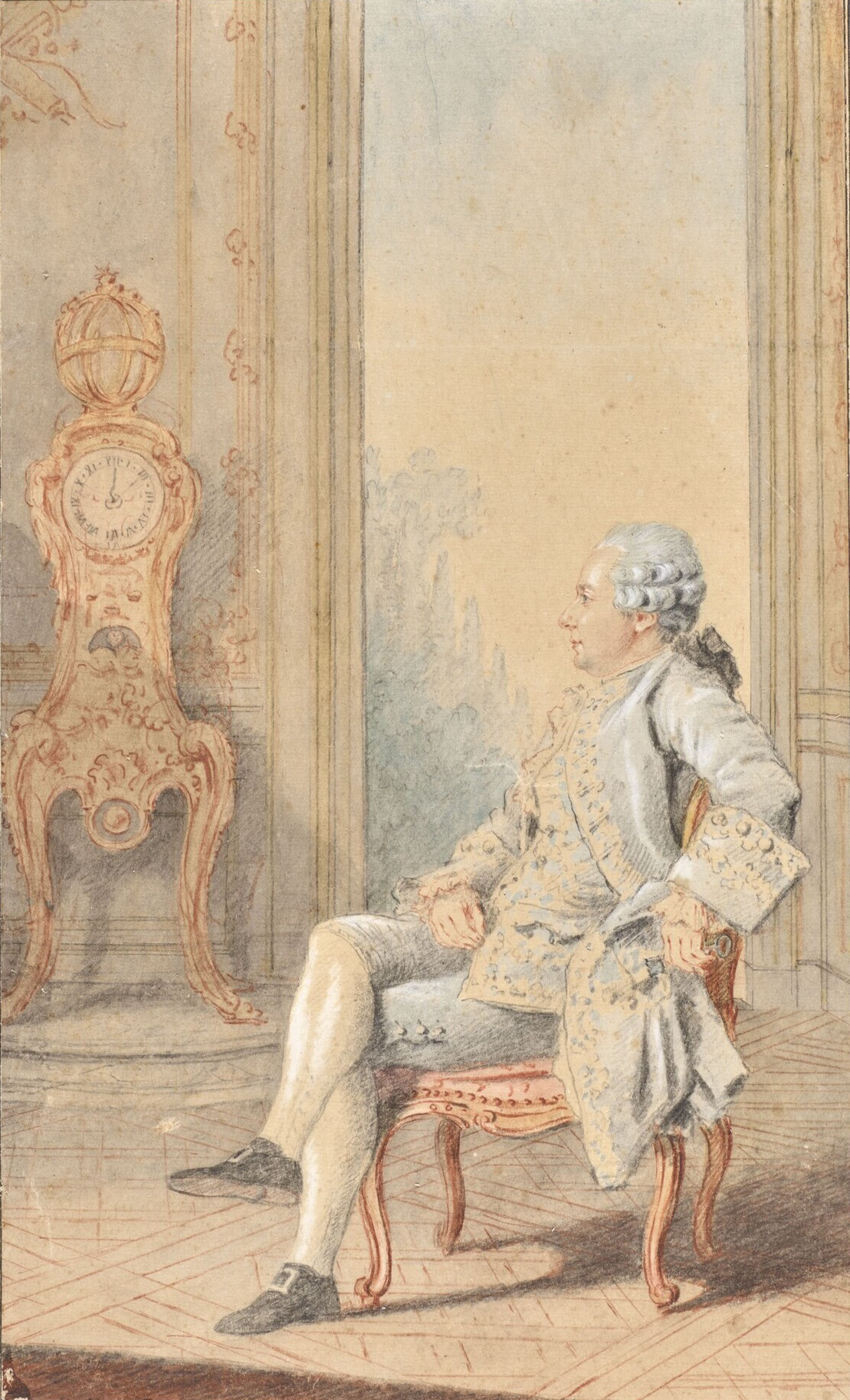
Portrait of Jean-Benjamin de la Borde, Louis-Carrogis, known as Carmontelle (1717-1806), circa 1762, Sanguine, black pencil and watercolour on paper
© Château de Versailles, Dist. RMN © Christophe Fouin
This purchase was made thanks to the patronage of the Friends of Versailles Society.
Jean-Benjamin de La Borde (1734 -1797), appointed First Valet de Chambre to King Louis XV in 1762 and governor of the Louvre, is shown sitting down in front of the famous astronomical clock designed by Claude-Siméon Passemant (1743) and placed in the King’s Private Apartment in 1754. The clock is shown complete, with its gilded bronze case - a rococo masterpiece by Jacques Caffieri - and its marble pedestal.
In this fine watercolour work, La Borde holds a key in his left hand, no doubt evoking his position as governor of the Louvre.
Louis Carrogis, known as Carmontelle, was an 18th-century portraitist and a man of the world. Here, he indirectly represents a member of Louis XV’s inner circle of which only two engraved portraits were previously known. Appreciated by the nobility for his quickness of mind, Carmontelle made 700 watercolour portraits during the 1760s, 70s and 80s. Baron Grimm praised his “talent for singularly capturing the air, posture and spirit of the figure more than the resemblance of the features”. His models, who included men and women of all classes, were almost always depicted in profile and were associated with objects or ornaments that evoked their tastes or personality.
Presumed portrait of Philippine-Elisabeth d'Orléans, Mademoiselle de Beaujolais
Jean-Marc Nattier

Presumed portrait of Philippine-Elisabeth d'Orléans, Mademoiselle de Beaujolais
© Château de Versailles, Dist. RMN © Christophe Fouin
Philippine Élisabeth Charlotte d'Orléans, known as Mademoiselle de Beaujolais, was one of the daughters of the regent, Philippe d'Orléans. The nephew of Louis XIV, the latter became regent of the kingdom until the future Louis XV came of age. Mademoiselle de Beaujolais’s mother was Françoise-Marie de Bourbon, the legitimated daughter of Louis XIV.
This painting is somewhere between portraiture and history painting: Love with sheet music gives the work an allegorical meaning, while Mademoiselle de Beaujolais is represented as the muse of music. Highly realistic, the portrait is also firmly anchored in its time by the presence of the guitar, which was particularly popular in salons in the 18th century. The one here in the young woman’s hands is particularly elaborate, with five courses, lateral strips probably made of tortoiseshell and a headstock with alternating ivory and ebony inlays.
Portrait of Catherine Duchemin, flower painter, at her easel
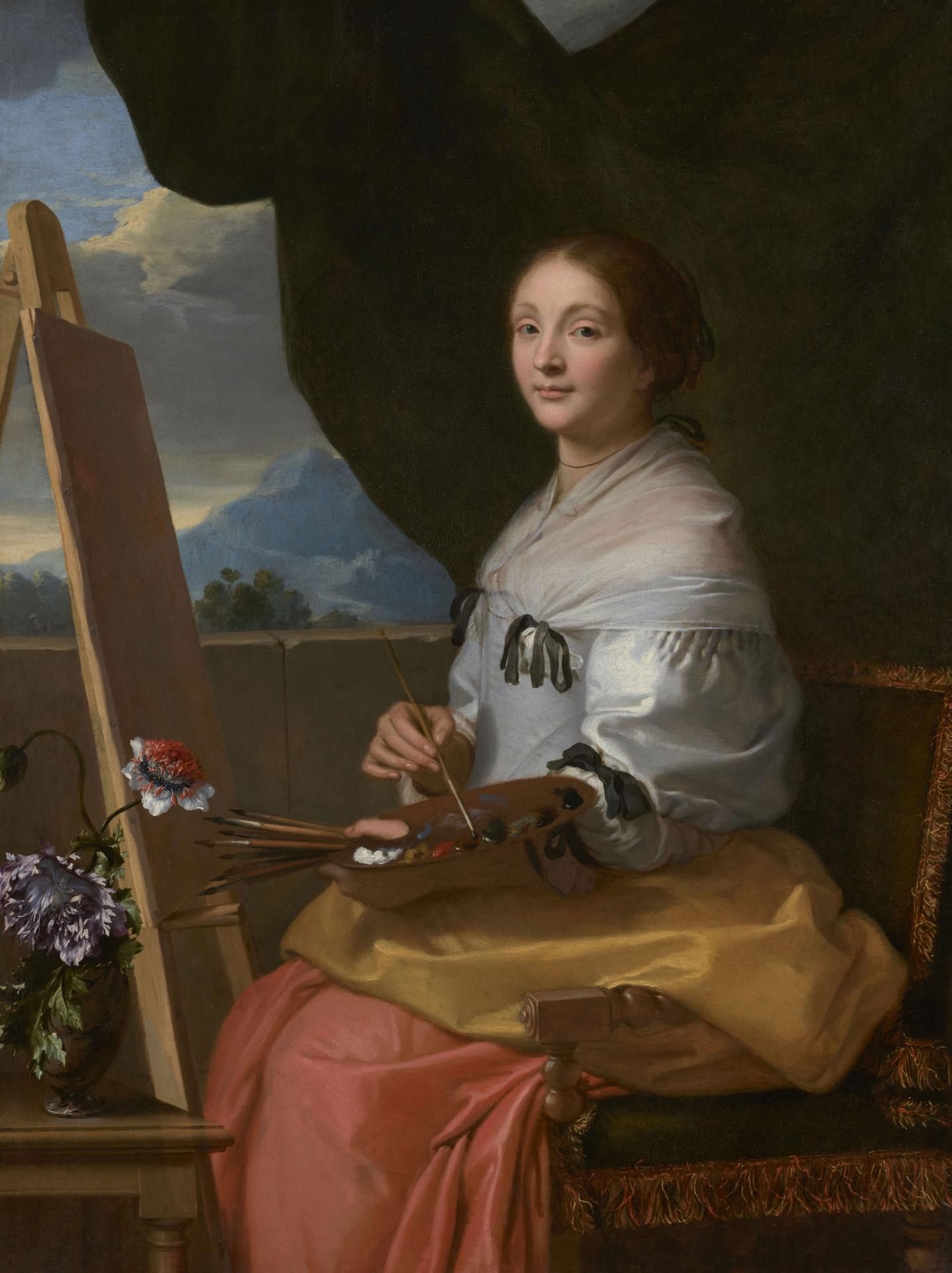
Portrait of Catherine Duchemin, flower painter, at her easel
© Château de Versailles, Dist. RMN © Christophe Fouin
Catherine Duchemin (1630-1698) is renowned as being the first female painter to be admitted to the Académie Royale, on 14 April 1663. The meagreness of her body of work did not prevent her from going down in history as the first woman member of the Académie, while her features are known thanks to this painting that entered the collections of the Palace of Versailles in 2022.
Typical of portraits of artists from this period, the painting portrays her in front of her easel, palette and brushes in hand, with a table beside her on which sits a bunch of poppies and a double anemone that she is in the process of painting. The composition exudes great elegance, both in the artist’s refined pose and in the setting proposed by the painter, with a low wall and green drapery revealing a mountain landscape in the background. While this portrait leaves some questions unanswered, it is nonetheless a landmark work in 17th-century French painting that fits perfectly into the collection of portraits of Académie members conserved at Versailles.
Prince Albert led by the Prince of Joinville and the Dukes of Nemours and Montpensier at the review of the 1st Carabiniers Regiment, near the Château d’Eu, 5 September 1843
Hippolyte Bellangé

Prince Albert led by the Prince of Joinville and the Dukes of Nemours and Montpensier at the review of the1st Carabiniers Regiment, near the Château d’Eu, 5 September 1843
© Château de Versailles, Dist. RMN © Christophe Fouin
Queen Victoria’s trip to France, to the Château d’Eu, in September 1843, was made at the monarch’s own initiative and remained a private affair due to political tension between the British and French governments at the time. Nevertheless, it was the first visit to France by a reigning British sovereign since the meeting between Henry VIII and Francis I on the Field of the Cloth of Gold in June 1520. To commemorate this historic visit, King Louis-Philippe invited artists to the event and commissioned paintings and watercolours, which he presented to the queen in an album the following year. He also added a new room to the Château d’Eu on the garden side, which he named the “Victoria Gallery”, which was lit by a roof light and was entirely decorated with the paintings in question.
The artist, Hippolyte Bellangé (1800-1866), devoted himself almost entirely to military subjects and was one of the greatest battle painters of his time. This painting, of which the commission and Orléans family provenance is perfectly documented, joins 15 other paintings of Queen Victoria’s first visit to France already conserved at Versailles, as well as a dozen others showing subsequent reciprocal visits between the two sovereigns, in 1844 and 1845.
Madame Du Barry’s small service “with putti”: shell fruit dish
The Sèvres Manufacture
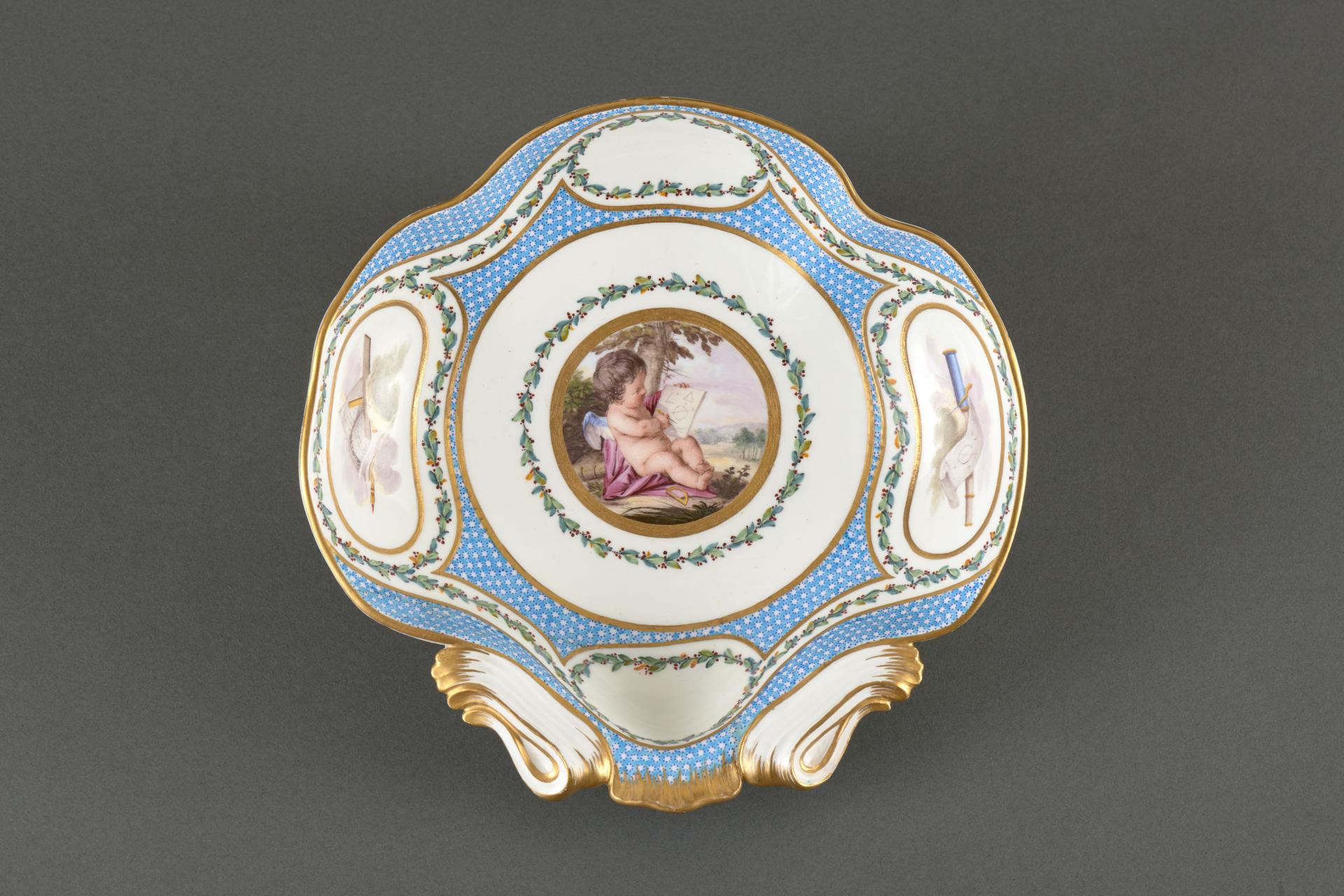
Madame Du Barry’s small service “with putti”: shell fruit dish
© Château de Versailles, Dist. RMN © Christophe Fouin
This shell-shaped fruit dish is part of a dinner service delivered to Madame Du Barry on 1st September 1770 by the Royal Sèvres Porcelain Manufacture. It was a small dinner service “with a starry blue ground with Children”, intended for two people and included no more than 37 pieces, including two plates currently kept in the British royal collections. The pieces of this service are all entirely decorated with a “Taillandier” sky blue starry ground with medallions featuring allegories with small Putti in landscapes and trophies. The cartouches are framed by gilded lines and branches of myrtle leaves.
Table en chiffonnière
Under the direction of Dominique Daguerre

Table en chiffonnière
© Château de Versailles, Dist. RMN © Christophe Fouin
Made under the direction of Parisian decorative-arts purveyor Dominique Daguerre (ca. 1725-1796), this circular table en chiffonnière was a personal acquisition by Marie-Joséphine of Savoy (1753-1810), Countess of Provence. Characteristic of the highly luxurious works produced under the direction of Parisian purveyors, it was made by Adam Weisweiler (1744-1820), who inserted two plates supplied by the Royal Sèvres Porcelain Manufacture, under the supervision of Daguerre.
The princess intended this little table for her rooms in the Palace of Versailles, but the royal family left Versailles for Paris in October 1789, and the Count and Countess of Provence moved into the Hôtel du Petit Luxembourg. A precise description of this item appears in the revolutionary inventory of the residence when the princely couple's possessions were seized after they emigrated.
Fire screen
Tilliard père et fils

Fire Screen
© Château de Versailles, Dist. RMN © Christophe Fouin
This curved fire screen in the late Rococo style displays a decorative blend typical of the new Neoclassical aesthetic of the mid-1760s: chutes of flowers hanging from a patera over the runners, the foliage crowning the centre of the frame, and the empty cartouches decorating the joints of the stand, reminiscent of Mannerist strapwork. The use of Neoclassical elements in a carved frame testifies to a phase that reached its peak around 1770. The work of Tilliard père et fils, both ordinary cabinet-makers to the Royal Furniture Treasury, was part of this innovative trend.
The letter W painted in ink under the bottom crosspiece of this finely carved screen proves that it was used in the rooms at Versailles upon its delivery. It was included in Queen Marie-Antoinette’s private furniture treasury, of which it bears the circular branded mark (added in 1784), but its style and ornamentation make it quite certain that it was commissioned by an unidentified person before Marie-Antoinette came to France for her marriage to the Dauphin in May 1770.
“Attributes and redcurrants” service from the Petit Trianon: pair of oil dishes
The Sèvres Manufacture
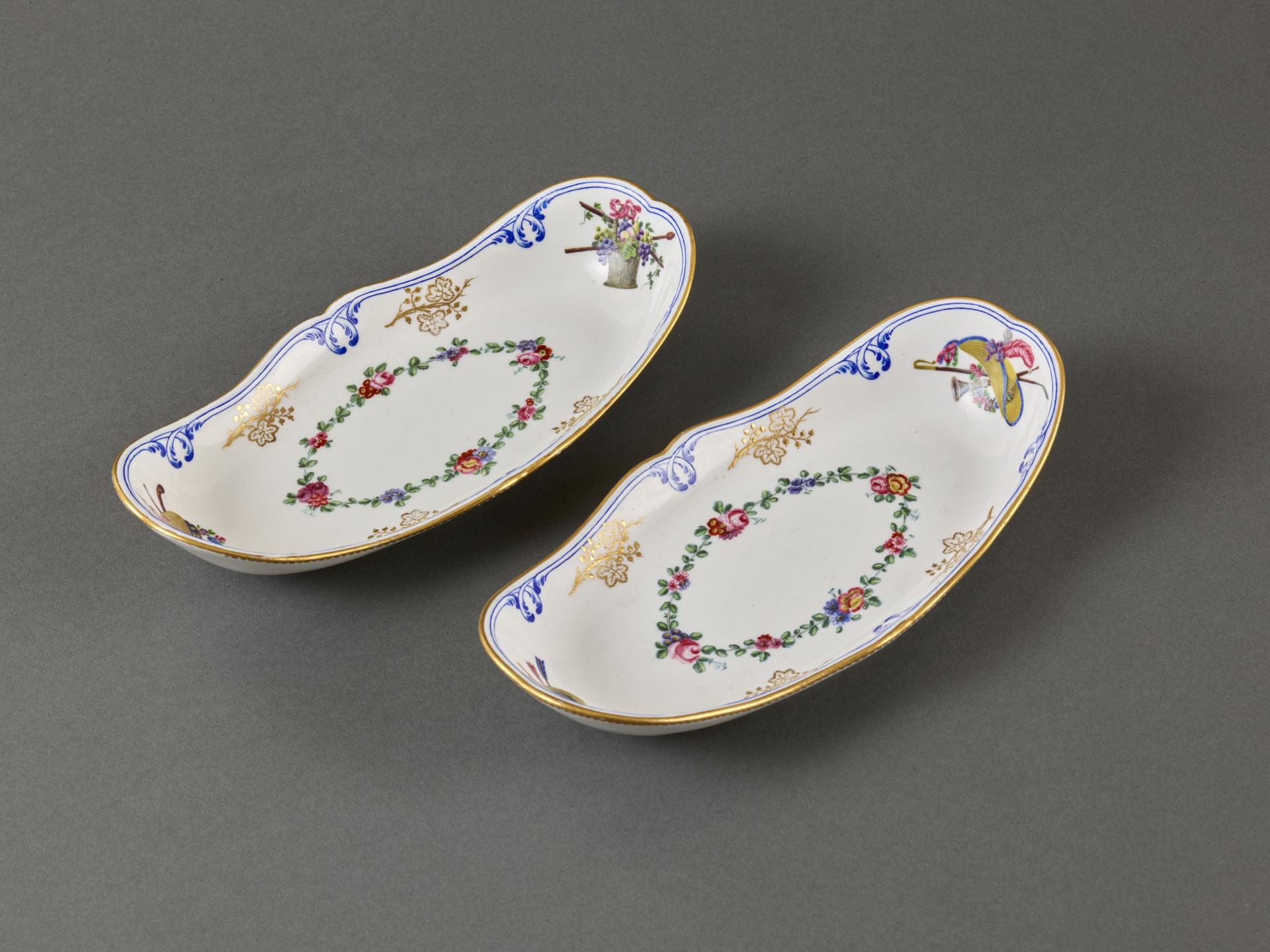
“Attributes and redcurrants” service from the Petit Trianon: pair of oil dishes
© Château de Versailles, Dist. RMN © Christophe Fouin
This pair of oil dishes was probably part of the first delivery of the “attributes and redcurrants” service in December 1763, which included “two oil dishes” at 48 Livres each. They were designed to hold a pair of oil and vinegar cruets. Of a slightly curved, oblong shape, each piece displays a wreath of flowers in the centre and two trophies on the rims alternating with redcurrants painted in gold, all framed by lobes formed by a thin blue line with leaves. The outer gilding displays a wolf's teeth motif.
This service purchased by Louis XV was no doubt intended for the Cool Pavilion or the dining room in the French Pavilion. It was later used in the Petit Trianon and the Palace of Versailles.
Portrait of Etienne François de Choiseul-Beaupré Stainville, Duke of Choiseul
Adélaïde Labille-Guiard

Portrait of Etienne François de Choiseul-Beaupré Stainville, Duke of Choiseul
© Château de Versailles, Dist. RMN © Christophe Fouin
This painting showcases both the talent of portraitist Adélaïde Labille-Guiard (1749-1803) and a key figure during the reign of Louis XV: the Duke of Choiseul. After training as a painter under François-André Vincent, Labille-Guiard was admitted to the Académie de Saint-Luc in 1769 then the Académie Royale in 1783. The protégé of Madame de Pompadour, the Count of Stainville embarked on a military career, rising to the rank of Lieutenant General in the king's armies. Appointed French ambassador to the Holy See in Rome and then Vienna, he received the title of Duke of Choiseul-Amboise in 1758. He was appointed Secretary of State for Foreign Affairs (1758-1761) then for the Navy (1761-1766) and for War (1761-1770), and reformed the two latter ministries. Madame Du Barry, to whom he had spoken undiplomatically, played a role in his eviction from the court at the end of 1770, forcing him into exile in his estate of Chanteloup, near Amboise. On the accession of Louis XVI, Choiseul was allowed to return to Paris, where he died on 8 May 1785.
While respecting the codes of the ceremonial portrait, the artist here uses subtle variations. The Duke of Choiseul's relaxed attitude is clearly visible: his breeches are untied at the knee, several buttons on his waistcoat are undone, and his body is slightly slumped. The elegantly knotted tie, the lace on the ruffle and the shirt sleeves protruding from the suit all contribute to the naturalness of the effigy. An extraordinary air emanates from this portrait, in which the Duke of Choiseul’s spirit and gaiety are clearly visible. The artist finished this portrait after the model's death in 1786.
Abundance distributing her gifts over the Earth
Lambert Sigisbert Adam

Abundance distributing her gifts over the Earth
© Château de Versailles, Dist. RMN © Christophe Fouin
Commissioned by Louis XV for his Choisy residence, this major work was made by Lambert Sigisbert Adam between 1753 and 1758 and then completed by his nephews. Abundance was intended to feature in a “Peace Grove” designed by Charles Antoine Coypel to celebrate the second Treaty of Aix-la-Chapelle (1748) which ended the War of the Austrian Succession. Of the five sculptures commissioned for this grove, this allegory of renewed prosperity under the auspices of the peace-making king was the only one that was finished.
In accordance with Cesare Ripa’s Iconologia, Adam represented the allegory of Abundance as a woman crowned with a garland of flowers and holding a horn of plenty from which bunches of raisins, peaches and ears of corn are spilling out. Fruit and flowers cover the base, which is also strewn with coins and jewels
Zephyr and Flora
Philippe Bertrand, René Frémin and Jacques Bousseau
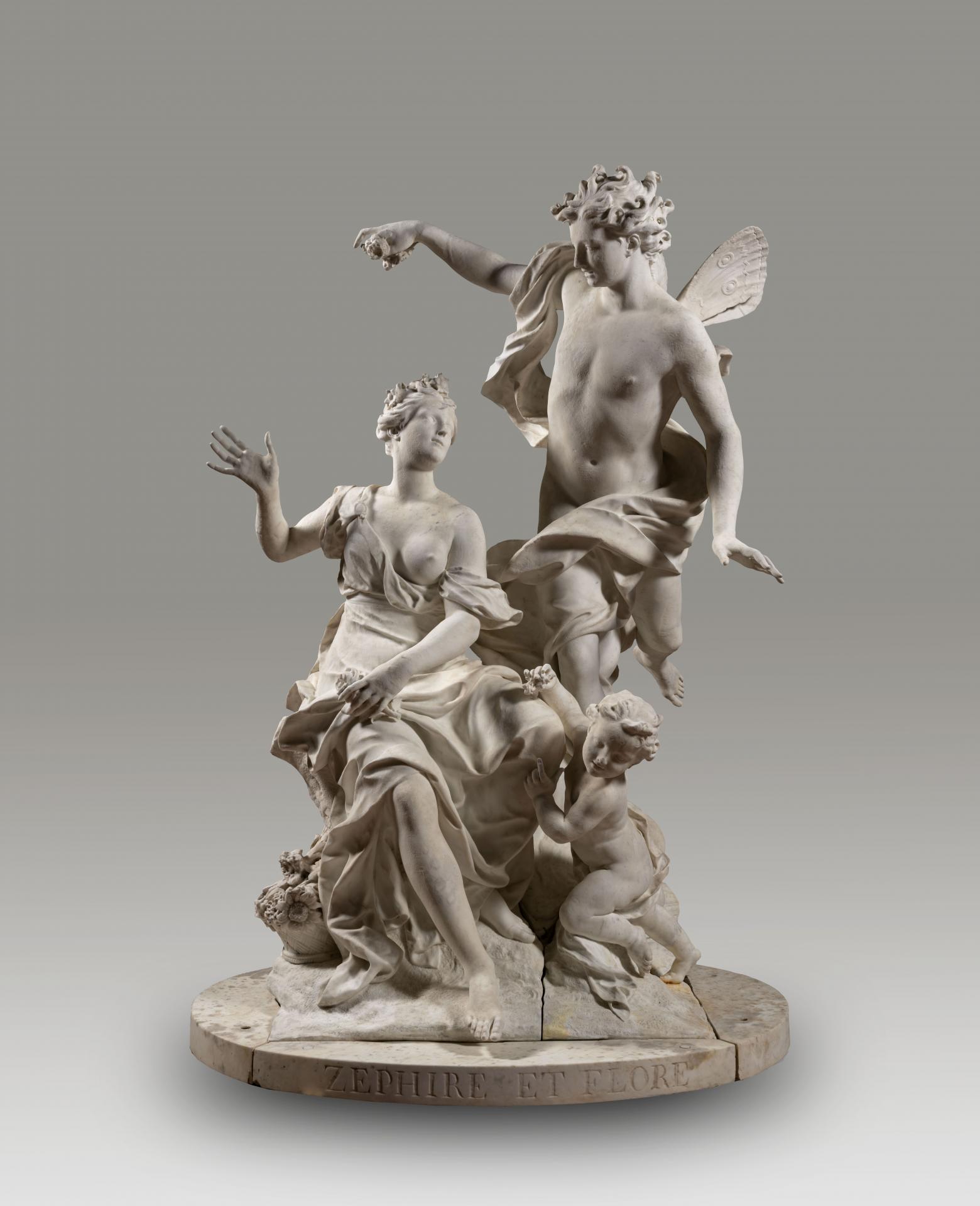
Zephyr and Flora
© Château de Versailles, Dist. RMN © Christophe Fouin
Commissioned by Louis XIV for the gardens of the Grand Trianon, this sculptural group was the last masterpiece of the monarch’s reign. Begun in 1713 by Philippe Bertrand and René Frémin and completed by Jacques Bousseau in 1726, the work was intended for the groves of Trianon, which were designed for the almost exclusive use of the Sun King and decorated with numerous sculptures.
The iconography of Zephyr and Flora is in keeping with the floral and amorous themes typical of the Grand Trianon, then a pleasure residence. Airborne and seeming to emerge from light clouds, Zephyr pays homage to Flora by sprinkling her with flowers. The god of the west wind is represented in all his beauty, as is Flora, goddess of flowers and spring, whose charms were sung of by Ovid. A chubby laughing putto presides over this meeting, sealing the beneficial alliance between the west wind and spring, the guarantee of blossoming and renewal after winter.
The “Recovered Masterpieces” exhibition
The two statues were placed in the gardens of the Château of Ménars (near Blois). When the sculptures from the park and Château of Ménars were dispersed in 1881, the works were bought by Alphonse de Rothschild and placed in his Parisian townhouse on Rue Saint-Florentin. During the Occupation, when the Rothschilds’ possessions were plundered, the two works were indicated to be in the Royal Tennis Court by Rose Valland. Returned after the war, they were placed in the garden of the Ephrussi de Rothschild townhouse in Paris, which became the headquarters of the Embassy of Angola in France in 1979.
return to versailles
Considering the historical value of the two sculptures for French heritage, the Republic of Angola decided to donate them to France in 2022 for the Palace of Versailles. Replicas made by the casts and moulds studio of the Réunion des Musées Nationaux, thanks to the support of Fondation TotalEnergies, were installed in the gardens of the embassy.
Pair of folding stools
Nicolas Quinibert Foliot

Pair of folding stools
© Château de Versailles, Dist. RMN © Christophe Fouin
These two folding stools belonged to a set of twelve that were part of the winter furniture destined for the young Countess of Artois’ bedchamber at Versailles. New furniture had been ordered for the Count and Countess of Artois’ apartment, then located on the first floor of the South Wing, in the current location of the Battle Gallery.
Architect and Designer for the Royal Furniture Treasury Jacques Gondoin (1737-1816) developed the prototype of this etiquette seat for the Dauphine Marie-Antoinette in 1769, and variations of it were used in the official rooms of the princely apartments. In the Transition style, the folding stools feature runners decorated with acanthus leaves and seeds still in the rococo style, with legs adorned with twisted fluting and elongated waterleaf motifs in a new style. They were restored in 1788 by gilder Louis-François Chatard (ca. 1749-1819), following order no. 191 of 28 June by the Royal Furniture Treasury.
Louis XV’s “pink hunting” service: mustard pot with lid
The Sèvres Manufacture
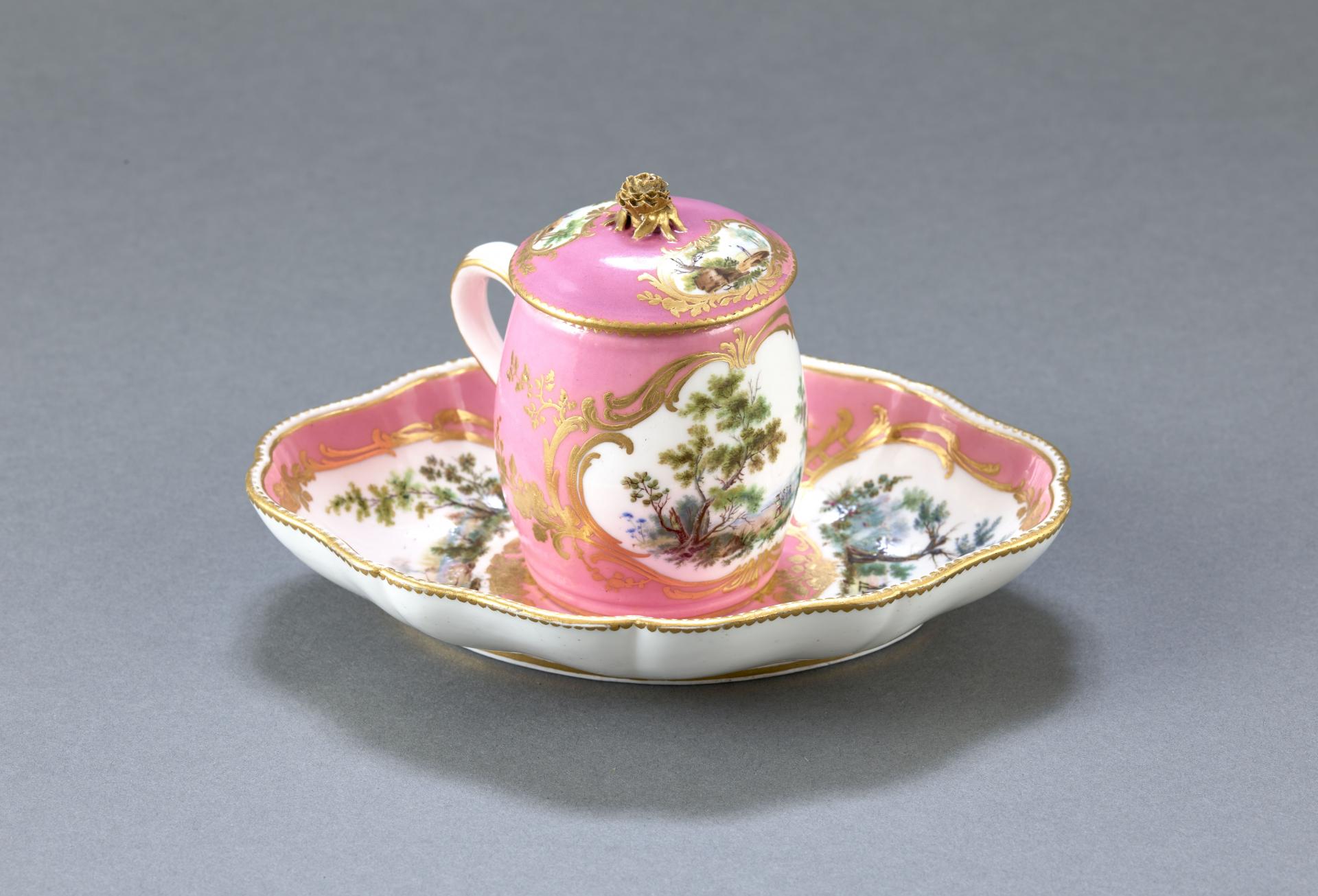
Louis XV’s “pink hunting” service: mustard pot with lid
© Château de Versailles, Dist. RMN © Christophe Fouin
This mustard pot and its dish are part of a service described as “pink with hunting attributes” or “pink landscape”. The set was designed for two people and was delivered by the Royal Manufacture in December 1759 to Madame Lair, a Parisian decorative-arts purveyor who probably sold it to Louis XV at an unknown date. It included 12 plates with small lobes, a mustard pot and lid at 120 Livres, a butter dish, and oil holder, six fruit dishes, a sugar bowl with its tray, two wine bottle coolers, two half-size wine bottle coolers, two king’s liqueur-bottle coolers, an oval liqueur-bottle cooler, two glass coolers, six ice cream cups, a Bouret tray, four Roussel trays and a chestnut dish with a tray.
Louis XVI ordered a new lid which can now be seen on this mustard pot, which explains the difference in the treatment of the landscapes and the pink ground.
Pair of gaines
André-Charles Boulle
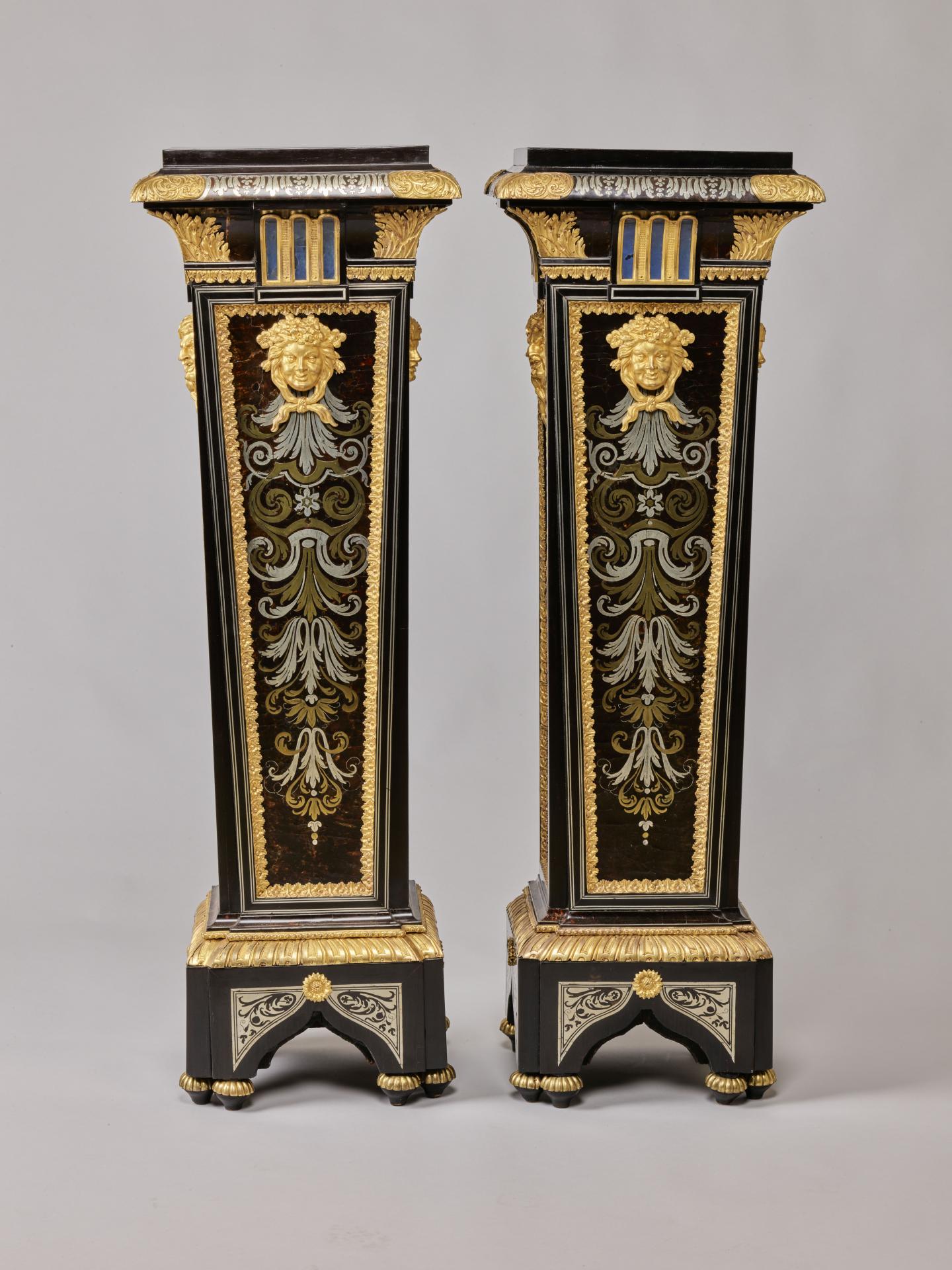
Pair of gaines
© Château de Versailles, Dist. RMN © Christophe Fouin
The son of Louis XIV and Marie-Theresa, the Grand Dauphin inherited his father's taste for collecting. Throughout his life, he collected paintings by the masters, porcelains, hardstone vases, crystals, small bronzes and precious furniture. He is known for his admiration of the works of André-Charles Boulle, the emblematic cabinetmaker of the Louis XIV era, from whom he commissioned a series of nine pedestals for his rooms at Versailles in 1684. These items were probably in the Grand Dauphin's famous Mirror Room. Located at one end of the prince’s apartment, this room housed no less than 550 objets d’art. It was decorated with fine panelling by Boulle and had luxurious marquetry flooring, which was begun by Pierre Gole (1620-1684) and completed by Boulle. Mirrors set in gilded copper rods covered the walls.
Today, the only known items from this collection are a pair of pedestals in the Victoria & Albert Museum in London and the pair acquired by the Palace of Versailles in 2022. The pair acquired by Versailles is typical of their maker’s style. Three of the sides are decorated with a fine marquetry of brass, pewter, tortoise shell and stained horn. The front is topped by a gilded bronze mascaron in the form of a bacchante with plaits tied in a knot under her face, while the sides are adorned with satyrs' heads.
2021
The Palace of Versailles recently added to its collection of 17th century paintings with the acquisition of seven works by leading artists Charles Le Brun, Jean-Baptiste de Champaigne and Jean Nocret, among others.
This set of portraits and allegories provides valuable insight into the history of both French portraiture and the decor at the Palace of Versailles. Following their restoration, they are now on display to the public in Louis XIV’s room and the historic galleries at the Palace.
Portrait of the Dauphine Marie-Antoinette
Louis-Joseph-Siffrède Duplessis
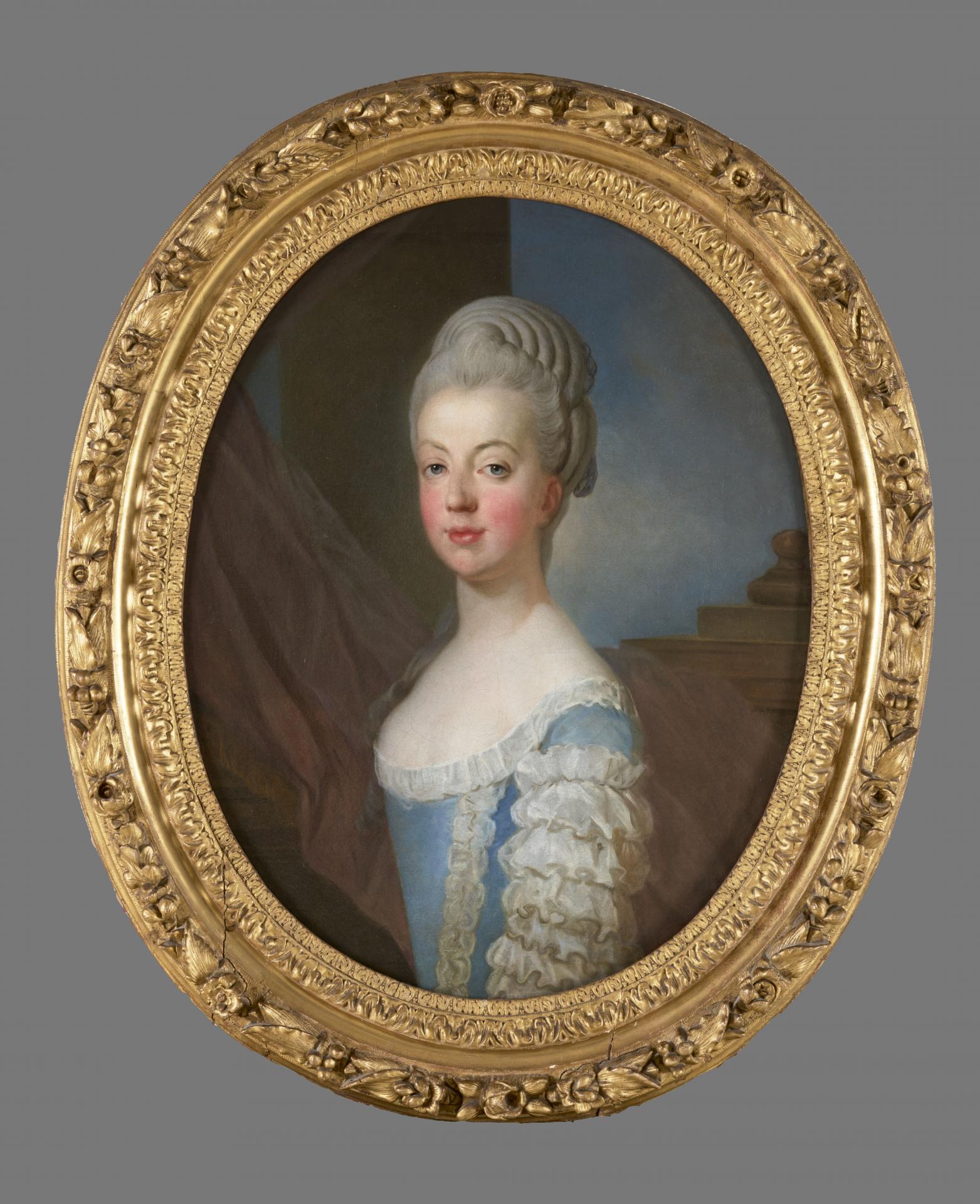
Portrait of Marie-Antoinette (1755–1793), dauphine, Louis-Joseph-Siffrède Duplessis (1725–1802), 1771, oil on canvas
© Palace of Versailles, Dist. RNM © Christophe Fouin
This acquisition was made possible thanks to the patronage of the Society of Friends of Versailles.
At the suggestion of Jean-Baptiste Marie Pierre, First Painter to the king and director of the Royal Academy of Painting, Joseph Siffred Duplessis was invited to create a likeness of Marie Antoinette in 1771. His study of the face is undoubtedly the work of a master artist, but, unfortunately, it failed to please the subject herself. Even though the face is more flattering than in the preliminary sketch, the features softer and the hairstyle neat and intricate, the Dauphine did not like the image at all and dismissed its natural look. Duplessis, a real expert in capturing likenesses, knew too well how to depict the key features of Marie Antoinette’s appearance: the bulging eyes, the rounded forehead, the Austrian lip, the prominent Habsburg chin. In the subject’s own opinion, the effect of these was not lessened by the remarkable bearing of the head, the freshness of the complexion and the powdered blond hair.
Optical microscope
Claude-Siméon Passemant, Jacques and Philippe Caffieri (bronzework)
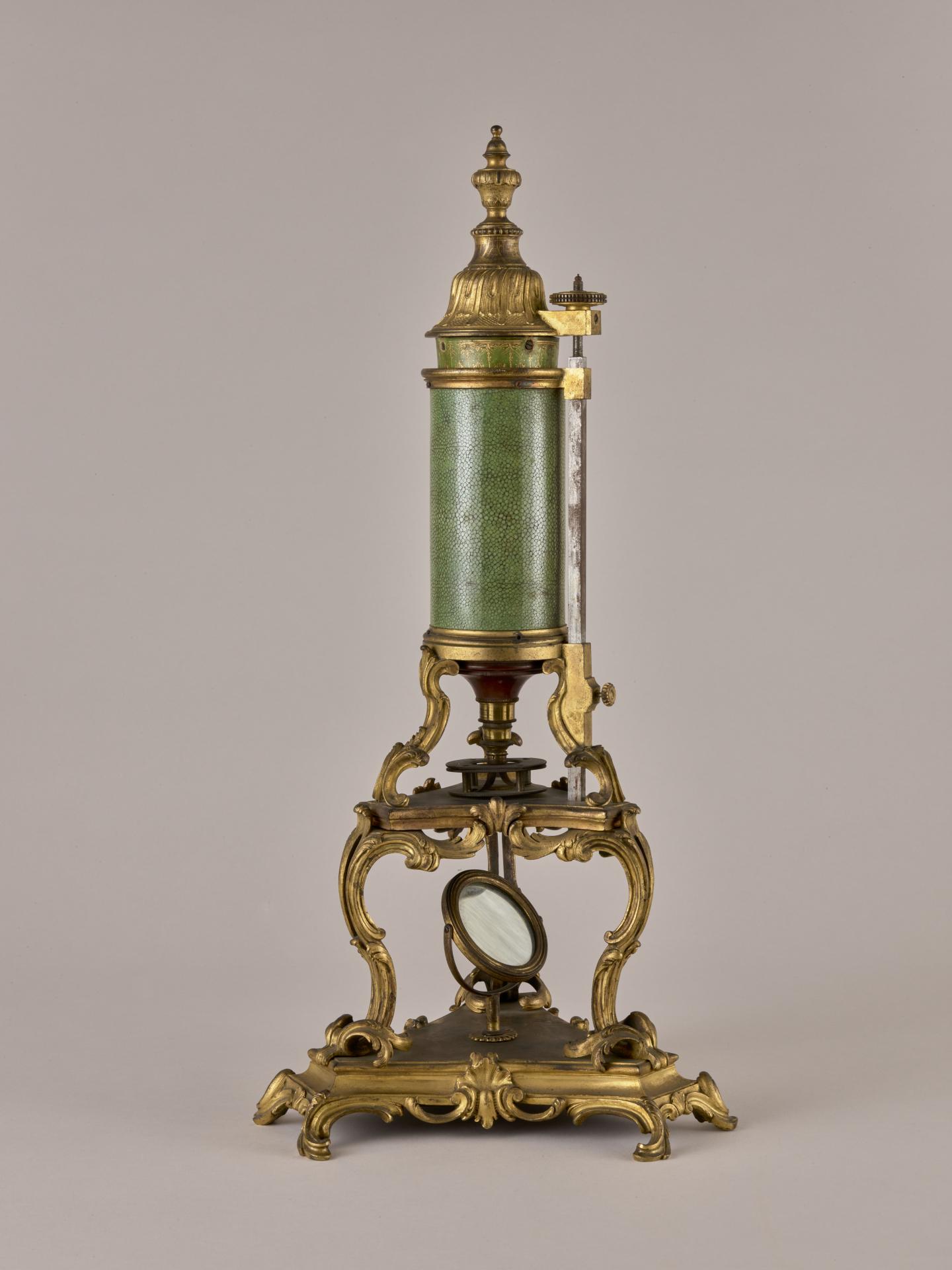
Optical microscope, Claude-Siméon Passemant (engineer), Jacques and Philippe Caffieri (bronzeworkers), around 1750
©Palace of Versailles, Dist. RNM © Christophe Fouin
This acquisition was made possible thanks to the patronage of the L’Oréal company.
This famous tripod microscope is one of only six documented examples in the world. This rare instrument combines the most advanced technology at the time with artistic perfection. Commissioned by Louis XV from Claude-Siméon Passemant, it consists of a cylindrical body formed by two tubes – one inside the other – with which the focus is adjusted. The body of the microscope rests on an impressive pedestal made from sculpted and gilded bronze, formed by three openwork supports featuring rococo scrolls and foliage curls, clasps and inserts attributed to Jacques Caffieri, who would have worked on them with his son, Philippe.
It is an example of technical prowess of which few mechanical engineers were capable. An object like this required perfect symbiosis between the mechanic and the bronzeworker, as the bronze elements are not merely decorative but also structural, ensuring the stability of the device and the precision necessary for scientific observation. These features make this microscope an iconic work in the king’s personal collections.
Bust of Jules Breton, painter and poet
Jean-Joseph Carriès, Pierre Bingen
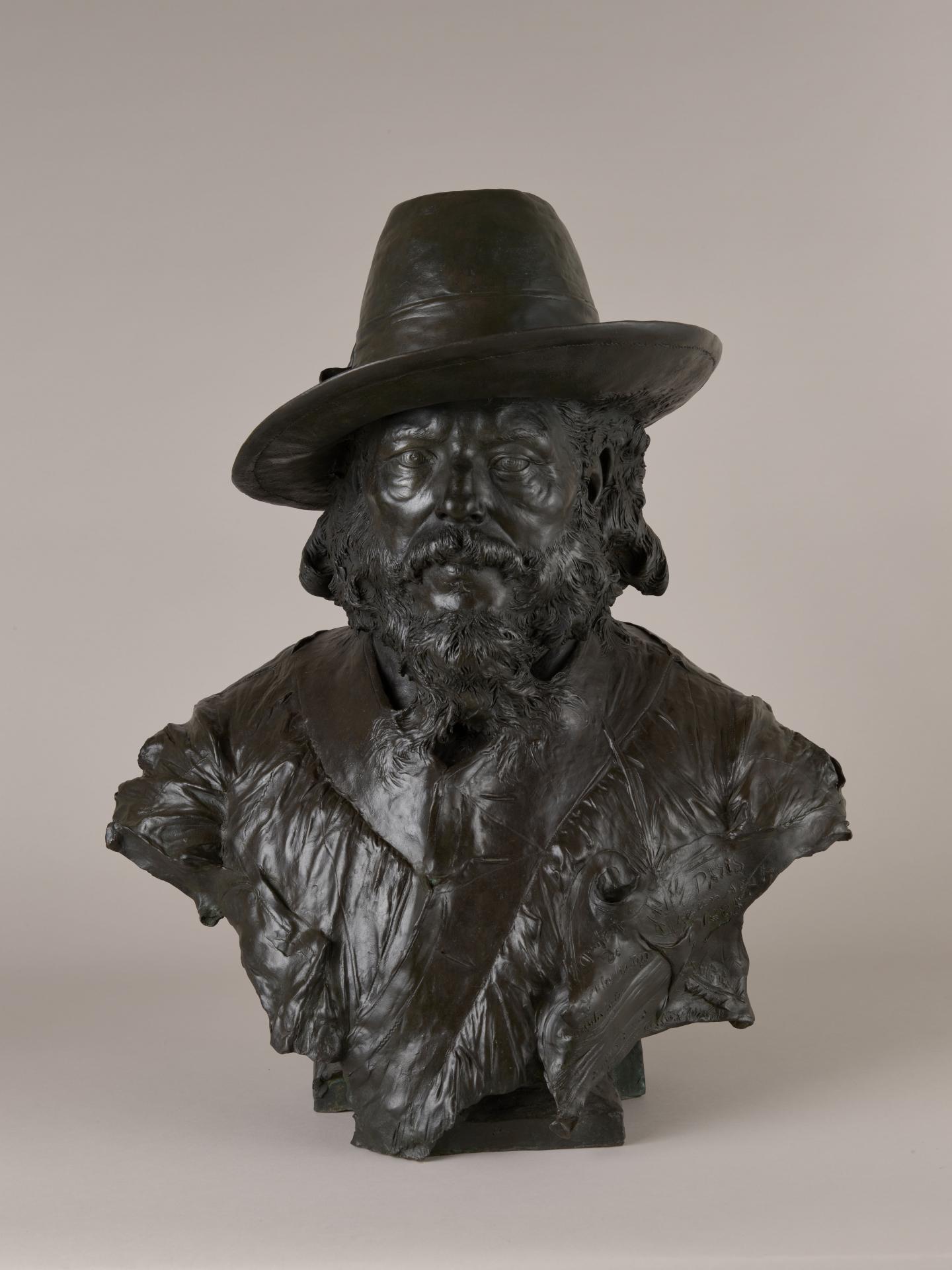
Bust of Jules Breton, Jean-Joseph Carriès (sculptor), Pierre Bingen (smelter), 1885, patinated bronze
© Palace of Versailles, Dist. RNM © Christophe Fouin
It was most likely while attending the 1881 Salon that Jules Breton, a key figure on the Parisian art scene, noticed Carriès talent and promptly commissioned him to produce this bronze likeness. An initial version, created in 1881, depicted the painter bareheaded (Paris, Musée d’Orsay, RF 3450). It seems Breton did not like this overly simplistic portrayal as the following spring, the sculptor produced a second, more accomplished version “without a sitter”. It shows the painter wearing a hat and smock and, this time, it met with the approval of its subject.
The casting of the bust was assigned to Pierre Bingen. The supremely detailed work is a wonderful study of contrasts between the bushy beard, smooth cheeks and wrinkled eyes. The patina, Bingen’s speciality, is intense, its green tint sometimes reflecting more tawny hues. Finally, the inscription on the back is evidence of the links between the sculptor and the Breton family.
Roll-top desk belonging to the Dauphine Marie-Josèphe de Saxe
Jean-François Oeben, Jean-Henri Riesener
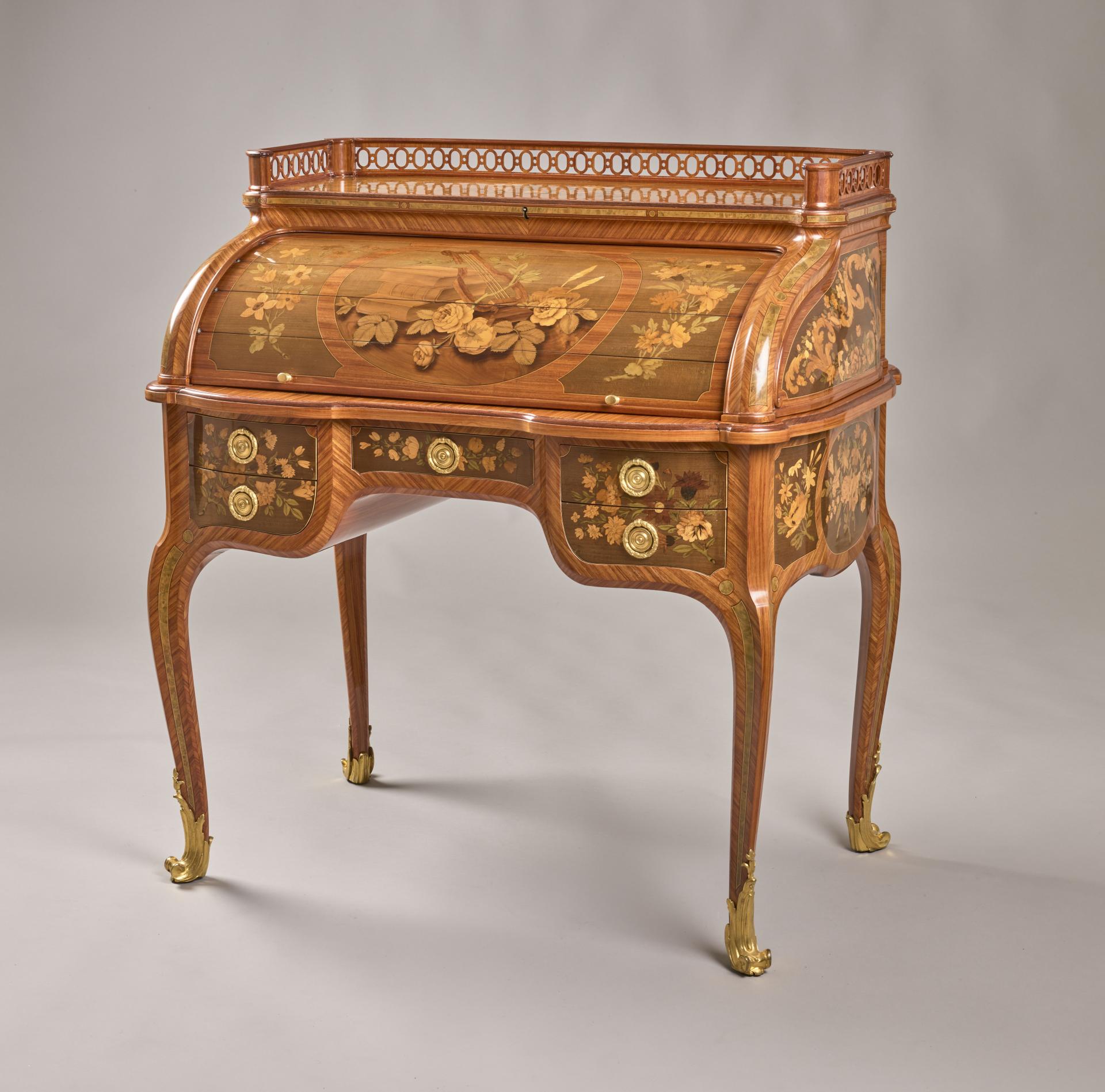
Roll-top desk belonging to the Dauphine Marie-Josèphe de Saxe, Jean-François Oeben, Jean-Henri Riesener, around 1763–1765
© Palace of Versailles, Dist. RNM © Christophe Fouin
This acquisition was made possible thanks to the bequest of Madame Jeanne Heymann.
This small desk dates from a few years after the “King’s desk” commission in 1760 and, unlike the furniture produced for Louis XV, it features a bare minimum of bronze elements. Intended to be placed in the centre of the room, the item is decorated on all sides with marquetry panels of flowers framed in rosewood. In the central part of the roll-top is a motif representing lyrical poetry – a common feature in the work of the cabinetmaker, Jean-Henri Riesener.
This acquisition is all the more significant because it is the last roll-top desk of royal origin to remain in private hands. All the others made by Riesener, after he took over Oeben’s workshop in 1763, are held in public collections.
Discover the Dauphine’s Private Chamber
Corner cabinets
Martin Carlin
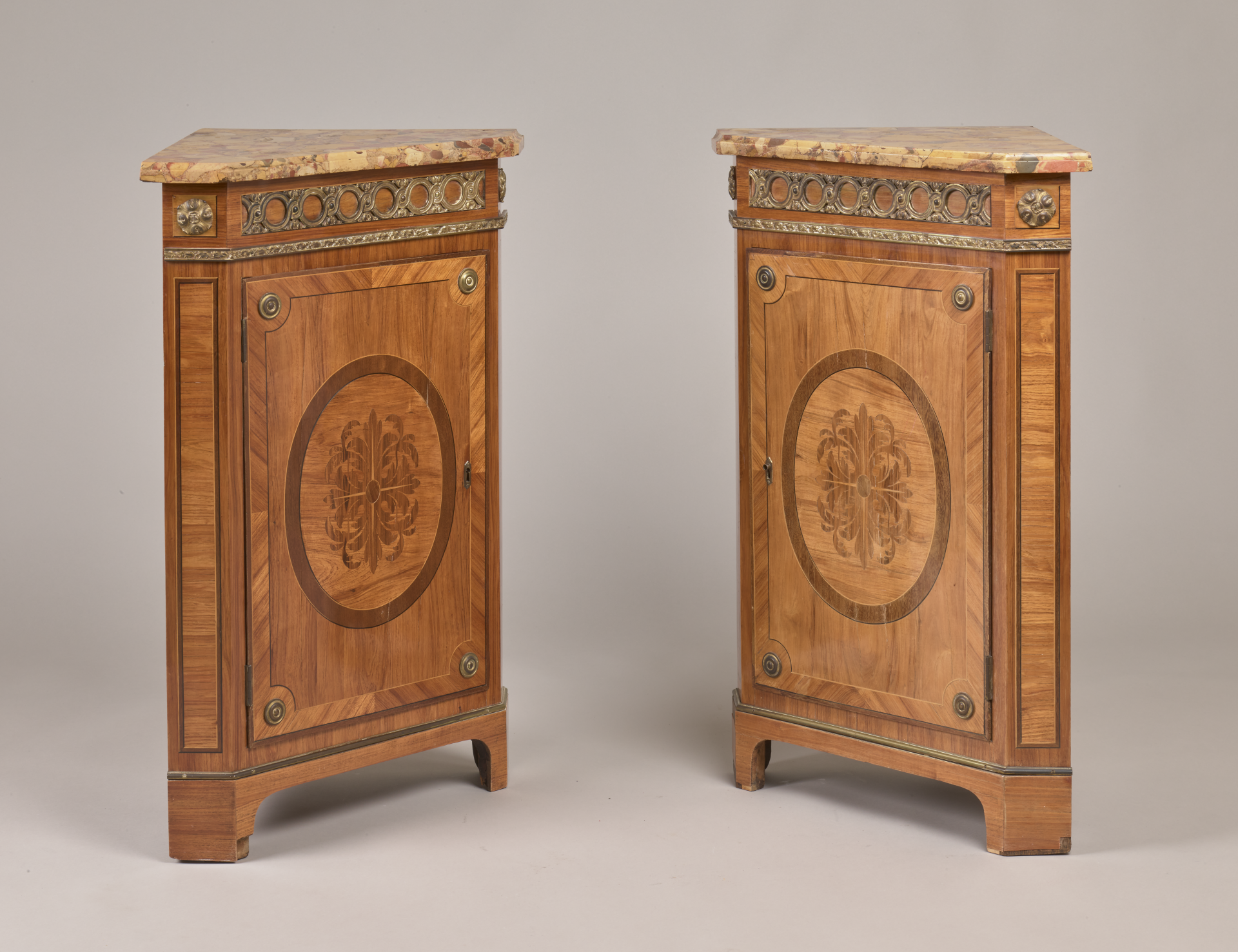
Corner cabinets, Martin Carlin, under the supervision of Simon-Philippe Poirier, around 1770
© Palace of Versailles, Dist. RNM © Christophe Fouin
This acquisition was made possible thanks to the patronage of the Fondation La Marck.
The simple and elegant features of these corner cabinets showcase the sophistication of the details that are characteristic of Martin Carlin’s style. Their compact size made them suitable for rooms with a mezzanine, whether the rooms on the first floor or those on the second, or a room granted to a member of the household. The corner cabinets, which bear Carlin’s stamp, were undoubtedly delivered to him by the decorative-arts purveyor Simon-Philippe Poirier, as their style precludes an earlier date.
This acquisition documents a little-known side of the work of Martin Carlin, whose most significant output includes the precious furniture items decorated with plaques of Sevres porcelain or lacquered panels. The acquisition also adds to the body of knowledge about Marie-Antoinette’s favourite furniture provider.
Single plate from Louis XVI’s mythology dinner service
Sèvres Royal Manufactory, Pierre-André and Etienne-Henry Le Guay
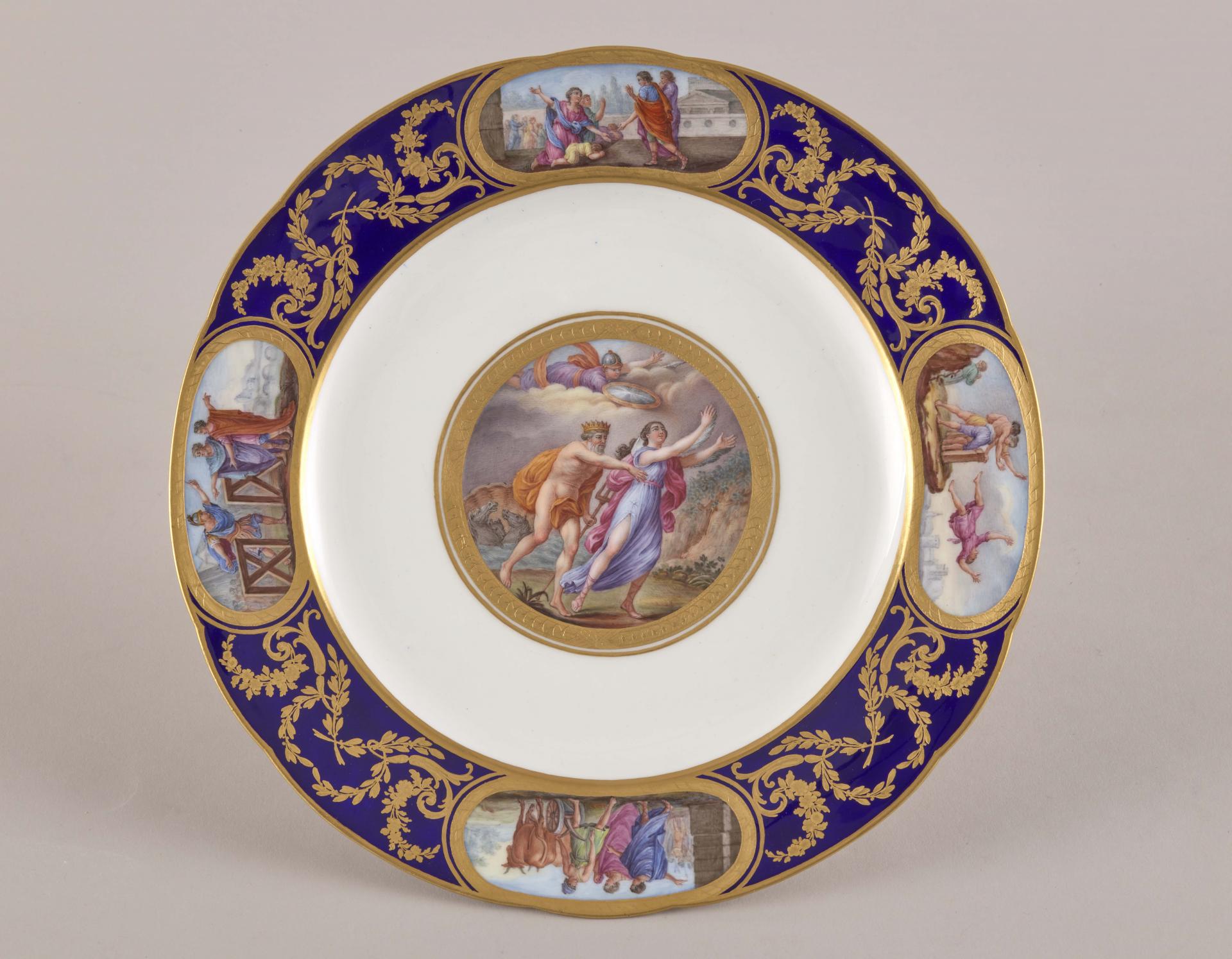
Plate, Sèvres Royal Manufactory, Pierre-André and Etienne-Henry Le Guay, 1787
© Palace of Versailles, Dist. RNM © Christophe Fouin
This acquisition was made possible thanks to the bequest of Madame Jeanne Heymann.
The first batch of the “beau bleu” (dark blue) mythology service was delivered to Louis XVI in 1783. It is the best known of all those made by the Sevres Royal Manufactory in the 18th century. In all, 200 items were produced for the service, although 400 were originally planned. Around 150 still exist today, most of which have been held at Windsor Castle since the start of the reign of George IV (1762–1830).
In the centre of this plate is a scene from Ovid’s Metamorphoses, in which Coronis, pursued by Neptune, is transformed into a crow by Minerva. The scenes painted in the four roundels on the lip are inspired by prints illustrating Roman history in the form of figures. The dark-blue lip is embellished with gold-painted garlands of leaves and vines. Each roundel is bordered by a wide rim of gold. The one surrounding the central medallion is engraved with the markings of a piaster coin, reminiscent of the gilding on Louis XV’s main service.
View of the Merry-go-Round Game from the gallery and one of the façades of the Palace
Claude-Louis Châtelet
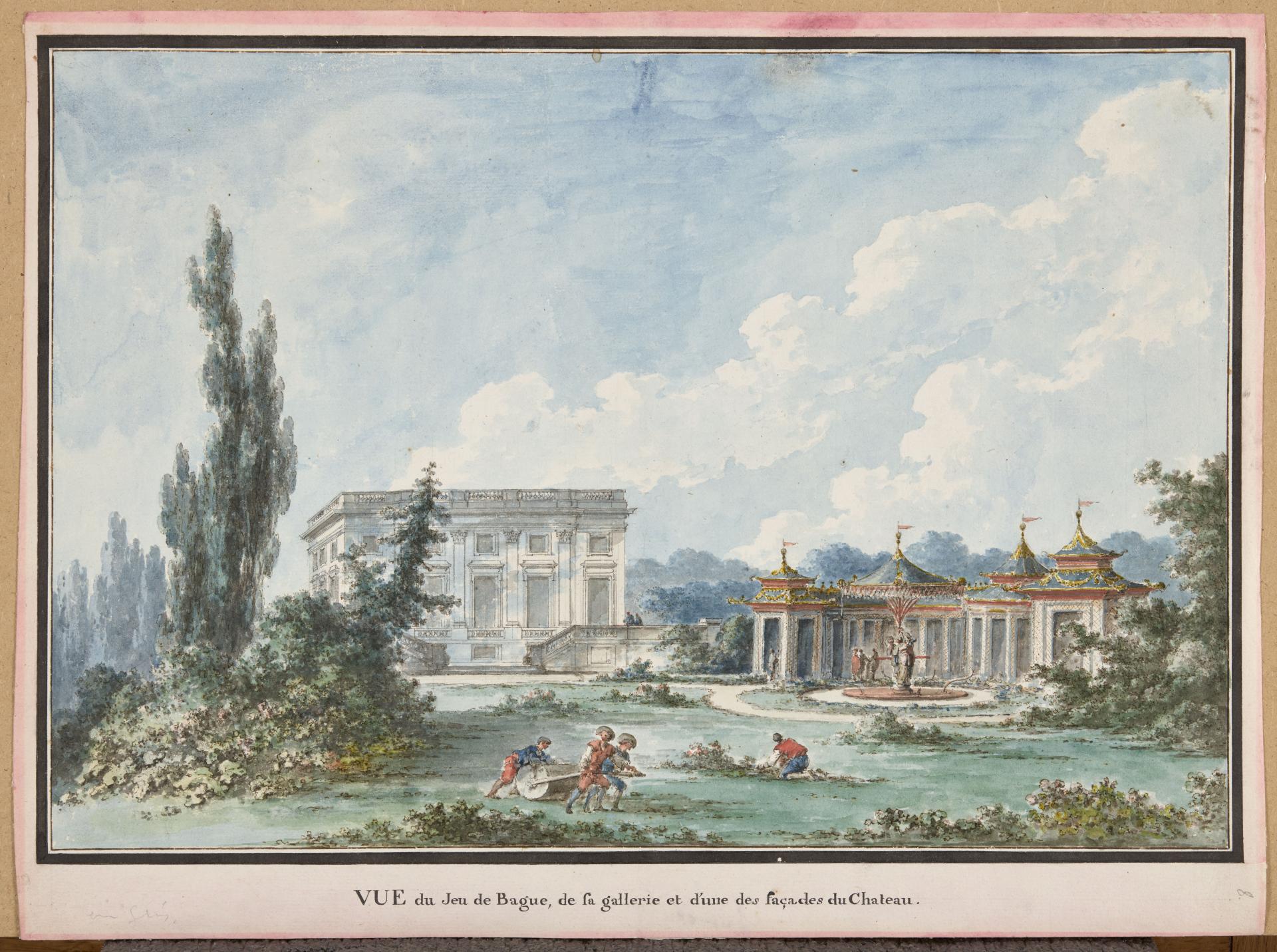
View of the Merry-go-Round Game (Jeu de Bague) from the gallery and one of the façades of the Palace, 1786, Claude-Louis Châtelet, Watercolour on laid paper
© Palace of Versailles, Dist. RNM © Christophe Fouin
This painting is one of the few depictions of the Chinese merry-go-round game – one of the first things Marie Antoinette ordered to be built at her new estate, The Petit Trianon. The game, a legacy from medieval tournaments, involved metal rings (the “bagues” of the game’s title in French) being lifted up by a lance suspended from a type of gallows. The central column, comprising Chinese figures made from gilded wood, was topped with a metal parasol decorated with a frieze and to which wooden eggs and small metal bells were attached, as were dragon’s heads, from which the rings descended. The whole set-up was surrounded by a “Chinese” gallery for the spectators who observed the game. It could be accessed from the Palace via a semi-underground passageway. The roof was decorated with gilded garlands of flowers and fruit, and green- and vermilion-painted latticework.
Portrait of the Dauphin, son of Louis XIV
Jean Nocret
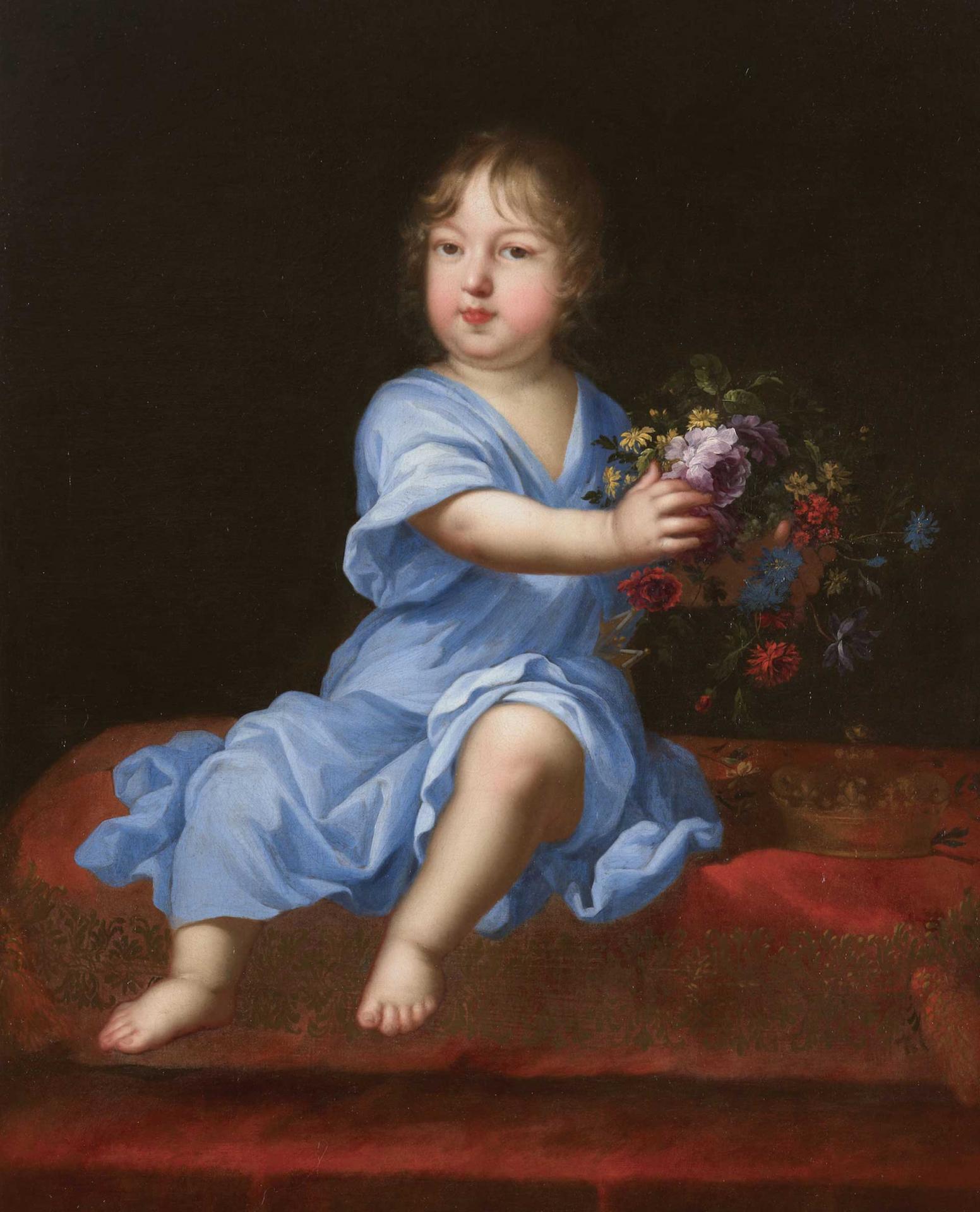
Portrait of the Dauphin, son of Louis XIV, aged two or three years, Jean Nocret (1615–1672), around 1663–1664, oil on canvas
© Palace of Versailles, Dist. RNM-GP, Christophe Fouin
Donation of M. Edouard de Royère via the Society of Friends of Versailles
This portrait is one of few depictions of the dauphin, son of Louis XIV, aged two or three years. The young boy’s status explains the size of this commissioned work, which is significant for a portrait of one so young. It is a full-length portrayal of the dauphin, who is playing with some flowers and wearing a blue tunic with the cross of the Order of the Holy Spirit, which was given to him at the time of his birth. Restoration work on the painting revealed the presence, next to the child, of a crown decorated with dolphins, thus confirming the identity of the subject.
Portrait assumed to be of the Duchess of Longueville
Simon Vouet's entourage
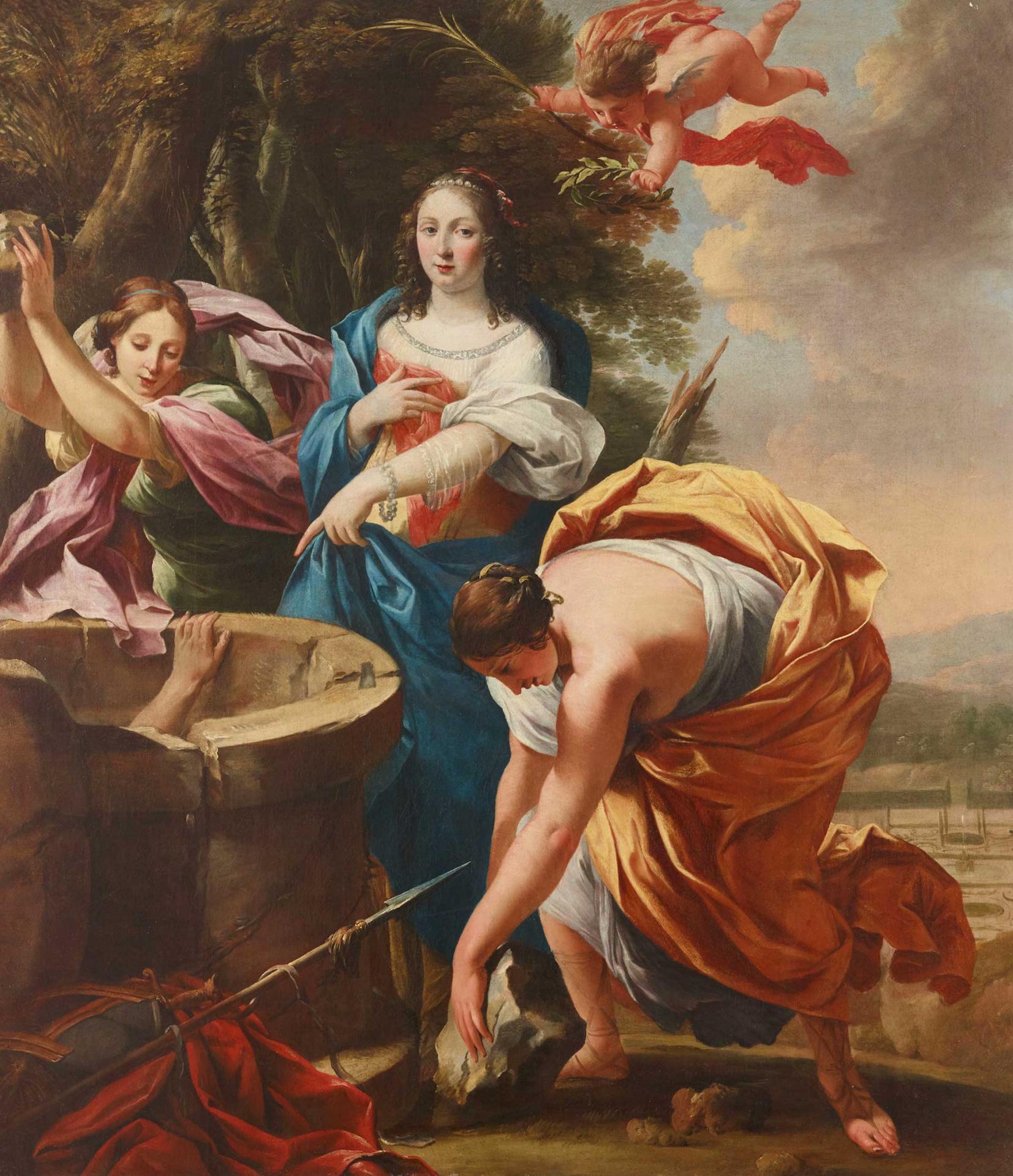
Portrait assumed to be of the Duchess of Longueville as Timocleia, Studio of Simon Vouet (1590–1649), mid-17th century, around 1647–1648, oil on canvas
©Palace of Versailles, Dist. RNM-GP, Christophe Fouin
This painting depicts a woman dressed as Timocleia of Thebes, whose fate was described by Plutarch and Quintus Curtius. During the capture of the city, she was raped by a captain in Alexander the Great’s army. She managed to convince him that all her riches were hidden in a well, into which she then pushed him and had him stoned to death by her servants. Subsequently imprisoned, she was released by the Macedonian king, who ordered his troops never to commit such crimes again.
This work is a rare example of the practice of producing a portrait by studio, as followed by Simon Vouet, one of the greatest painters of his time, and it may be the work of his pupil, Charles Poerson. The portrait completes the collection of works dating from the reign of Anne of Austria held at the Palace and now joins them in the first of the Louis XIV rooms.
The various nations
Charles Le Brun
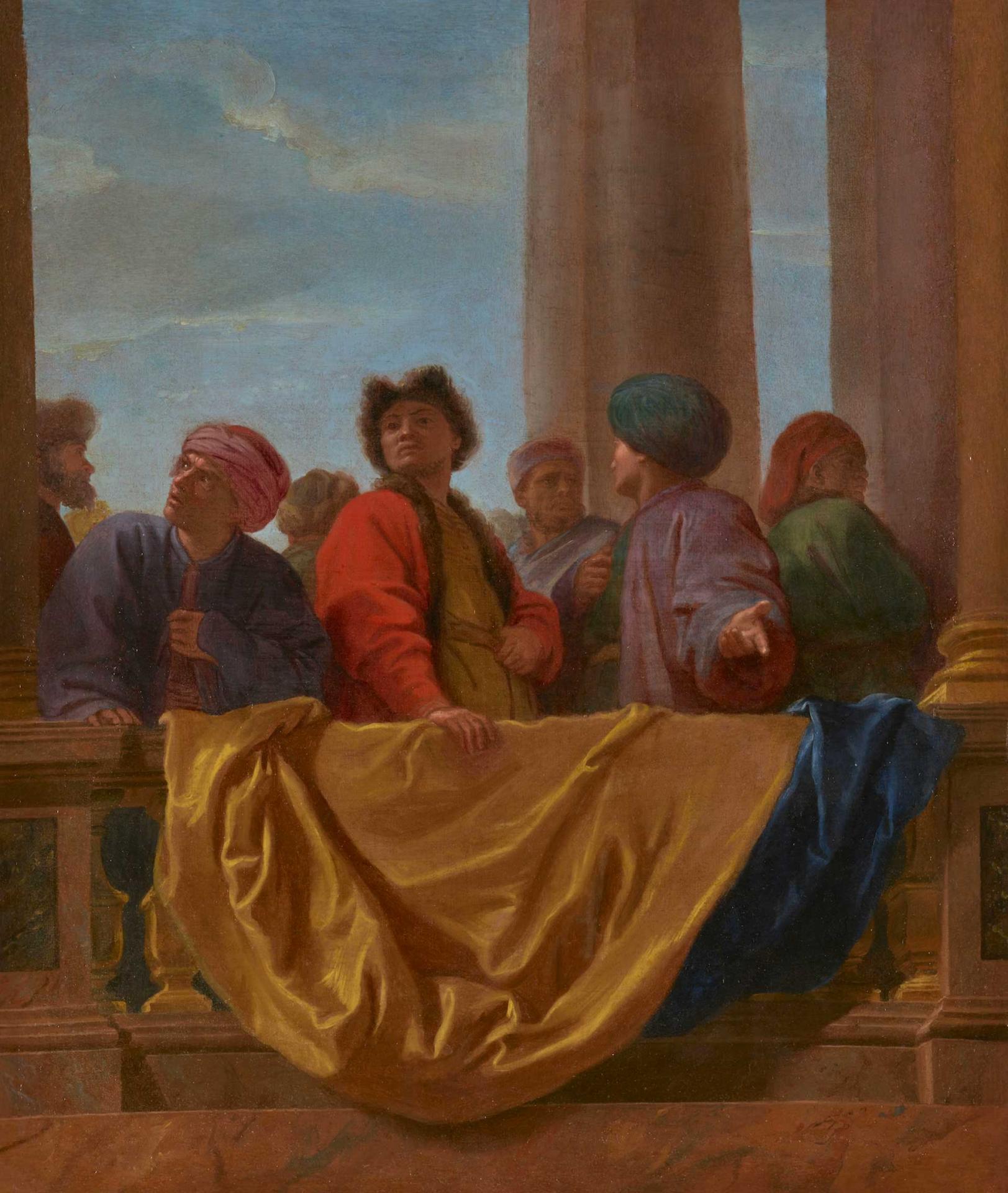
The various nations of Asia, Charles Le Brun (1619–1690) and studio, oil on canvas
© Palace of Versailles, Dist. RNM-GP, C. Fouin
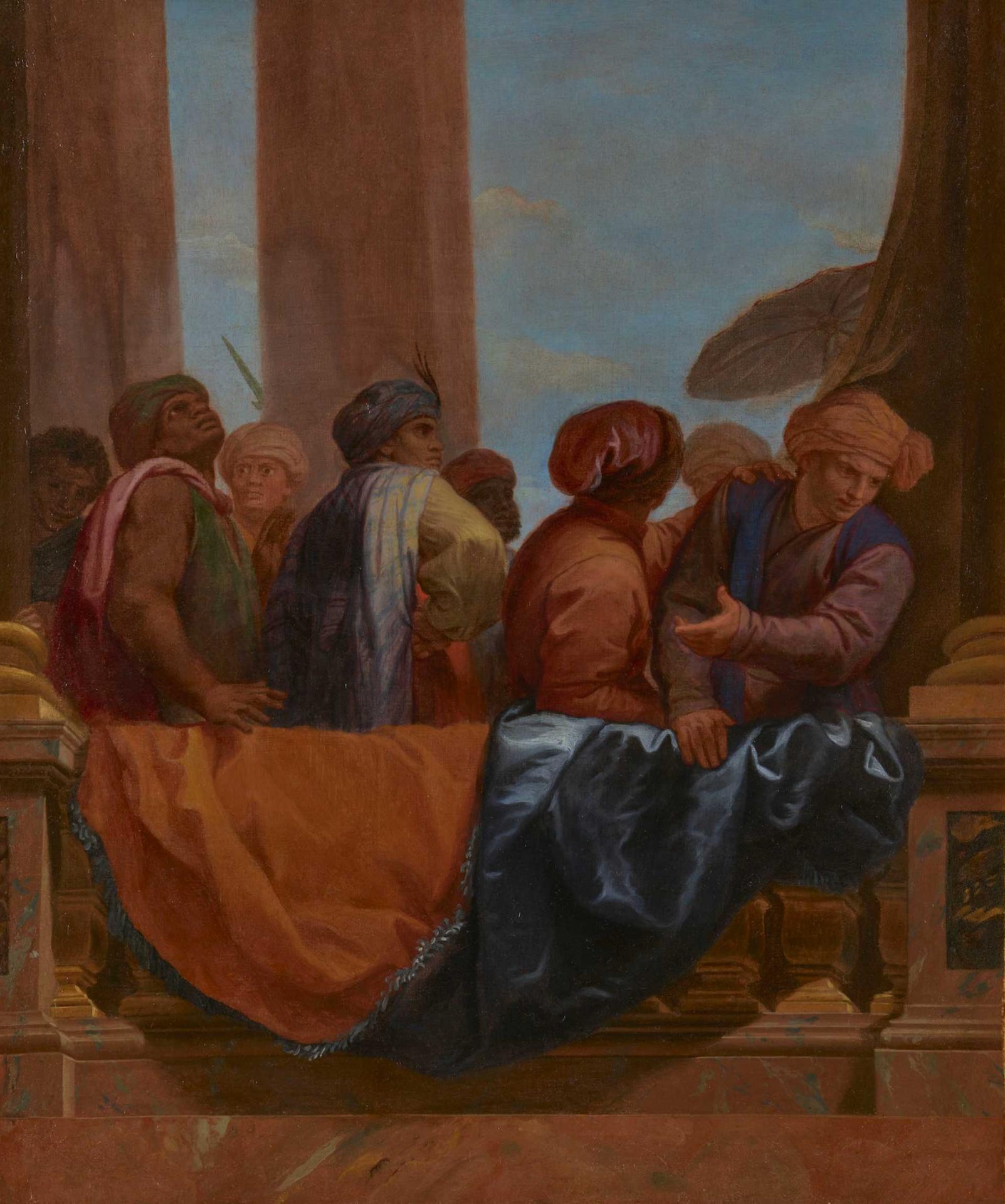
The various nations of Africa, Charles Le Brun (1619–1690) and studio, oil on canvas.
© Palace of Versailles, Dist. RNM-GP, C. Fouin
This acquisition was made possible partly thanks to the patronage of the Fondation La Marck in 2020.
These two paintings are wonderful examples of the décor of the Palace of Versailles’ monumental “Ambassadors’ staircase”, which no longer exists. Designed by Louis Le Vau, it was built between 1674 and 1679, and destroyed in 1752.
The decor, created by Charles Le Brun, First Painter to the king, was divided over three levels. On the second level, the walls were decorated with a series of alternating solid paintings and mock open windows. Trompe-l’oeil tapestries illustrating victorious battles alternated with fake loggias, in which stood figures symbolising the nations from four continents. These figures were depicted standing between two columns under an open sky and leaning on a balustrade covered with heavy drapery. These two works belong to this set.
Restoration work on the canvases brought out their pictorial quality, revealing Le Brun’s inventive genius and his idiosyncrasies, such as the quickly captured expressive faces, the barely outlined silhouettes in the background, the coloured haloes emphasising the contours of the turbaned heads and the drapery, which helps structure the space.
Spain defeated
Charles Le Brun
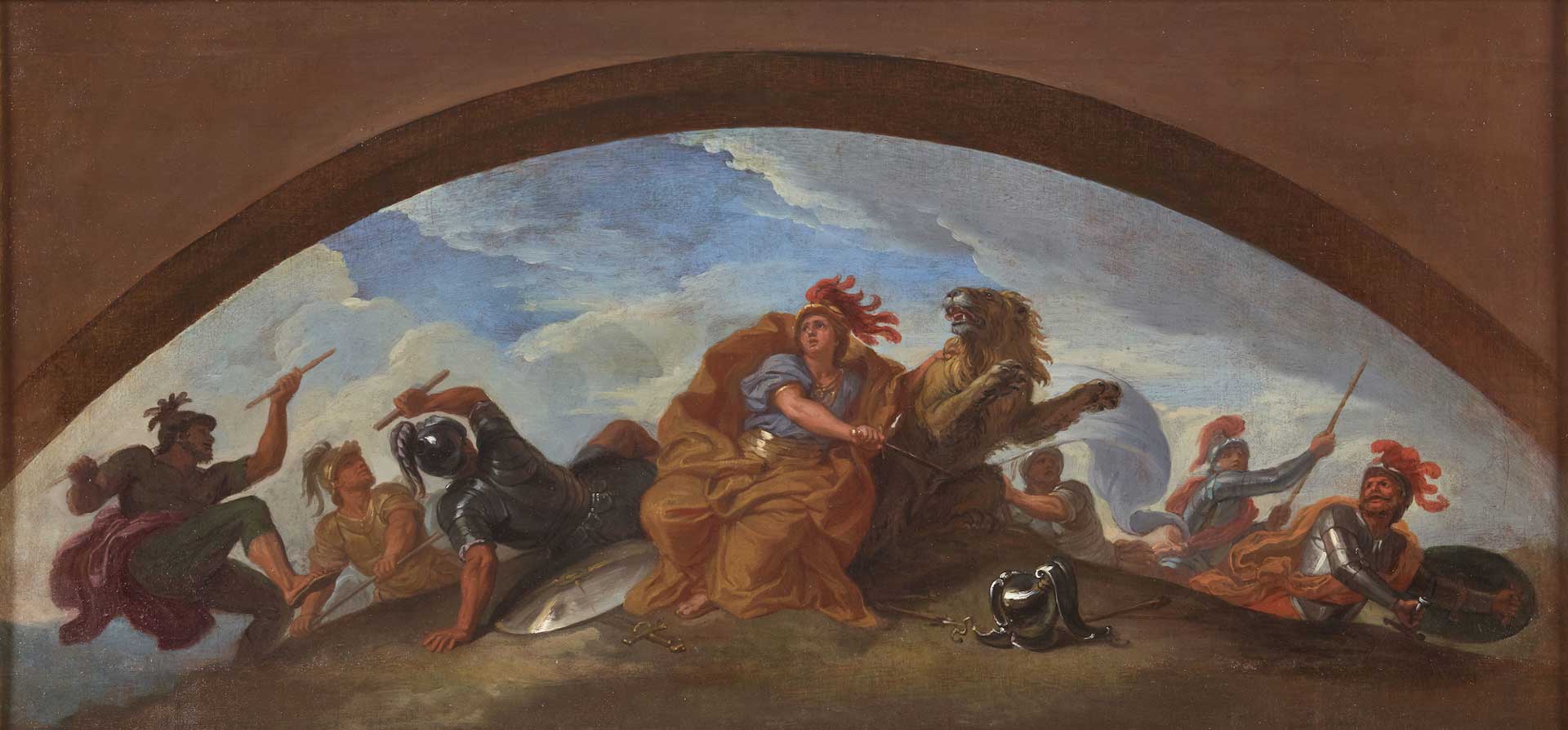
Spain defeated, Charles Le Brun (1619–1690), oil on canvas
© Palace of Versailles, Dist. RNM-GP, C. Fouin
This painting is the sketch for “L’Espagne défaite” (Spain defeated), one of the arches painted by Charles Le Brun for the War Room.
In 1678, Jules Hardouin-Mansart started constructing the Hall of Mirrors and the War Room and Peace Room. Charles Le Brun was given the task of decorating them and chose, as his subject, the Franco-Dutch War (1672–1678). The Dutch had a vast European coalition on their side, including the Holy Roman Empire of the German Nation (Germany) and Spain.
This canvas is thought to date from the early stages of the construction project, around 1684–1685. It was undoubtedly produced for the king and for Colbert. The vibrancy of the colours, the lightness of touch and the swiftness of the movements are all characteristic of Le Brun’s sketches. There are subtle differences between the sketch and the final composition on the ceiling. The latter is more accomplished and the theme of war is more pronounced.
Two designs for the ceiling in the Hercules Room
Jean-Baptiste de Champaigne
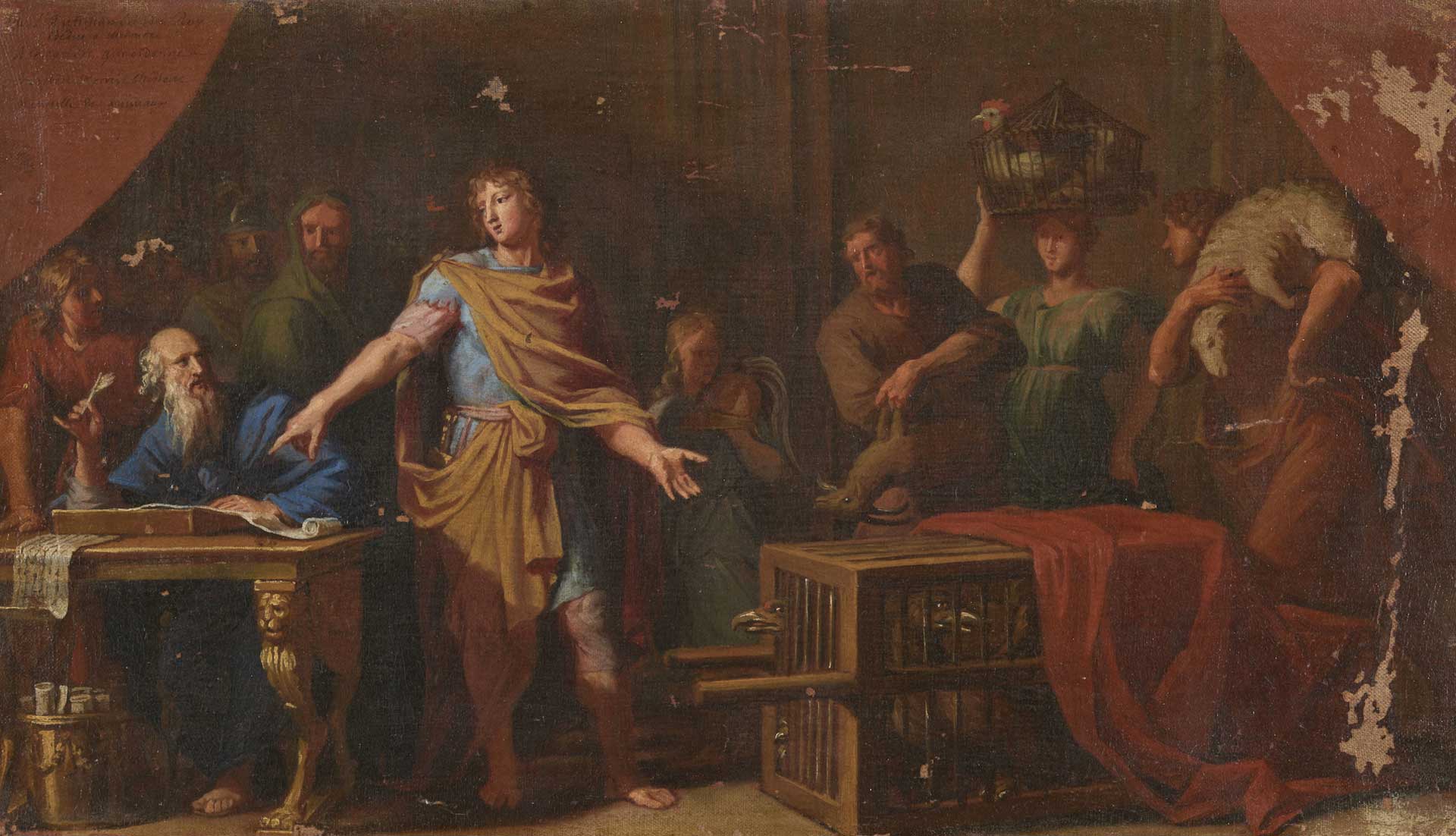
Alexander the Great, offering animals to his teacher, Aristotle, Jean-Baptiste de Champaigne (1631–1681), oil on canvas
© Palace of Versailles, Dist. RNM-GP, C. Fouin
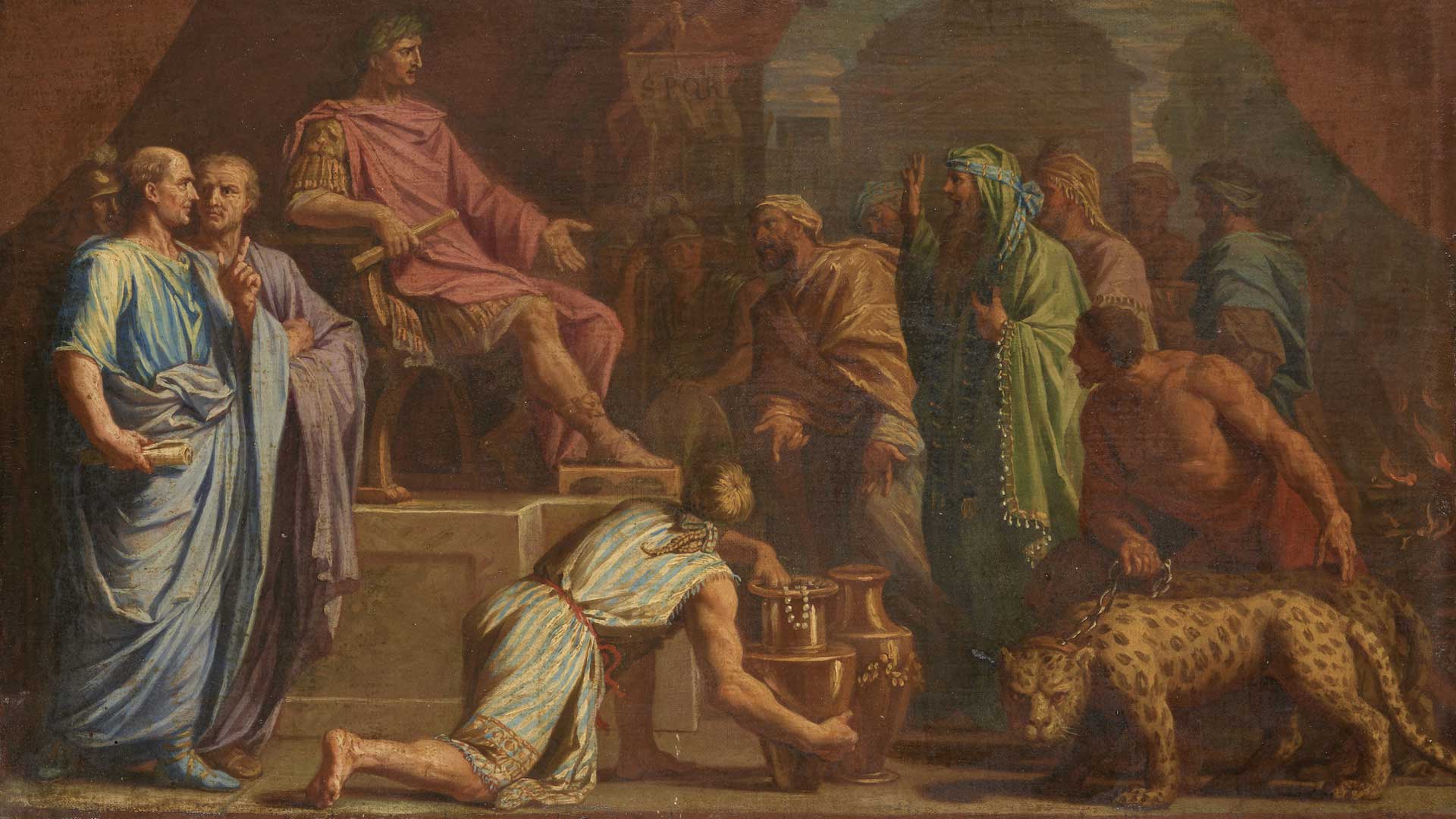
Emperor Augustus receiving an Indian ambassador, Jean-Baptiste de Champaigne (1631–1681), oil on canvas
© Palace of Versailles, Dist. RNM-GP, C. Fouin
Jean-Baptiste de Champaigne, the talented nephew of Philippe de Champaigne, was commissioned in 1672 to paint the whole of the ceiling of the Mercury Room, in the King’s State Apartment. The artist featured Augustus, Alexander and Ptolemy Philadelphus as allusions to the deeds and majesty of Louis XIV. The canvases allude to the scientific advances linked to the conquests of far-off lands, drawing an analogy with the activities of the sovereign on various continents.
The Palace of Versailles acquired two preliminary canvases for this decor. These add to the body of knowledge about the ceiling in the Mercury Room and complete the sketch for the central section, “le Triomphe de Mercure sur son char” (Mercury triumphant on his chariot), which is already held by the Palace of Versailles. These works join the collection of other sketches and designs for the Saturn and Jupiter ceilings already on display in the Historic Galleries of the Palace.
2020
Georges Mareschal - First King's surgeon (1658-1736)
François Girardon
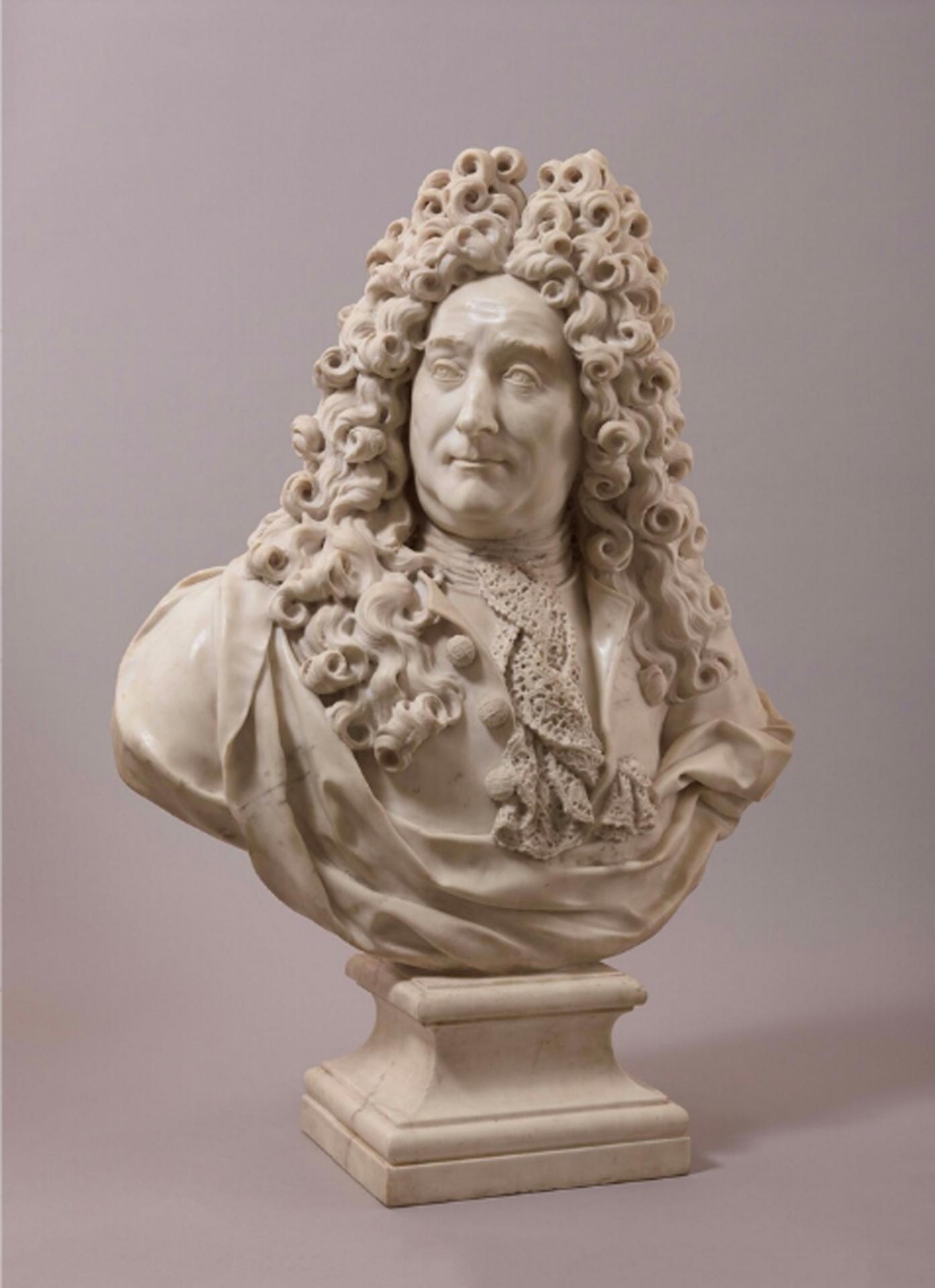
Bust of Georges Marescal, first surgeon to The King ((1658-1736)
© Palace of Versailles, Dist. RNM © Christophe Fouin
The portrait of the surgeon Georges Mareschal is undoubtedly the last portrait sculpted by François Girardon. Born in 1658 of an Irish father, Georges Mareschal had the opportunity from 1696 to treat Louis XIV, and was present at his bedside on the evening of his life. In addition, Mareschal was at the origin, with Lapeyronie, of the creation of the Royal Academy of Surgery in 1731.
The acquisition of the bust of Georges Mareschal by the Palace of Versailles was awarded the Prize for Acquisitions of the Year at the Appolo Awards 2021. |
Self-portrait
François- Marius Granet
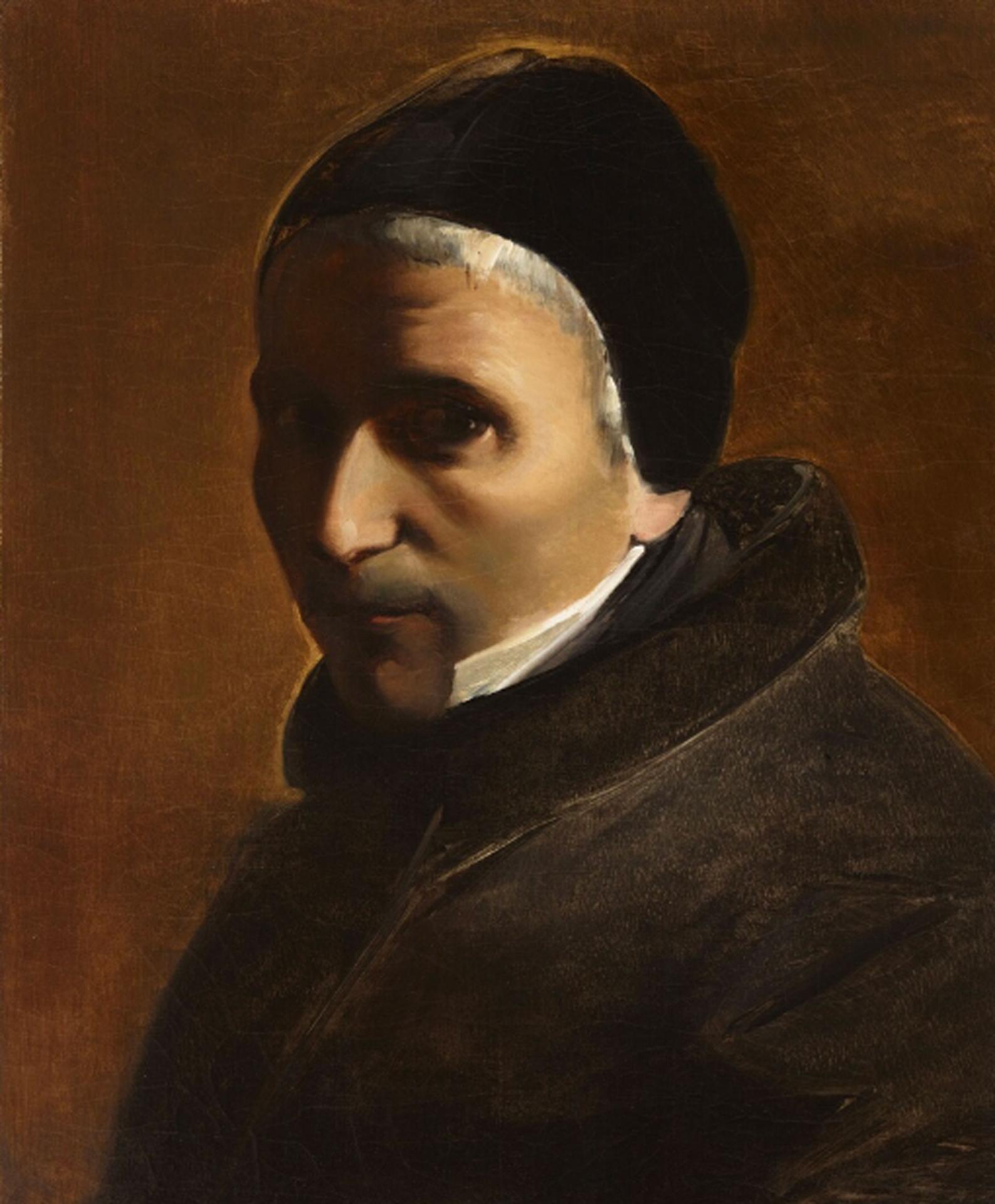
Self-portrait
© Château de Versailles, Dist. RMN / © Christophe Fouin
After spending 20 years in Rome where he specialised in depictions of interiors and monasteries, François-Marius Granet was appointed curator of paintings at the Palace of Versailles in 1833, with the support of the Count of Forbin, then director of the Louvre. This self-portrait was painted towards the end of the artist’s life and provides an insight into his inner world, with his black skullcap and brown coat reminding us of a Capuchin friar’s habit.
The Château of Choisy-le-Roi, Courtyard side
Alexis-Nicolas Pérignon
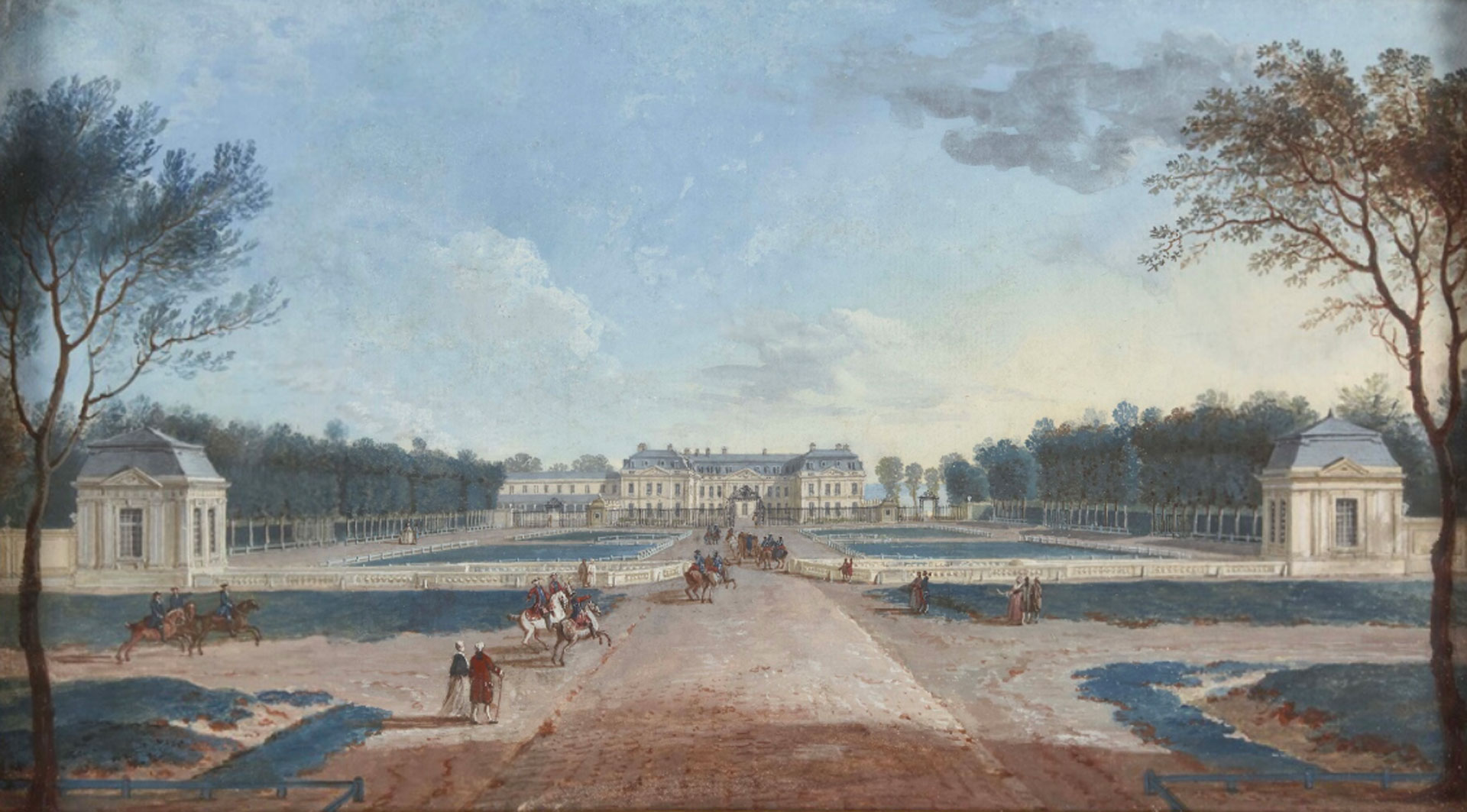
The Château of Choisy-le-Roi, Courtyard side
© Château de Versailles, Dist. RMN / © Christophe Fouin
This gouache painting is generally attributed to Alexis-Nicolas Pérignon, a veduta painter of the second half of the 18th century, whose best-known works include the landscapes of the Château of Chanteloup, owned by the Duke of Choiseul. This gouache painting is a rare testimony to the state of the royal residence of Choisy after the modernisation works carried out by Ange-Jacques Gabriel between 1740 and 1777.
Head study of “The Love of Virtue” in the “Apotheosis of Hercules”
François Lemoyne
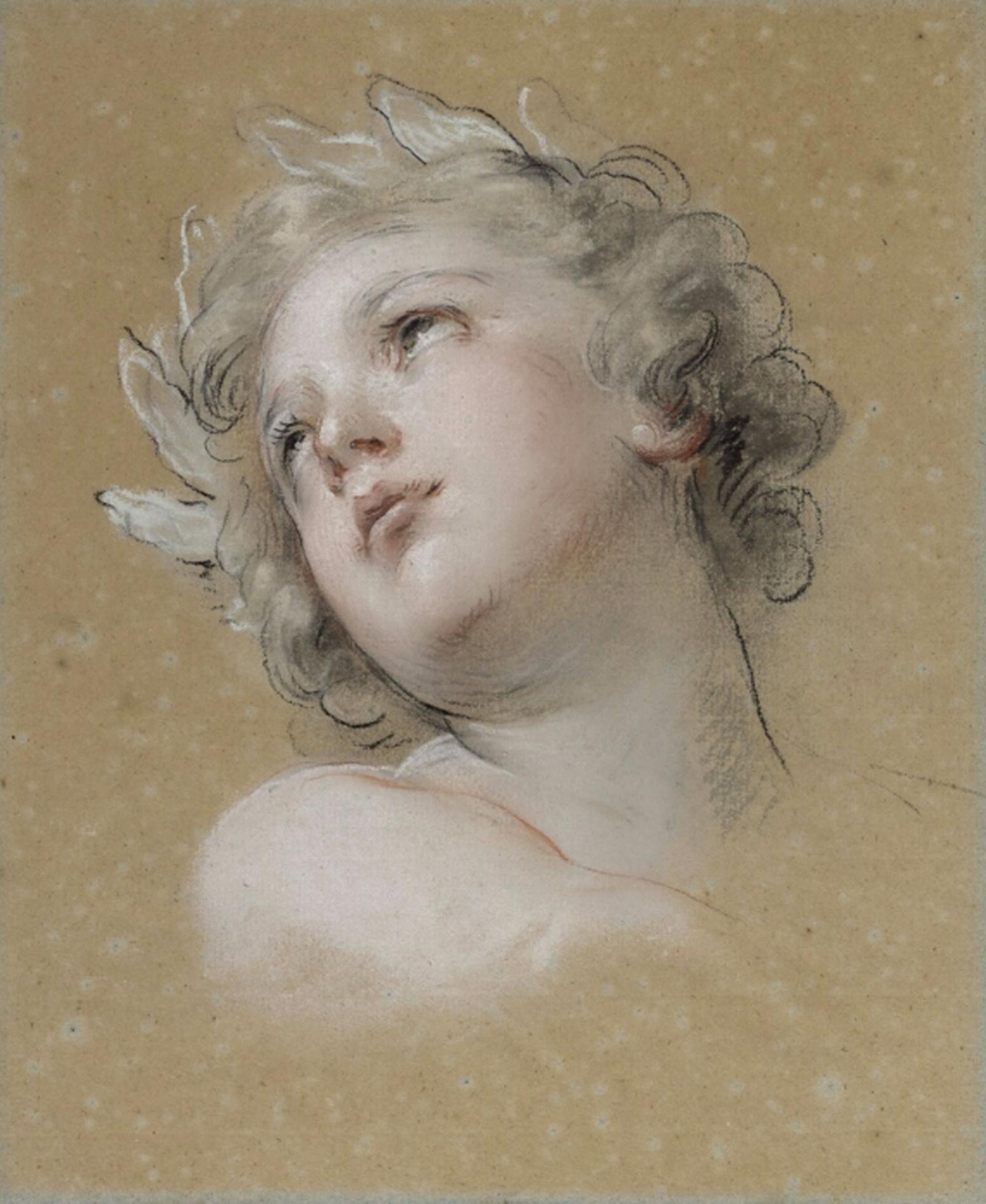
Head study of “The Love of Virtue” in the “Apotheosis of Hercules”
© Château de Versailles, Dist. RMN / © Christophe Fouin
Of the 142 figures that make up the Apotheosis of Hercules, a painted ceiling completed by François Lemoyne in 1736, some of the preparatory sheets survive, including this study for “The Love of Virtue”. This is a central figure of the ceiling, as the angel is between the hero-turned-demigod, and Jupiter introducing him to his daughter, which explains the care taken with this sheet in trois crayons and pastel highlights. With this work, Lemoyne proves that he belongs among the finest pastel artists of his time.
Pair of vases with “lion heads”
Manufacture de Sèvres, Antoine-Jospeh Chappuis (porcelain painter)

Pair of vases with “lion heads”
© Château de Versailles, Dist. RMN / © Christophe Fouin
This pair of vases said to have "lion heads" with a mosaic background and a Chinese landscape and bird depictions was acquired by Louis XVI in 1780, along with two other “garden vases”, before being taken away from Versailles at the end of the Ancien Régime. The "garden" vases were acquired by Versailles in 1998, and these four porcelain pieces, emblems from Louis XVI's collection, have now been reunited.
Sèvres plates
Manufacture de Sèvres, Adèle-Jospeh Carré (turner)
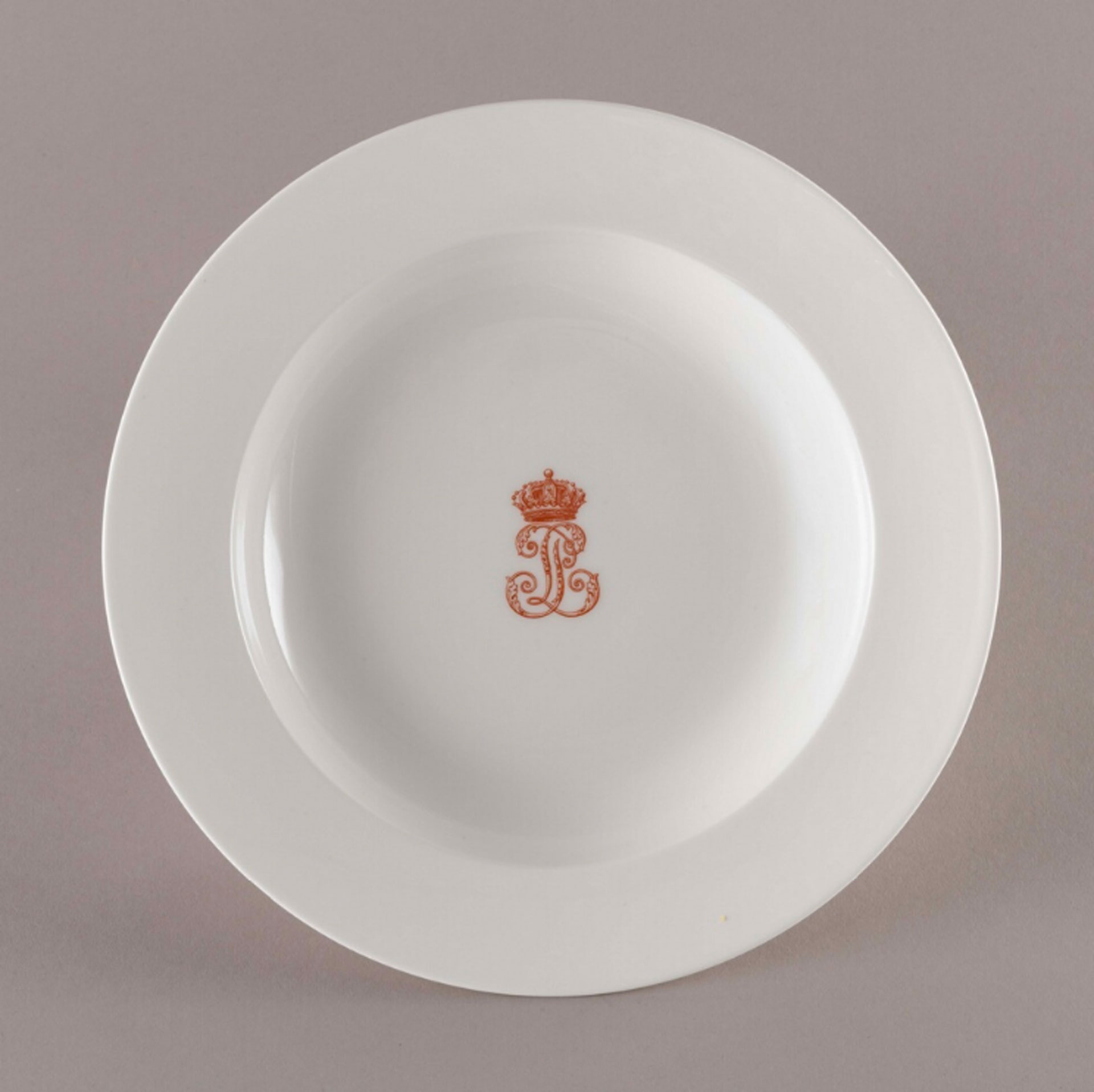
Sèvres plates
© Château de Versailles, Dist. RMN / © Christophe Fouin
These 24 porcelain plates are decorated with a polychrome floral decor and gold rinceaux. They were acquired at a public sale and were a part of King Louis-Philippe's tableware, delivered to the Trianon in 1847. These pieces are now on display in Louis-Philippe's recently refurbished Grand Trianon apartment.
Photography of the Hôtel du Grand Contrôle
Donated by Alain Roger-Ravily
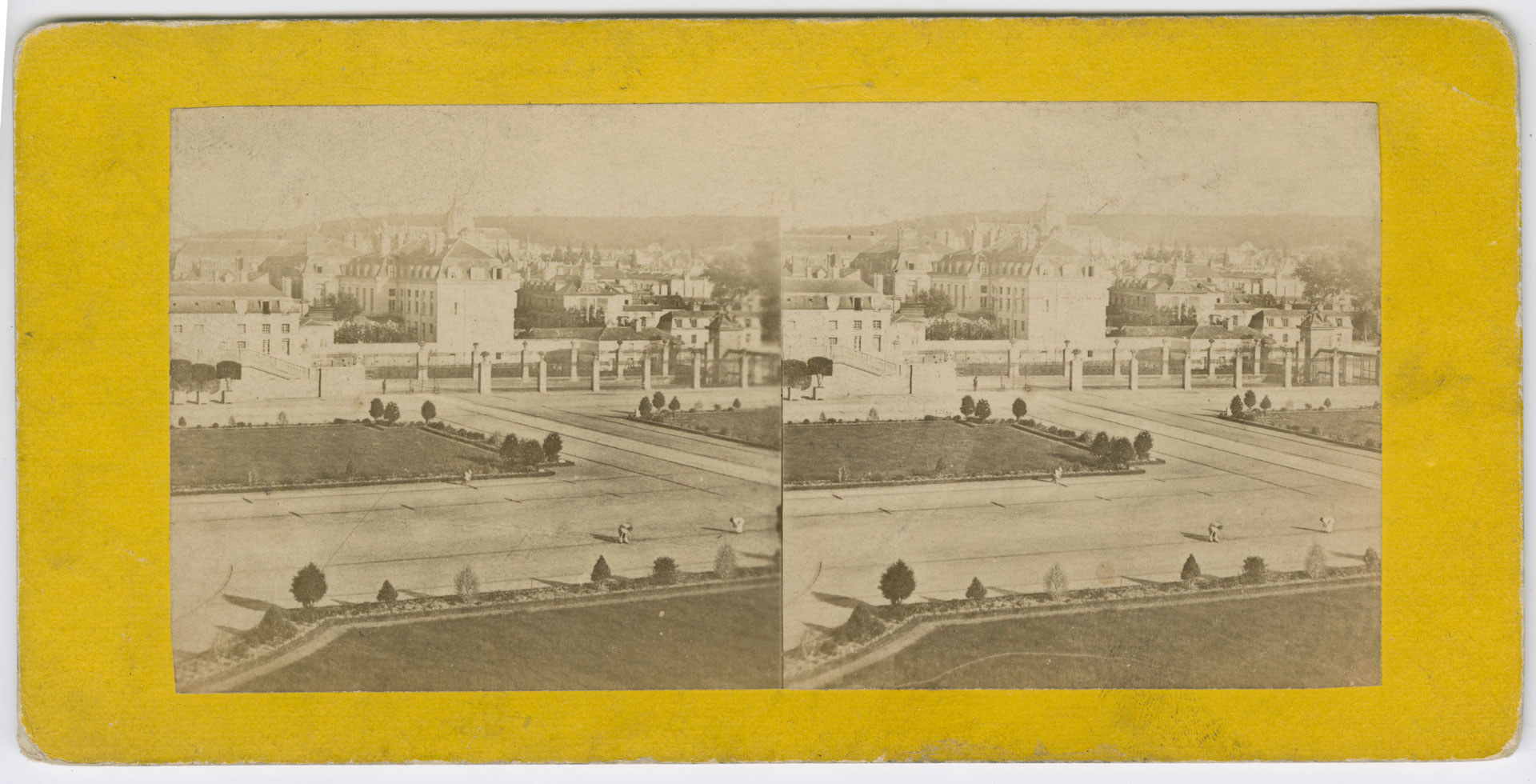
Photography of the Hôtel du Grand Contrôle
© Château de Versailles, Dist. RMN / © Christophe Fouin
Donated by Alain Roger-Ravily, this shot of the Orangery Parterre and Hôtel du Grand Contrôle was taken during the Second Empire and is part of a batch of twenty stereoscopic shots. These prints, along with the 296 views present in the museum's photographic collections, document the history of the architecture of the Palace of Versailles.
“Ricordi” paintings
Charles Le Brun
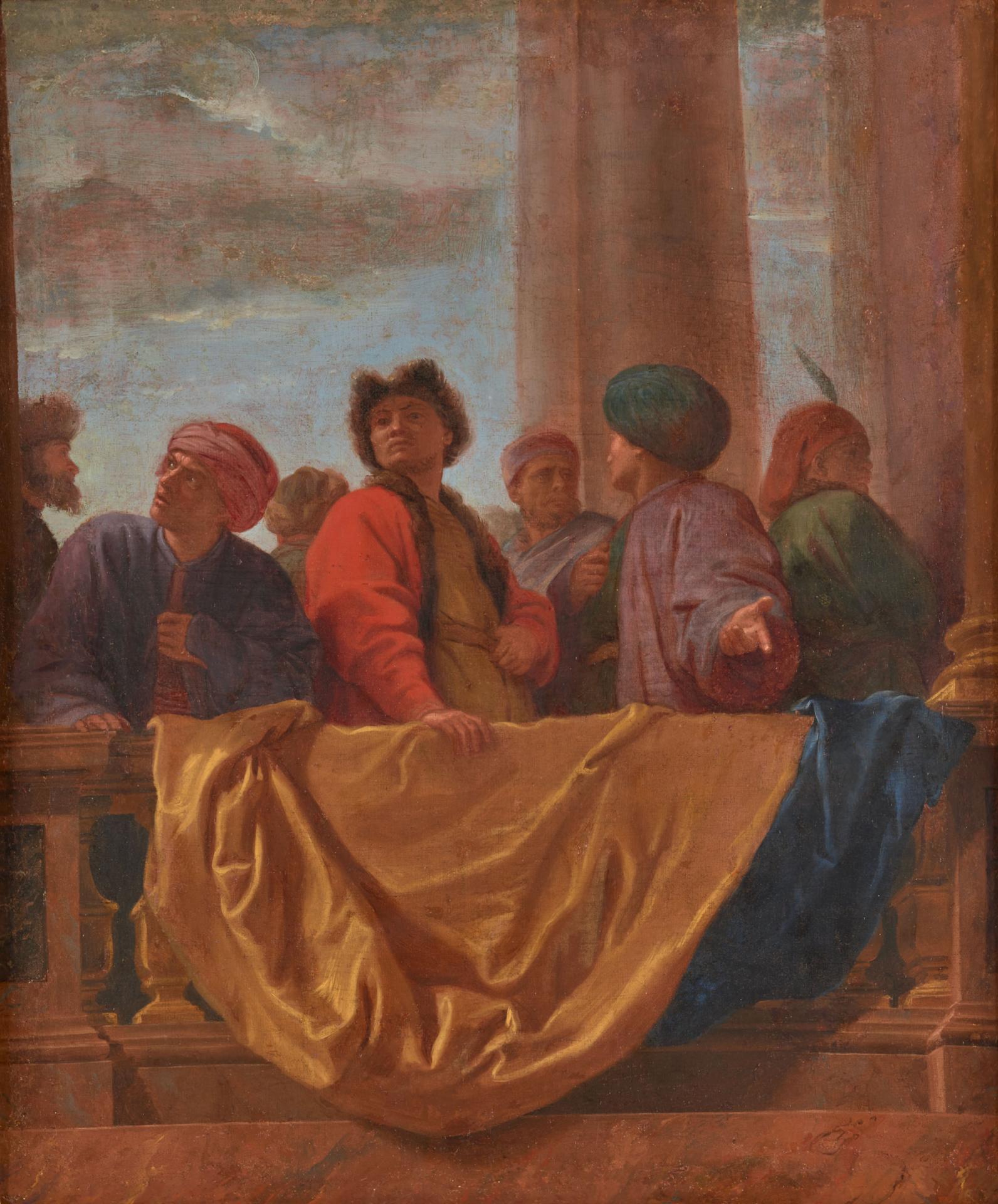
"Ricordi" painting
© Château de Versailles, Dist. RMN / © Christophe Fouin
These two small paintings are fascinating testimonies to the decor of the King's Grand Staircase or Ambassadors' Staircase, one of the most famous in the Palace of Versailles, which was completed by Charles Le Brun in 1679 and destroyed in 1752. The nations of Asia and Africa could be found on the vestibule side. These two paintings would appear to be ricordi or souvenirs, elaborated by the artist.
This acquisition was made in part thanks to the patronage of the La Marck Foundation.
Candelabras
Claude Quentin Pitoin
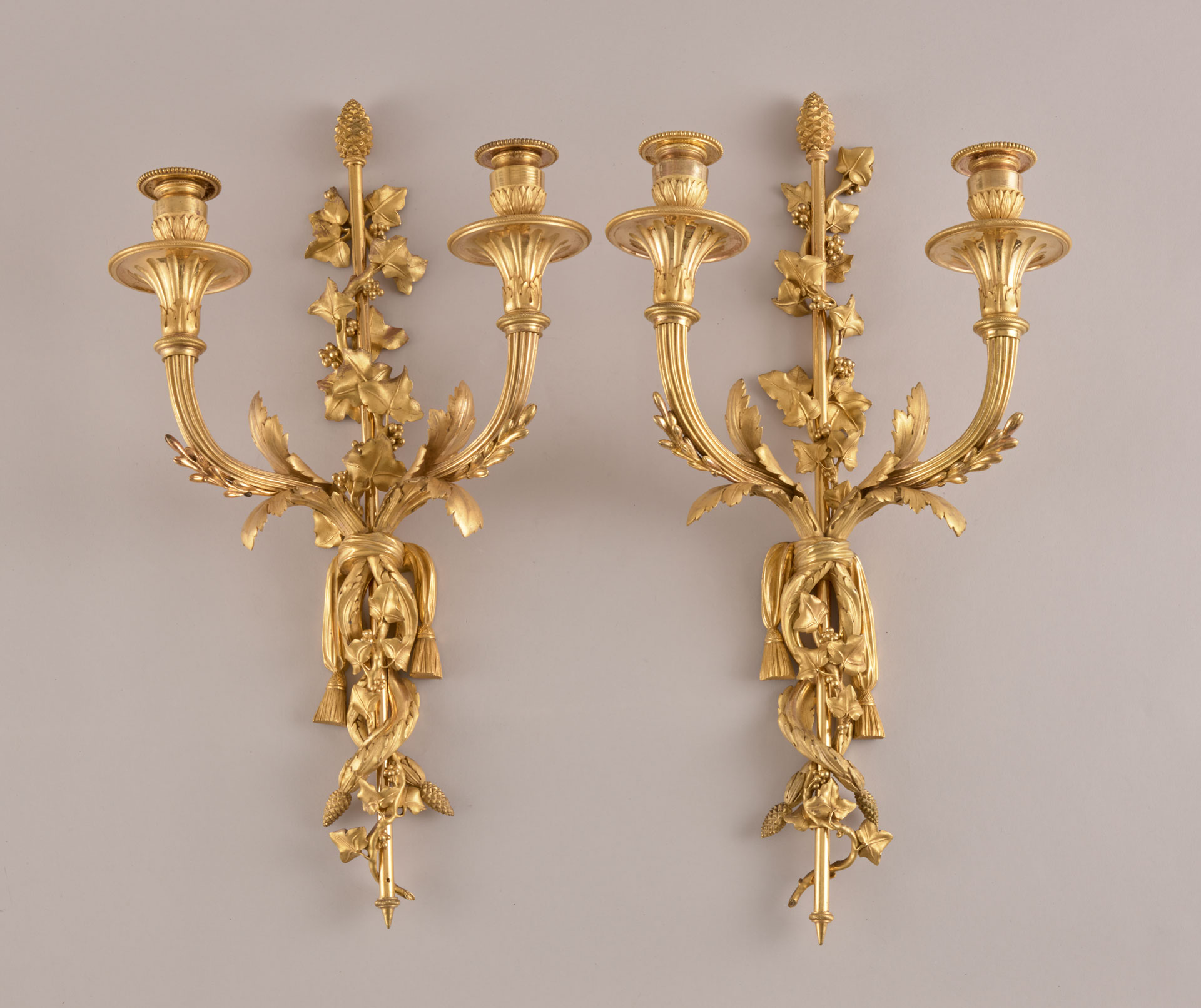
Candelabras
© Château de Versailles, Dist. RMN / © Christophe Fouin
These acanthus-leaf ribbed candelabras are inspired by those delivered in 1781 by Claude Quentin Pitoin for Marie Antoinette's Méridienne Room, now kept at the Getty Museum in Los Angeles.
Le Beau garçon, or Le Favori de la fortune
John Seally
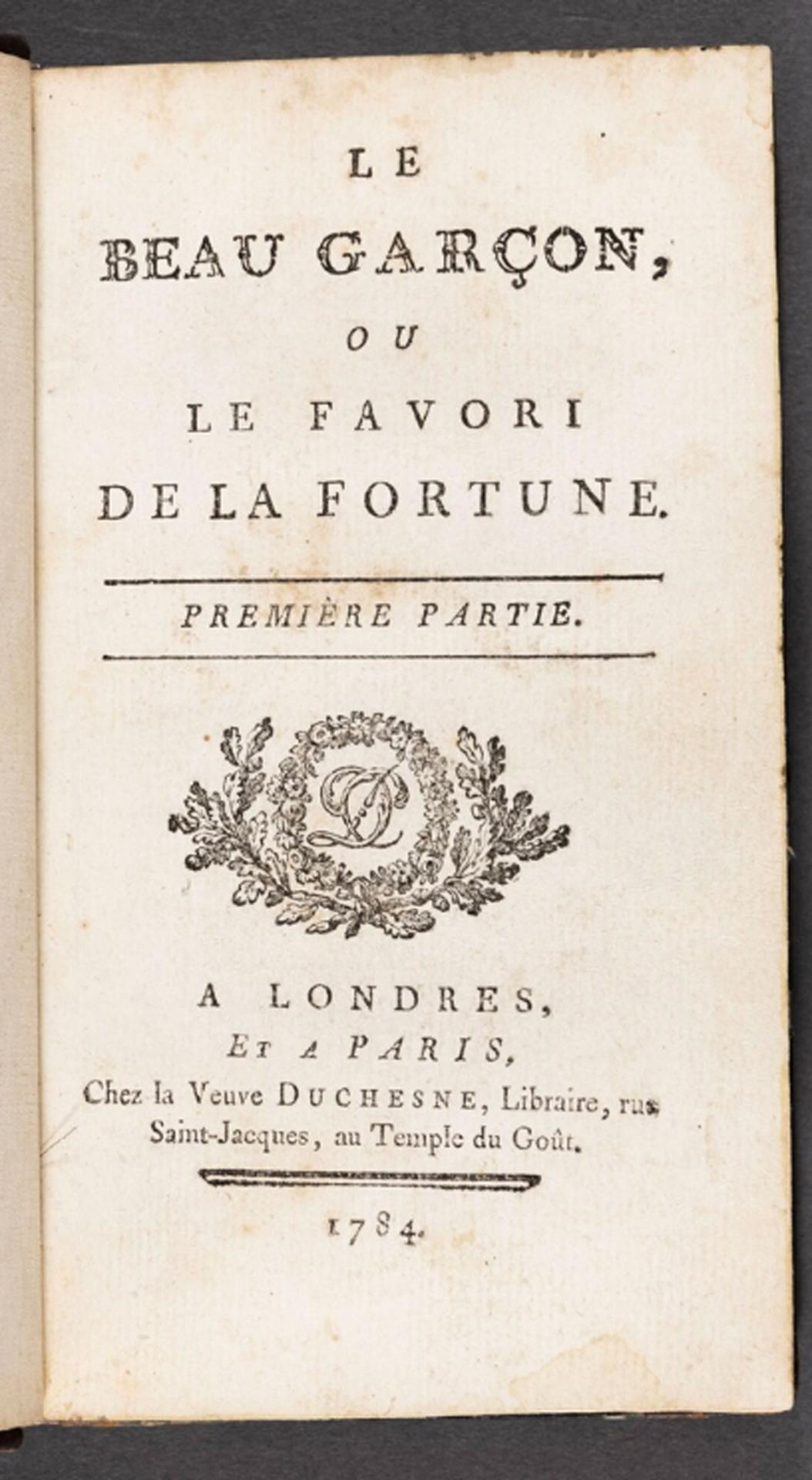
Le Beau garçon, or Le Favori de la fortune
© Château de Versailles, Dist. RMN / © Christophe Fouin
This book by English author and journalist John Seally (1742-1795) was acquired thanks to the donation of Mr Plouseau and Mr Caramelle, through the Friends of Versailles Society, and was included in the catalogue of Marie-Antoinette’s books, drawn up from 1781. It shows the Queen's taste for literature from across the English Channel.
View and perspective of Leto’s Fountain
Louis-Rémy Robert

View and perspective of Leto’s Fountain
© Château de Versailles, Dist. RMN / © Christophe Fouin
From a series of seven glass negatives representing Versailles in the early 1850s, this view of Leto’s Fountain by Louis-Rémy Robert (1811-1882) reflects the beginnings of a new technique, fifty years before Eugene Atget.
2019
The Abduction of a Sabine Woman
Antonio Susini
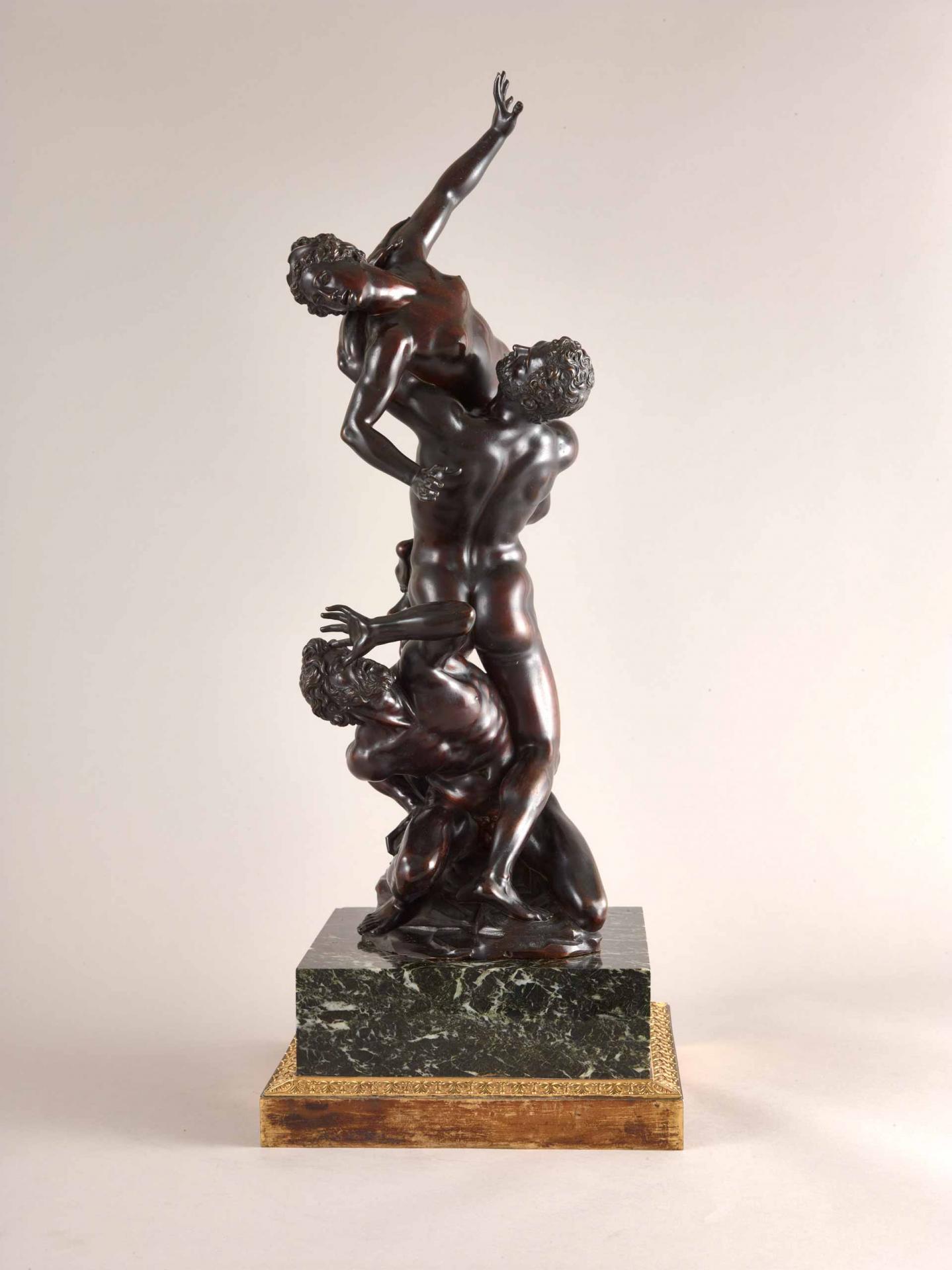
The Abduction of a Sabine Woman
© Château de Versailles, Dist. RMN / © Christophe Fouin
After featuring in the collections of Louis XIV’s son, the Grand Dauphin, at the Palace of Versailles, this bronze sculpted group depicting The Abduction of a Sabine Woman joined the collections of the Crown. It testifies to the pronounced taste of members of the Royal Family, including Louis XIV, for small bronzes copied or derived from models created in Italy. This group boasts an exceptional quality of casting and chiselling and is based on the marble model sculpted by Giambologna in the early 1580s. During his lifetime, Giambologna distributed his art by taking part in the production of bronzes of his own compositions, thus supplying the collections of European art lovers. This piece was sold off during the Revolution, but its purchase was made possible thanks to the bequest of Mrs. Jeanne Heymann.
Round dish of Louis XV's table set with France’s coat of arms
Jingdezhen Manufacture (China)
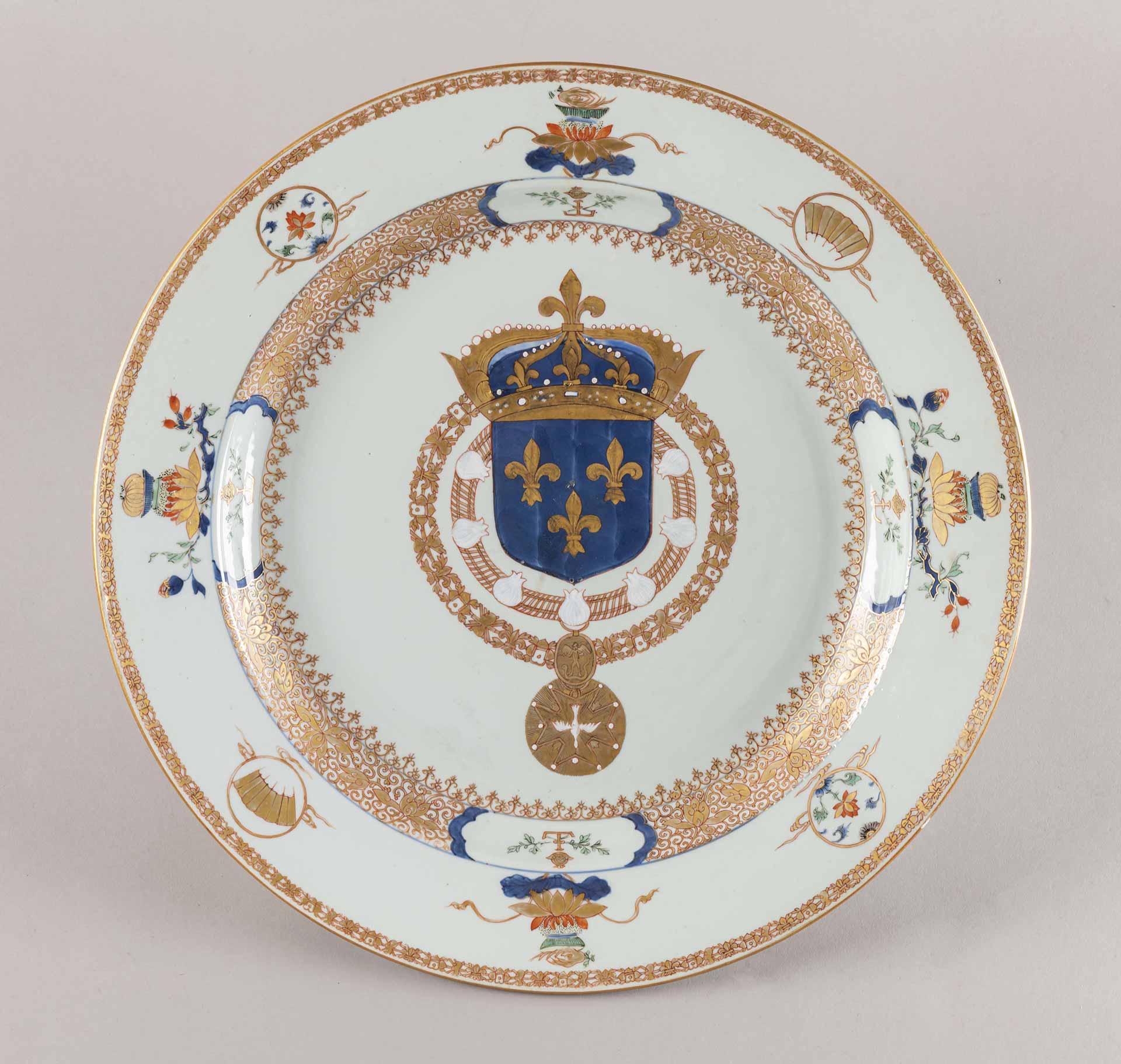
Round dish of Louis XV's table set with France’s coat of arms
© Château de Versailles, Dist. RMN / © Christophe Fouin
This Qianlong-era Chinese porcelain dish, painted and gilded with the King’s coat of arms (a crest with France’s coat of arms with a crown and the chains of the orders of Saint Michael and the Holy Spirit), was commissioned by Louis XV in 1738 through the French East India Company. This table set was probably intended for the new dining rooms built in 1735 on the second and third floors of the King's Chambers at the Palace of Versailles. It is currently on display in the newly-created Porcelain Cabinet.
Review of the King’s Household at Trou d’Enfer
Jean-Baptiste “Louis” Le Paon (drawing), Jacques-Philippe Le Bas (engraving)
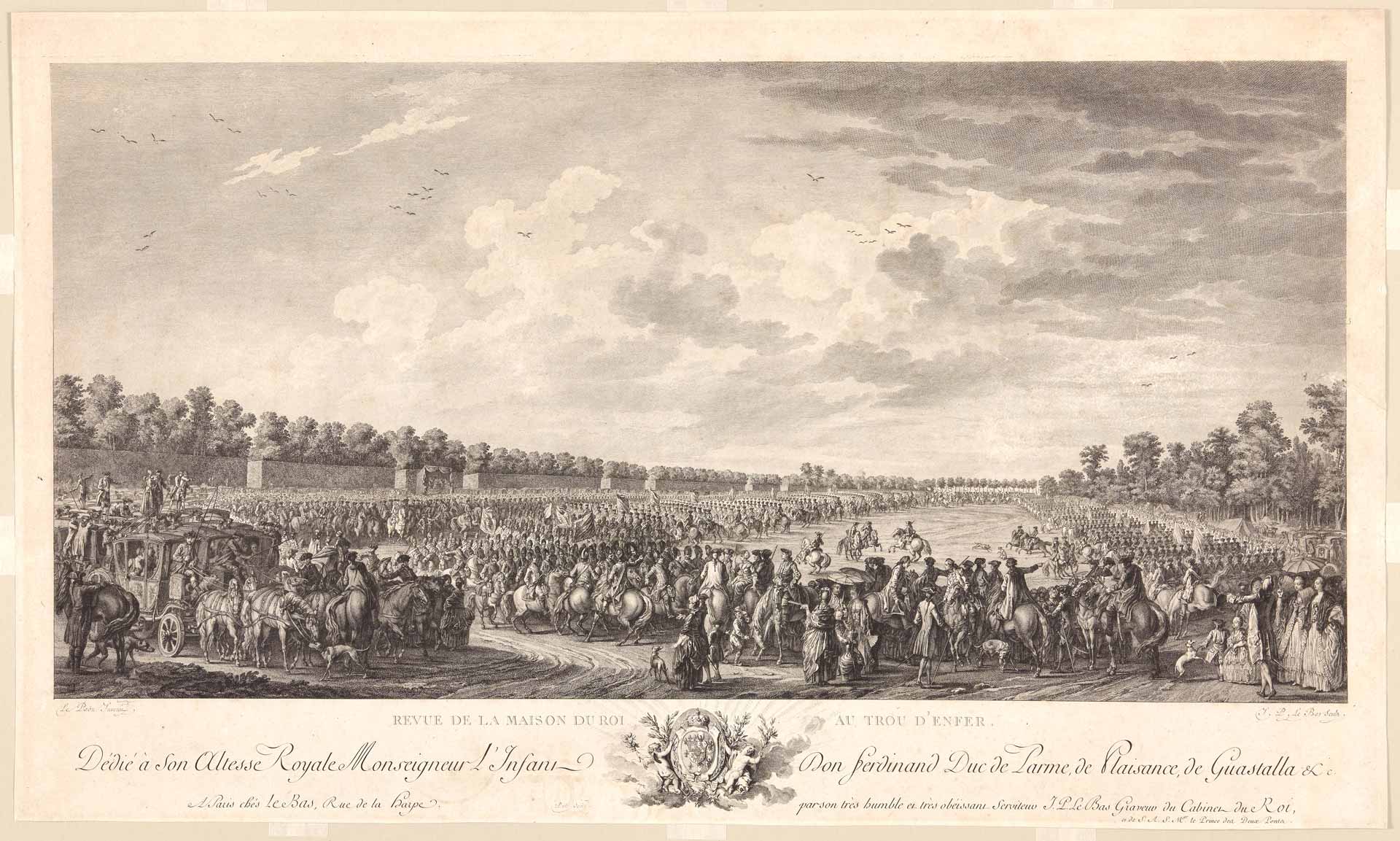
Review of the King’s Household at Trou d’Enfer
© Château de Versailles, Dist. RMN / © Christophe Fouin
This print made by etching and chiselling was donated by Mr. Alain Roger-Ravily and portrays the review of the King’s Household. Once every four years, the King would review his troops in the hamlet of Trou d’Enfer near Versailles. These reviews were public with the Court being invited and the event being described in the newspapers or memoirs of authors of the time. The drawing here was by cavalry officer Le Paon who resigned from his military career to focus on paintings of battle scenes. Jacques-Philippe Lebas (1707-1783) was one of the most prolific engravers of the 18th century.
Bergère armchair
François II Foliot (woodwork), Jacques Gondoin (design)
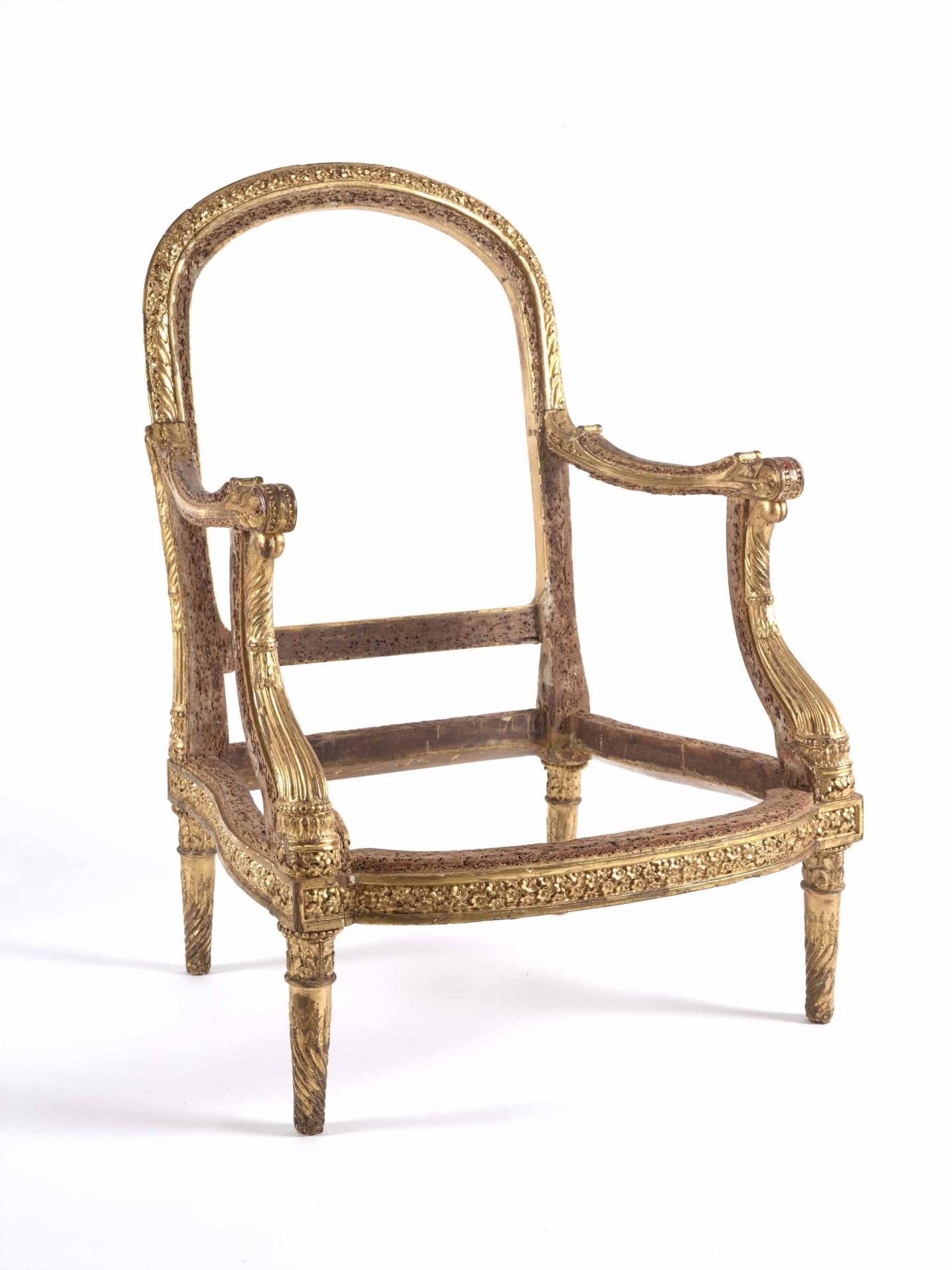
Bergère armchair
© Château de Versailles, Dist. RMN / © Christophe Fouin
This golden beech bergère armchair is richly carved and decorated with natural floral motifs. It has four spiral-fluted legs and capitals with ornamental leaves. It was commissioned in 1779 by Marie-Antoinette to furnish her large private chamber and was one of the main pieces there. This piece of furniture was designed by architect Jacques Gondoin and is very refined. Once it was completed and furnished, the large private chamber boasted a subtle mix ancient classical touches and natural flower motifs.
Pair of vases
Manufacture de Sèvres, Jean-Jacques Dieu (painting on porcelain)
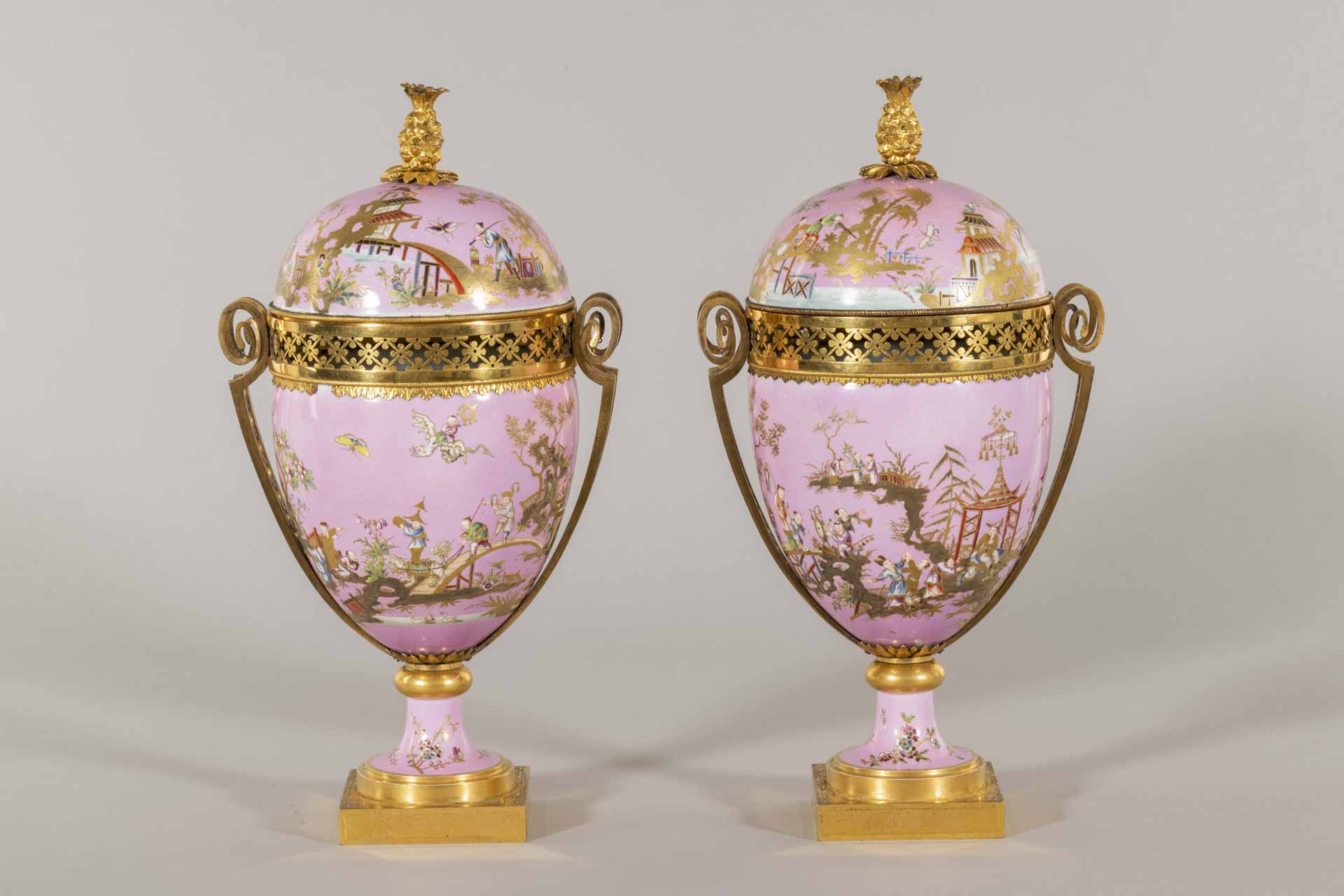
Pair of vases
© Château de Versailles, Dist. RMN / © Christophe Fouin
This pair of vases was delivered by the Manufacture de Sèvres and was acquired for 3,600 pounds by Louis XVI at the factory's annual sales at Versailles in December 1779 and January 1780. These “egg” vases were gifts from the King to his sister Madame Elisabeth and are made of hard-paste porcelain with a lilac background and Chinese decorations on a gilded bronze frame. Several plant motifs can be admired on this piece, especially in the pierced neck forming a trellis of quadrilobed petals, as well as the pineapple-shaped handle. The acquisition of this vase was made possible by the bequest of Madame Jeanne Heymann.
Alexandrine Le Normant d'Etiolles
François Boucher
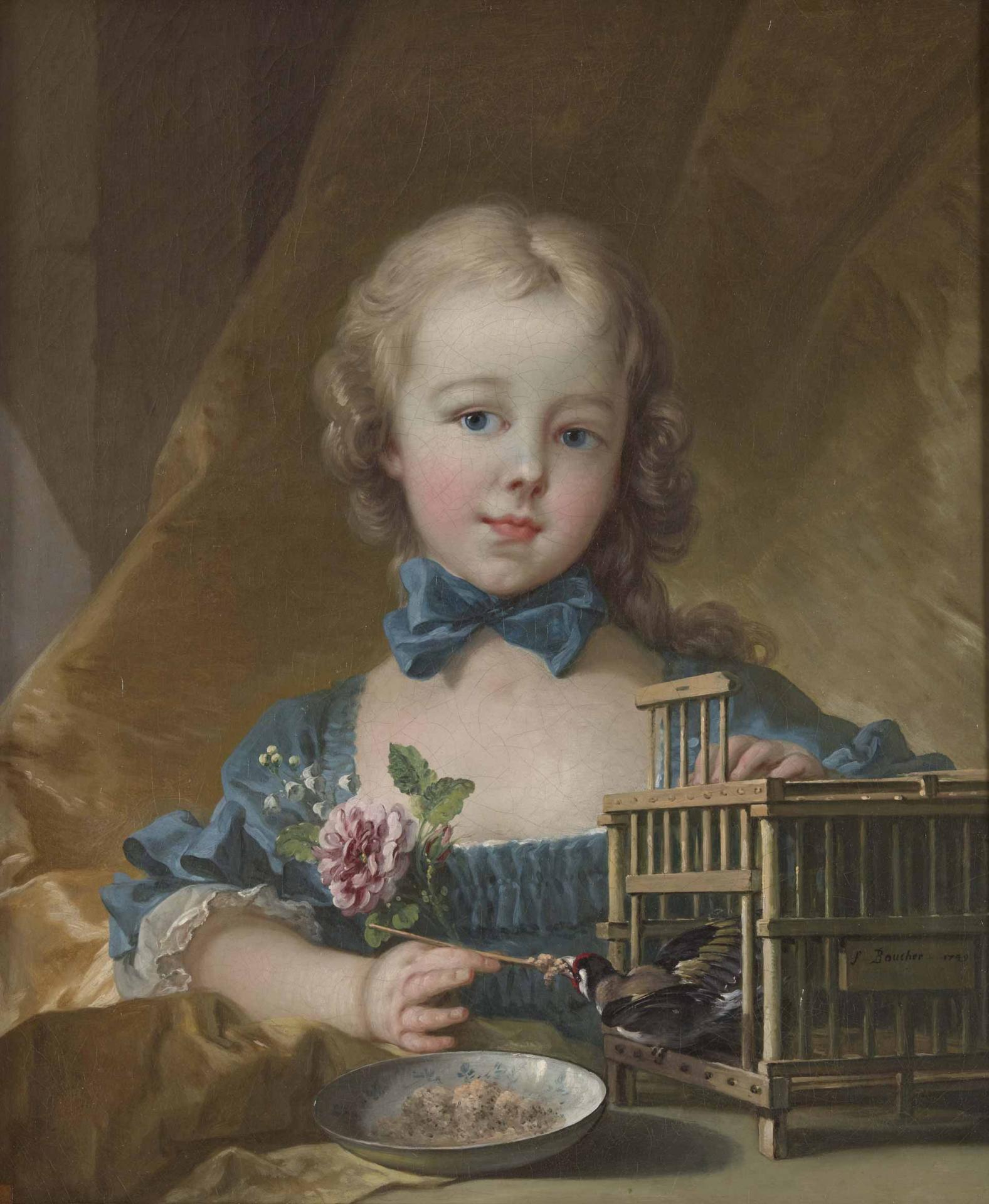
Alexandrine Le Normant d'Etiolles
© Château de Versailles, Dist. RMN / © Christophe Fouin
This portrait, painted in 1749, entered the collections of Versailles thanks to the Society of the Friends of Versailles. It depicts Alexandrine Le Normant, the daughter of Madame de Pompadour, and is one of the few representations of Louis XV’s favourite’s only child. The painting of this portrait by François Boucher corresponded to the child's entry to the Convent of the Dames de l’Assomption on Rue Saint-Honoré in Paris, but Alexandrine died of peritonitis in June 1754, before the age of 10. The presence in this painting of a caged bird is a common feature in portraits of children under the Ancien Régime, as it underlines the ephemeral nature of this tender age.
Courteille bowl
Manufacture de Sèvres

Courteille bowl
© Château de Versailles, Dist. RMN / © Christophe Fouin
This Courteille floral bowl, from a pair probably acquired by Louis XVI at the Versailles exhibition in December 1779, was made of soft-paste porcelain by the Manufacture de Sèvres. It is decorated with a lilac Taillandier background as well as two cartels. One side is decorated with a pastoral landscape and sheep, and the other side with a bush in flower placed on a mound and hollyhocks in front of a dolphin fountain. This pair was placed in the King’s Bath Chamber, according to the so-called 1791 inventory. This purchase at a public sale joined its counterpart which had been in the collections of Versailles since 1994.
Paul Verlaine
Louis-Eugène de Gaspary

Paul Verlaine
© Château de Versailles, Dist. RMN / © Christophe Fouin
This original plaster bust by Louis-Eugène de Gaspary is one of the few sculpted portraits of writer Paul Verlaine. The model's gaze is turned to the left, evoking the poet's inspiration. The pedestal consists of a quill placed on the right side, as well as a pile of books evoking the famous works of the artist: Poésies, Romances sans paroles, La bonne chanson, Fêtes galantes, Sagesse, Jadis et naguère, Amour. This sculpture was presented at the Salon of the Society of French Artists in 1893, where visitors did not fail to notice the strong personality of the poet, brilliantly rendered by the sculptor.
View of the Orangery
Charles Jouas
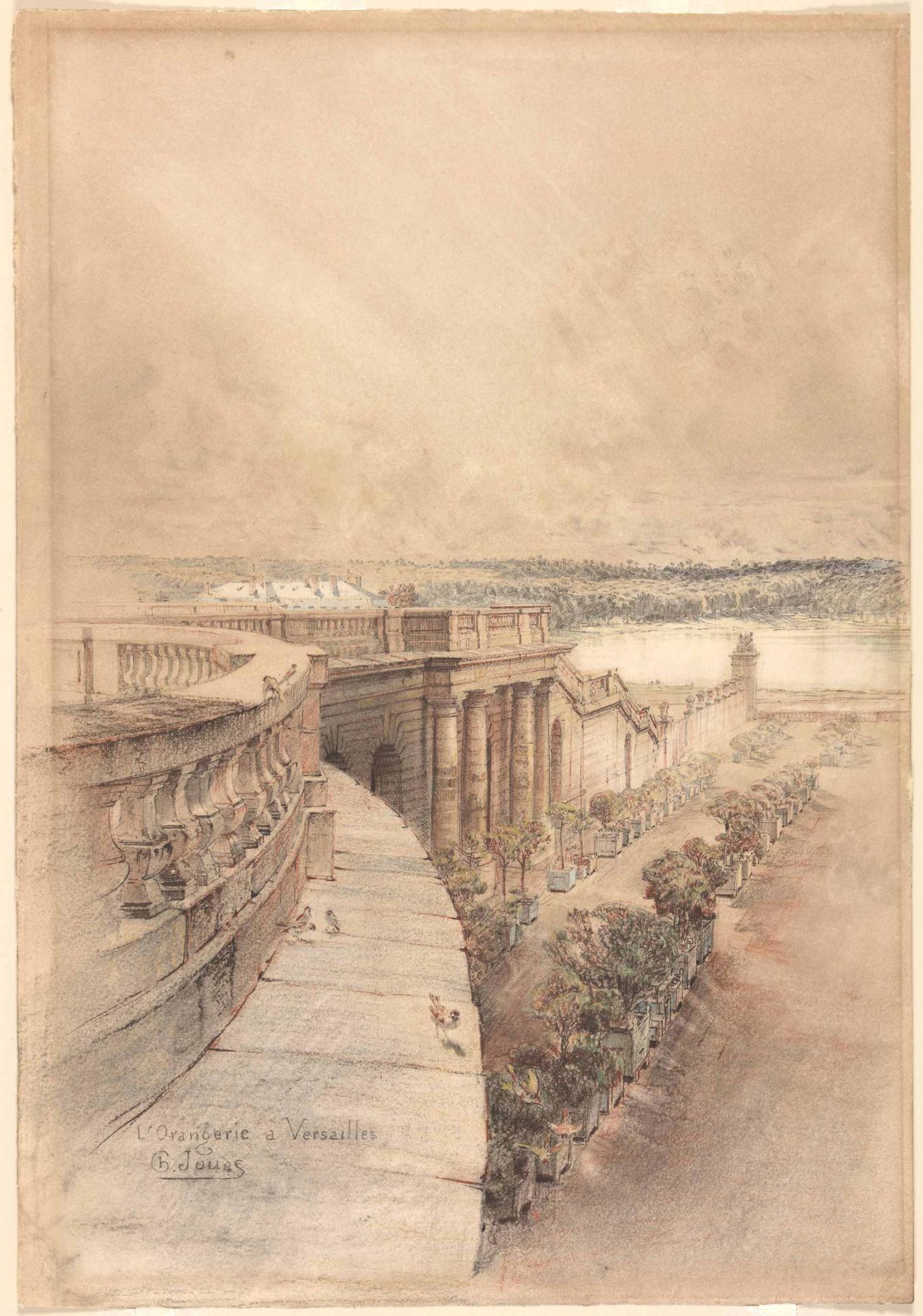
View of Orangery
© Château de Versailles, Dist. RMN / © Christophe Fouin
This view of the Orangery, drawn with a quill and brown ink, red chalk and pastel in around 1910 by Charles Jouas is currently on display as part of the “Versailles Revival” exhibition. Architecture is central to this artist's work: both the Cathedral of Chartres and Palace of Versailles are represented for their architectural and symbolic power. Jouas draws the decorative and architectural elements with talent and precision, and his drawings always testify to his mastery of light effects and his particular taste for unusual points of view. Through his choice of faded colours and unusual views, the places he depicts are often tinged with strangeness or mystery. This acquisition completed the purchase of the View of the Reservoirs which had been made in 2018.
Stereoscopic view of the Place d'Armes and the Palace.
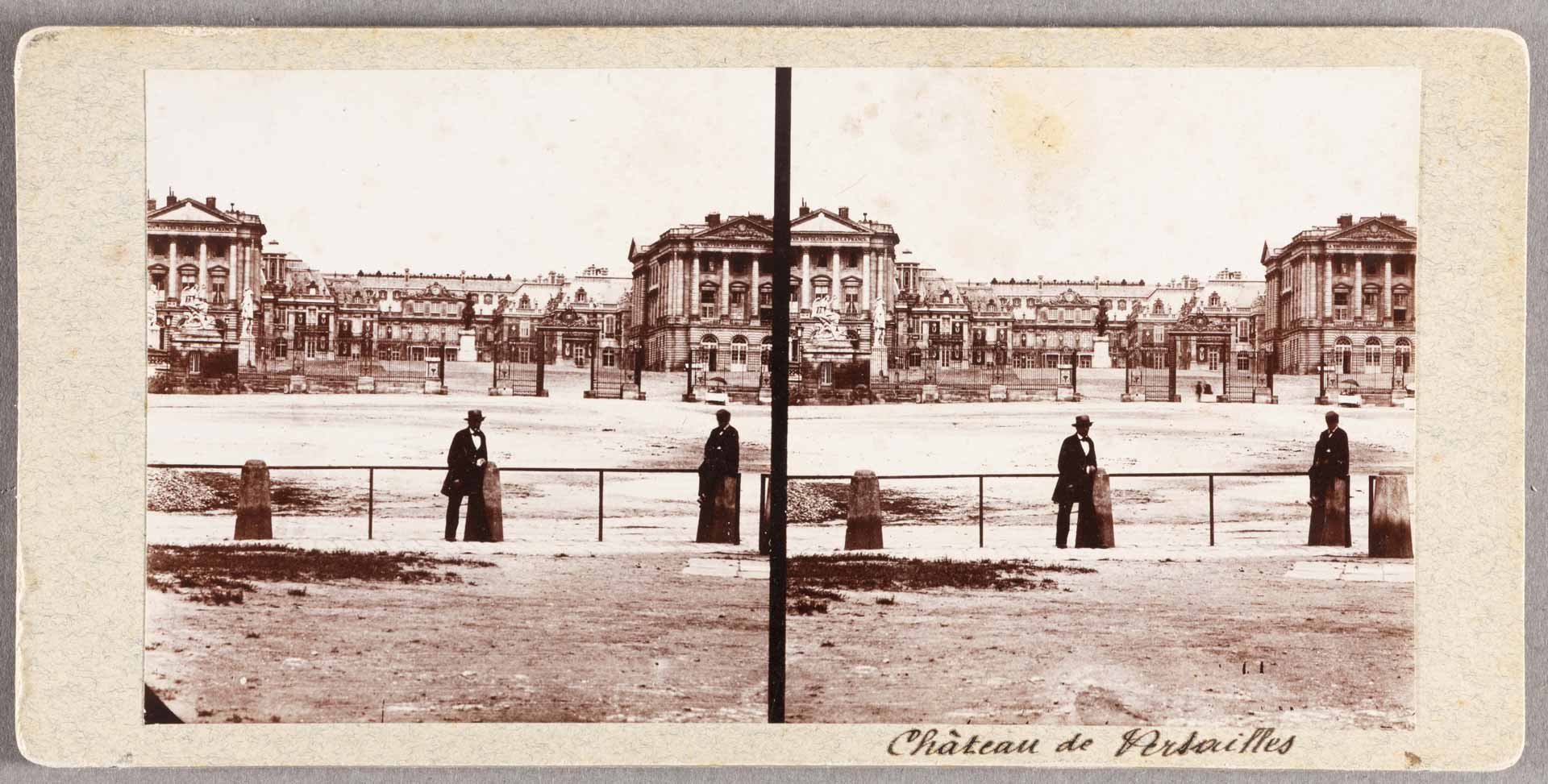
Stereoscopic view of the Place d'Armes and the Palace.
© Château de Versailles, Dist. RMN / © Christophe Fouin
This photograph, which entered the Versailles collections thanks to the donation of Mr. Alain Roger-Ravily, depicts a stereoscopic view of the Place d'Armes and the Palace, dated between 1860 and 1870. This type of work is precious for its insight into the different historical states of the King’s home: we can note that the statue of Louis XIV by Pierre Cartellier, which is now on display on the Place d’Armes, used to decorate the centre of the Royal Courtyard. Similarly, the turret built under Louis-Philippe at the corner of the Royal Courtyard, which was destroyed later, is still present here.
Chest of drawers
Bernard II Vanrisamburgh
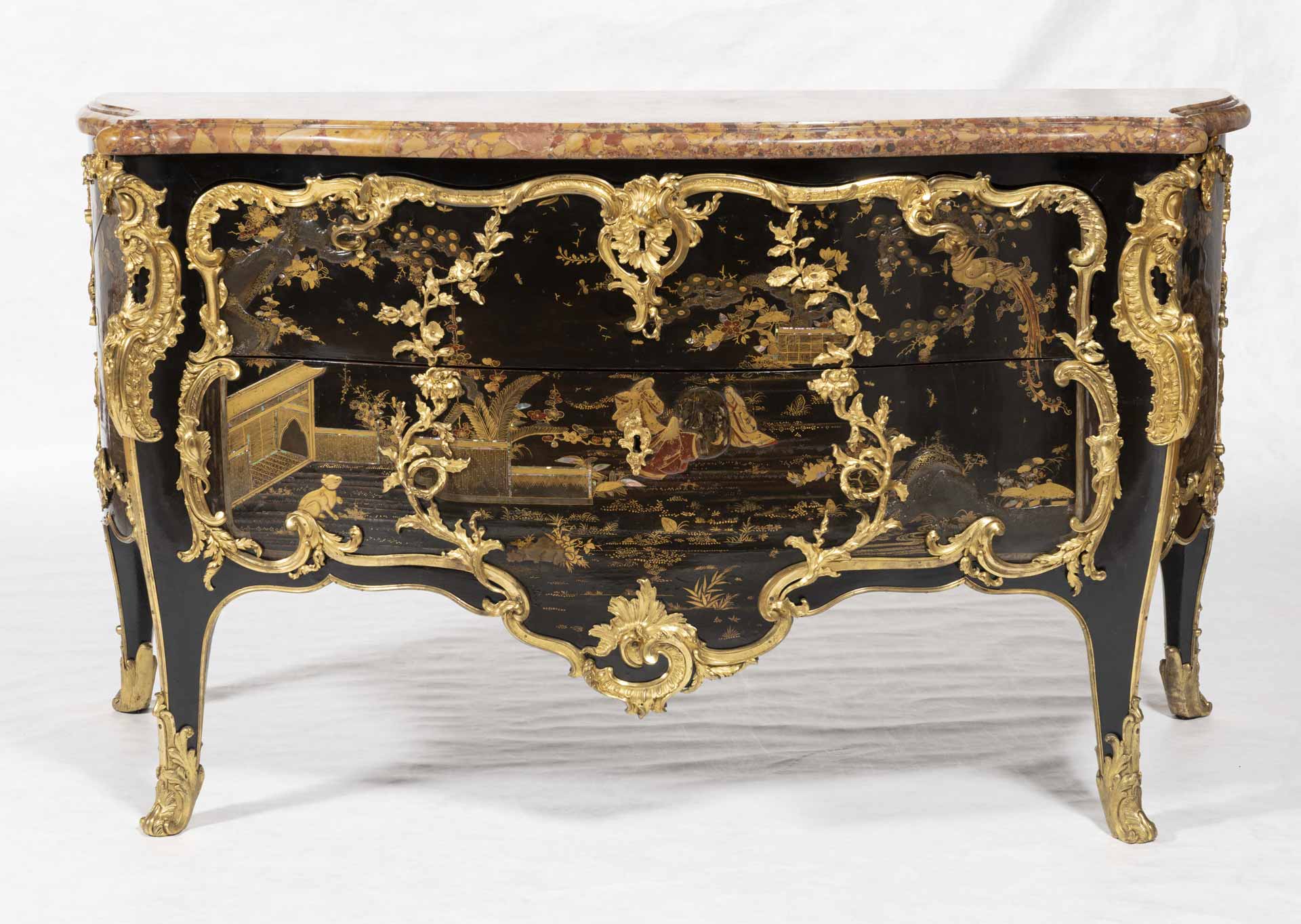
Chest of drawers
© Château de Versailles, Dist. RMN / © Christophe Fouin
This work by Bernard II Vanrisamburgh (1696-1766) was commissioned in 1745 for the marriage of the Dauphin, the son of Louis XV, with the Infanta of Spain Maria-Theresa Rafaela, for their new apartment located on the first floor of the South Wing. This chest of drawers with its curved shapes is composed of Japanese lacquer panels with European varnish motifs and is lavishly embellished with gilded bronzes forming large, whirling cartouches. It was delivered by Thomas-Joachim Hébert, one of the most innovative merchants of his generation. This chest of drawers is one of the most spectacular acquisitions of 2019, made possible thanks to the bequest of Madame Jeanne Heymann. It is on display in the Dauphine’s Chamber.
La Cité des eaux
Henri-François-Joseph de Régnier

La Ciét des eaux
© Château de Versailles, Dist. RMN / © Christophe Fouin
This acquisition is particularly interesting in that it associates the poems of Henri de Régnier with the two sets of engravings made by artist Charles Jouas to go with them: the first printed in bistre and the second in black. This second series contains at least one engraving which was not used in the published collection: "The Music Pavilion." This volume also features a handwritten poem by Henri de Régnier, as well as fifteen drawings and sketches by Jouas, which make it a special object for book lovers. These drawings bear witness to Jouas' efforts to find the best views of the Palace of Versailles, perfecting his technique mixing pencil, red chalk, oil pastel, chalk and gouache.
Pierre de Nolhac's Academician’s Sword
Edmond Becker (goldsmith)

Pierre de Nolhac's Academician’s Sword
© Château de Versailles, Dist. RMN / © Christophe Fouin
Pierre de Nolhac, eminent curator of the Palace of Versailles, was elected to the Académie Française on 15 June 1922 to the chair of Emile Boutroux and then received there by Maurice Donnay on 18 January 1923. This sword, made of steel and silver gilt, is decorated with a pommel cut in the round and depicting the face of Laure de Sade. There are also the coats of arms of the Nolhacs - "azur with a silver castle, with a chief gules bearing a silver star between two gold fleurs de lys". It was donated to Nolhac by the Society of the Friends of Versailles and the Academy of Moral Sciences of Letters and Arts of Seine-et-Oise, and then presented at a private ceremony at the Jacquemart-André Museum. It entered the Palace collections in 2019 thanks to a donation from the Society of Friends of Versailles.
Spain Defeated
Charles Le Brun

Spain Defeated
© Château de Versailles, Dist. RMN / © Christophe Fouin
This painting is the sketch for Spain Defeated, one of the arches painted by Charles Le Brun for the War Room. A broad European coalition was assembled around the Dutch, including the Holy Roman Empire and Spain. This sketch reveals slight differences with the final, more accomplished composition, where the subject of war seems to have been accentuated. This work is a precious testimony to the creation of the War Room in 1684 and completes the painted series preparing the arches of this décor: Bellona in a Rage, Germany Looking at Victory with Horror and Holland Overturned on its Lion. These four paintings by Charles Le Brun are presented in the Gallery of the History of the Palace, on the ground floor of the North Wing.
2018
Flat-top desk
Bernard II Vanrisamburgh
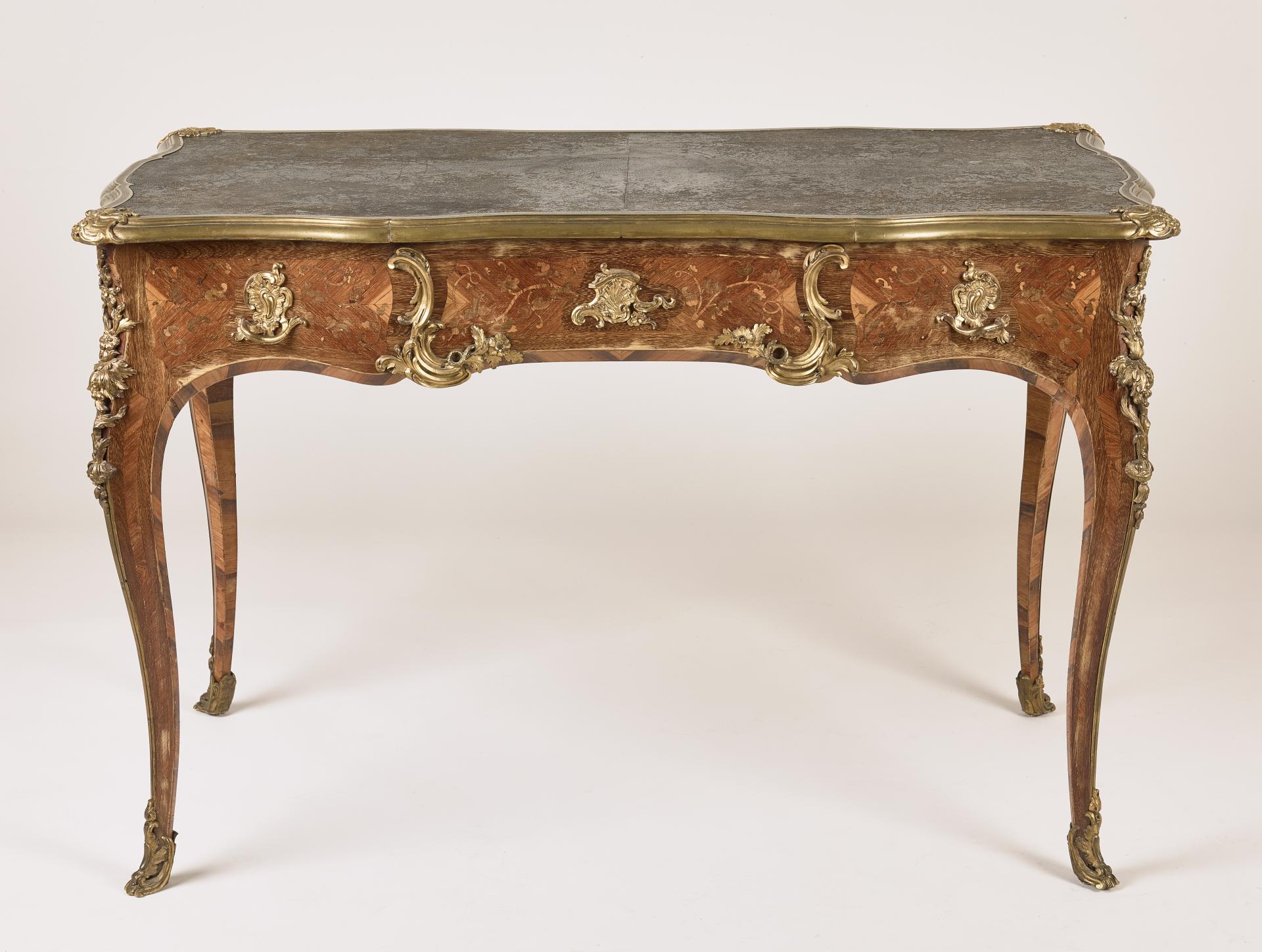
Flat-top desk
© Château de Versailles, Dist. RMN / © Christophe Fouin
Produced in the workshop of the cabinetmaker Bernard Vanrisamburgh (circa 1700-1766), this small flat-top desk, with three drawers, has all the stylistic features of this master craftsman who specialised in rich floral marquetry. This desk was commissioned on the occasion of the marriage of the Dauphin of France, Louis-Ferdinand, son of Louis XV, to the Infanta Maria Teresa Rafaela of Spain in 1745. In order to furnish the new apartments for the royal couple on the first floor of the South Wing, the Royal Furniture Treasury purchased new furniture, including this table-cum-desk, intended for the library, and supplied by the decorative-arts purveyor Henri Le Brun. This work was acquired as payment in kind.
Traders preparing bundles, and a Jesuit conversing with a Mandarin
The fair in the city of Nankin
Marie Leszczynska

Traders preparing bundles, and a Jesuit conversing with a Mandarin
© Château de Versailles, Dist. RMN / © Christophe Fouin
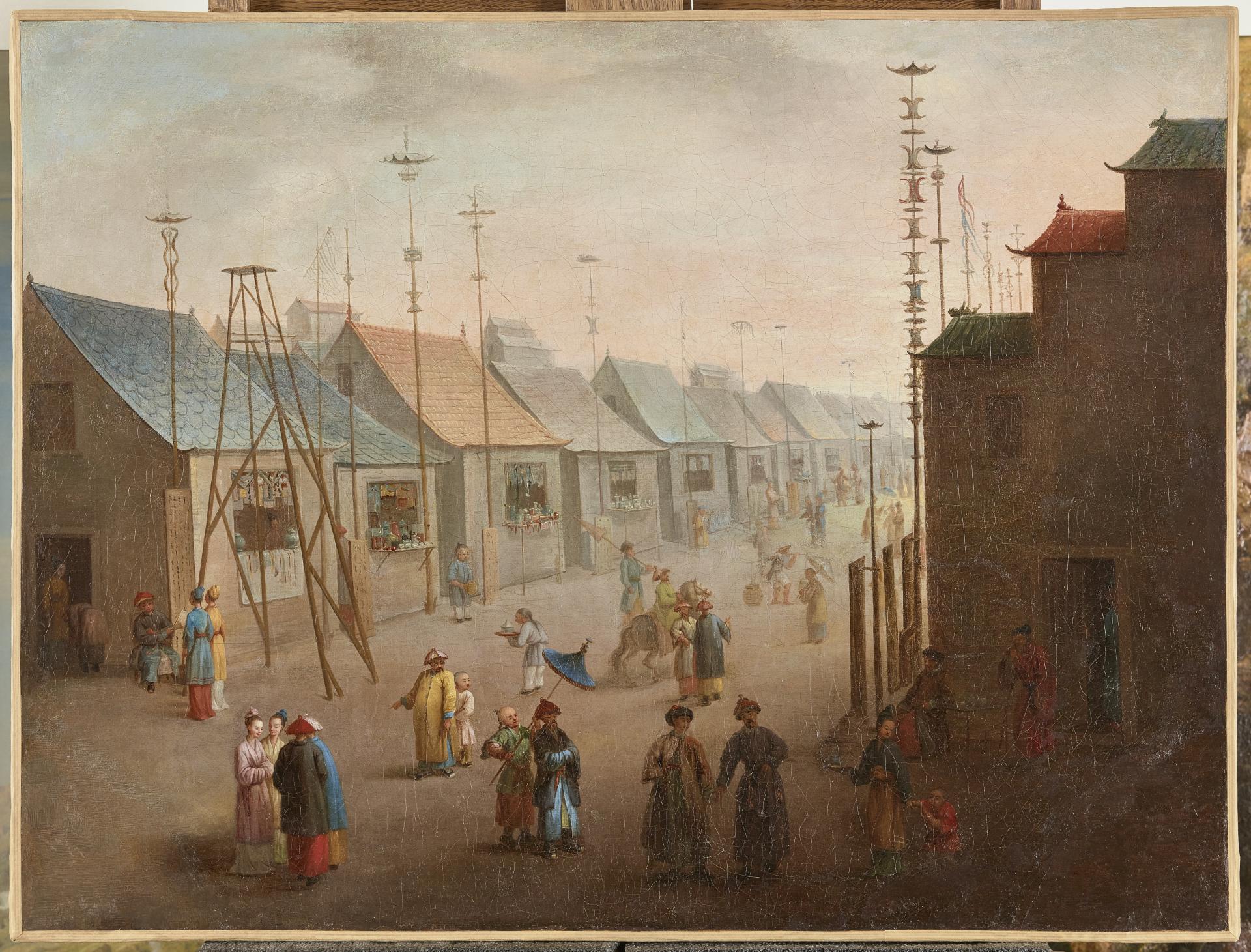
The fair in the city of Nankin
© Château de Versailles, Dist. RMN / © Christophe Fouin
These two works are part of a cycle of paintings from the beginning of summer 1761 by Queen Marie Leszczynska, assisted by La Roche, Frédou, Prévost and Coqueret, painters of the King’s Cabinet. The Queen was particularly interested in the history of the first missionaries to China. A first Chinese room was originally installed for Marie Leszczynska in Versailles in 1747 in what is now Marie-Antoinette's library; it was replaced by a second room in 1761, known as the “Chinese room”.
Dessert platter from Louis XV’s “Bleu celeste” (Heavenly blue) service
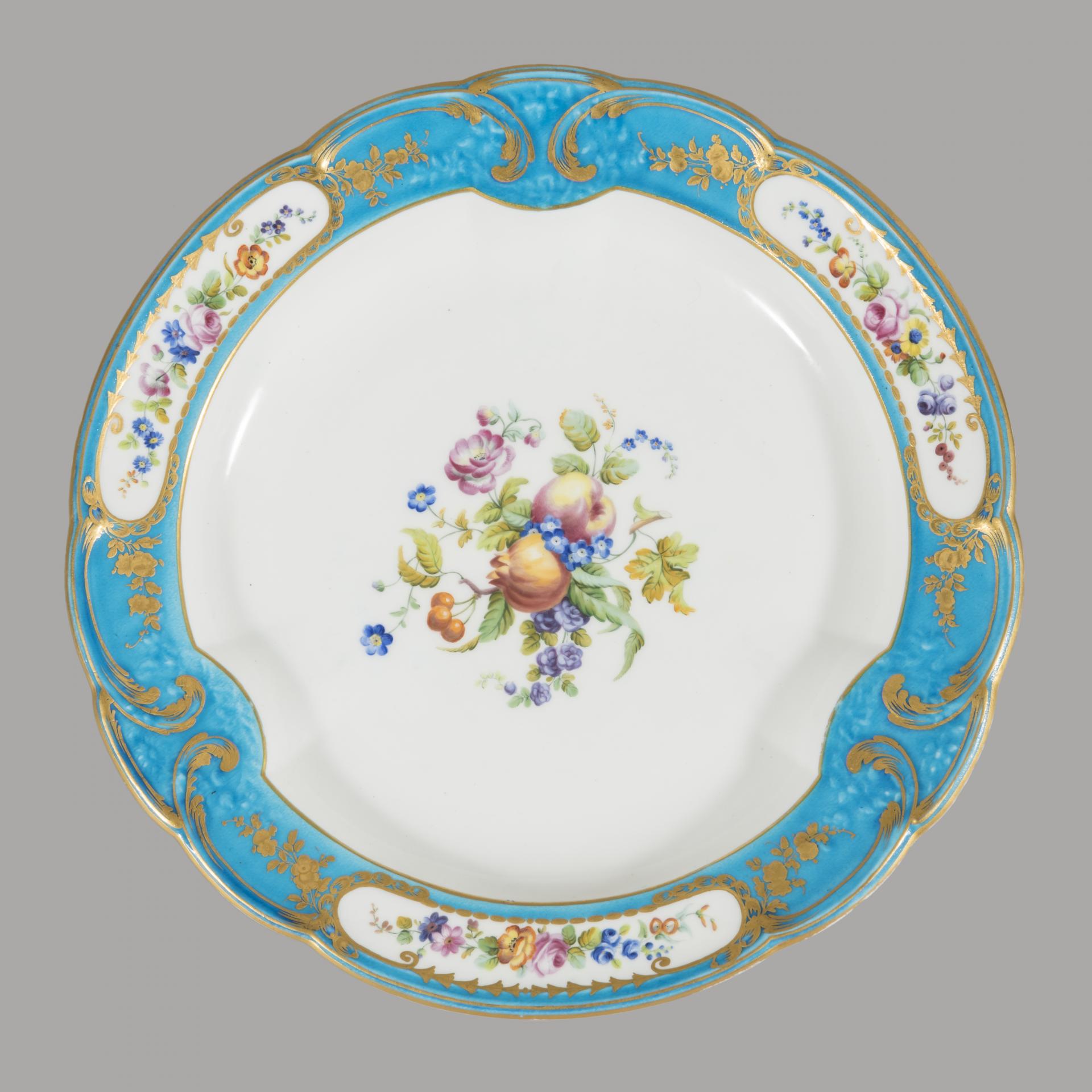
Dessert platter from Louis XV’s “Bleu celeste” (Heavenly blue) service
© Château de Versailles, Dist. RMN / © Christophe Fouin
This dessert platter is made of porcelain with redcurrant motifs on a background of turquoise blue, a pigment that was invented by the scientist Jean Hellot. The platter was intended to be used for serving dishes between the roast meats and the desserts. It is part of the Bleu Céleste service, the first complete dinner service delivered by the Vincennes Manufacture, and of which Versailles has many pieces. This acquisition was funded by the Friends of Versailles Society through a legacy from Madame Simone Baraille.
Jug from Siam
Piece acquired in February 2018 thanks to the patronage of LVMH-Moët Hennessy-Louis Vuitton
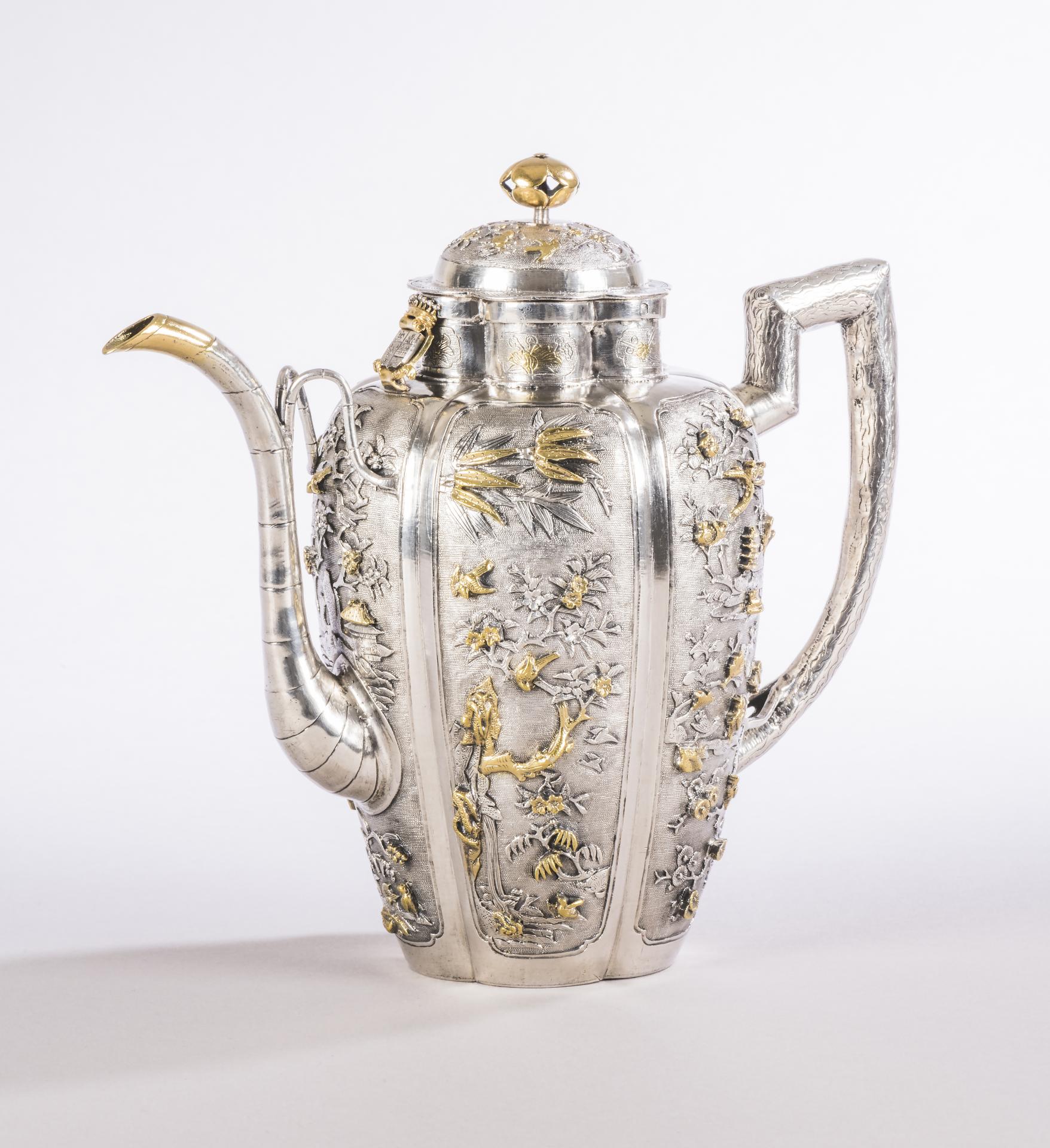
Jug from Siam
© Château de Versailles, Dist. RMN / © Christophe Fouin
This gilded silver jug, of Chinese origin, is decorated with chased leaf motifs, showing houses and birds in relief, and is an extremely rare piece. It was given to Louis XIV by the ambassadors of Siam during their audience with the King at Versailles in 1686, and it is the only silver item still in existence that was given as a gift to the King by the King of Siam, Phra Naraï (1633-1688) or his prime minister, Constance Phaulkon (1647-1688).
Portrait of Charles Perrault
Charles Le Brun, 1665

Charles Perrault
© Château de Versailles, Dist. RMN / © Christophe Fouin
It was perhaps in Simon Vouet’s studio that Le Brun first learned how to use pastel, although Le Brun’s technique is closer to that introduced into France by Wallerand Vaillant: the subject’s position is a three-quarter view, the materials are delicate and applied quickly, brown background, limited colour palette (brown, white, black, red and blue). This “Portrait for friendship” is by an artist at the peak of his career, as he was appointed Painter to the King in June 1664, and shows another artist, a writer this time, but also a close collaborator of Colbert, to whom Le Brun owed his appointment. We can also see what unites the writer and the painter, as both are striving towards the glorification of Louis XIV.
Commode for Madame Adélaïde’s chambers at Versailles
Donated by the Society of the Friends of Versailles in 2018, thanks to the exceptional legacy of Ms Simone Baraille, Ms Micheline Cavallo and Ms Monique Genneret
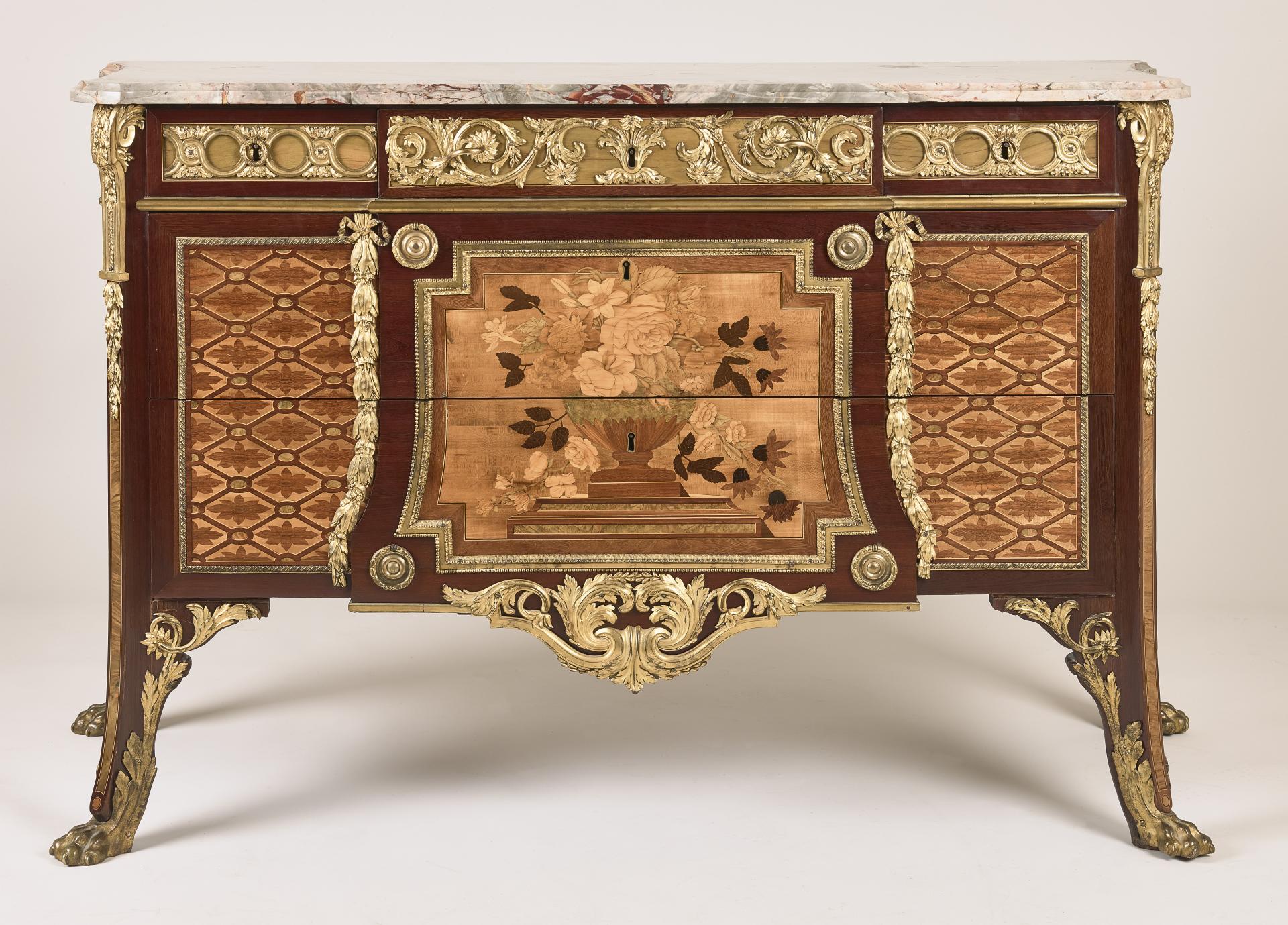
Commode for Madame Adélaïde’s chambers
© Château de Versailles, Dist. RMN / © Christophe Fouin
This commode was delivered in 1776 for the withdrawing room of Madame Adélaïde, daughter of Louis XV, in her ground floor apartment in the central section of the Palace, and it can now be returned to the exact location for which it was originally intended. From its structure, its marquetry with latticework and colour, and the richness of the bronze work, this commode is typical of those produced by Jean-Henri Riesener during the period 1770-1780. In the central panel we also see a sunflower emerging, the cabinetmaker’s favourite motif.
The death of Saint François-Xavier
Charles-Antoine Coypel

The death of Saint François-Xavier
© Château de Versailles, Dist. RMN / © Christophe Fouin
The Death of Saint François-Xavier by Charles-Antoine Coypel came originally from the Palace of Versailles. In fact, the work was commissioned by the Dauphin Louis de France (1729-1765) for his wife, and previously hung in Maria Josepha of Saxony’s oratory (1731-1767) on the ground floor of the Palace. This painting was completed in 1749 and was combined with two other paintings delivered by the same painter in 1747: Saint Landrade instructing the widows and young people who had come under his direction and Saint Piame withdrawing with her mother in a village in Upper Egypt. Charles-Antoine Coypel’s vision of the death of the missionary is particularly appropriate in a painting for private devotion.
Cradle of the Duke of Anjou
Donated by Mr Edouard de Royère via the intermediary of the Society of the Friends of Versailles in November 2018
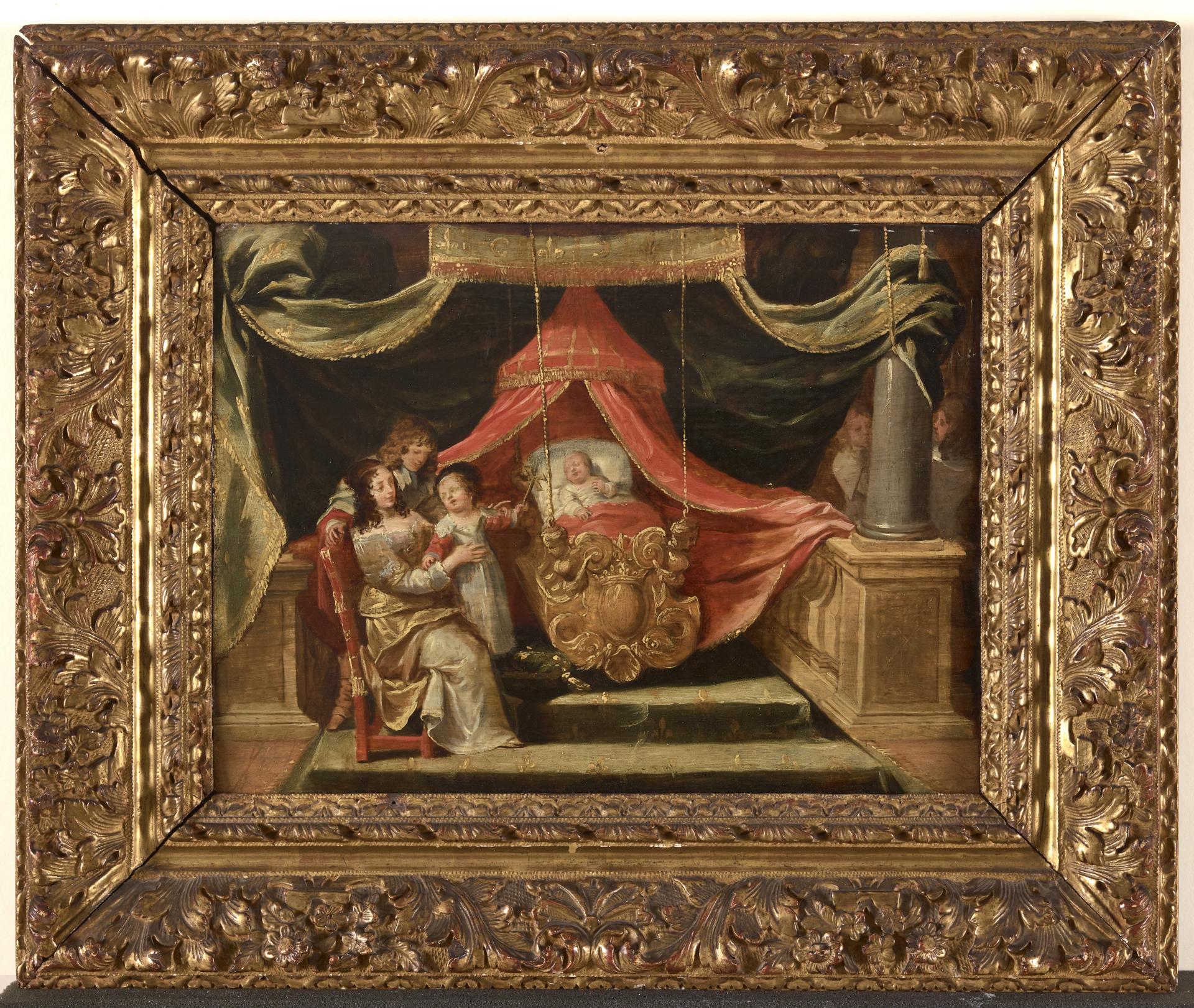
Cradle of the Duke of Anjou
© Château de Versailles, Dist. RMN / © Christophe Fouin
This intimate painting is valuable testimony to the beginnings of the career of Charles Le Brun before his stay in Italy. Louis XIII is leaning tenderly towards Anne of Austria who is holding the Dauphin. Born on the 21 September 1640 in the Château of Saint-Germain-en-Laye, two years after the long-awaited birth of Louis Dieudonné, it was now the turn of Philippe to occupy the royal cradle. The fleurs-de-lys that decorate both the carpet and the dais confirm that this is a royal scene. This small painting, with colours that are particularly vivid and precious (red and almond green, gilded effects), falls into a pictorial genre that was in fashion in Paris during the period 1630-1640.
Rococo vase with pink ribbons and flowers
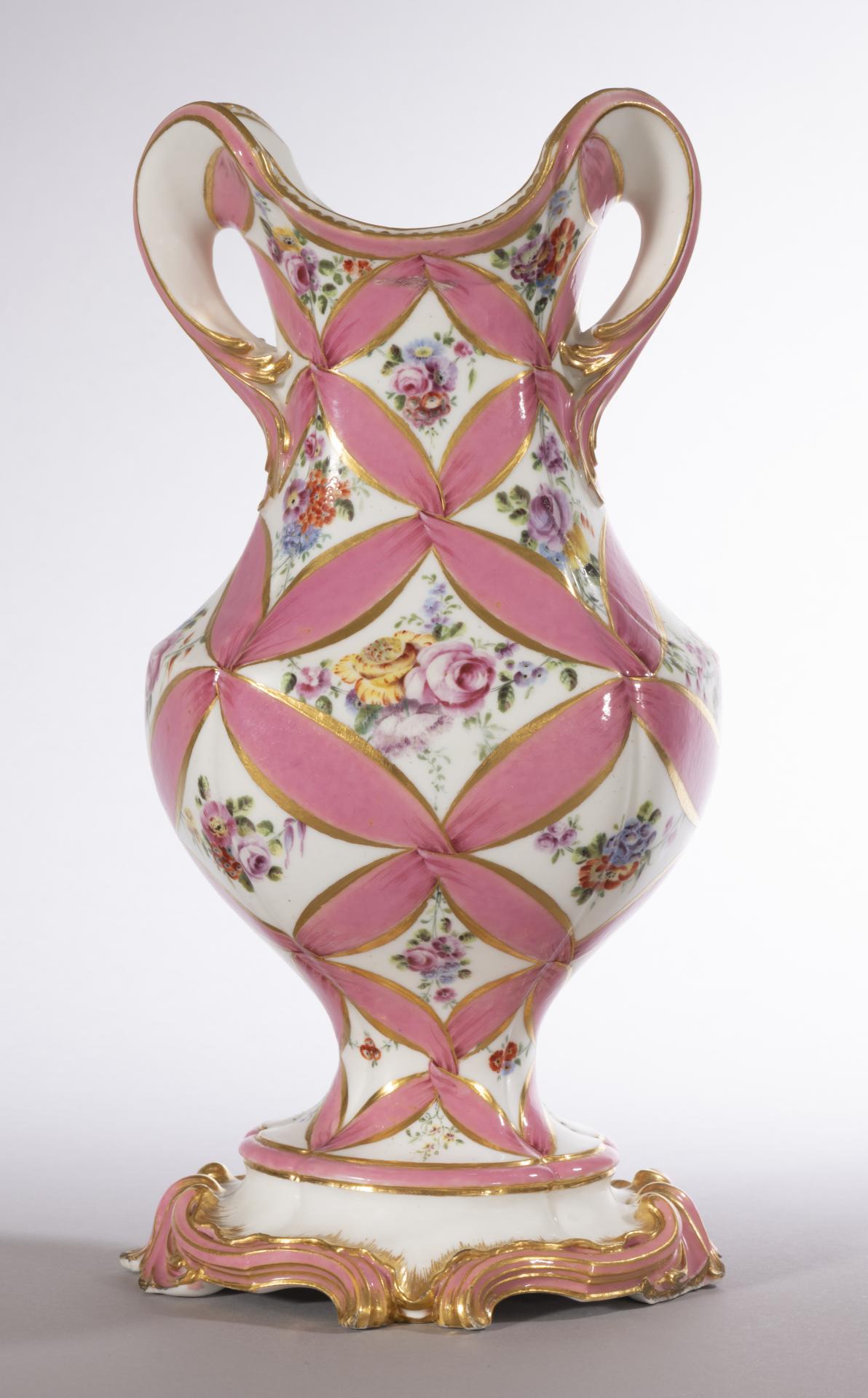
Rococo vase with pink ribbons and flowers
© Château de Versailles, Dist. RMN / © Christophe Fouin
This vase has the characteristics of the Rococo style that developed during the reign of Louis XV, with the motif on the base consisting of intertwined foliage and shells. This piece now stands alone, although it did have a companion piece when it was acquired by Louis XV at the annual sales at the Royal Sèvres porcelain Manufacture in Versailles, in December 1758. The pink background was a technique perfected at Sèvres in 1757, and several members of the royal family acquired such pieces. Louis XV probably intended this purchase for Marie Leszczyńska, as the Queen owned two vases with similar decoration.
Clark Gable and Stereoscopic photograph of the central section of the Palace

Clark Gable
© Château de Versailles, Dist. RMN / © Christophe Fouin
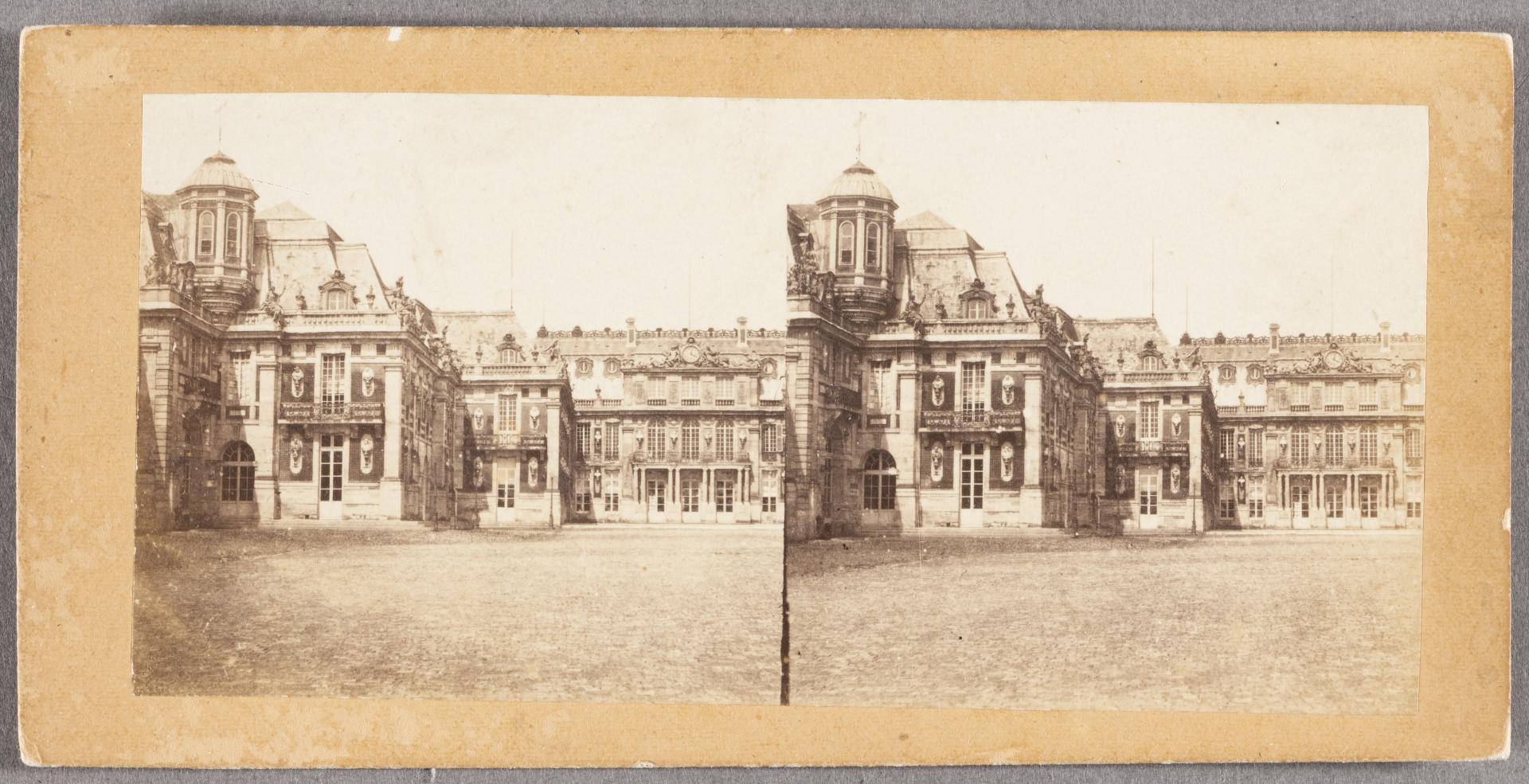
Stereoscopic photograph of the central section
© Château de Versailles, Dist. RMN / © Christophe Fouin
This batch of photographs, donated by Monsieur Alain Roger-Ravily, is of great interest as it tells us more about Versailles in modern times. The American actor Clark Gable is immortalised in front of Latona’s Parterre, testifying to the attraction of Versailles for celebrities from all over the world, just like Fred Astaire before him and John Travolta who came later. This donation also contains stereoscopic photographs on albumen paper, for example this view of the central section showing the Louis-Philippe, turret, which was destroyed in 1898.
Reparations made to the King on behalf of the Doge of Genoa in the Hall of Mirrors, 15 May 1685
Charles Gavard

Reparations made to the King on behalf of the Doge of Genoa
in the Hall of Mirrors; 15 May 1685
© Château de Versailles, Dist. RMN / © Christophe Fouin
This batch of 23 drawings that the Palace has acquired is part of a substantial set produced at the request of Louis-Philippe by around thirty artists for the Historic galleries of Versailles published by order of the King and dedicated to Her Majesty the Queen of the French (Galeries historiques de Versailles publiées par ordre du Roi et dédiées à S. M. la reine des Français) by Charles Gavard, published between 1837 and 1854. All these drawings, like Reparations made to the King on behalf of the Doge of Genoa in the Hall of Mirrors shown here, illustrate episodes in the reign of Louis XIV, between 1657 and 1691; seven are related to his family history and diplomatic events.
2017
Portrait of Tiberio Fiorilli as Scaramouche
Pietro Paolini, 1635-1681
December 2017
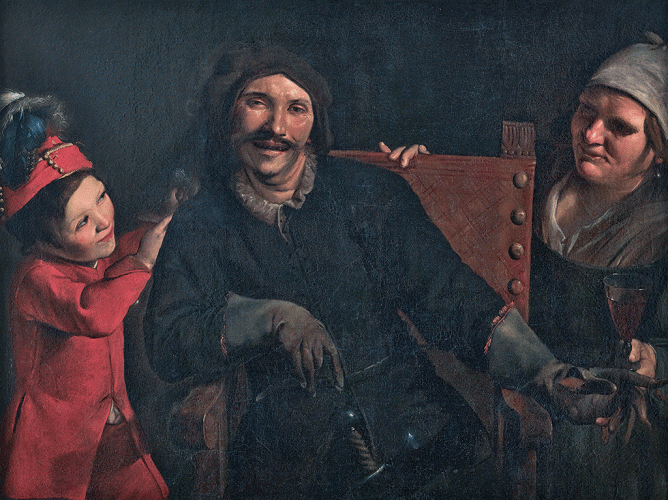
Tiberio Fiorilli known as Scaramouche
© Château de Versailles, Dist. RMN / © Christophe Fouin
Born in 1608 in Naples, Fiorilli became famous for his interpretation of the burlesque character Scaramouche on both the Italian and French stages for over half a century. The figure of Scaramouche (Scaramuccia) is based on Il Capitano, the Neapolitan troublemaker who was always keen to start a fight but would then slip away. Fiorilli kept the black costume, typical of Spanish noblemen, but made some changes to the character by removing his sword and mask. Fiorilli’s role in the history of 17th century theatre has only recently been appreciated and now this painting puts him in his rightful place. In fact, the Neapolitan actor is reputed to have been Molière’s teacher, and his contribution was key to the successful establishment of Italian theatre in France. This portrait of Scaramouche is therefore doubly interesting for Versailles, as it conjures up both a pictorial trend that was popular at that time and a character for whom Louis XIV personally had a deep affection.
The Allegory of Sculpture working on the bust of King Louis XIV
Baudrin Yvart, 1666
November 2017
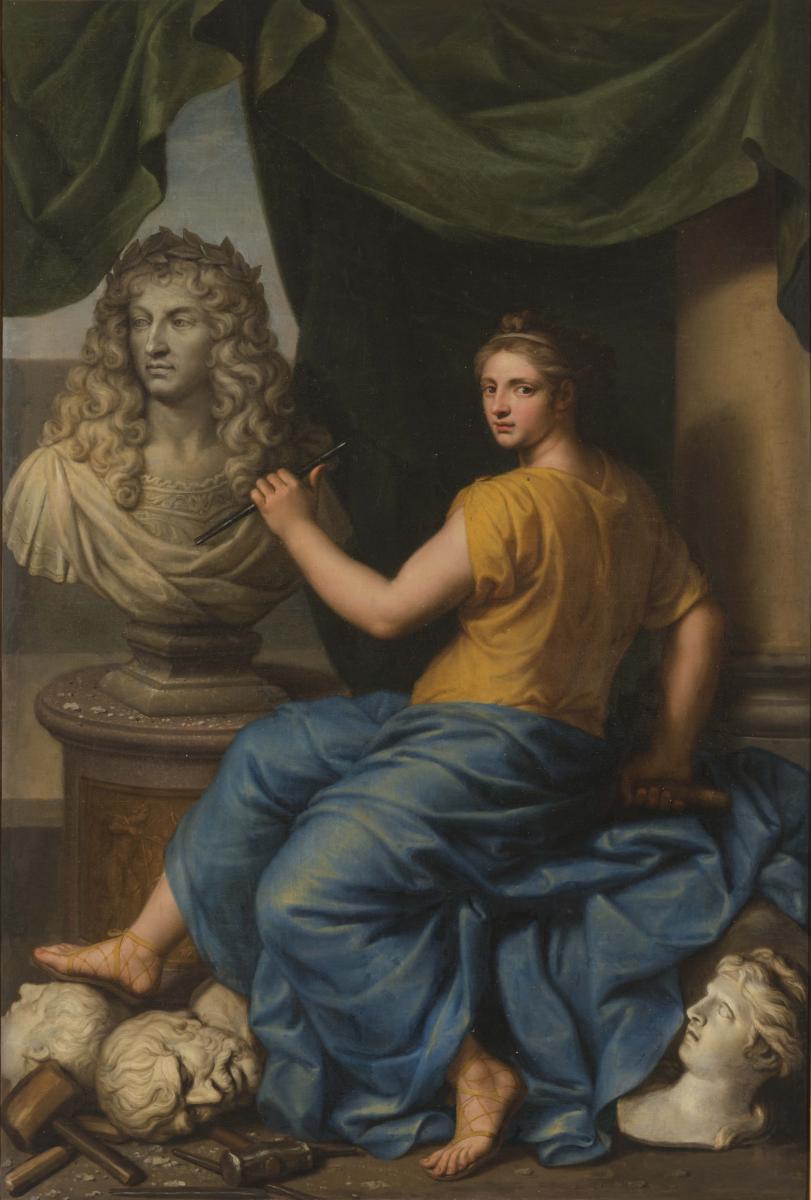
The Allegory of Sculpture working on the bust of King Louis XIV
© Château de Versailles, Dist. RMN / © Christophe Fouin
This work was submitted as the painter’s reception piece to the Académie Royale on 11 August 1663. It was only delivered in 1666, however, the year the Académie de France in Rome was founded by Colbert. Here we see the allegory of Sculpture working on the bust of Louis XIV, clothed as a Roman emperor. On the ground are three busts including one of the philosopher Seneca recalling the usual references to Antiquity for artists in the 17th century. The column and green drapery give the scene a very theatrical atmosphere. This is a very precious piece as it is the only painting that can definitely be attributed to Yvart, a loyal collaborator of Charles Le Brun. In addition, the classical theme of the allegory of the arts in the service of Louis XIV emphasises the magnificence of the King’s ambitions at the start of his reign.
Fred Astaire dances for the GIs at Versailles, 18 September 1944
Photograph published by ACME Newspictures, black and white print on photographic paper, press photo
Donated by Monsieur Didier Doré, November 2017

Fred Astaire dances for the GIs at Versailles, 18 September 1944
© Château de Versailles, Dist. RMN / © Christophe Fouin
This photo shows the actor and dancer Fred Astaire dancing for American troops in front of the Palace of Versailles façade on the garden side, at the Liberation.
Fire-dogs for Madame Elisabeth at Versailles
Claude-Jean Pitoin, 1778, gilded bronze
Purchased through the patronage of the Society of the Friends of Versailles (legacy of Madame Simone Bataille), in September 2017
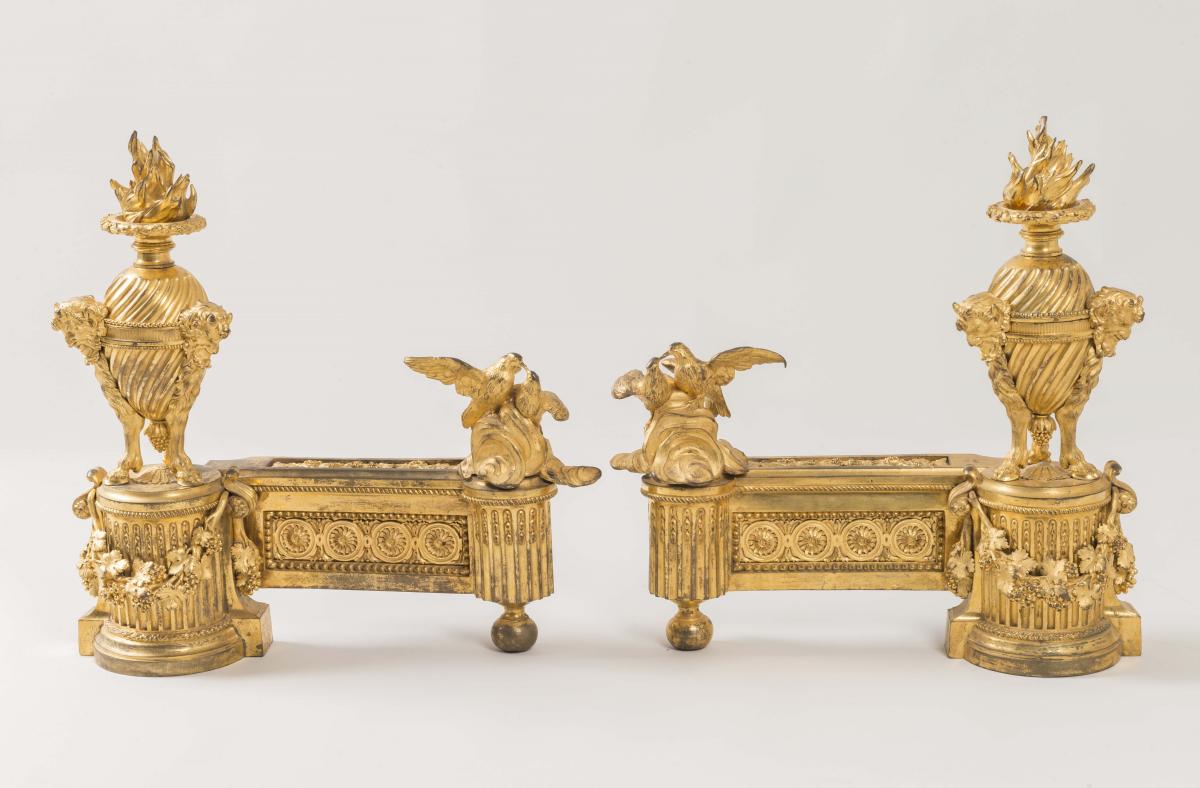
Fire-dogs for Madame Elisabeth at Versailles
© Château de Versailles, Dist. RMN / © Christophe Fouin
This pair of chased and gilded bronze fire-dogs was delivered in 1778 for the apartment of Madame Elisabeth, sister of Louis XVI, by the bronzeworker Claude-Jean Pitoin, son of Quentin-Claude Pitoin. Father and son were both chasers at the Furniture Store-House. Note the extremely high quality of the chasing on these fire-dogs and the application of different shades of gold which play with the light and create effects of relief. This pair was subsequently moved to Fontainebleau before becoming part of the Greffulhe family’s collection. It is a perfect illustration of the royal family’s taste in the 1780s for interior furnishings.
Tea and chocolate set belonging to Marie Leszczynska
Meissen porcelain, 1737
April 2017
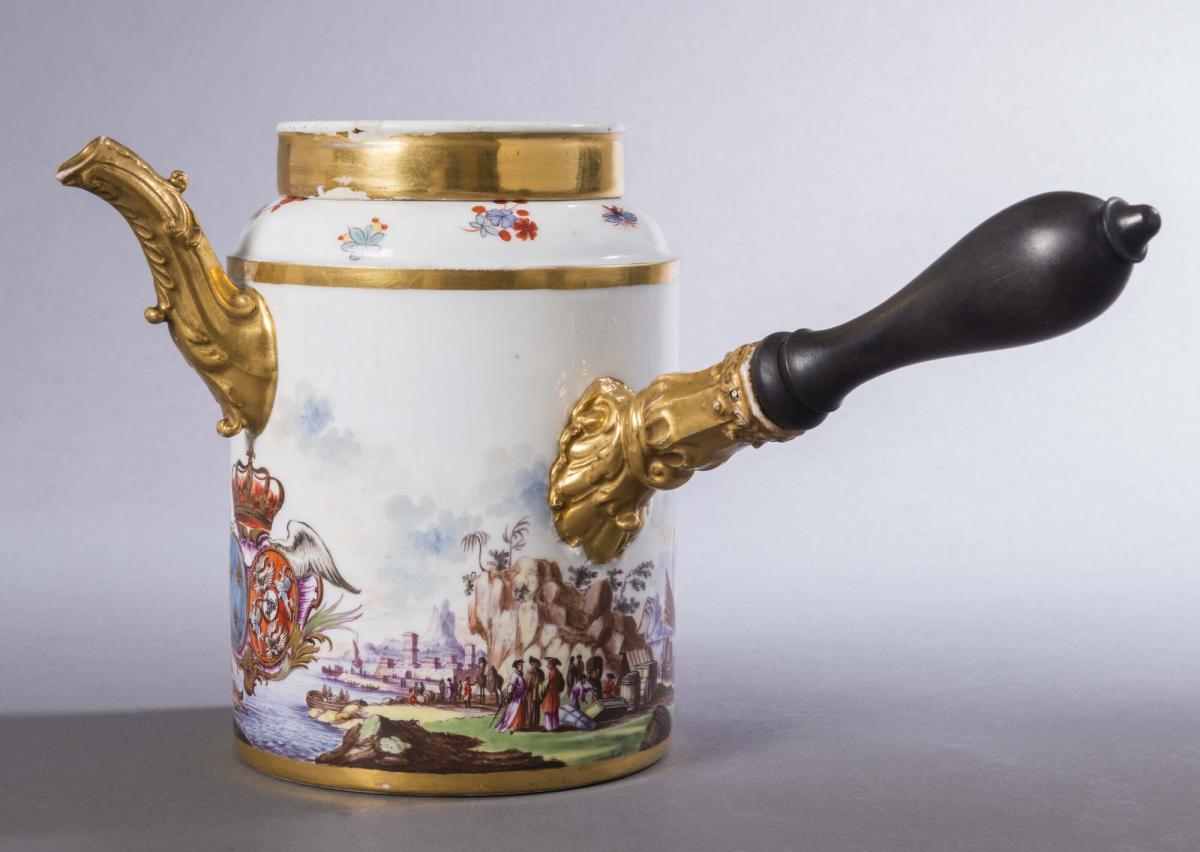
Tea and chocolate set belonging to Marie Leszczynska
© Château de Versailles, Dist. RMN / © Christophe Fouin
The Palace of Versailles was able to acquire eight pieces from a tea and chocolate service (nécessaire) produced by the prestigious porcelain manufacturers, Meissen, in Germany, and given to Marie Leszczynska by Auguste III, King of Poland, in March 1737. The purpose behind this gift was to ease diplomatic tensions between France and Poland after the War of the Polish Succession. All these pieces bear arms of allegiance to the Queen (arms of France and Poland) and are adorned with abundant gilding and various forms of decoration: fantasy chinoiserie, military and maritime scenes. These pieces can now join the large rinsing bowl acquired by Versailles in 2014. However, this is still only a small part of the entire service, which consisted originally of fifty-six pieces.
2016
The Orangery at the Palace of Versailles
Hubert Robert, 1777-1798, oil on canvas
September 2016
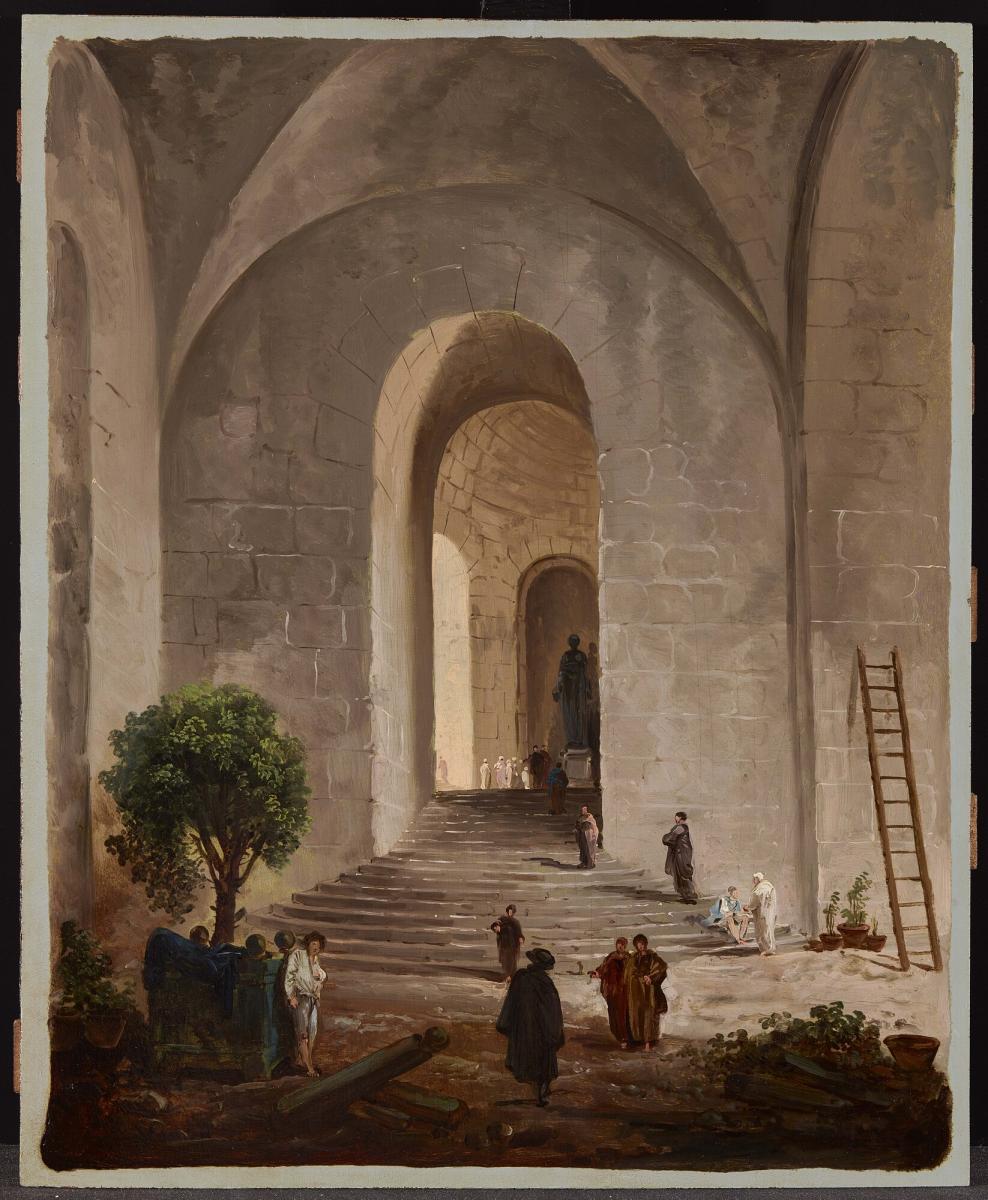
The Orangery at the Palace of Versailles
© Château de Versailles, Dist. RMN / © Christophe Fouin
In 1777, Hubert Robert delivered several views of the Palace and the Park of Versailles which were both documentary and poetic, and this View of the Orangery of the Palace of Versailles, oil on a small format panel, is one of this series. In the foreground, the scene is set in the south gallery of the Orangery, then the artist shows the start of the great transversal central gallery. At the top of the steps, where the two galleries cross, is the statue of Isis, part of Louis XIV's collection, and installed in the rotunda of the Orangery in 1694. On its pedestal it looms extremely large. The statue’s presence means that the work can be dated to pre-1798, the year it was removed from the rotunda. Hubert Robert is one of the painters who has really understood the poetry of the spaces at Versailles. In around 1783, he also contributed to creating the Queen’s Hamlet, built by the architects Mique and Caraman.
Charles Gravier, Count of Vergennes, minister
Antoine-François Callet, 1780, oil on canvas
June 2016

Charles Gravier, Count of Vergennes, minister
© Château de Versailles, Dist. RMN / © Christophe Fouin
This portrait of Vergennes (1719-1787), presented to the 1781 Salon, was commissioned from Callet, Louis XVI's portrait artist, by the Ministry of Foreign Affairs. He is adorned with the badge and the sky blue sash of the Order of the Holy Spirit, wearing a cream-coloured waistcoat embroidered with cornflowers, and he holds a note addressed “To the King”, thus showing his allegiance to the Sovereign. The minister’s file cabinet is topped by a medallion bearing the profile of Louis XVI supported by three spirits. In accordance with established practice for ministers, the model appears surrounded by his work tools: pen and inkstand, and memoirs. Vergennes is famous for having played a leading role in American Independence, having signed the first “Franco-American Treaty of Amity and Commerce” with Franklin on 6 February 1778.
Menus served to the King by Héliot, Equerry in Ordinary in Madame la Dauphine’s kitchen staff
1745-1756, manuscript
Donated by theSociety of the Friends of Versailles, in June 2016
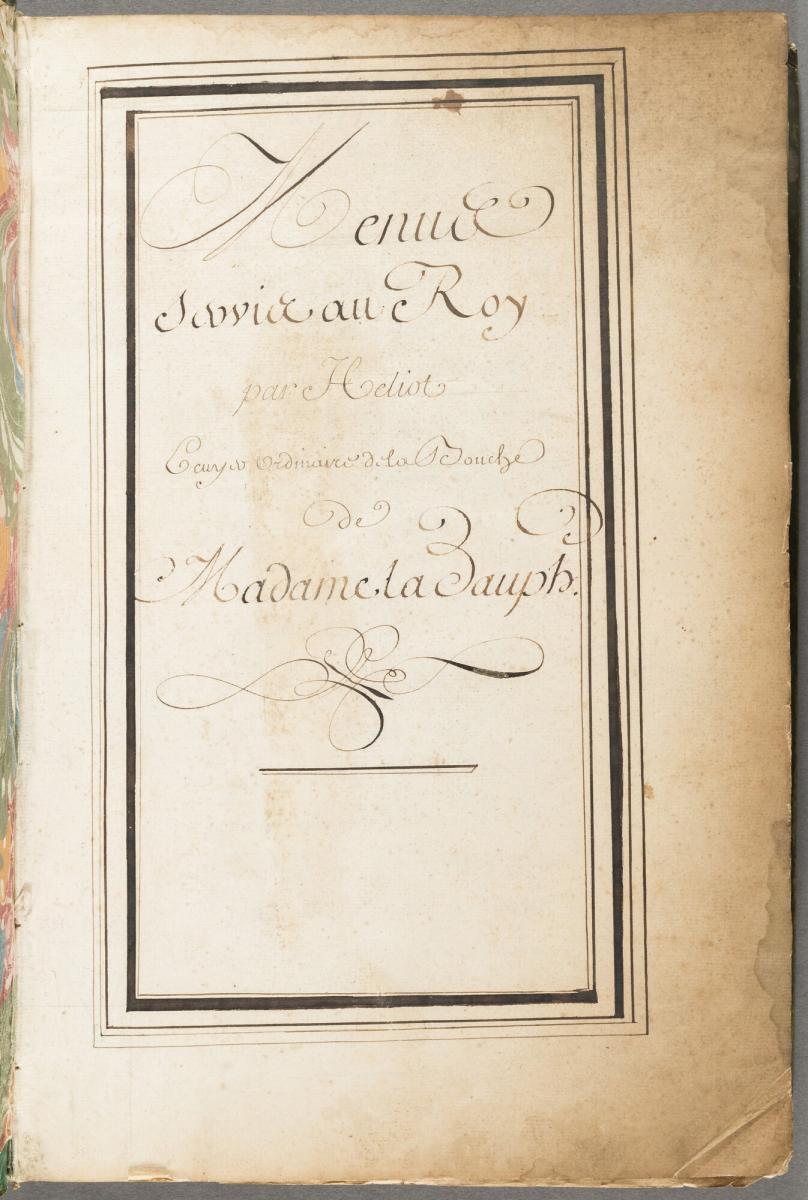
Menus served to the King by Héliot, Equerry in Ordinary in Madame la Dauphine’s kitchen staff
© Château de Versailles, Dist. RMN / © Christophe Fouin
This is a collection of the 138 menus served to King Louis XV between 8 September 1745 and 13 May 1756 at Choisy, Trianon and La Muette. Each menu is presented separately; they describe suppers, dinners and Médianos served to the King, with the date. It was perhaps from this collection that Carême took the five menus he mentioned to illustrate culinary changes during the reign of Louis XV. It is difficult to determine the exact status of this document, as it may simply be a notebook for Héliot’s sole use.
General de Gaulle visiting Versailles, 28 August 1963
Donated by Monsieur Roger-Ravily: Photographies Associated Press, black and white photograph April 2016

General de Gaulle visiting Versailles on 28 August 1963
© Château de Versailles, Dist. RMN / © Christophe Fouin
This photo sets the scene for General de Gaulle’s visit to Versailles accompanied by his Minister for Cultural Affairs, André Malraux. By taking the decision in 1962 to restore the Grand Trianon, de Gaulle confirmed Versailles’ role as the national palace. He and Malraux shared a certain idea of Versailles, which the Minister described as an “exemplary place in western civilisation”. In doing this, the general made Versailles an iconic place for France and for the country’s power, where important figures like Presidents Kennedy and Nixon were received.
Invitation to the formal ball given for the marriage of the Dauphin
Jean-Michel Moreau the Younger, 1770, pen and ink on vellum
January 2016
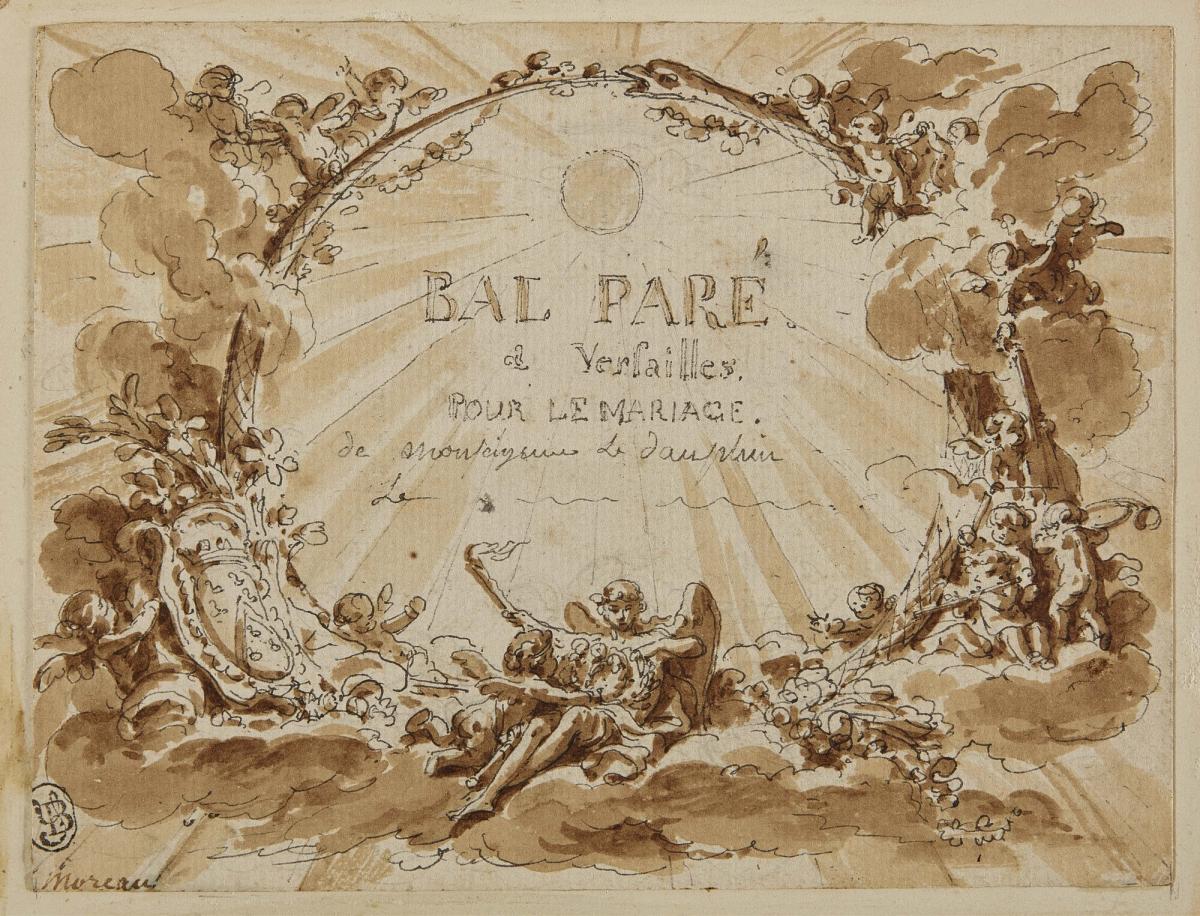
Invitation to the formal ball for the marriage of the Dauphin
© Château de Versailles, Dist. RMN / © Christophe Fouin
Appointed draughtsman of the Menus-Plaisirs in 1770 then Engraver for the King’s Cabinet in 1778, Moreau the Younger produced and engraved drawings for the major events in the reigns of Louis XV then Louis XVI. It was almost certainly soon after his arrival as draughtsman of the Menus-Plaisirs in 1770 that he produced this preparatory drawing for the invitation cards to the Formal Ball held to mark the marriage of the Dauphin and Archduchess Marie-Antoinette on May 16th, 1770 in the newly built Royal Opera House. This drawing follows the traditional style of invitation cards inherited from Cochin: a frame of flowers and cherubs playing musical instruments, the arms of the Premier Gentilhomme de la Chambre du Roi, who was in charge of festivities. This is an invaluable insight into the work of the Menus-Plaisirs, a department of the King’s household responsible for “the King’s pleasures”.
2015
Louis XIV’s bureau by Alexandre-Jean Oppenordt (1639-1715)
November 2015

Louis XIV’s bureau
© Château de Versailles, Dist. RMN / © Christophe Fouin
After an absence of 264 years, King Louis XIV's bureau has returned to the Palace of Versailles. Listed as a National Treasure, it was acquired by the Établissement public du château, du musée et du domaine national de Versailles in November 2015.
This bureau with a folding top (bureau brisé), delivered in 1685, is made of oak, with ebony and Rio rosewood veneer. The King’s monogram is omnipresent in the brass and engraved red tortoiseshell marquetry. The bureau was one of a pair commissioned by the Royal Estates Buildings for the room where the King used to write, a private chamber behind the Hall of Mirrors located where King Louis XVI's bathroom now stands. Its counterpart is currently held by the Metropolitan Museum of New York.
There are a number of documents that reveal the names of the craftsmen who worked on this piece, in particular Alexandre-Jean Oppenordt, Cabinetmaker in Ordinary to the King. The exuberance of the arabesques on the top are very reminiscent of compositions by the designer of the King’s Chambers, Jean I Bérain. Considered old-fashioned by 1751, it was sold and reappeared in England in the 19th century in the collections of Baron Ferdinand James Anselm de Rothschild (1839-1898), where it was transformed into a slant-top desk.
The acquisition of this bureau is thanks mainly to the work of the Society of the Friends of Versailles and AXA. This is one of the very rare pieces of cabinetry created for Louis XIV, and especially so since it was made for Versailles. It enhances the museum’s collections immeasurably. After restoration, it will be displayed in the Hall of Plenty close to the Medal Cabinet.
Before it is shown to the public, this famous piece of furniture requires some restoration. It is envisaged that it should be returned to its original function with a folding top. A scientific committee has been set up to examine this proposal.
Portrait of Christoph Willibald, Chevalier von Gluck (1714-1787)
Signed and dated at the bottom left J.S.Duplessis/pinx parisis 1775
Oil on canvas - H.101; w. 85 cm
Bought at public auction using the right of pre-emption, lot no.46, Sotheby's Paris sale on 17 June 2015
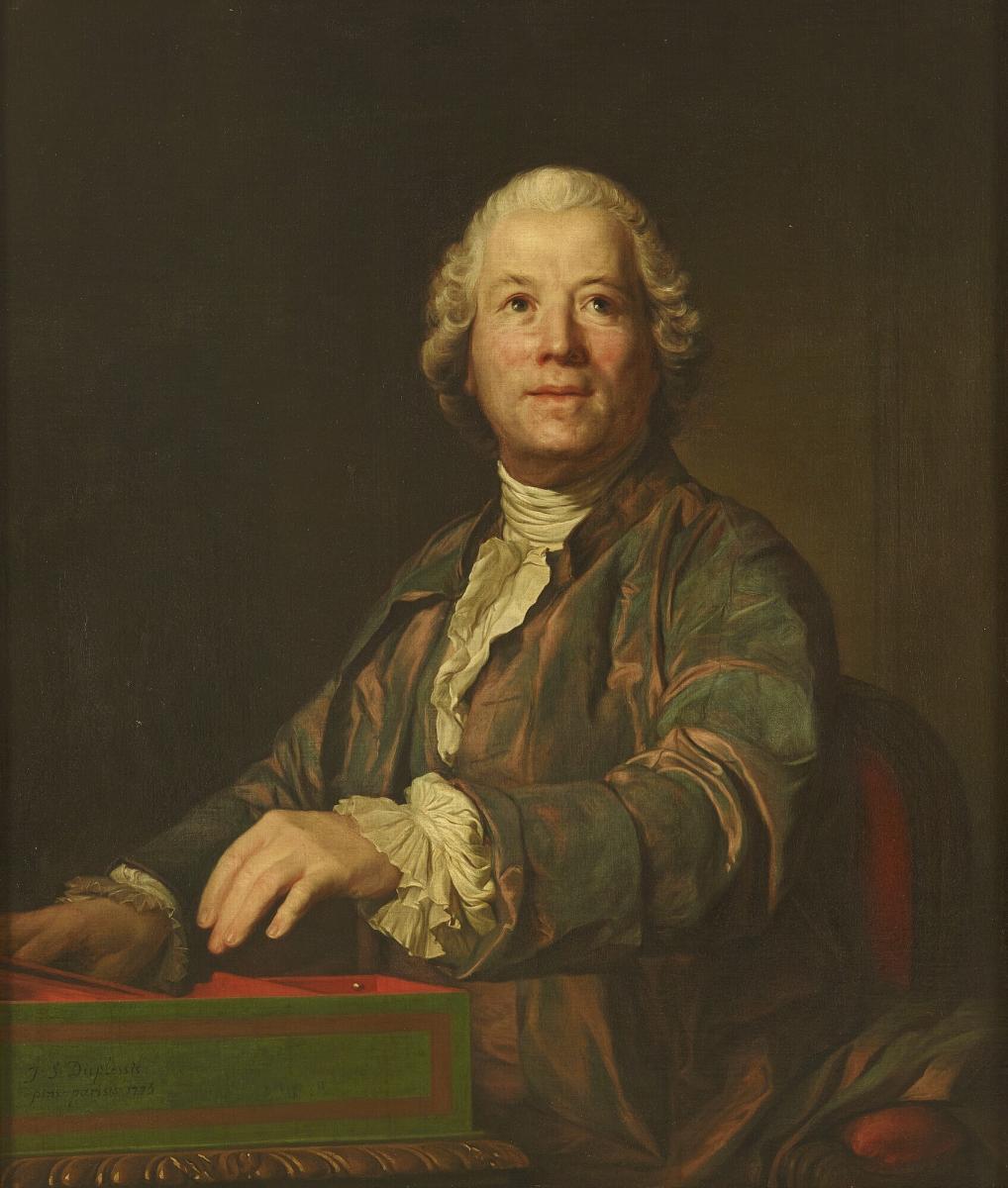
Portrait of Christoph Willibald, Chevalier von Gluck (1714-1787)
© Château de Versailles, Dist. RMN / © Christophe Fouin
The Palace of Versailles acquired this portrait of the German musician Gluck at auction. In all likelihood, this is a signed copy of the work by Duplessis shown at the Salon in 1775 and currently held by the Kunsthistorisches Museum, Vienna.
The musician was Marie-Antoinette’s singing teacher in Vienna but he also had a Europe-wide career. In 1774-1775, he enjoyed unprecedented fame. It was during this period that the sculptor Jean-Antoine Houdon created an effigy of the musician and Duplessis painted his portrait, showing him seated with his hands on his harpsichord, his face turned upwards gazing into the distance.
This portrait of Gluck will be presented as part of the new tour route devoted to Marie-Antoinette in the Captain of the Guard’s Apartment, alongside images of Grétry and Paisiello painted by Madame Vigée Le Brun, which complete the gallery of portraits of the “Queen’s artists”.
Tureen stand from the service "with the frieze rich in colours and rich in gold" belonging to Marie-Antoinette
Royal Sèvres porcelain Manufacture
1784 – Soft-paste porcelain - W.42.5 cm - In blue: LL interlaced; date-letter gg (1784); Y (for Edmé-François Bouillat)
Bought at public auction using the right of pre-emption, lot no. 227, AGUTTES sale on 28 May 2015
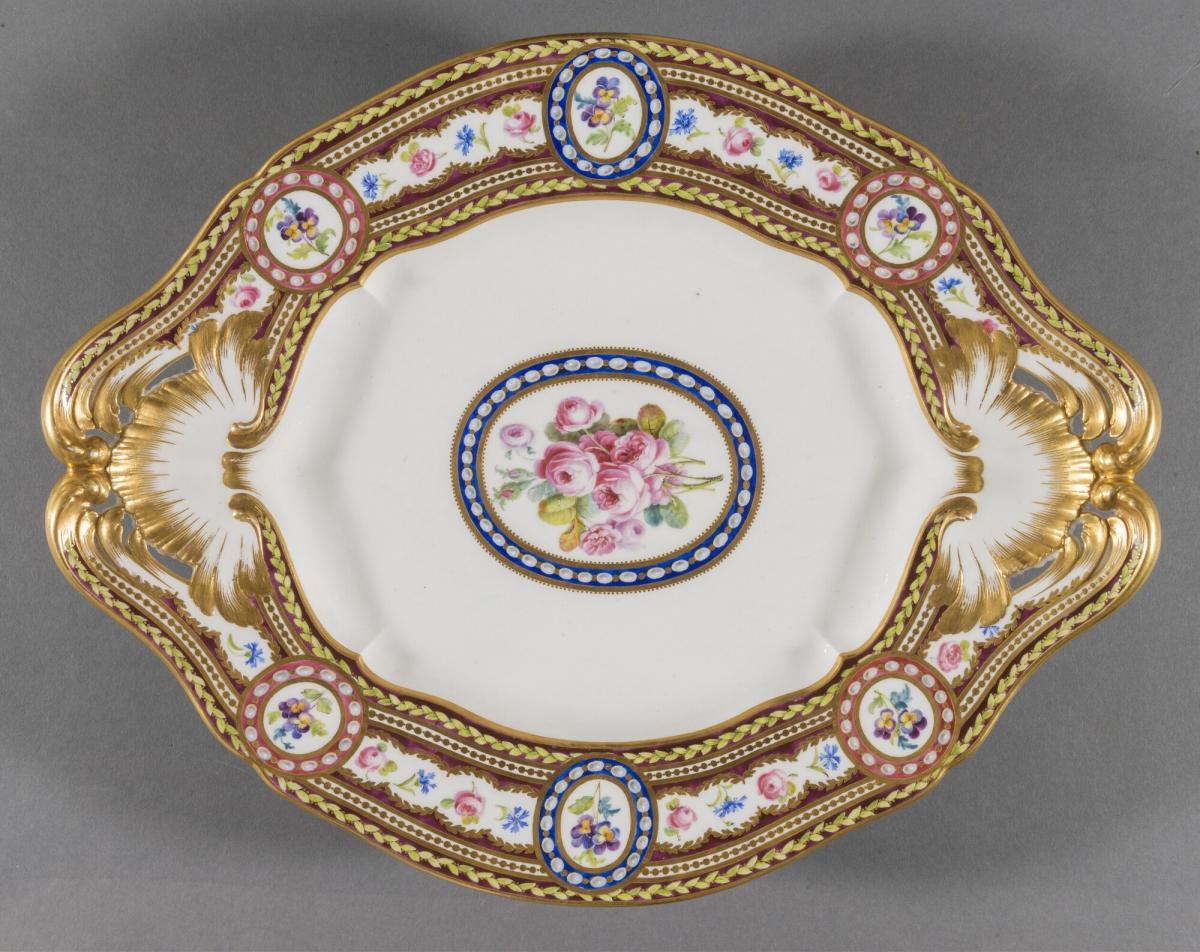
Tureen stand from the service “with the frieze rich in colours and rich in gold” belonging to Queen Marie-Antoinette
© Château de Versailles, Dist. RMN / © Christophe Fouin
Since 1900, the Palace of Versailles has regularly acquired pieces from the service “with the frieze rich in colours and rich in gold” commissioned at the beginning of 1784 by Queen Marie-Antoinette. With this recent acquisition, the collection now has 53 pieces from this service, which are displayed in the corner cupboards in the Queen’s private chambers on the second floor of the Palace.
This stand is approximately the same size as a ragout tureen; in its central medallion it has a bouquet of roses in full bloom surrounded by a frieze of pearls on a blue background. The ends are contoured and gilded to show off to advantage the frieze of roses and cornflowers against a wine-coloured background framed by gold pearls and garlands of laurel. This is only interrupted by the cleverly alternating cartouches decorated with pansies.
The Founding of the Hôtel des Invalides in 1674
Pierre Dulin (Paris, 1669-1748)
Oil on canvas
H. 48 cm; W.74 cm
Bought at public auction using the right of pre-emption, lot no.45, RIEUNIER-de MUIZON, 30 March 2015
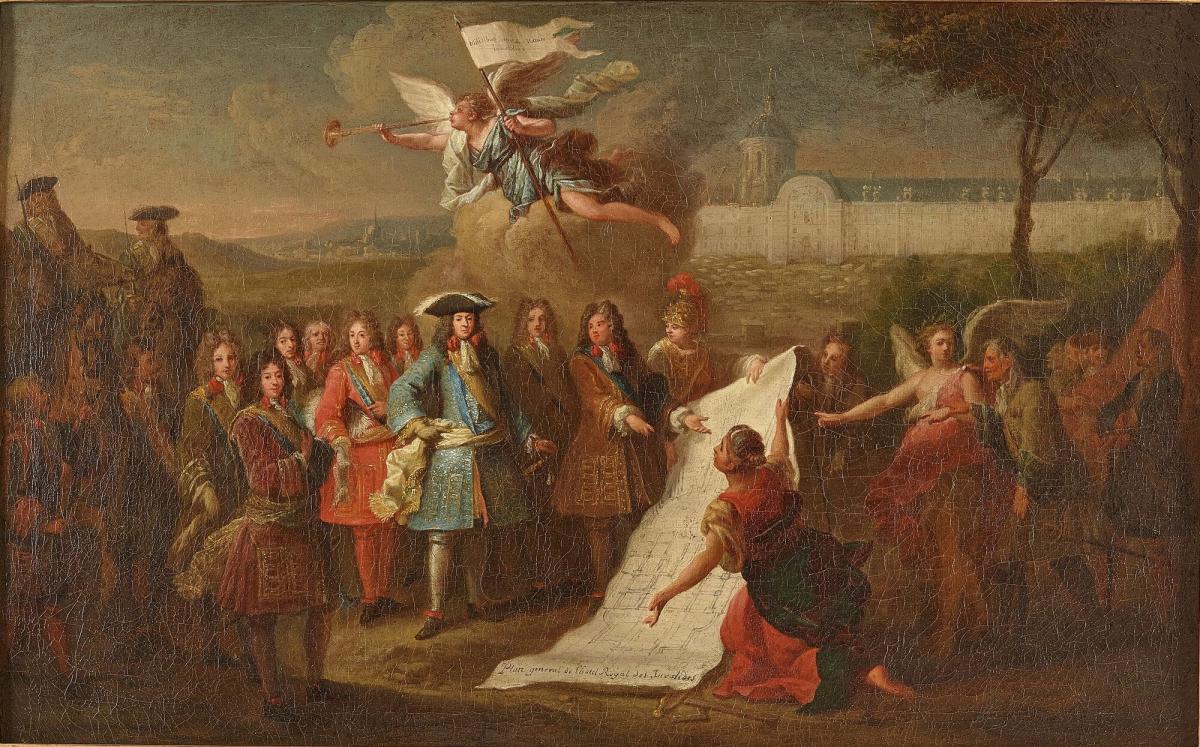
The Founding of the Hôtel des Invalides in 1674
© Château de Versailles, Dist. RMN / © Christophe Fouin
This painting by Pierre Dulin is a design for the tapestry cartoon of the Founding of the Hôtel des Invalides in 1674, commissioned in 1710 to complete the series of tapestries depicting the History of the King.
The episode shown here happened more than thirty years earlier: in 1670, Louis XIV decided to build the Hôtel des Invalides. This institution would house and care for sick soldiers and veterans. Here, Dulin depicts events that happened at different points in time, such as the founding and approval of the plans (1670-1674), the construction of the Hôtel (1671-1678) and the completion of the dome (1706). At the centre of the painting we see the figure of Louvois, Minister for War, accompanied by Minerva (goddess of Wisdom and War) and by Architecture, who is kneeling. The Minister shows the King the plan of the buildings, which are under construction in the background. Among those present, we can recognise the building’s two architects, Libéral Bruant and Jules Hardouin-Mansart, the King and Louvois. On the right, Glory leads a group of infirm soldiers to the King. In the sky, Fame, holding a banner, sounds her trumpet.
This design for the Founding of the Hôtel des Invalides will be added to the set of preparatory designs for tapestries already held by the Palace. It will be displayed in the Louis XIV rooms alongside those by François Marot and Claude-Guillaume Hallé depicting The first promotion of the Knights of Saint Louis on 10 May 1693 (MV 2149) and Reparations made by the Doge of Genoa on 15 May 1685 (MV 2107).
Glass cooler from the "pearls and cornflowers" service
Royal Sèvres porcelain Manufacture - 1781
Soft-paste porcelain - H.10.5 cm – Blue painted marks: mark of the Manufacture with two interlaced Ls; date-letters DD for 1781
Bought at public auction using the right of pre-emption, lot no.44, SVV PESCHETEAU-BADIN, 16 March 2015 with the participation of the Forum Connaissance de Versailles via the Society of the Friends of Versailles
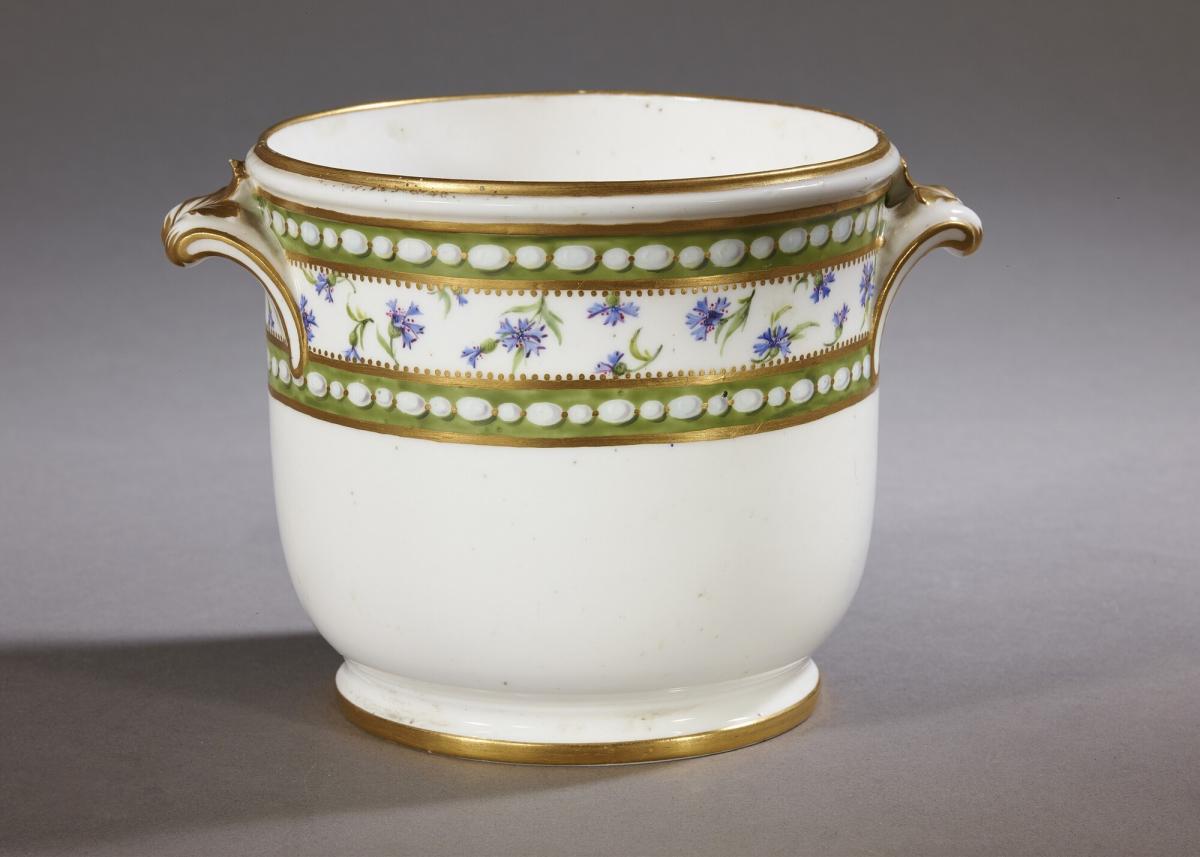
Glass cooler from the “pearls and cornflowers” service
© Château de Versailles, Dist. RMN / © Christophe Fouin
Commissioned in July 1781 for the Petit Trianon, the service with “pearls and cornflowers” was delivered to Queen Marie-Antoinette on 2 January 1782 for a total sum of 12,420 livres.
With this new acquisition, the collections at the Palace of Versailles now have thirteen pieces from this service, which originally consisted of 295 pieces.
Portrait of Marie-Thérèse of Savoy, Countess of Artois
Work purchased thanks to the patronage of Fondation de Luxembourg, acting on behalf of Fondation La Marck, February 2015
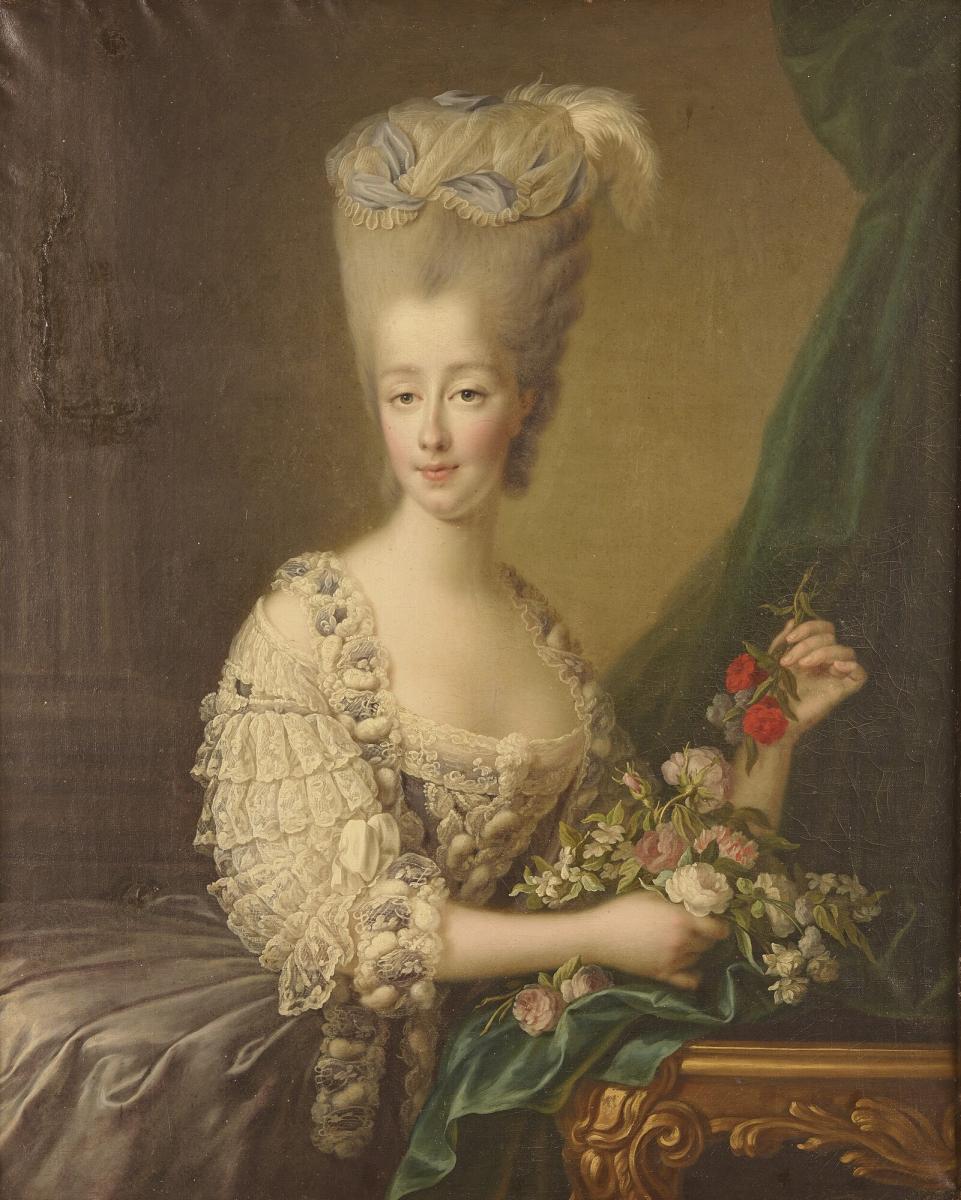
Portrait of Marie-Thérèse of Savoy, Countess of Artois
© Château de Versailles, Dist. RMN / © Christophe Fouin
At the Sotheby’s auction in Paris on 11/2/2015, as part of the dispersion of the collections of Château Réveillon (Burgundy), property of the Dukes of Mortemart, the Palace of Versailles acquired a Portrait of the Countess of Artois (1756-1805), dated circa 1775, the work of François-Hubert Drouais (1727-1775).
The purchase of this oil painting on canvas is a significant addition to our collection of 18th century paintings. It completes the suite of portraits of the royal family painted by this artist after his appointment as First Painter to the Count of Provence in 1771: the Count of Provence, the Countess of Provence, Madame Clotilde, Louis XV, the Count of Clermont.
The Palace already had a portrait of the Countess by Gautier-Dagoty, another by Leclercq, and a pastel by Boze showing her circa 1785, but it had no image of the quality of this work by Drouais.
The marriage of Princess Marie-Thérèse of Savoy (1756-1805), daughter of Victor-Amédée III of Sardinia, to Charles-Philippe, Count of Artois, was celebrated at Versailles on 15 November 1773.
Allegorical portrait of Madame Louise
February 2015
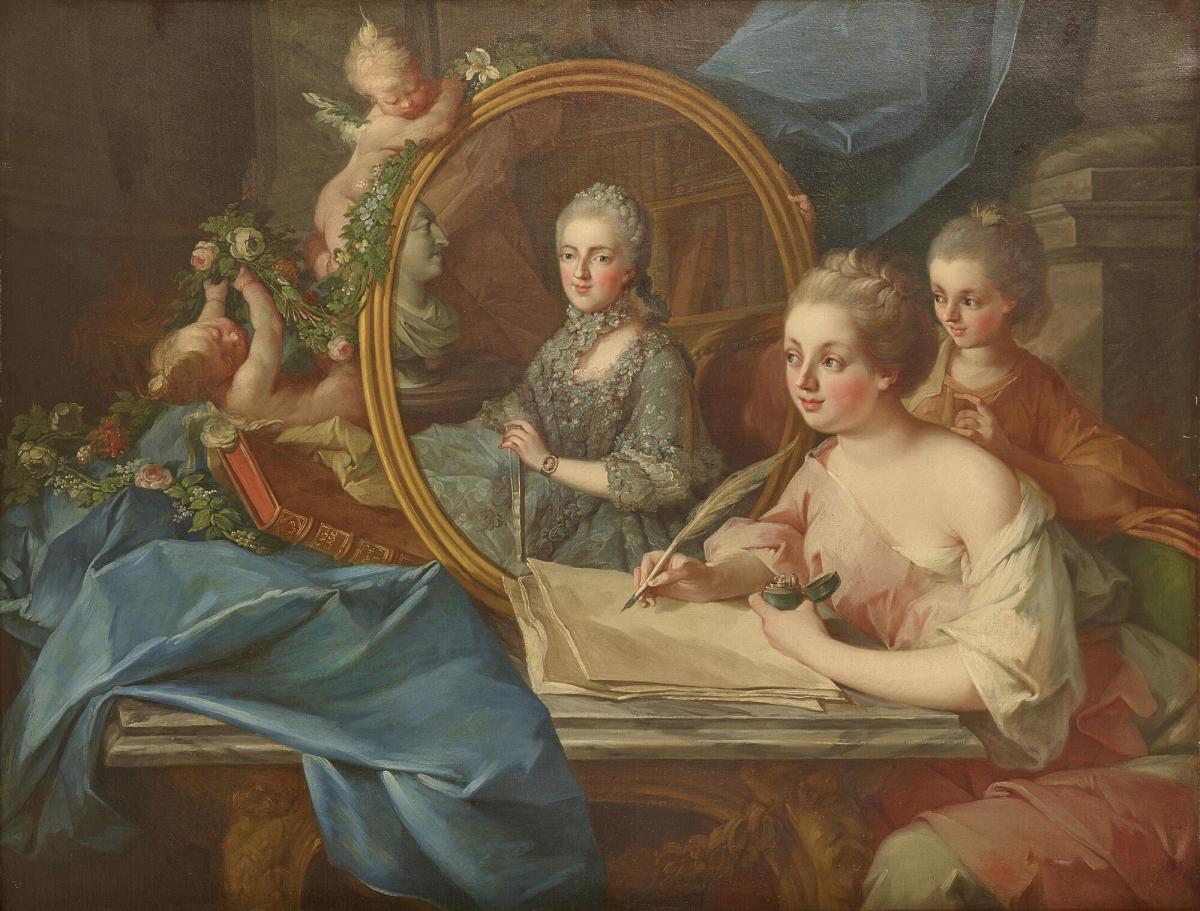
Allegorical portrait of Madame Louise
© Château de Versailles, Dist. RMN / © Christophe Fouin
At the auction organised at Eric Pillon’s auction house in Versailles on 08/02/2015, the Palace of Versailles acquired this Allegorical portrait of Madame Louise, daughter of Louis XV.
The princess is shown in court dress, before she entered the Carmelite convent in 1770. This type of portrait of a royal princess in an allegorical style is a valuable addition to the Versailles collection, an iconography that is rare in the national collections.
2014
Commode of Choisy
Antoine-Robert Gaudreaus

Commode of Choisy, 1744, Oak frame, exotic wood veneer, Japanese lacquer, European varnish, chased and gilded bronze, Rance marble
© Château de Versailles, Dist. RMN / © Christophe Fouin
In 1744, Gaudreaus received a large order for five pieces of furniture for the king's apartment at the Château de Choisy: a chest of drawers, a desk, two corner cupboards and a console. This chest of drawers recalls the design and structure of the one delivered by the cabinetmaker in 1739 for Louis XV's bedroom in Versailles, now in the Wallace Collection in London. This work entered the collections of Versailles thanks to a donation from the Edmond J. Safra Philanthropic Foundation, represented by Madam Lily Safra. It is currently exhibited in Madam Victoire's bedroom.
Wall lights
Anonymous Paris 18th century

Pair of three branches light arms, 1752-1753, cast and chased gilt bronze
© Château de Versailles, Dist. RMN / © Christophe Fouin
These wall lights, acquired in Paris around 1752-1753 by Madam Infante, Duchess of Parma, for her castle of Colorno in Italy, are composed of rocaille motifs and acanthus scrolls; the shaft is surmounted by a bouquet of flowers with periwinkle and sunflower (or queen daisy). Acquired in public auction, these works are currently exhibited in the Dauphine's bedroom.
Compotier
Manufacture of Vincennes

Square fruit bowl, 1753-1754, soft-paste porcelain
© Château de Versailles, Dist. RMN / © Christophe Fouin
This compotier is part of the service "à fond bleu céleste" of Louis XV, ordered in 1751 and delivered by the manufacture of Vincennes from 1753 to 1755, which included 1749 pieces, including 1266 pieces of biscuit (unglazed porcelain) for the table decoration. For this service, the chemist Jean Hellot developed a new turquoise blue background color called "celestial blue" in homage to the Empire of China. The Louis XV service was used by the royal family until the end of the Ancien Régime.
Pastel Vaillant
Wallerant Vaillant
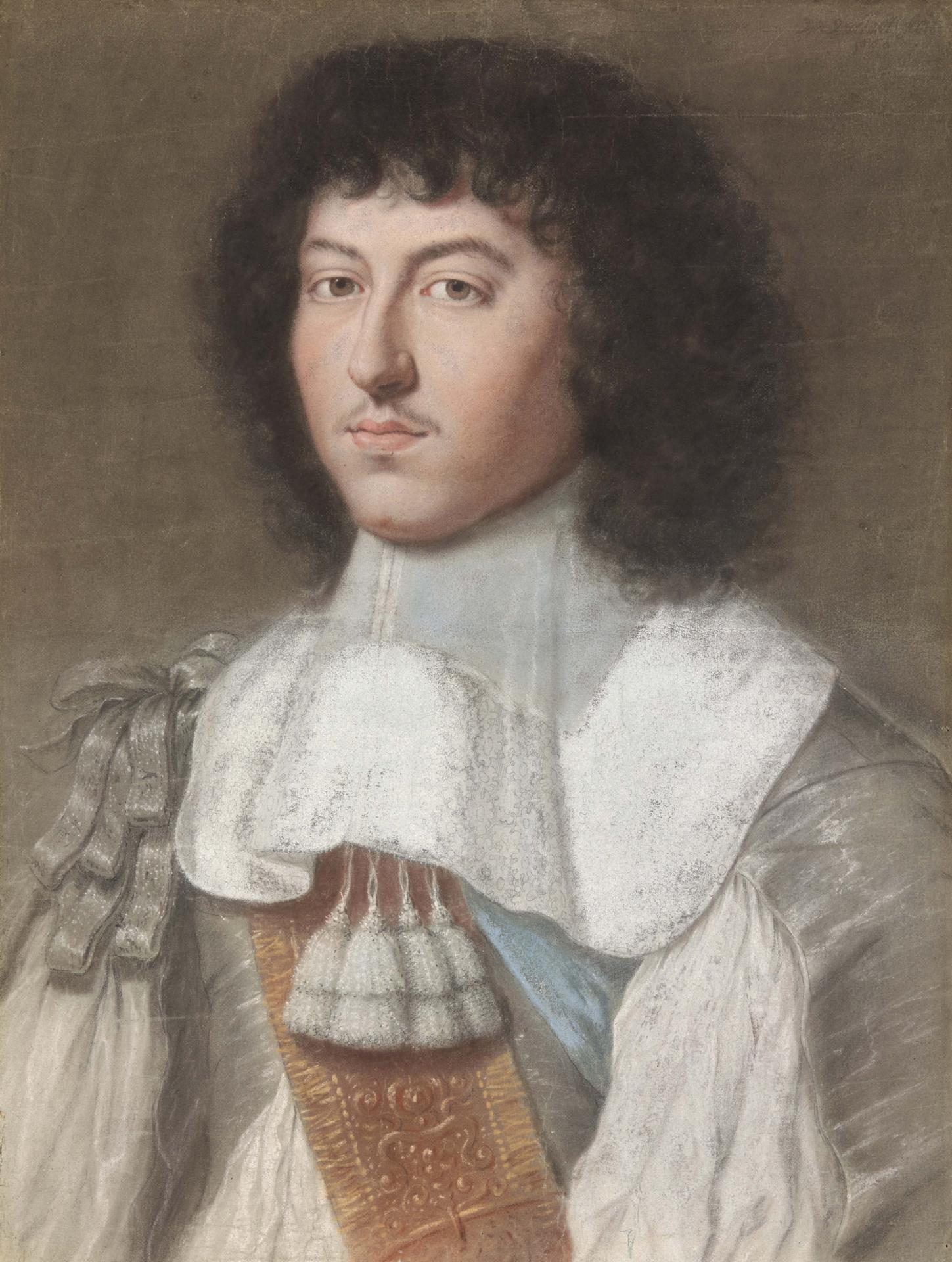
Louis XIV, 1660, pastel
© Château de Versailles, Dist. RMN / © Christophe Fouin
This little-known portrait of Louis XIV, executed from the model in 1660 by the time of his marriage, features the young king without artifice. It is part of a series of portraits of the royal circle commissioned by Anne of Austria, the King's mother. Inspired by the works of Robert Nanteuil, Vaillant's pastels are the first portraits of this type, in a very wide range of colors. This work was acquired at public auction.
Stereoscopic views
Anonymous France 19th century
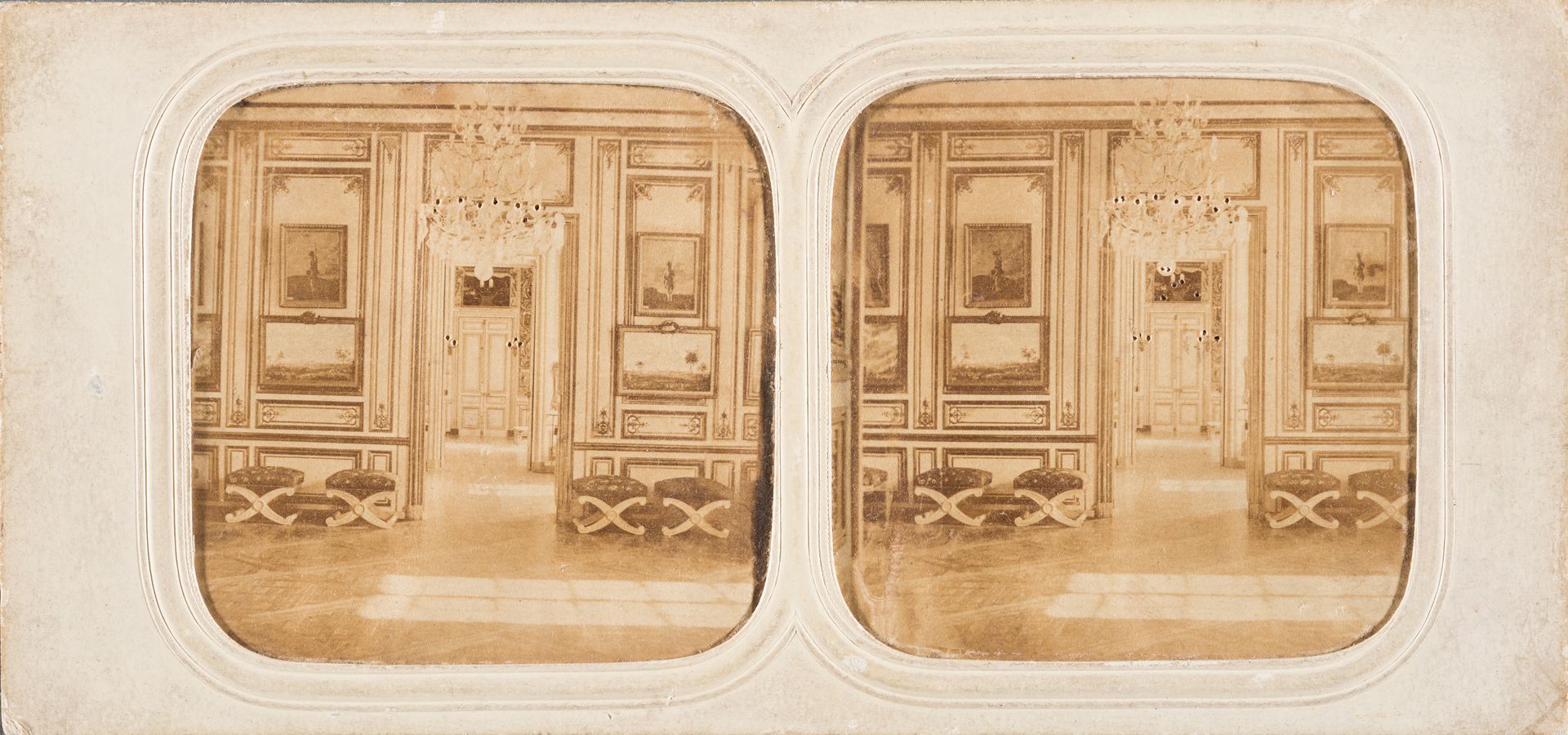
First Salon of the Gouaches of Louis XV [Salon des Jeux de Louis XVI], ca. 1860-1870, stereoscopic view
© Château de Versailles, Dist. RMN / © Christophe Fouin
Twenty-seven of the original stereoscopic views from the gift of Mr. Roger-Ravily are views of the king's private apartments as they were during the Second Empire. This view shows the first salon, known as the "Salon des Gouaches de Louis XV", formerly the Salon des Jeux of Louis XVI, in which two gouaches by Van Blarenberghe and four stools by Marcion can be seen.
Collection of Comedies and Ballets
Anonymous France 18th century

Collection of Comedies and Ballets performed at the theater of the King's private appartments during the winter of 1747 to 1748 - Divertissements du Théâtre des Petits Appartements 1748- to 1749 - 1749 to 1750...
© Château de Versailles, Dist. RMN / © Christophe Fouin
The thirty-nine plays performed during the four winters of 1747 to 1750 were the subject of a special printing, gathered in these four volumes. Each play gives the names of the authors of the text and music, the names of the singers and dancers, as well as those of the costume designers and decorators. Faced with the criticism of the expenses incurred for these entertainments, the king decided that there would be no more theater at Versailles. This work entered the castle's collections thanks to a gift from Madam Florence Austin in May 2014.
Portrait
Jacques Hellart
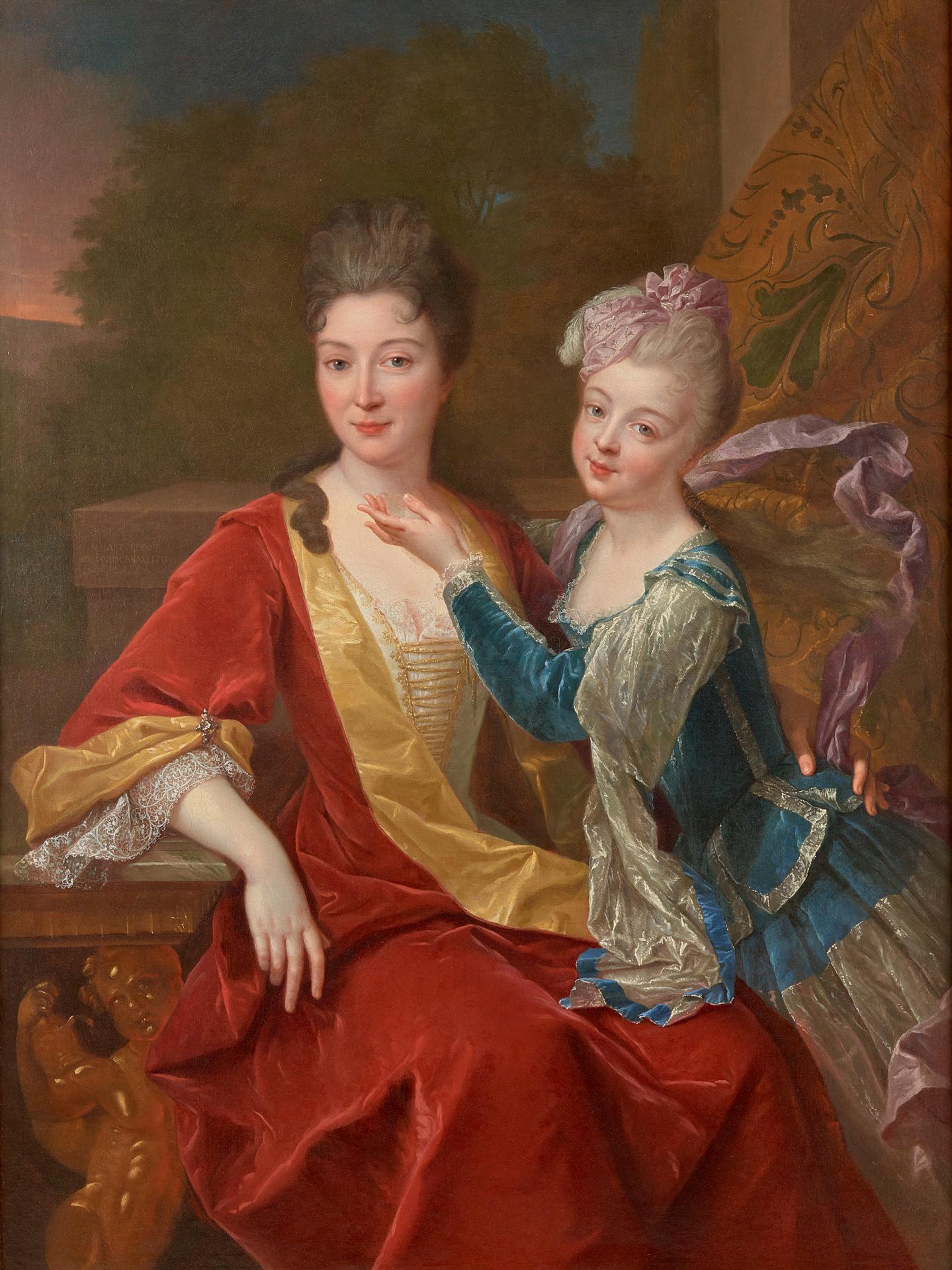
Jeanne-Françoise Salomon de La Lande and her daughter Françoise-Mélanie, 1710, oil on canvas
© Château de Versailles, Dist. RMN / © Christophe Fouin
This portrait, characteristic of the early 18th century, is now attributed to Jacques Hellart thanks to the signature it bears, and is to this day the only known work by the painter. An inscription on the back of the canvas in October 1760 reveals the identity of the models represented in the painting: Jeanne-Françoise de Castéja, M. Salomon de La Lande’s wife, is shown with her daughter Françoise-Mélanie, future marquise d'Arcy. Madam de La Lande was closely associated with the life of the court after her appointment by Louis XIV as sub-governor of the children of France on March 25, 1704 with the marshal of La Mothe and the duchess of Ventadour.
Marie Leszczynska's tea and chocolate set: rinsing bowl
Meissen Porcelain Manufactory

Marie Leszczynska's tea and chocolate set: rinsing bowl, circa 1737, painted and gilded hard porcelain
© Château de Versailles, Dist. RMN / © Christophe Fouin
Part of a tea and chocolate set, this large rinsing bowl with the arms of Queen Marie Leszczynska (twice on the outside and once on the bottom) was ordered in March 1737 by August III, King of Poland and Elector of Saxony (1696-1763). The set was inventoried in 1768 in the grand cabinet of the Queen at Versailles. It is the first piece of this service acquired in public auction by the Palace of Versailles.
Collection of 3 books
André Félibien des Avaux

Collection of 3 books : 1. André Félibien, Description de la grotte de Versailles ; 2. Sébastien Le Clerc, Labyrinthe de Versailles ; 3. André Félibien, Statües et bustes antiques des maisons royales, 1672-1679, book, bound in red morocco with the royal arms
© Château de Versailles, Dist. RMN / © Christophe Fouin
The Palace of Versailles owns two other editions of the Grotte de Versailles (dated 1674 and 1676) and of the Labyrinth (1677 and 1679), but this is the only copy representing the antique statues and busts of the royal houses in this complete version (nearly one hundred plates) in folio format.
Drawing by Natoire
Charles-Joseph Natoire
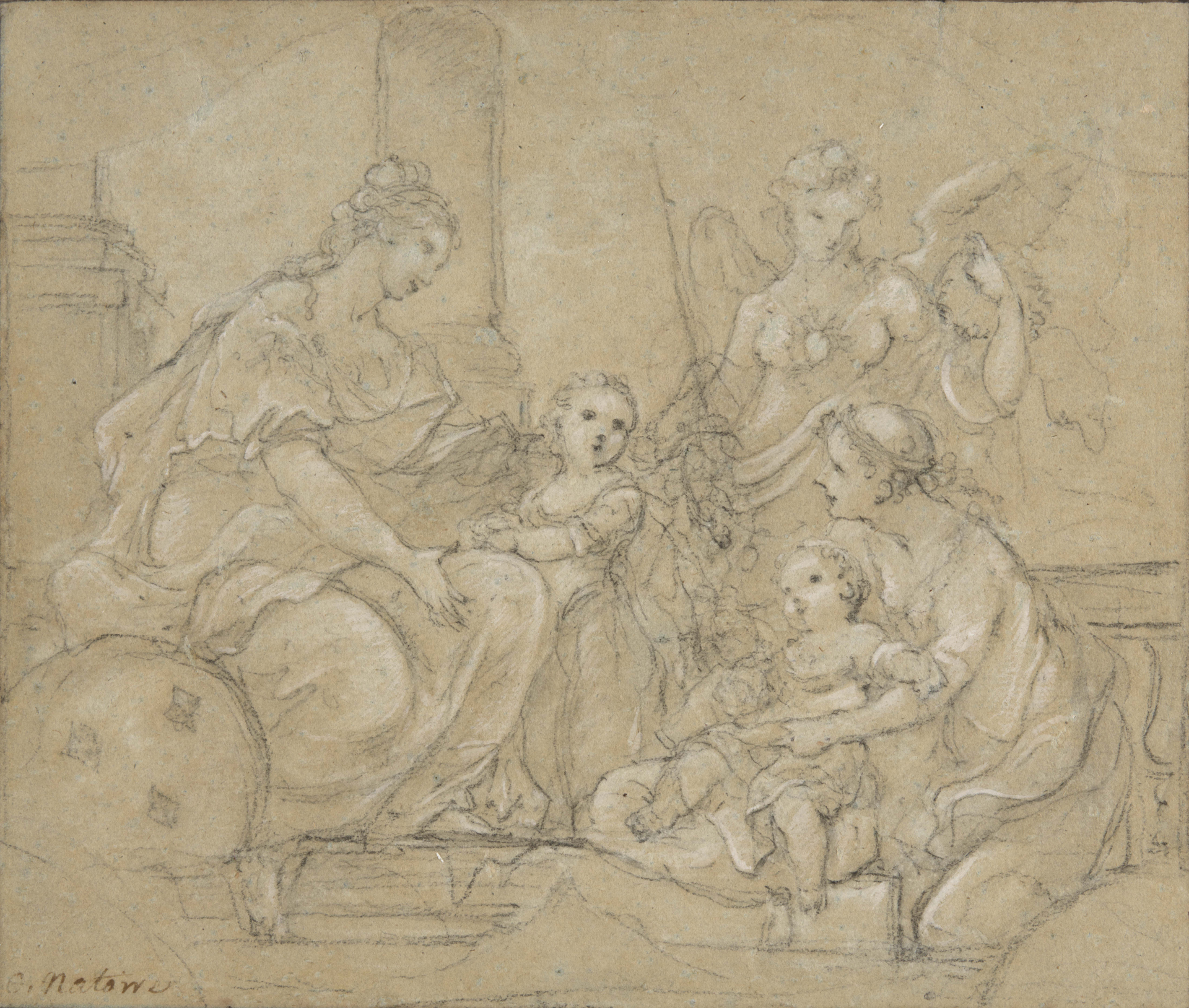
Youth and Virtue present two princesses to France, ca. 1734, black stone and white chalk on paper
© Château de Versailles, Dist. RMN / © Christophe Fouin
This drawing is the preparatory study for the painting commissioned by Marie Leszczynska at the time of the birth of Princesses Adelaide (1732) and Victoire (1733), which took its place as overdoor in the Queen's bedroom at Versailles in 1735 (MV 7163). This work entered the château's collections thanks to a gift from Madam Florence Austin in May 2014.
Wall clock
Balthazar II Martinot
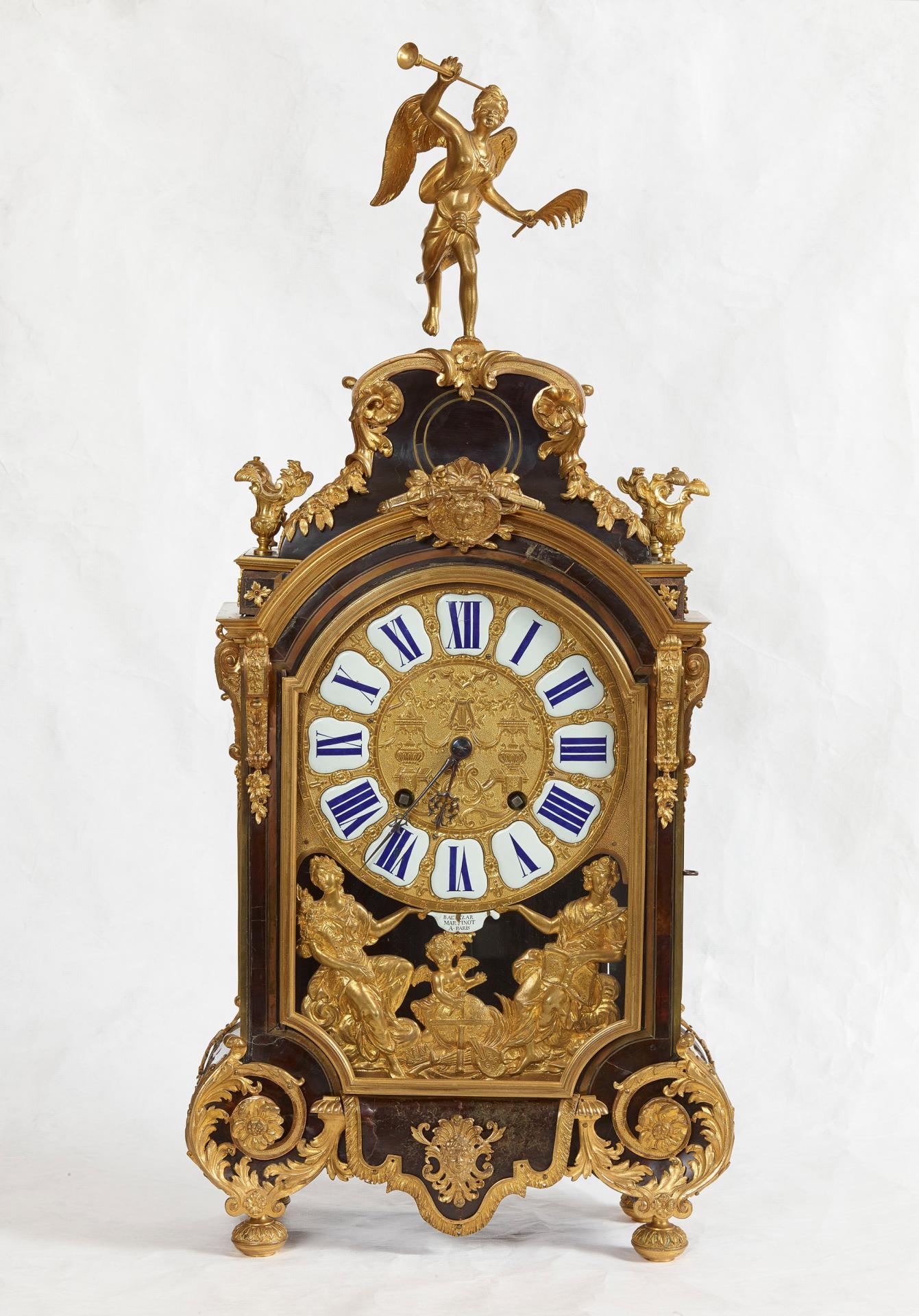
Cartel, ca. 1690, tortoiseshell veneer with copper fillet decoration, chased and gilt bronze ornaments
© Château de Versailles, Dist. RMN / © Christophe Fouin
Balthazar II Martinot (1636-1714) was one of the most famous clockmakers of the time of Louis XIV. This tortoiseshell veneered wall clock with copper fillet decoration is decorated with chased and gilded bronzes, and is surmounted by a Renommée. The chased and gilt bronze dial surmounts a plate showing two young women and a love that could represent Abundance and Geography. The lower register of the case ends with two acanthus scrolls and a central mascaron. This work entered Versailles thanks to the gift of Madam Colette Delhorbe, in memory of her husband Jacques Delhorbe.
2013
Coachman’s whip from the Coronation coach of Charles X
Donated by Mr Hubert de Chaisemartin, November 2013
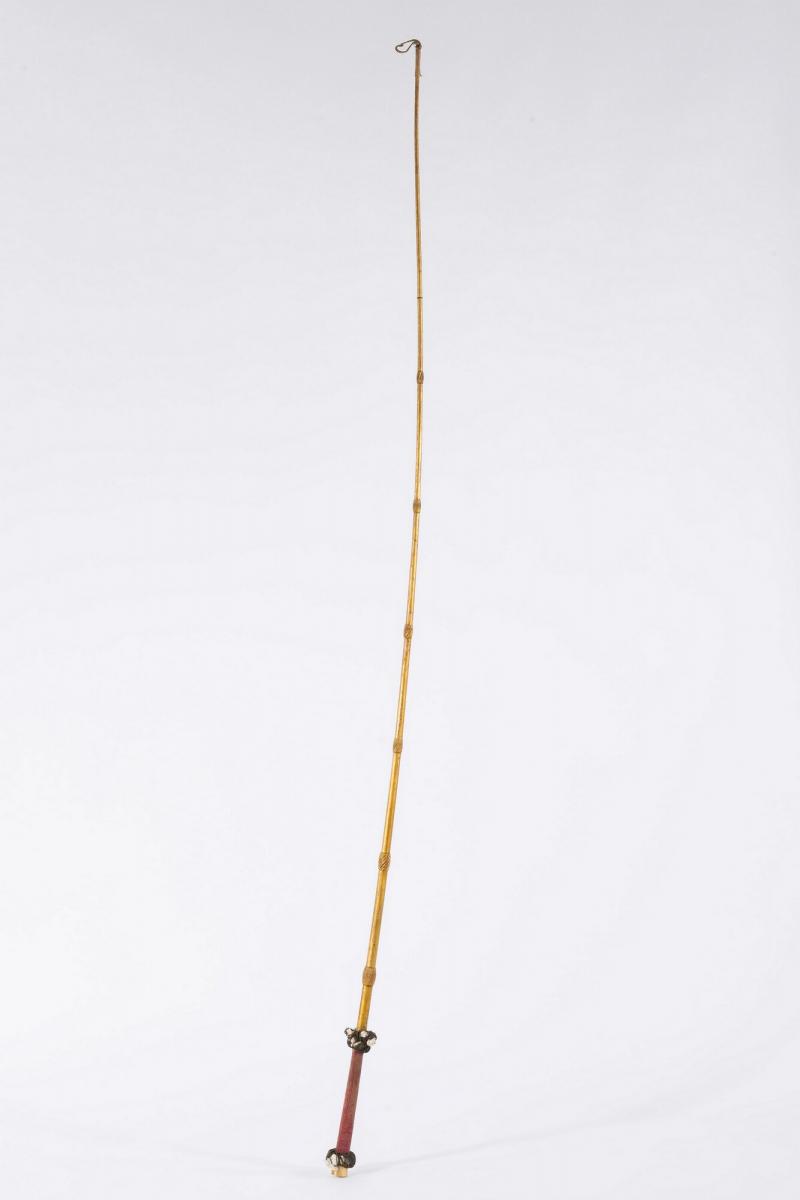
Coachman’s whip from the Coronation coach of Charles X
© Château de Versailles, Dist. RMN / © Christophe Fouin
This French-style coach whip was used during the Coronation ceremony of Charles X, in Reims, on 29 May 1825. Charles X’s carriage was pulled by eight horses; a royal privilege, the two front horses were guided by the postilion, who rode the left-side horse and the other six were controlled by the coachman. He held the whip in his right hand, a third of the way up, with his elbow close to his body.
This whip comprises a gilded and varnished wooden stick, it is flexible and tapered towards the top, embellished with six bands with alternating decoration. The lash, which in this case is absent, was mounted on the loop that can be seen at the end. It was made of leather cut into thin plaited strips and ended with a thong, a small plaited rope or knotted string with which to touch the horses’ shoulders. At the base of the stick, the grip is covered with crimson silk-velvet decorated top and bottom with balls of gold wire. At the end, the cap is made of gold, engraved with a fleur-de-lys with this inscription: “Charles X, Sacré le 29 Mai 1825” (Charles X, crowned 29 May 1825). The trim matching the King’s Coach, the exceptional dimensions, the very flamboyant style and the inscription on the gold cap all suggest that this whip was indeed the one used by the coachman on the King’s coach for the coronation of Charles X, and could indicate that at the end of the ceremonial, the object was presented as an honorary gift to a dignitary who then had it engraved as a souvenir of the event. The very fact of adding an inscription to an everyday object gives it use value and shows the importance and the symbolic value of this whip at the ceremony.
This unusual piece is an addition to the collections of the Museum of Coaches at Versailles.
Vase-clock belonging to Louis XVI
July 2013
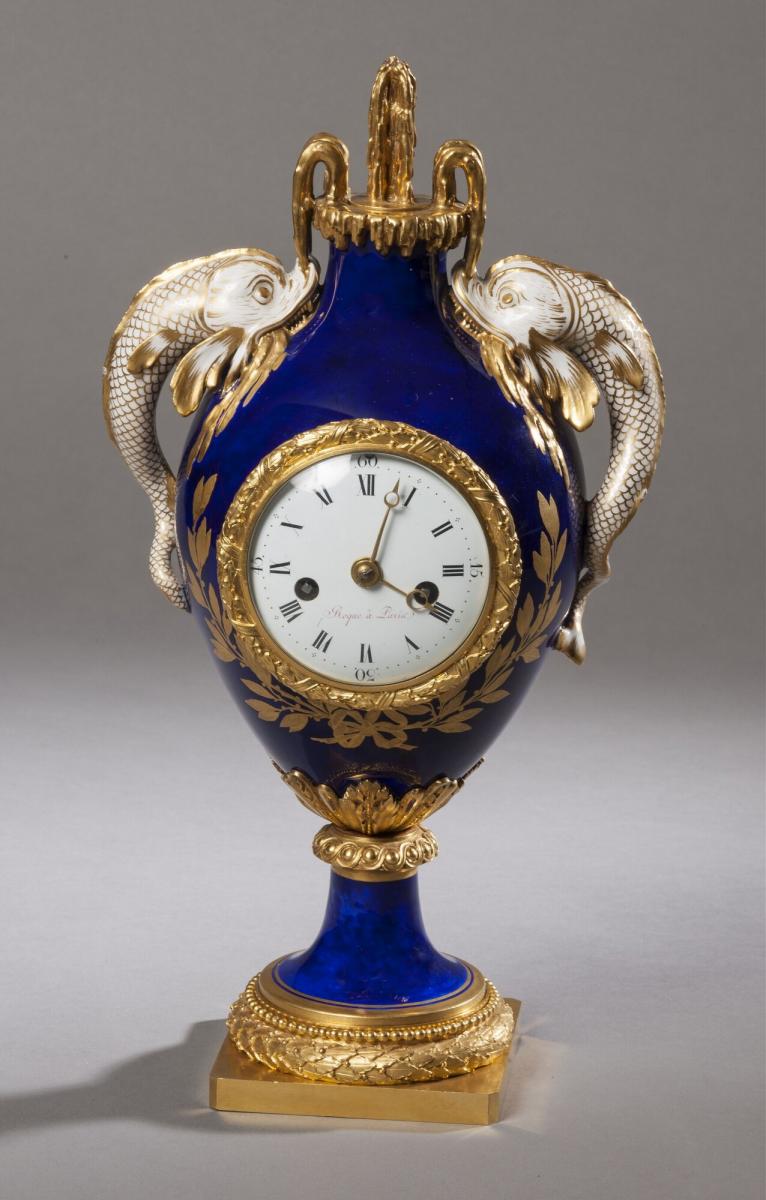
Vase-clock belonging to Louis XVI
© Château de Versailles, Dist. RMN / © Christophe Fouin
Dated 1775, this vase-clock with a beau-bleu (beautiful blue) background, and a clock face signed de Roque, Paris, was acquired by Louis XVI from the Royal Sèvres porcelain Manufacture during 1777. It was intended for the fireplace in his newly installed Bathroom in the first-floor apartments. It was sent to the Tuileries in January 1792, and was probably sold during the Revolution; all trace of it was lost until 1927, when it appeared at the sale of the collections of Anthony de Rothschild. It now has a square base, probably added during the 19th century, as was the case for many Sèvres pieces from the previous century.
The acquisition of this vase-clock, with its extremely unusual shape and its royal provenance, is of very great importance for expanding the Palace collections. It is part of a policy that has been implemented over several decades, a policy of systematically purchasing royal pieces of Vincennes-Sèvres porcelain that were at Versailles in the second half of the 18th century. These pieces can be identified from the Palace inventories which were drawn up at the outbreak of the Revolution and the sales records at the Manufacture. The acquisition of this clock reinforces what we already know of Louis XVI’s very sincere appreciation of pieces from the royal Manufacture, founded at Vincennes in 1740 during the reign of his grandfather.
Portraits of the Duke of Berry and the Duke of Burgundy by Fredou
June 2013
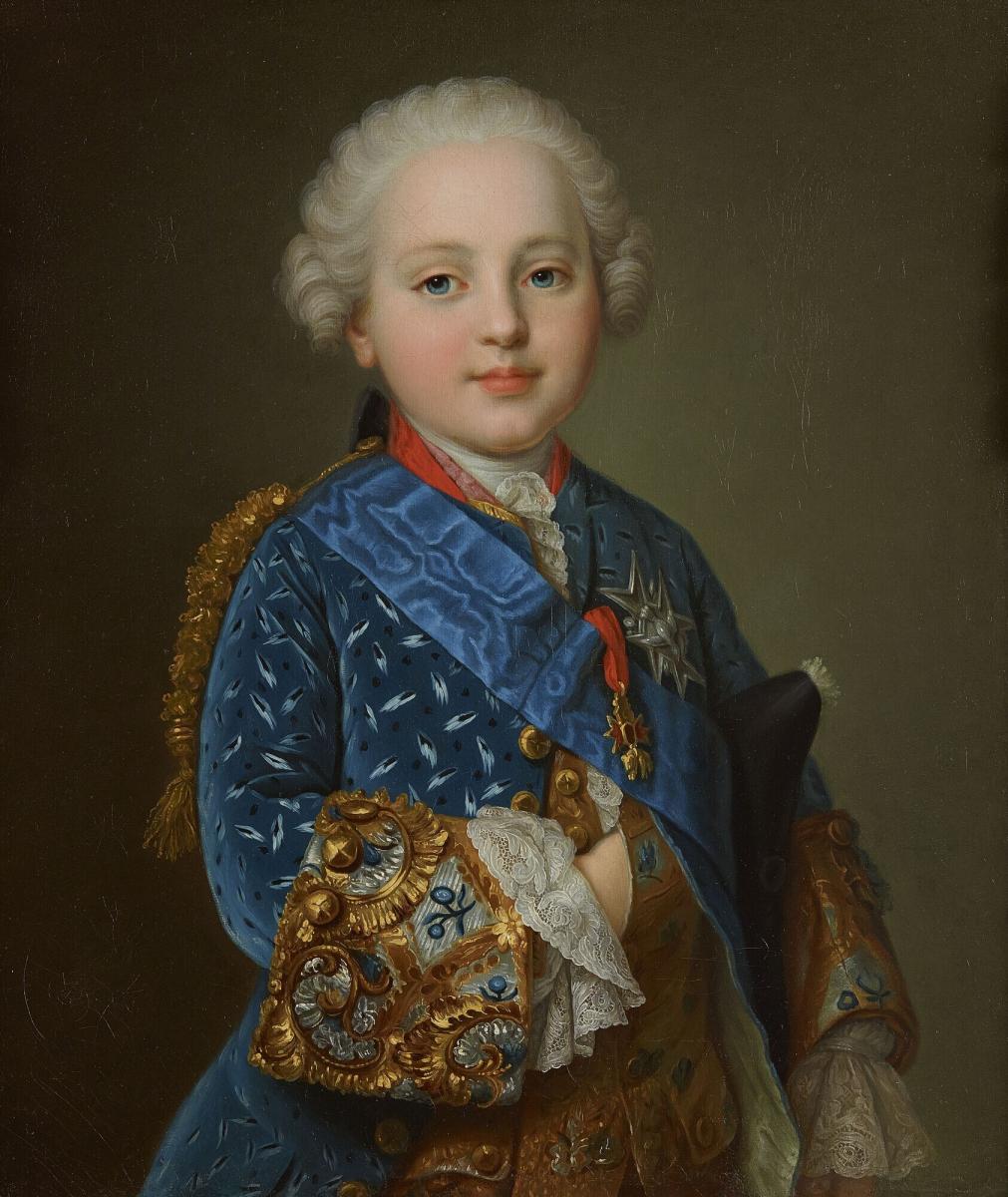
Portraits of the Duke of Berry and the Duke of Burgundy by Fredou
© Château de Versailles, Dist. RMN / © Christophe Fouin
Between 1760 and 1762, Jean-Martial Fredou produced eleven portraits of the children of the Dauphin, son of Louis XV, and Maria Josepha of Saxony. The pastel portrait of the Duke of Burgundy, completed on 15 March 1760 and held in the Palace of Versailles collections (INV.DESS 726), was the inspiration for several other oil-painted versions by Fredou. One of these was given by the Dauphin to the Marquis of Sinety. In 1760, he had been appointed deputy governor for the Duke of Berry and in 1762 sub-governor for the Count of Provence. The portrait of the Duke of Berry (future Louis XVI) was also the subject of a drawing by Fredou as part of the 1760-1762 commission. The portrait was painted as a match for that of the Duke of Burgundy, which was also given to the Marquis de Sinety, and is in all likelihood a variant of this still unknown drawing. The identical frames, which are probably the original ones, confirm that these two portraits were produced as a matching pair.
The Palace of Versailles had no oil painting of the Duke of Burgundy and no portrait at all of the Duke of Berry as a child. This acquisition fills an important gap in our iconography.
Visit by Queen Victoria to the Queen’s Hamlet in Petit Trianon, on 21 August 1855 by Karl Girardet
April 2013
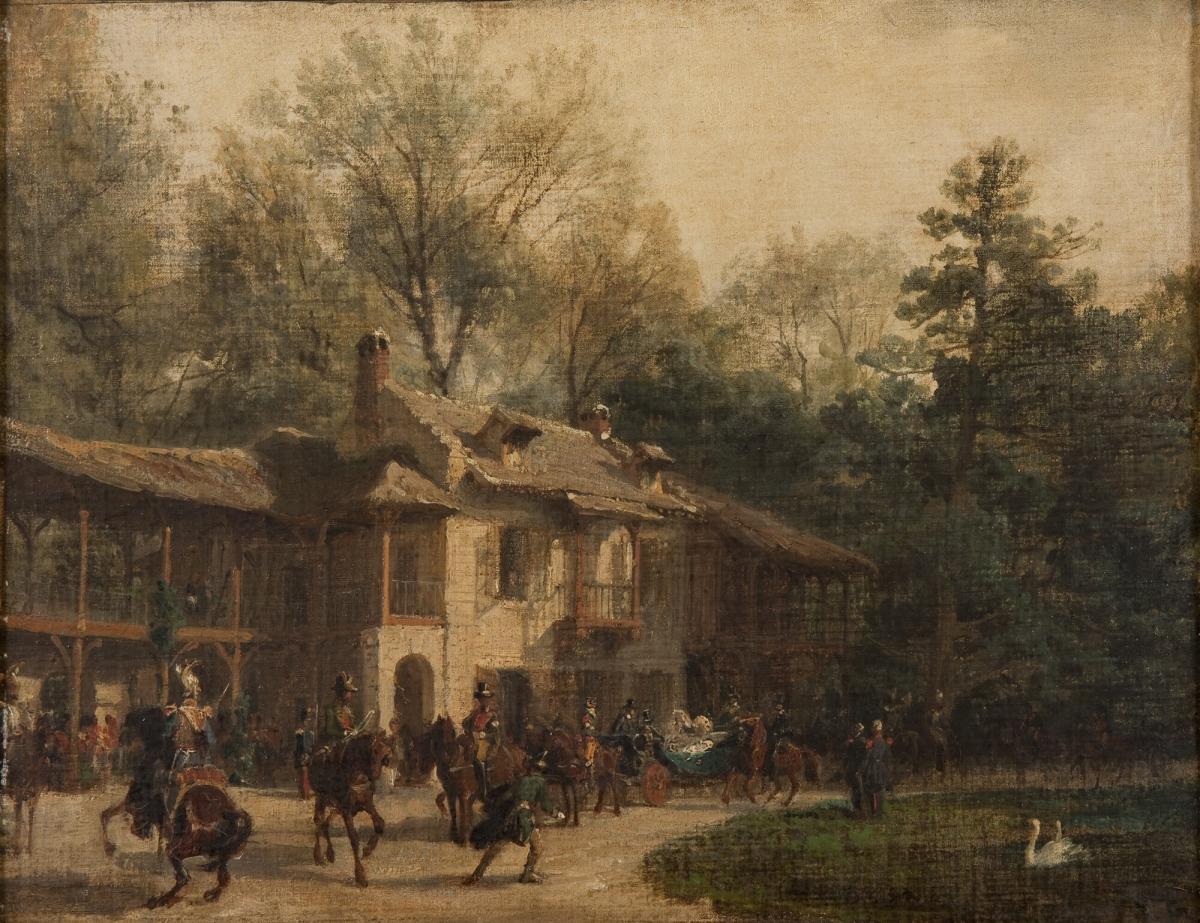
Visit by Queen Victoria to the Queen’s Hamlet in Petit Trianon, on 21 August 1855
© Château de Versailles, Dist. RMN / © Christophe Fouin
This small painting by Karl Girardet is a sketch in preparation for a watercolour that was commissioned by Queen Victoria in 1855 and which is now in the British Royal Collection. It commemorates the visit by the Queen and Prince Albert, accompanied by the Imperial couple, to Trianon, on Tuesday 21 August 1855, during the British sovereign’s visit to Paris.
Here we can clearly see the Queen and the Empress in an open carriage, which has stopped in front of the Queen’s House, and the Emperor and the Prince Consort on horseback on either side. The escort is provided by the Hundred Swiss and postilions from the Emperor’s House in full dress. Beneath the gallery that links the Queen’s House to the Games House is the band of the Guides of the Imperial Guard, which played while the two couples ate lunch.
There are very few old painted representations of the Trianon Hamlet. The Palace of Versailles has two views of the Mill and the Queen’s House with the Marlborough Tower, produced by the studios of Guérard and Wallaert, which date from the Bourbon Restoration, and one view of the interior of the Queen’s Theatre in the time of the July Monarchy, by Mme Asselineau, but none from the Second Empire, the time when the Trianon was undergoing something of a revival driven by Empress Eugénie. This acquisition will fill this gap with a work that will be placed in the Petit Trianon attic, in the area devoted to the Second Empire and the Empress.
Three vases belonging to Madame Victoire
Vases purchased thanks to the patronage of LVMH-Moët Hennessy-Louis Vuitton group, March 2013
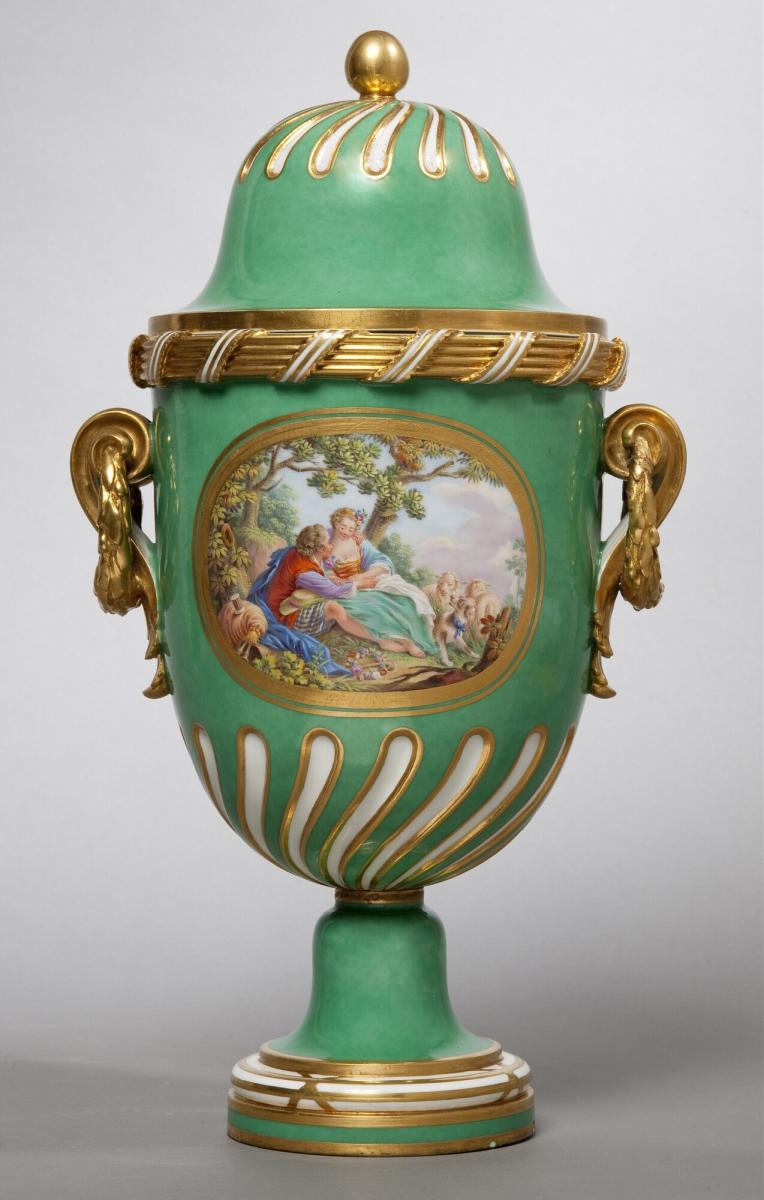
Three vases belonging to Madame Victoire
© Château de Versailles, Dist. RMN / © Christophe Fouin
In 1772, Madame Victoire, one of Louis XV’s daughters, acquired these three vases for her bedroom in the Palace of Versailles. In fact, she bought a set of five vases with a dark green background from the Royal Sèvres porcelain Manufacture. The other two vases in the set are currently in the Metropolitan Museum of Art.
These three vases are exceptional for their painted decoration and their shape. The cartouches are the work of Charles-Nicolas Dodin, one of the best painters of figures at the Sèvres Manufacture in the 18th century. The Palace of Versailles devoted an exhibition to him in 2012. Concerning the form of these vases, there are as yet none like it in the national collections. The central vase, à baguettes, has a painted cartouche based on a painting made in 1737 for Louis XV called The Charms of Country Life. On the two vases with laurel leaves, we see The Lovers Surprised, based on an engraving by Gilles Demarteau, and Spring, inspired by one of the Seasons pictures painted in 1755 for Madame de Pompadour.
These vases will be returned to their original place, above the fireplace in Madame Victoire’s bedroom.
These vases were acquired thanks to the patronage of LVMH. This set has been recognised as a “National Treasure”, a work of major heritage interest.
Maria Josepha of Saxony in the Savoyard style by Jean-Marc Nattier
January 2013
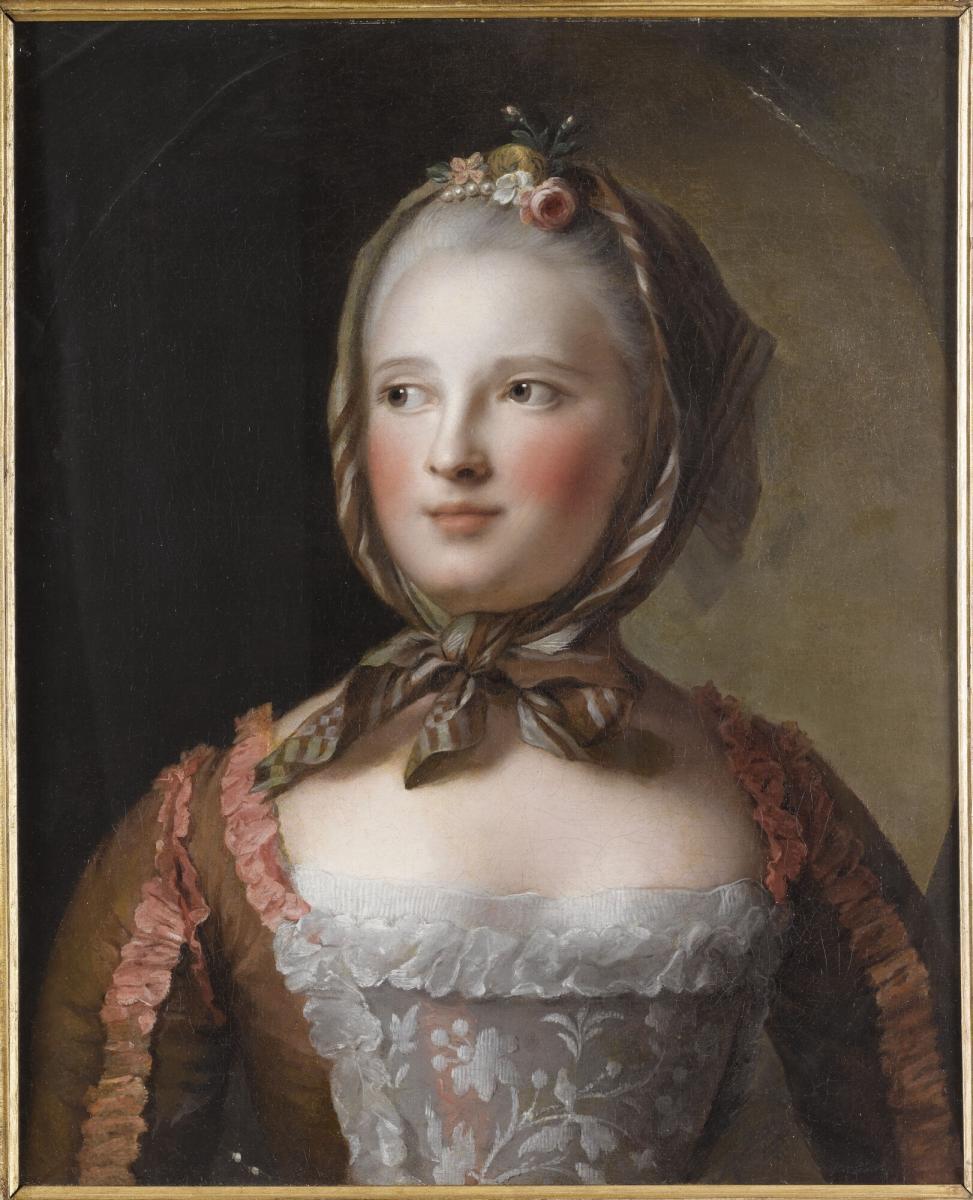
Maria Josepha of Saxony in the Savoyard style
© RMN-GP (Château de Versailles) / © Franck Raux
In 1751, Jean-Marc Nattier produced this oval portrait of the Dauphine Maria Josepha of Saxony. It was given to the Duchess of Brancas, lady-in-waiting to the Dauphine until 1762. The Dauphine’s face is exactly the same as that painted by Nattier for the large portrait of the Dauphine in court dress.
Her costume, however, is very different: the young Dauphine is en marmotte, which means that she is wearing a kerchief knotted under her chin. This headdress is part of the iconography of Parisian women in the Savoyard style, which became popular in the 1740s to 1750s. At first, the Savoyard peasant woman was seen as symbolic of virtuous poverty, but then this figure gradually became more mischievous. From the 1760s, there was some ambivalence: whether she was a virtuous peasant from the mountains or an impudent city-dweller, the Savoyard could also be a beggar-woman, who was suspected, especially if she were pretty, of offering more than just songs.
This portrait of the Dauphine en marmotte is unique iconographically, since we know of no other portrait of ladies in the royal family dressed in the Savoyard style. The Dauphine seems to have adopted this fashion. We should remember that this portrait was probably executed when she was pregnant with her third son. The peasant costume could therefore suggest virtuous fertility, even though this type of representation could be shocking. Since it was given to a lady-in-waiting, this small portrait is not an official representation and is proof of the ties between the Dauphine and the ladies of her household.
Saint John the Baptist kissing the hand of the infant Jesus attributed to Jacopo Amigoni
January 2013
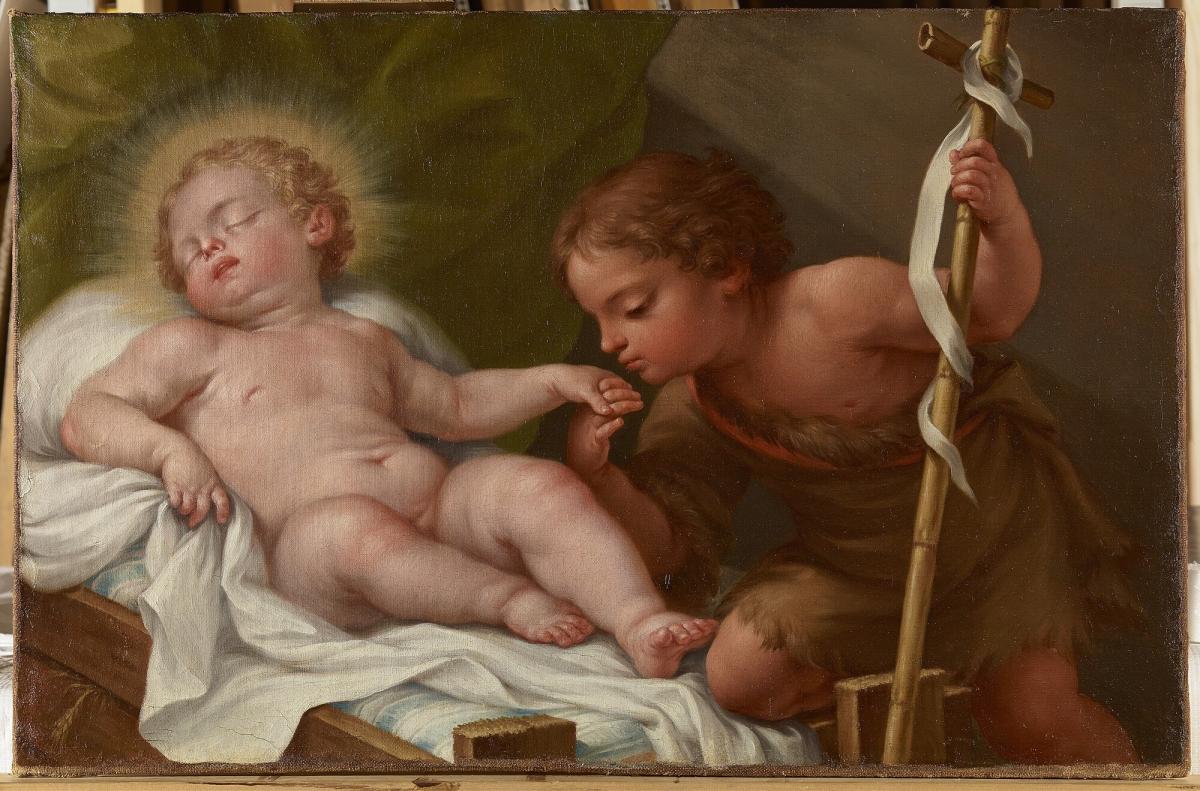
Saint John the Baptist kissing the hand of the infant Jesus
© Château de Versailles, Dist. RMN / © Christophe Fouin
This painting of St. John the Baptist kissing the hand of the infant Jesus probably comes from the court of Saxony, brought to Versailles by the Dauphine Maria Josepha of Saxony, mother of Louis XVI, Louis XVIII and Charles X, when she married the Dauphin in 1747.
This canvas is an example of the Dauphine’s taste for religious scenes, of which Versailles already has two other examples by Charles-Antoine Coypel (Sainte Piame, MV 8610, and Sainte Landrade, MV 8624). This was painted by the Venetian Jacopo Amigoni, and is imbued with the tenderness and delicacy so typical of the Bolognese School in the previous century.
On her death in 1767, the Dauphine bequeathed this painting to her first chaplain, Aymar de Nicolaï, who had supported her during some of the most difficult times in her life, such as the death of her son Louis-Ferdinand in 1765. Now that the painting is back at Versailles, it will conjure up the decor of the Dauphine’s apartments.
2012
The Rock and the Belvedere at Versailles by Claude-Louis Chatelet
May 2012
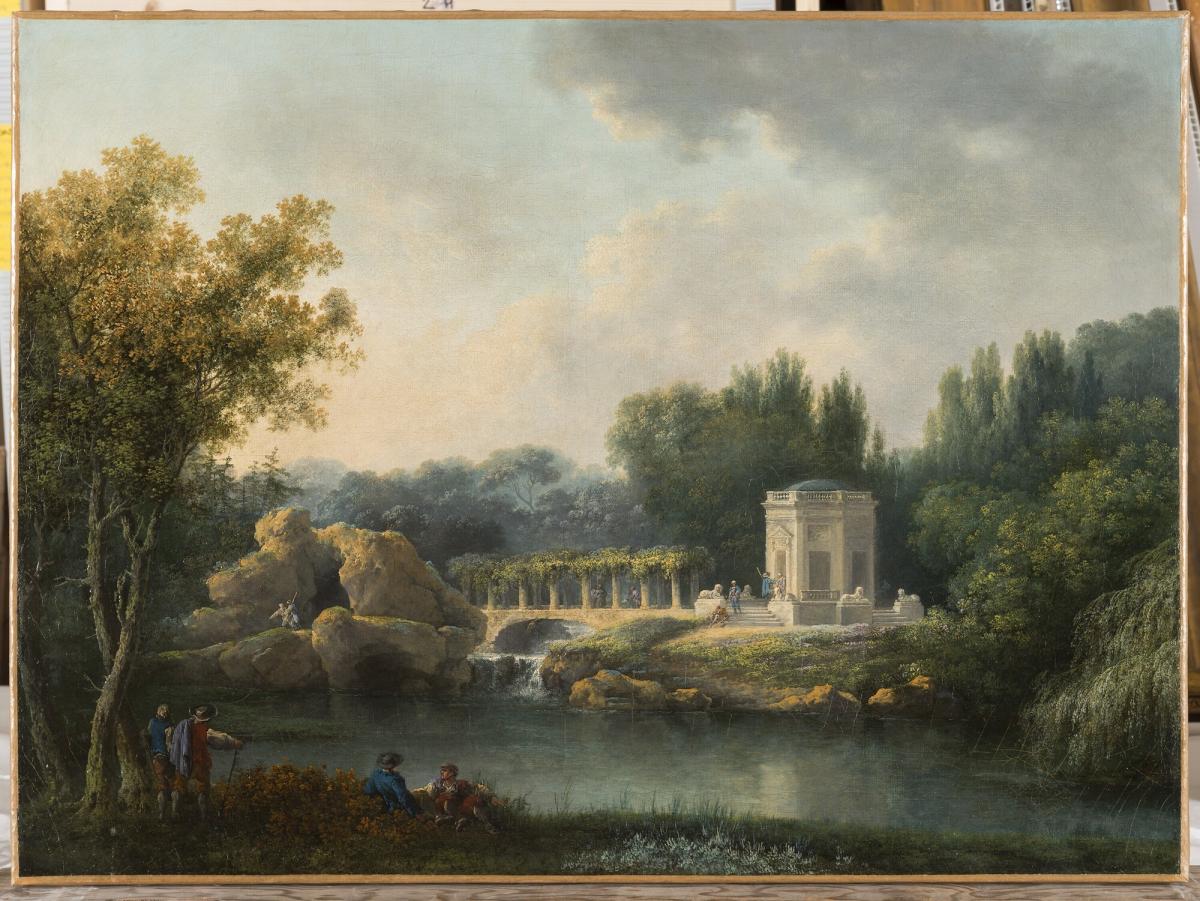
The Rock and the Belvedere at Versailles
© Château de Versailles, Dist. RMN / © Christophe Fouin
The Belvedere and the Rock in the English gardens at the Petit Trianon are faithfully depicted here by Claude-Louis Chatelet. The painter has added a bridge, however, and a pergola with columns between the pavilion and the rock, whereas in reality there is only a wooden footbridge. This oil on canvas is based on a watercolour that Chatelet had painted for the selection of plans and views of the Petit Trianon given by Marie-Antoinette in 1786 to one of her brothers, Archduke Ferdinand, Duke of Breisgau, Governor of Lombardy, when he came to the Trianon (Biblioteca Estense, Modena).
The painting shows a daytime scene, and is very similar to the Illumination of the Belvedere and the Rock at the Petit Trianon, held in 1781 in honour of the Count of Provence, the King’s brother, or the Emperor of Austria Joseph II (MV 7796), also by Chatelet, dated 1781 and held at Versailles. In this painting there is no pergola, and the wooden footbridge can be clearly seen.
The Rock and the Belvedere will join La Fête de nuit (MV 8384, donated by Baroness Liliane de Rothschild) and L’Illumination, which hang on the second floor of the Petit Trianon, from where one has a view of the Belvedere.
Jupiter chariot between Justice and Piety by Noël Coypel
January 2012

Jupiter chariot between Justice and Piety
© RMN-GP (Château de Versailles) / © Gérard Blot
This study by Noël Coypel was in preparation for painting the central panel in the Queen’s Guard Room. It probably dates from 1671, when construction work began on the State Apartments and when the sketches were submitted to Louis XIV and Colbert for approval.
The subject is Jupiter’s chariot surrounded by the allegories of Justice and Piety. In the foreground, we see a personification of the planet itself in the guise of a young women who holds a garland of flowers with which she leads four children, symbolising the planet’s four satellites, discovered by Galileo in 1609.
The sketch differs in several ways from the finished painting, the most important being the gesture Jupiter makes as he holds up the sceptre, which no longer appears on the ceiling. Thus this sketch shows the final changes made before the room was decorated and is a matching pair with the other study by Noël Coypel, The chariot of Saturn between Providence and Secret, which was acquired in 1994.
Punch bowl from the service with the bleu céleste (heavenly blue) background belonging to Louis XV
This purchase was made possible thanks to the patronage of KPMG SA, January 2012
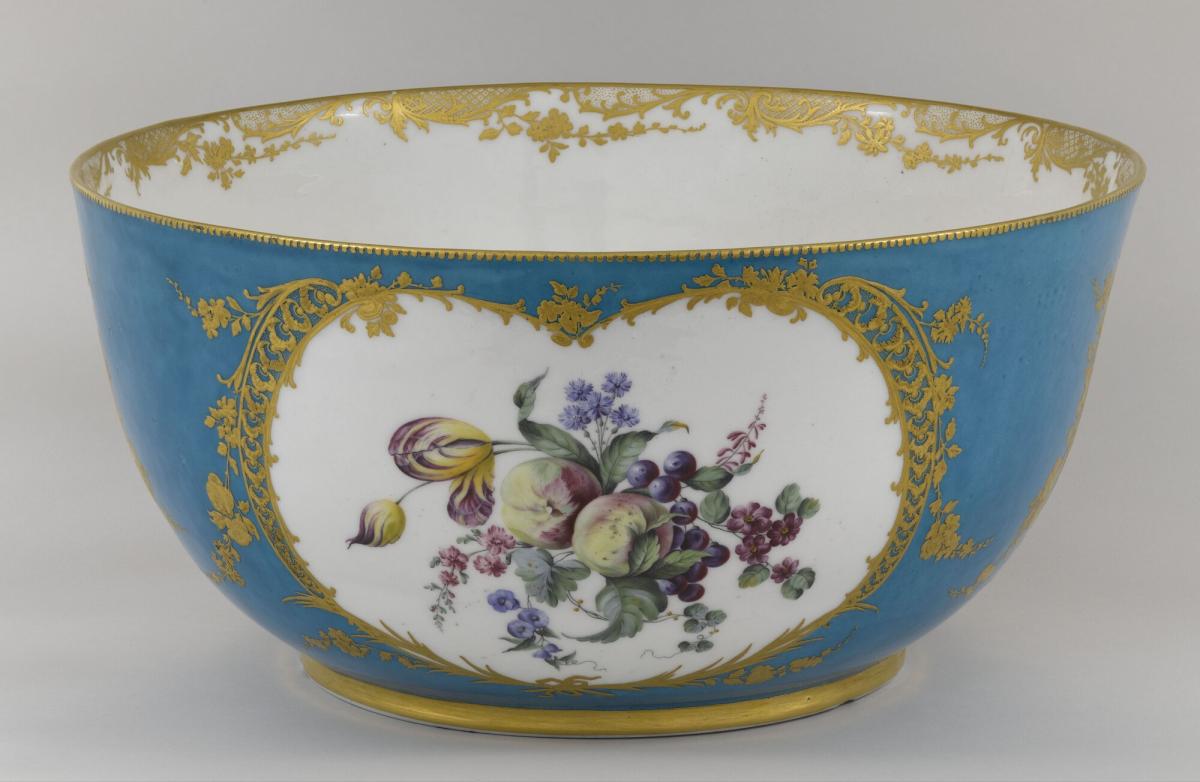
Punch bowl from the service with the bleu céleste (heavenly blue) background belonging to Louis XV
© RMN (Château de Versailles) / © Gérard Blot
This punch bowl is part of large dinner service described as “with the heavenly blue background” produced for Louis XV between 1753 and 1755 at the royal Manufacture, which was at that time located in the grounds of the Château de Vincennes. It is made up of 1,749 pieces of soft-paste porcelain and is decorated with flowers and fruit, inside cartouches outlined in gold. The heavenly blue background was created by the chemist Hellot especially for this commission. After delivery, the service was used by the royal family until the end of the Ancien Régime.
This punch bowl is exceptional not only for its beautiful decoration and the scale of the table service of which it is part, but also for its excellent condition and the fact that this was a new design when it was commissioned: the shape was inspired by the craze in England for a new drink called punch, which was served at the end of a meal at the same time as the dessert. It will join the seven pieces from the same service which are already at the Palace, in what is known as the Porcelain Dining Room.
This acquisition was made possible thanks to the patronage of KPMG.
2011
Portrait of Madame de Lamballe by Elisabeth-Louise Vigée-Le Brun
November 2011

Portrait of Madame de Lamballe
© RMN (Château de Versailles) / © Gérard Blot
A deep friendship developed between the Princess de Lamballe and Marie-Antoinette from their meeting at the marriage of the Austrian princess and the future Louis XVI in 1770 until Madame de Lamballe’s death during the September Massacres in 1792. Until now, the Palace of Versailles had no portrait of the Princess de Lamballe dating from this period.
When Elisabeth-Louise Vigée-Le Brun painted the Princesse de Lamballe’s portrait in 1782, the princess was thirty-three years old. Vigée-Le Brun used a much-loved formula and one that she had used several times for different models, including the Queen: the favourite is wearing a simple loose-fitting muslin dress and a straw hat. This portrait is similar to others painted by Vigée-Lebrun of ladies in the Queen’s entourage and which are already held by the Palace of Versailles, especially that of Marie-Antoinette’s other great friend, the Duchess of Polignac.
Portrait of the Countess Du Barry as Flora by François-Hubert Drouais
The purchase of this portrait was made possible thanks to the support of the Society of the Friends of Versailles, May 2011

Portrait of the Countess Du Barry as Flora
© Château de Versailles, Dist. RMN / © Christophe Fouin
As official painter to Madame Du Barry, François-Hubert Drouais (1727-1775) painted her many times. Notably, he exhibited two portraits at the Salon in 1769 showing her as Flora and in hunting costume. Between 1770 and 1774, Madame Du Barry ordered seven or eight replicas or copies of the portrait as Flora to give to people in her entourage, each one slightly different. It is probably the first version of this portrait, the one that was exhibited at the 1769 Salon, that the Palace of Versailles has acquired here.
This work will enhance the collections at Versailles in more ways than one. It will be added to the beautiful set of portraits by François-Hubert Drouais that are already held here. More importantly, when this portrait was acquired, the Palace of Versailles no longer had any painted representation of Madame Du Barry, even though she was an important figure in the last years of Louis XV’s reign.
Pastel portrait of the Countess of Artois by Joseph Boze
May 2011

Pastel portrait of the Countess of Artois
© RMN (Château de Versailles) / © Gérard Blot
Joseph Boze was a better pastellist than painter, and his speciality was oval portraits in pastel. He moved to Versailles in 1785, and in the same year he was awarded some important portrait commissions by the royal family. Marie-Thérèse of Savoy was sister-in-law to Louis XVI, and is aged twenty-nine in this portrait, drawn in shades of grey-blue which accentuate her melancholy air. Not only is the treatment of the fabrics charming with its detail and realism, but the pastel technique softens her face, despite the fact that she was described by her contemporaries as having coarse features. The Countess of Artois was apparently satisfied with her portrait and ordered two copies which she gave to ladies in her entourage.
This portrait is now the latest representation that we have in Versailles of the Countess of Artois, but also the most faithful and accurate likeness of her face. It will be added to the beautiful set of pastels by Boze that are already held at the Palace of Versailles.
2009-2010
Desk chair originating from the Royal Furniture Treasury
July 2010
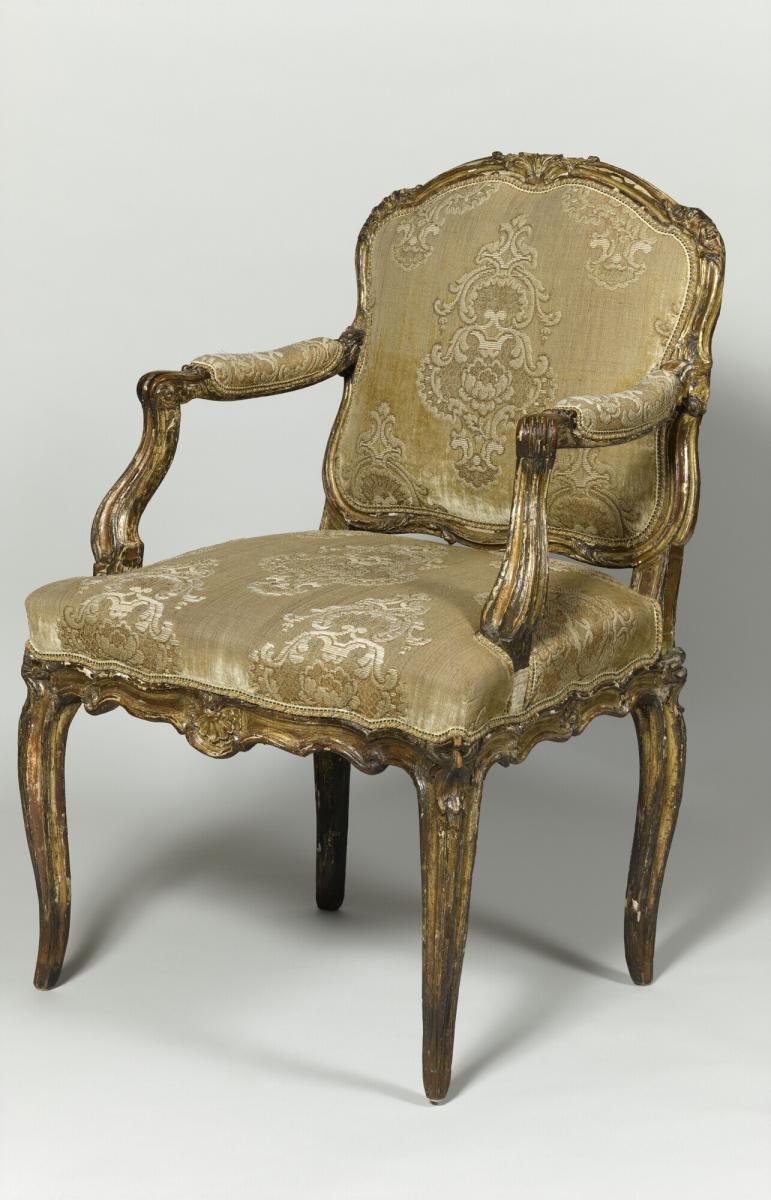
Desk chair originating from the Royal Furniture Treasury
© RMN (Château de Versailles) / Gérard Blot
Today, this chair is the only desk chair identified as being part of the deliveries made to the Royal Furniture Treasury in the middle of the 18th century. It is therefore a unique item of reference against which to identify other desk chairs in future as being part of the royal furniture. The chair is characteristic of pieces produced in Paris at the time when Rococo was at its peak. Its proportions differ slightly from those of a salon armchair, particularly in the lowering of the back. The sculpture is of excellent quality and highlights the structural elements of the chair. This acquisition fills a gap in the types of furniture held in the Royal Furniture Treasury at Versailles. It is also one of very few chairs identified from the Rococo period that originated from the Royal Furniture Treasury. It will join the flat-top desk that was part of the same delivery to Fontainebleau in 1745 and which has recently been deposited by the Mobilier National.
This chair has been restored with the participation of the Kinnarps company.
Key to the Royal Chapel
Donated by Madame Nelly Munthe, in memory of Liliane de Rothschild, through the Society of the Friends of Versailles, 2010
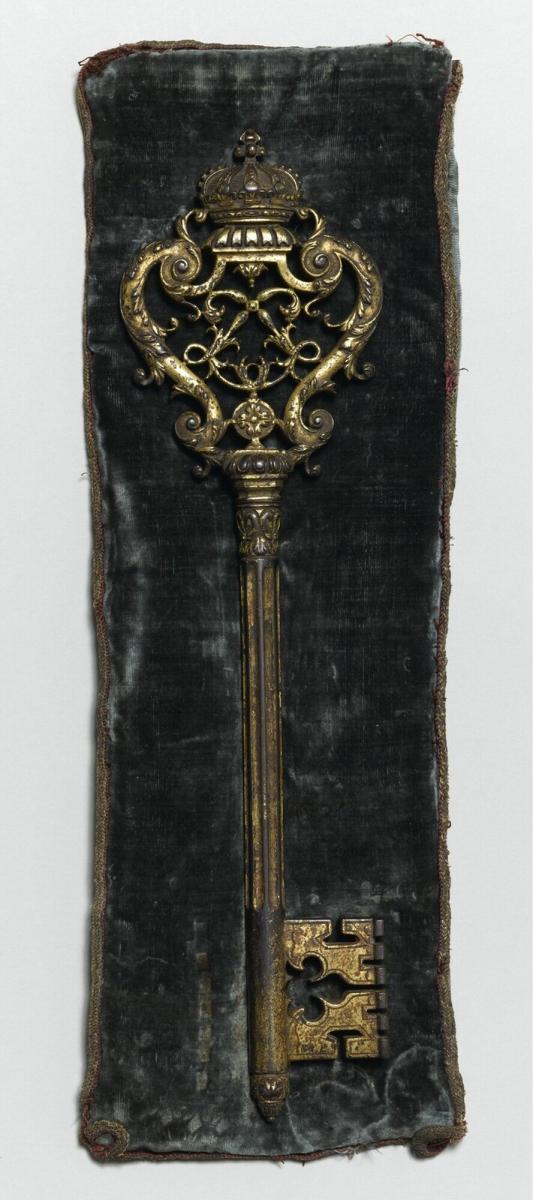
Key to the Royal Chapel
© Château de Versailles, Dist. RMN / © Christophe Fouin
The main door of the Royal Chapel at Versailles allows communication between the nave and the lower vestibule. It is possible that its magnificent key has been used on very few occasions, or it may even have simply had a purely symbolic function.
The model for this key was made by Grettepin circa 1710. He was probably called to Versailles by Jules Hardouin-Mansart, as he was to produce a large number of sculptures for the Chapel. Robert de Cotte, manager of the building project after 1708, asked him to design the key. It was probably from Grattepin’s model, in wax or clay, that the smelter Jacques Desjardins, who had made the metalwork elements for this door, produced the definitive version in gilded bronze.
Apart from the bit and the ribbed shaft, most of the decoration on the key is concentrated on the bow: there are two elegant scrolls framing a royal cipher formed by two interlaced Ls, features which represent some truly exceptional goldsmithing techniques. This is surmounted by a royal crown with fleurs-de-lys.
Acquisition of the Savonnerie Carpet from the Royal Chapel at Versailles
July 2009
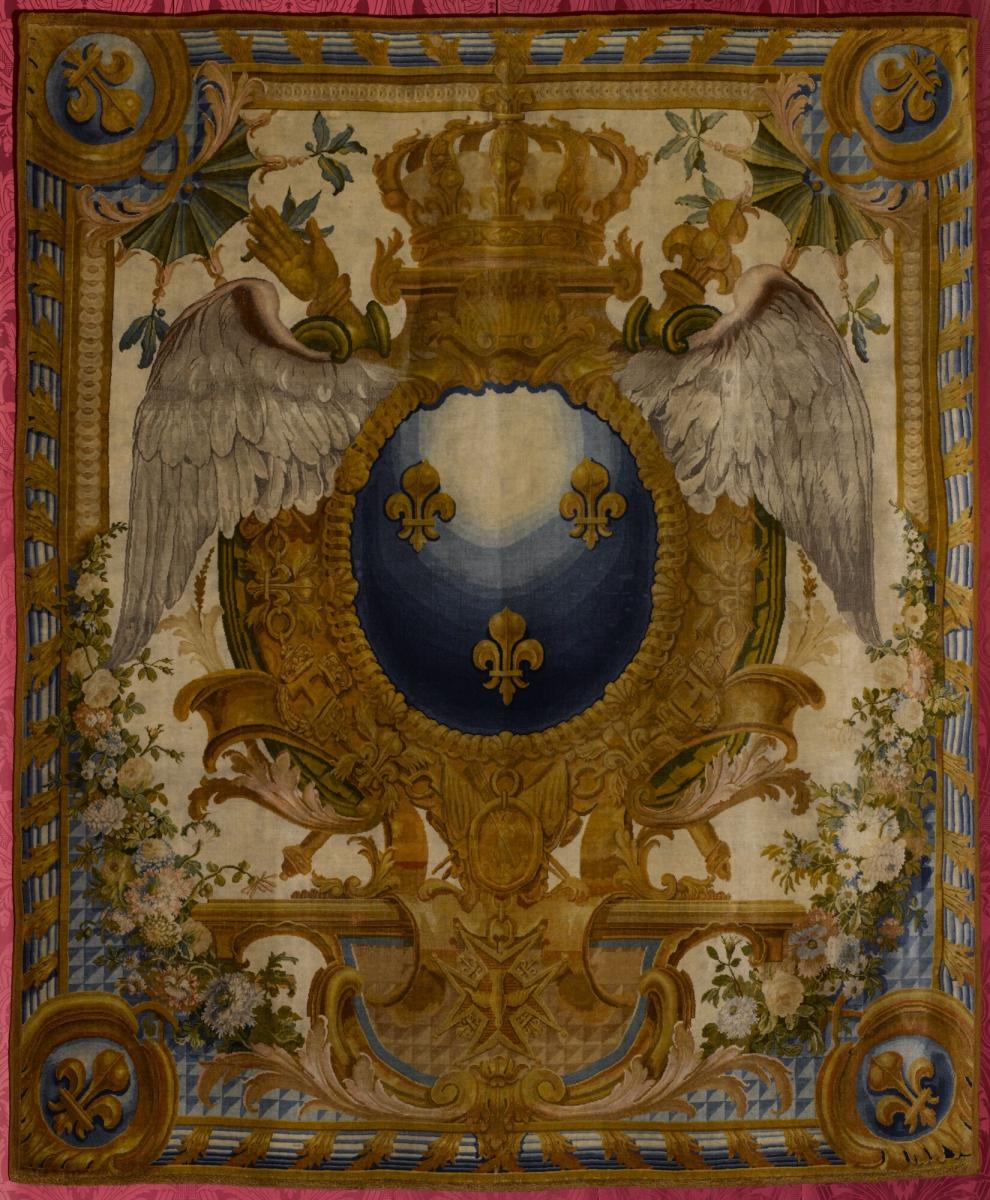
Acquisition of the Savonnerie Carpet from the Royal Chapel at Versailles
© RMN-Grand Palais (Château de Versailles) / Gérard Blot
This carpet corresponds to the central section of one of the five carpets that made up the large carpet in the nave of the Royal Chapel at Versailles which was blessed in June 1710. Louis XIV had commissioned these carpets from the Savonnerie Manufacture. The first three for the nave were delivered in 1726 and the next two in 1728. Each of these carpets was 9m30 in length and comprised three almost square compartments. The total height of the five carpets was just over twenty-two metres. The carpet we have here shows the arms of France in a central cartouche surrounded by chains of the Orders of St. Michel and the Holy Spirit, surmounted by a closed royal crown, and flanked by two unfurled wings, with royal staffs, the hand of justice and the sceptre arranged above. The cartouche is set against a pale yellow background, the sides decorated with natural garlands of fruit and flowers. This is an exceptional carpet, both for its high quality and its perfect condition. It was probably sold by the Directoire, and was then found in the collections of the Rothschild family in Vienna in the 1860s.
The acquisition of this carpet, classified as a “work of major heritage interest”, was made possible thanks to the patronage of Total.
Pair of glass coolers from the “Cherubs” service belonging to Madame Du Barry
February 2009
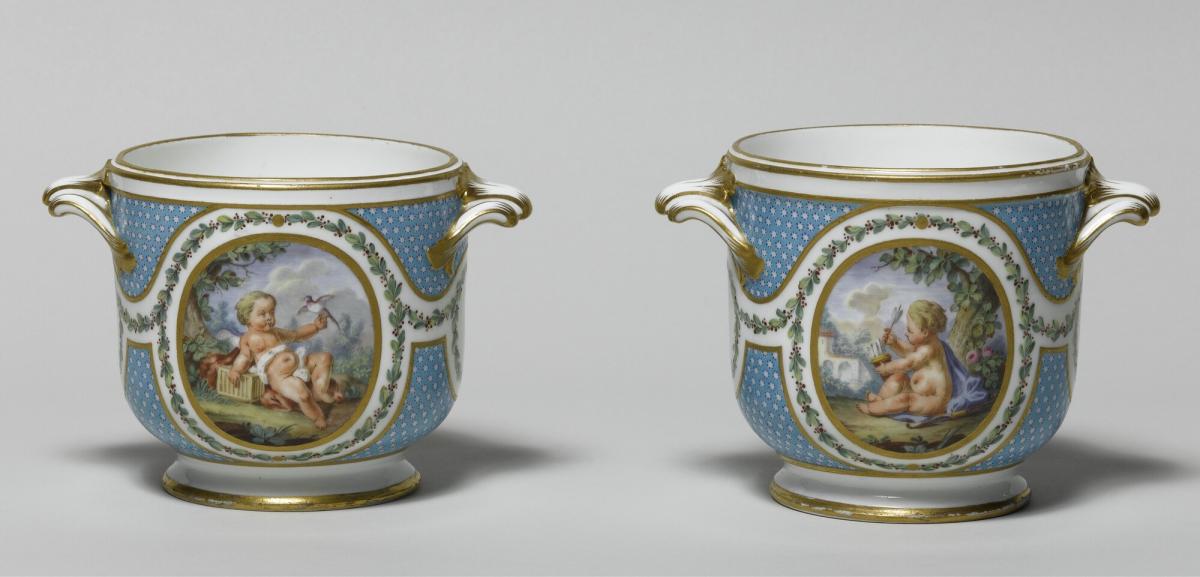
Pair of glass coolers from the “Cherubs” service belonging to Madame Du Barry
© RMN-Grand Palais (Château de Versailles) / Gérard Blot
The decor on these two wine coolers is the same as that on a small 37-piece service, which includes 12 plates, commissioned by Mme Du Barry in 1770 and delivered on 1st September 1770. The decor consists of cherubs and landscape features inside cartouches surrounded by a myrtle wreath on white and a Taillandier ground.
The service included 2 knife handles, which suggests that it was commissioned for 2 people: Louis XV and Mme Du Barry. In addition to the 12 plates, there were also 6 fruit dishes of which 2 were round, 2 square and 2 shell-shaped, 1 triangular tray, 5 ice cups, 1 sugar bowl and mustard pot with their matching trays, 1 basket salt cellar, 1 oval basket, 3 bottle coolers, 2 half-bottle coolers, 2 liqueur bottle holders at 192 livres each and 2 glass coolers at 144 livres each.
This pair of glass coolers will be added to pieces from the famous dinner service for two; they were acquired by EPV with the Society of the Friends of Versailles.
Acquisitions year by year
See all the acquisitions by the Palace of Versailles on the Collections website (French only):




